

Starting Broiler Poultry Farming Business Plan (PDF)

The world’s insatiable appetite for poultry meat has made broiler poultry farming an attractive and lucrative venture for entrepreneurs and farmers alike. Whether you’re a seasoned agricultural enthusiast or someone looking to venture into the world of poultry farming for the first time, starting a broiler poultry farming business can be a rewarding and profitable endeavor. The broiler poultry farming business is not merely about rearing chickens; it represents a thriving sector that caters to the insatiable global appetite for poultry meat. With a steadily growing global population and a shift towards healthier protein choices, the demand for chicken products has skyrocketed, creating a robust market for broiler farmers. This increasing demand, coupled with advancements in breeding techniques, nutrition, and management practices, presents an enticing opportunity for entrepreneurs to not only meet consumer needs but also reap huge profits. It is a highly rewarding business if done properly. Essential things required to build a profitable broiler poultry farming business include : knowledge of how to keep broiler chickens, good poultry business management skills, and a good poultry farming business plan. This article will outline how to start the broiler chickens business, and the broiler poultry farming business plan – PDF, Word and Excel.
This article and business plan is about broilers poultry farming (meat production). We also have articles and business plans for
Poultry Egg Farming Business
Free Range Chicken Farming Business
Click the links above to go to the articles and business plans.
Business Model
The Broiler Poultry Farming Business Model revolves around a straightforward yet highly profitable process. It all begins with the purchase of day-old chicks, which serve as the foundation of your broiler flock. These chicks are carefully selected for their genetic potential to achieve rapid growth and efficient meat production. Once in your care, you provide them with the appropriate housing, ensuring optimal conditions for their growth and development. A crucial aspect of broiler farming is the efficient management of their diet, as the major expenses in this venture are attributed to the cost of day-old chicks and feed.
As the chicks grow, typically within a span of 5-7 weeks, they reach maturity, and this is when you can reap the rewards of your efforts. The broilers can be sold in two main forms: as live birds or as dressed birds, depending on the preferences of your target market. The revenue generated from selling these mature broilers significantly exceeds the input costs and operational expenses, resulting in a healthy profit margin. What makes this business model particularly attractive is its repetitiveness throughout the year, allowing you to maintain a consistent stream of income by continually raising and selling batches of broilers. This cyclical approach to broiler farming ensures financial stability and growth in your poultry venture.
Land for Broiler Poultry Farming
Selecting the right land is a fundamental step in establishing a successful broiler poultry farming operation. The choice of land can significantly impact the efficiency and profitability of your venture. When acquiring land for broiler poultry farming, it’s crucial to consider several key factors. Firstly, the location and accessibility of the land are paramount. The site should be easily reachable by road to facilitate the transportation of feed, day-old chicks, and mature birds, while also being situated at a distance away from residential or industrial areas to avoid unwanted noise and odors for neighboring inhabitants. Proximity to markets and suppliers can also reduce logistical challenges and costs.
Furthermore, ensure that sufficient water supply is readily available at the broiler farm, as water is essential for the health and well-being of the birds. Access to electricity is equally important to power the necessary equipment and lighting systems. To mitigate the risk of flooding, it’s advisable to construct the broiler house on elevated land with proper drainage systems in place. Low-lying areas should be avoided, as they are prone to flooding and can jeopardize the safety and well-being of your broiler flock. Also consider the availability of affordable labor, as staffing costs can significantly impact the profitability of your broiler chicken farming business.
You must assess zoning and regulatory requirements in the area to ensure that poultry farming is permitted. Compliance with local laws is essential to avoid legal issues. The size and layout of the land should be sufficient to accommodate your planned broiler housing, feed storage, and other necessary infrastructure. You should also consider environmental conditions, access to utilities, soil quality, security, and biosecurity measures. Evaluating these factors, along with the cost of land, will help you make an informed decision.
Broiler Poultry Housing
Good housing is an important aspect of the broiler poultry farming business. A good broiler house has the following features : it protects the broiler birds from adverse weather conditions, has a good ventilation system, gives adequate space for the broilers to move around, provides easy access to feed and water. Failure to provide good housing for your broilers will lead to disastrous loses for your poultry farming business. The broiler chicken house should be constructed in such a way that its long axis is in a east-west direction – this helps by minimizing the amount of sunlight that would enter the broiler house. A proper ventilation system should be available in the broiler house so as to provide fresh air to the birds and remove excess heat and moisture. The broiler chicken house should be designed to deal with both extremes – hot weather and cold weather. Good temperature control will enhance feed conversion and growth rate, making your broiler poultry farming business more profitable. The broiler poultry farming business plan should include the costs of the BROILER housing construction.
Equipment for Poultry Farm
Adequate poultry equipment is essential for raising healthy and profitable broiler chickens. Essential equipment for a broiler poultry farm include feeding equipment. Broilers chickens should have easy access to the poultry feeds – this is made possible by purchasing the right type of feeders. Good feeding equipment should : have a safe design for the chickens, provide clean & fresh feed to the broilers, offer easy access to the feed, and be easy to clean. You can use manual feeders or automatic feeding system depending on the size of your broiler poultry farm and your budget. Drinking equipment are also required when raising broiler chickens. Broilers should always have access to water as water is an important component which supports the growth of broiler chickens. Drinking equipment for broilers can be : water basin, automatic belly waterer, nipple drinker or manual drinker. Each type of poultry drinking equipment has its own advantages and disadvantages. Other additional equipment for a poultry farm include lighting system, heaters, brooders, weighing scales and waste disposal system. The cost of poultry farm equipment should be included in the poultry farming business plan.
Broiler Day Old Chicks
Healthy broiler day old chicks are required for you to be profitable in your poultry farming business. Good quality chicks will minimize the rate of mortality thus ensuring that a high number of birds will survive up to maturity – which implies more profitability for your broiler chickens farming business. Features of good quality broiler day old chicks include : a deep yellow colour, large well developed chick, navels which are well closed, no deformity on the body and the chicks should be active and alert. Research about your chicks supplier before purchasing – always buy the day old chicks from reputable and accredited hatcheries. You can also consult other poultry farmers on where they purchase their day old chicks from. Day old chicks should be handled with care when transporting them to your farm to avoid mortality during the transportation. The broiler poultry farming business plan should include the costs of acquiring the broiler day old chicks.

Feed And Nutrition
Feed is required to support the growth of the broiler chickens. Broiler chickens require a variety of nutrients inorder to stay healthy and grow to their full potential. If you fail to provide adequate feed to the birds, they may die , or fail to reach the target weights, which may lead to financial loss of your poultry farming venture. Essential nutrients required by broiler chickens include proteins, vitamins, carbohydrates and minerals. These nutrients are all found in commercial broiler stock feeds. There are 3 types of broiler feeds which are given to the birds at different growth stages. These are Broiler Starter feeds, Broiler Grower feeds, and Broiler Finisher feeds. Water is also required to support efficient growth of the broiler chickens. You will also need a b roiler stress pack/vitamin supplements which can be used to promote growth of commercial broilers and chicks, and also to combat stress during periods of high temperature, after vaccination and as an aid in recovery from disease to boost performance of the stock. All the feed costs should be included in your poultry farming business plan.
Health and Disease Management
Maintaining the health of your broiler flock is a paramount responsibility in your poultry farming business. A proactive and comprehensive health management program is crucial to prevent diseases and ensure the well-being of your birds. In some areas vaccinations maybe necessary to protect your broilers from common poultry diseases. Consult with a veterinarian to establish a vaccination schedule tailored to your specific location and the prevalent diseases in your region. Additionally, strict biosecurity measures must be in place to prevent the introduction and spread of diseases. This includes controlling access to your farm, disinfecting equipment and vehicles, and establishing quarantine areas for new birds. Regularly monitor the health of your flock through routine inspections, and be prepared to take immediate action if any signs of illness or distress are observed.
In the event of disease outbreaks, it’s crucial to have a contingency plan in place. Isolate infected birds to prevent the spread of disease and consult with a veterinarian to determine the appropriate treatment or culling measures. Timely and effective response is critical in minimizing the impact of disease on your broiler flock and, ultimately, your profitability. Regularly educate yourself and your farm staff on best practices in poultry health management, as staying informed about emerging diseases and treatment options is vital. By prioritizing the health of your broilers and implementing robust disease management strategies, you can reduce mortality rates, enhance the overall quality of your poultry products, and maintain a healthy and profitable broiler poultry farming business.
Management and Labour for Broiler Poultry Business
The number of farm workers you need will depend on the size of your poultry farming business project. If you are running a small poultry farm business e.g. 100 birds/cycle, you and your family may be enough to take care of the birds, but if you are rearing 2000 birds per cycle, you will need full time employees to manage the poultry farm. There is need for good technical knowledge of broiler poultry farming rearing techniques for success in the business, and good management skills.
Capital for Broiler Poultry Farming Business
The amount of capital required for the broiler poultry business depends on the scale of the project. You can get a loan from the bank, or funding from investors, to use as capital to start your poultry farming business. If you plan to raise capital from investors and a loan from the bank, you need a good poultry farming business plan. If you don’t have access to investors and bank loan, you can use your personal savings and start small, and grow your business overtime. Broiler chickens are very profitable, so if you reinvest the profits you get, you can quickly grow. Even if you are not planning to get a loan, you should still get a broiler poultry farming business plan doc to guide you in starting and operating the business.
Marketing Plan
A well-defined marketing plan is an essential component of any successful broiler poultry farming business. It’s not enough to raise healthy broilers; you must also effectively reach your target market and convince potential customers to choose your poultry products. One crucial step in this process is identifying your target market. Are you catering to local consumers, butcheries, restaurants, supermarkets, or wholesalers? Understanding your ideal customers will help you tailor your marketing efforts effectively. Once you’ve identified your audience, you can move on to product branding and packaging, creating a strong brand identity for your poultry products. Eye-catching packaging and branding can make your products stand out on the market shelves and attract consumer attention. Developing a competitive pricing strategy that reflects your production costs, market demand, and your product’s perceived value is essential. Consider offering promotions or discounts to attract initial customers.
In today’s digital age, having an online presence is crucial. Create a professional website and use social media platforms to showcase your products, share farm updates, and engage with potential customers. Invest in advertising and promotion to create awareness about your broiler poultry farm, utilizing both online and offline marketing channels. Building strong relationships with your customers, providing excellent customer service, and staying adaptable by monitoring market trends and consumer preferences are all key components of a successful marketing plan. By developing a comprehensive strategy that encompasses these elements, you can effectively promote your broiler poultry products, establish a strong brand presence, and attract a loyal customer base, ultimately contributing to the long-term success and sustainability of your broiler poultry farming business.
Market for Broiler Chickens
The market for broiler chickens is very huge and is ever increasing. The annual global demand of broiler chickens is 130 million tonnes. That’s a lot! You can supply your broiler chickens to individual households, butchers, schools, restaurants, companies, supermarkets, organizations, events, abattoirs etc. You can sell your broilers as live birds or you can slaughter and freeze them and sell them as dressed chicken. The broiler poultry farming business plan ought to include a proper marketing plan to use in your poultry farming business.
The export market is also very huge! As you grow your broiler production business you will be able to export the meat to other countries. The largest importer of broiler chickens is the Gulf Cooperation Council, which is a as a political and economic alliance by six Middle Eastern countries which are Bahrain, Kuwait, Oman, Qatar, Saudi Arabia, and the United Arab Emirates (UAE). Currently, the top producers of broiler chickens are United States of America, Brazil, China, European Union, India, Russia, Mexico, Argentina, Turkey, Thailand and Indonesia. The largest importers of the meat include the previously mentioned Gulf Cooperation Council, Japan, Mexico, European Union, Iraq, South Africa, China, Honk Kong, and Philippines.
Keys to Profitability in Broiler Poultry Farming
Profitability in your broiler poultry farming business hinges on several crucial factors that span the entire production cycle. Efficient feed management is paramount, as feed expenses often represent a significant portion of your costs. To maximize profitability, invest in high-quality feed, closely monitor feed conversion rates, and avoid overfeeding to minimize waste. Maintaining the health of your broiler flock is equally essential. Implement a robust health management program that includes regular vaccinations, stringent biosecurity measures, and proactive monitoring to prevent diseases and reduce mortality rates. By keeping your broilers healthy, you can reduce the need for costly treatments and ensure steady growth.
The environment in which your broilers are raised plays a pivotal role in profitability. Adequate housing and ventilation are critical components of this equation. Your housing facilities should provide a comfortable environment with proper ventilation, temperature control, and insulation to minimize stress and promote optimal growth. Efficient staffing is also key to managing day-to-day operations effectively. Well-trained and knowledgeable staff can help reduce errors, improve productivity, and ensure the overall welfare of your broilers. Additionally, market timing is a critical consideration. Monitoring market trends and aligning your broiler sales with market demand can significantly impact your profitability. By optimizing the timing of your sales, you can secure higher selling prices and enhance your overall financial performance.
Another aspect of profitability involves resource management. Efficiently utilize resources like water and electricity to minimize waste and operational costs. Consider exploring renewable energy sources as a sustainable approach to resource management. Responsible scaling is essential as well. While expanding your broiler poultry farming business can lead to increased profits, it’s crucial to do so prudently, ensuring you have the necessary resources and market demand to support growth without straining your finances.
Advantages of Broiler Poultry Farming Business
Engaging in a broiler poultry farming business presents a range of compelling advantages that make it an enticing venture in the agricultural industry. Firstly, the rapid turnaround to profitability is a standout feature. Broilers are known for their efficient growth, reaching market weight in just 5 to 7 weeks. This means that farmers can realize a relatively fast return on investment compared to other livestock enterprises, making broiler farming an attractive option for those seeking quicker financial returns.
Furthermore, the steady and ever-increasing demand for poultry meat, especially chicken, is a significant driving force behind the success of broiler poultry farming. The affordability, versatility, and perceived health benefits of chicken contribute to a consistent and growing market. This ensures stability and reduces the risks associated with market fluctuations and seasonal variations, providing farmers with a reliable source of income.
Another advantage is the relatively low initial investment required to start a broiler poultry farm. Compared to some other livestock businesses, broiler farming demands less capital in terms of infrastructure and equipment. This accessibility enables individuals with limited financial resources to enter the poultry farming industry without significant financial barriers. Moreover, broilers’ remarkable feed conversion efficiency minimizes feed costs, contributing to overall profitability, as less feed is needed to produce a unit of meat compared to many other livestock species. These advantages make broiler poultry farming a compelling and potentially lucrative endeavor. However, it’s essential to approach this business with proper planning, management, and dedication to ensure long-term success and sustainability.
Why You Need A Broiler Poultry Farming Business Plan
A well-structured business plan is an indispensable tool when embarking on a broiler poultry farming business. Its importance lies in its ability to provide a clear vision and direction for your venture, outlining your goals, strategies, and action plans. This strategic roadmap helps you stay focused on your long-term objectives, guiding your business decisions and preventing distractions or unexpected challenges from derailing your progress. Furthermore, a well-prepared business plan helps you identify potential risks and challenges that may arise during the course of your broiler poultry farming venture. By recognizing these risks upfront, you can develop contingency plans to mitigate them effectively.
Financial management is another crucial aspect of a business plan. Your business plan outlines the resources required for your broiler poultry farm, including land, housing, equipment, and labor. This information is essential for efficient resource allocation and management. With a clear understanding of your resource needs, you can plan for timely acquisitions, allocate resources optimally, and avoid unnecessary expenses. It allows you to estimate the initial investment required to start your broiler poultry farm and project future expenses and revenues. By meticulously detailing your financial projections, you gain valuable insights into budgeting, resource allocation, and pricing strategies. This financial foresight is invaluable in ensuring that your business remains financially viable and sustainable over time.
If you seek external funding or investors for your broiler poultry farming business, a well-structured business plan serves as a powerful communication tool. It conveys your vision, strategies, and financial projections to potential investors or lenders, instilling confidence in your venture’s viability. A compelling business plan can significantly improve your chances of securing the necessary capital for your farm’s growth and development.
Pre-Written Broiler Poultry Farming Business Plan (PDF, Word And Excel): Comprehensive Version, Short Funding/Bank Loan Version and Automated Financial Statements
For an in-depth analysis of the broiler poultry farming business, we encourage you to purchase our well-researched and comprehensive business plan. We introduced the business plans after discovering that many were venturing into the broiler chicken business without enough knowledge and understanding of how to run the business, how to keep the birds, lack of understanding of the financial side of the business, lack of understanding of : the industry, the risks involved , costs and profitability of the business; which often leads to disastrous losses.
The StartupBiz Global poultry farming business plan will make it easier for you to launch and run your broiler poultry business successfully, fully knowing what you are going into, and what’s needed to succeed in the business. It will be easier to plan and budget as you will be aware of all the costs involved in setting up and running the broiler chicken business.
Uses of the Broiler Chicken Farming Business Plan (PDF, WORD AND EXCEL)
The broiler poultry farming business plan can be used for many purposes including:
- Raising capital from investors/friends/relatives
- Applying for a bank loan
- Start-up guide to launch your broiler production business
- As a project/business proposal
- Assessing profitability of the broiler chicken business
- Finding a business partner
- Assessing the initial start-up costs so that you know how much to save
- Manual for current business owners to help in business and strategy formulation
Contents of the Broiler Poultry Farming Business Plan (PDF, WORD AND EXCEL)
The poultry farming business plan includes, but not limited to:
- Marketing Strategy
- Financial Statements (monthly cash flow projections, income statements, cash flow statements, balance sheets, break even analysis, payback period analysis, start-up costs, financial graphs, revenue and expenses, Bank Loan Amortization)
- Risk Analysis
- Industry Analysis
- Market Analysis
- SWOT & PEST Analysis
- Operational Requirements (Including technical aspects of how to keep and rear the broilers, feed requirements etc)
- Operational Strategy
- Why some people in broiler poultry farming business fail, so that you can avoid their mistakes
- Ways to raise capital to start your broiler poultry business
The Pre-written Broiler Poultry Farming Business Plan package consist of 4 files
- Broiler Poultry Farming Business Plan – PDF file (Comprehensive Version – 75 Pages)
- Broiler Chicken Production Business Plan – Editable Word File (Comprehensive Version – 75 Pages)
- Broiler Poultry Farming Business Plan Funding/Bank Loan Version- Editable Word File (Short version for applying for a loan/funding – 41 pages)
- Broiler Chicken Production Automated Financial Statements – (Editable Excel File)
The business plan can be used in any country and can be easily edited. The financial statements are automated. This implies that you can change eg the number of broilers, selling price per broiler etc, and all the other financial statements will automatically adjust to reflect the change.
Click below to download the Contents Page of the Broiler Poultry Farming Business Plan (PDF)

Testimonial 1
StartupBiz Global provided a very professional and comprehensive business plan which I used for my business. The business plan was easy to edit, and I was able to get the funding which I wanted. I highly recommend their business plans.
Testimonial 7
I found Startupbiz Global online when I was in desperate need of a business plan. I was overwhelmed by the quality of the business plan, it’s comprehensive and well researched! I did not have to wait to get the business plan, I got it instantly after payment. I highly recommend Startupbiz Global, and would happily use them again in the future.
Testimonial 5
I was able to understand the business side of farming because of your business plan. You did extensive research; the business plan was well prepared and fully detailed. It made everything clear, and I have somewhere to start now. I am confident that I am going to succeed in my business because of the guidance from your business plan.
Testimonial 6
I purchased a business plan from you, and I’m glad to inform you that I was able to get my loan, and I’m starting my poultry farming business on the 1 st of July. This was made possible because of your business plan. Thank you very much, you made my dream come true.
Testimonial 8
Just wanted to say I am very happy with the business plan and I will gladly recommend your products, thank you very much and have a great day.
Testimonial 2
Many thanks for your incredibly efficient service and thorough business plan. I am very impressed with the business plan. Before I bought the business plan, I tried to do my own business plan – it was such a nightmare and it turned out badly, also not to mention the stress it caused me. I wish I knew about your website earlier!
Testimonial 4
The business plan which I purchased from your website saved me TIME and MONEY! The layout of the business plan was excellent. The financial statements were detailed and easy for me to edit. I will come back to purchase another business plan soon.
Testimonial 3
I was extremely lucky to come across StartupBiz Global. Their business plan exceeded my expectations, and most importantly I was able to secure a loan from my bank. Thank you guys, now my dreams are coming true!
Get the Broiler Poultry Farming Business Plan (PDF, WORD AND EXCEL)
Click Buy Now below to purchase using Paypal, Credit Card, or Debit Card. After you have purchased, you will immediately see the download link for the business plan package on the screen. You will also immediately get an email with the business plan download link. The Pre-written business plan package (PDF, Word, and Excel) costs $30 only!

If you want to purchase multiple business plans at once then click here: Business Plans Store.
The business plan package is a zipped compressed file containing the PDF, Word and Excel documents. To open the package after downloading it, just right click, and select Extract All. If you have any problems in downloading and opening the files, email us on [email protected] and we will assist you.
Broiler Poultry Farming Business Frequently Asked Questions
How do i start a broiler poultry farm.
To start a broiler poultry farm you require day old chicks, poultry housing, equipment and feed. You should also have a ready market for your broilers to ensure that you can quickly sell them when they mature. A good broiler poultry farming business plan is also required before you venture into this business.
How much space do I need for 1000 broilers?
Broiler chickens should have adequate space in their housing. Each broiler chicken should have about 0.1 square meters of space. This implies that for 1000 broilers, you require 100 square meters space for broilers.
How many bags of feed do I need for 100 broilers?
Broiler chickens require 16 bags of 25Kg broiler feed to reach maturity. This implies that broilers require 8 bags of poultry feed if they are 50kg bags. These bags consist of broiler starter feed, broiler grower feed and broiler finisher feed.
Is broiler poultry farming profitable?
Broiler poultry farming business is very profitable if done the correct way. You need to ensure that you buy good quality chicks, and take good care of them to minimize mortality, then adequately feed them so that they reach the target weight at maturity. It’s essential that you have a ready market which offers good prices to ensure profitability of your poultry farming business.
Which feed is best for broilers?
Broiler stock feeds are the best for commercial broiler poultry farming business. Buy your broiler chicken feed from reputable stock feed suppliers. Broiler 3-phase feeding programs consist of broiler starter feed, broiler grower feed and broiler finisher feed. Only use home-made feed if you have the necessary feed production expertise.
What are the 3 types of chickens?
The 3 types of chickens are broilers, layers and free range chickens. This leads to 3 different poultry farming businesses which are the broiler chicken production business, the layers egg production business and the free range chicken farming business.
What’s the broiler poultry farming business model?
The broiler poultry farming business model involves purchasing day old chicks which you then feed over a period of 6-7 weeks and then sell for a profit. The major expenses of a broiler poultry farming business are feed and day old chicks. The broiler chicken farming business model is very straight forward, if you follow good poultry management skills and business practices you will be profitable.
How is profit calculated in poultry farming business?
To calculate profit in broiler poultry farming business, you need to know your revenue and all the business expenses. You then deduct the expenses from the revenue to get your profit. The revenue comes from selling the broiler chickens after they mature. The expenses include input costs like feed, day old chicks, and medication. Operational expenses should also be included like salaries and transport costs. Taking all these factors into consideration will give you the true profit of your poultry farming business. An advantage of the broiler poultry farming business plan is that it lays out all the revenues, expenses and profits of the business.
We wish you the best in your Broiler Chicken farming business! Check out our collection of business plans , and more business ideas .
Related Posts

Starting Peanut Butter Manufacturing Business Plan (PDF)

Starting Free Range Chicken Farming Business Plan (PDF)

How To Start A Greenhouse Vegetable Farming Business

How To Start A Cake Making Business

Join our mailing list to receive the latest posts and updates from our website.
You have Successfully Subscribed!

Broiler Farming Business Plan [Sample Template]
By: Author Tony Martins Ajaero
Home » Business ideas » Agriculture Industry » Livestock Farming » Poultry » Poultry Business Plan

Are you about starting a broiler farm? If YES, here’s a complete sample broiler farming business plan template & feasibility report you can use for FREE to raise money .
There are loads of business opportunities in the poultry industry and broiler farming is one of them. Broilers are chickens that are specifically raised for meat. These chickens are typically white and are farmed to produce meat for consumers.
Why Start a Broiler Farm?
Broiler farming is known to be a profitable business and has evolved from small scale to a global industry in most countries where it is carried out.
Countries like Nigeria , United Kingdom, Brazil, Greece, Philippines, China, Japan, Thailand, Caribbean countries and even South American Countries have been farming broilers on a large scale for a long while. united states is not far from the trade as there are a lot of people who are making huge fortune from farming broilers alone.
If you are looking to go into the poultry farming business, the good news is that you can’t get it wrong with the broiler farming business. It is easy to start, cheap to maintain and it takes a short time to get a good return on your investment if you know the ropes.
Starting a broiler farming business comes with its own fair share of challenges, but that does not rule out the fact that it is indeed a profitable business venture. An aspiring entrepreneur can either choose to start a broiler farm on a small scale or on a large scale depending on their financial status.
So, if you have decided to go into broiler farming, then you should ensure that you carry out thorough feasibility studies and also market survey. This will enable you to properly locate the business in a good location and then hit the ground running.
Business plan is yet another very important business document that you should not take for granted when launching your own business. Below is a sample broiler farming business plan template that can help you to successfully write your own with little or no difficulty.
A Sample Broiler Farming Business Plan Template
1. industry overview.
The chicken and turkey meat production industry that broiler farming is a subset of is indeed a large and profitable industry. Most often than not, broiler chickens are raised in large, open structures called houses, where they are allowed to freely roam, explore, eat and commune with other chickens.
Some (including free-range chickens) have varying access to the outdoors, based on the farmer preference and of course their safety. The Chicken and Turkey Meat Production industry includes poultry farms that raise turkeys and chickens basically for meat production.
Downstream meat processors and food producers supply farmers with turkeys, chicks, feed and payment, according to contractual agreements. Poultry farmers provide growing facilities, bird care and agricultural expertise. Revenue is recorded in the final prices that poultry farmers receive per average weight of live turkey or chicken.
The Chicken and Turkey Meat Production industry in recent time has experienced positive trends in demand for turkey and chicken meat. Of course, increasing health consciousness among American meat consumers has boosted consumption of white meat such as turkey and chicken, which is also more affordable than beef or pork.
Going forward, the industry will continue to enjoy appreciable growth and turkey and chicken farmers will keep smiling to the bank. Falling input prices will enable turkey and chicken farmers to increase production volumes; on the other hand, many farms will consolidate to gain the benefits of economies of scale.
In the United States of America, most poultry farmers have been functioning for more than ten years. They are often family enterprises passed down from one generation to another. The major barriers facing new entrants into the industry include the competitive nature of a contract based income system, the medium level of investment required and of course compliance with various environmental regulations.
The Chicken and Turkey Meat Production industry is indeed a very large industry and pretty much thriving in all parts of the world. Statistics has it that in the United States of America alone, there are about 38,065 licensed and registered chicken and turkey meat production companies directly responsible for employing about 56,306 employees.
The industry rakes in a whooping sum of $34 billion annually with an annual growth rate projected at 2.7 percent. It is important to state that there are no establishments with a lion share in this industry; every turkey and chicken farm can compete favorably.
Statistics also has it that an estimate of about 35 companies are involved in the business of raising, processing and marketing chickens on a commercial level; they export live chickens, processed chickens and eggs to other countries of the world.
It is on record that Americans consume more chicken than anyone else in the world – more than 90 pounds per capita in 2015 – the number one protein consumed in the United States. So also, in 2015, almost 9 billion broiler chickens weighing 53 billion pounds, live – weight, were produced. More than 40 billion pounds of chicken products were marketed, measured on a ready-to-cook basis.
The United States has the largest broiler chicken industry in the world, and about 19 percent of egg and chicken produced were exported to other countries in 2015. Research conducted shows that the top 5 broiler producing states in the US are Georgia, Arkansas, Alabama, North Carolina and Mississippi.
If you are looking towards leveraging on the agriculture industry to generate huge income, then one of your best bet is to start a broiler farming business.
One thing is certain about starting a broiler farming business, if you are able to conduct your market research and feasibility studies, you are more likely not going to struggle to sell your broiler cum chicken meat because there are always food processing companies and consumers out there who are ready to buy from you.
2. Executive Summary
Teddy Bright® Poultry Farms, LLC is a world – class poultry farm company with strong bias for rearing broilers. Our poultry farm will be based in the outskirt of Santa Fe, New Mexico – United States. We have done our detailed market research and feasibility studies and we were able to secure hundred hectares of land to start our poultry/broiler farm and chicken meat production business.
Our broiler farm is going to be a standard commercial poultry farm and will be involved in raising, processing and marketing broiler – chicken meat on a commercial level; we will export live broiler – chickens, and processed and packaged chicken meat to other countries of the world.
We are in the commercial broiler farming and chicken meat production line of business because we want to leverage on the vast opportunities available in the agriculture industry, to contribute our quota in growing the U.S. economy, in national food production, and also to export live broiler – chicken and processed and packaged chicken from the United States to other countries of the world.
Teddy Bright® Poultry Farms, LLC is well positioned to become one of the leading commercial broiler- chicken farms in the United States of America, which is why we have been able to source for the best hands and machines to run the company with.
We have put process and strategies in place that will help us employ best practices when it comes to commercial poultry farming, chicken meat processing and packaging as required by the regulating bodies in the United States of America.
At Teddy Bright® Poultry Farms, LLC, our customer’s best interest will always come first, and everything we do will be guided by our values and professional ethics. We will ensure that we hold ourselves accountable to the highest standards by meeting our client’s needs precisely and completely. We will cultivate a working environment that provides a human, sustainable approach to earning a living.
Teddy Bright® Poultry Farms, LLC is a privately registered commercial poultry farm and chicken meat processing and packaging company that is owned by Mr. Teddy Bright and his immediate family members. The poultry farm will be fully financed by the owner – Mr. Teddy Bright and his immediate family members at least for a period of time.
Before starting Teddy Bright® Poultry Farms, LLC, Mr. Teddy Bright gathered robust experience working for some of the top brands in the poultry farms industry in the United States of America. He is of course well experienced and highly qualified to run this type of business.
3. Our Products and Services
Teddy Bright® Poultry Farms, LLC is a standard commercial poultry farms and broiler – chicken meat processing and packaging company that is committed to raising chickens (broiler) for both the United States’ market and the global market.
We are in the commercial poultry farms and chicken meat production line of business to make profits and we are going to do all we can to achieve our business goals, aim and objectives. These are the areas we will concentrate on in our commercial poultry farms. If need arises we will definitely add more poultry produce to our list;
- Raising, processing and marketing broilers (chickens) on a commercial level; we export live chickens (broilers), and processed and well packaged chicken meat to other countries of the world.
4. Our Mission and Vision Statement
- Our Vision is to become one of the leading commercial poultry farm and chicken meat production brands not just in the United States of America but also on the global stage.
- Teddy Bright® Poultry Farms, LLC is a world class and registered commercial poultry farms and chicken meat production company that is committed to raising broiler-chickens and producing chicken meat for both the United States’ market and the global market.
- We want our live broiler-chickens and well processed and packaged chicken meat to flood the nooks and crannies of the United States and other countries of the world.
Our Business Structure
Teddy Bright® Poultry Farms, LLC is a privately owned and managed commercial poultry farm and chicken meat production business that intend starting small in Santa Fe – New Mexico, but hope to grow big in order to compete favorably with leading commercial poultry farms and egg production companies in the industry both in the United States and on a global stage.
We are aware of the importance of building a solid business structure that can support the picture of the kind of world class business we want to own. This is why we are committed to only hire the best hands within our area of operations.
At Teddy Bright® Poultry Farms, LLC, we will ensure that we hire people that are qualified, hardworking, and creative, result driven, customer centric and are ready to work to help us build a prosperous business that will benefit all stakeholders (the owners, workforce, and customers).
As a matter of fact, profit-sharing arrangement will be made available to all our senior management staff and it will be based on their performance for a period of five years or more as agreed by the board of trustees of the company. In view of the above, we have decided to hire qualified and competent hands to occupy the following positions;
- Chief Operating Officer
General Poultry Farm Manager
Human Resources and Admin Manager
- Accountant / Cashier
- Sales and Marketing Executive
- Field Employees
- Front Desk Officer
5. Job Roles and Responsibilities
Chief Executive Officer – CEO:
- Increases management’s effectiveness by recruiting, selecting, orienting, training, coaching, counseling, and disciplining managers; communicating values, strategies, and objectives; assigning accountabilities; planning, monitoring, and appraising job results; developing incentives; developing a climate for offering information and opinions; providing educational opportunities
- Creating, communicating, and implementing the organization’s vision, mission, and overall direction – i.e. leading the development and implementation of the overall organization’s strategy
- Responsible for fixing prices and signing business deals
- Responsible for providing direction for the business
- Responsible for signing checks and documents on behalf of the company
- Evaluates the success of the organization.
- Responsible for the planning, management and coordinating all farm activities across the various sections on behalf of the organization
- Supervises other section managers
- Ensures compliance during project executions
- Providing advice on the management of farming activities across all section
- Responsible for carrying out risk assessment
- Using IT systems and software to keep track of people and progress of the growth of chickens and other birds
- Responsible for overseeing the accounting, costing and sale of poultry farm produce
- Represent the organization’s interest at various stakeholders’ meetings
- Ensures that broiler farming goals desired result are achieved, the most efficient resources (manpower, equipment, tools and chemicals et al) are utilized and different interests involved are satisfied. Responsible for preparing financial reports, budgets, and financial statements for the organization
- Responsible for overseeing the smooth running of HR and administrative tasks for the organization
- Updates job knowledge by participating in educational opportunities; reading professional publications; maintaining personal networks; participating in professional organizations.
- Enhances department and organization reputation by accepting ownership for accomplishing new and different requests; exploring opportunities to add value to job accomplishments.
- Defining job positions for recruitment and managing interviewing process
- Carrying out staff induction for new team members
- Responsible for training, evaluation and assessment of employees
- Oversee the smooth running of the daily office
Accountant/Cashier:
- Responsible for preparing financial reports, budgets, and financial statements for the organization
- Provides management with financial analyses, development budgets, and accounting reports; analyzes financial feasibility for the most complex proposed projects; conducts market research to forecast trends and business conditions.
- Responsible for financial forecasting and risks analysis
- Performs cash management, general ledger accounting, and financial reporting for one or more properties
- Responsible for developing and managing financial systems and policies
- Responsible for administering payrolls
- Ensuring compliance with taxation legislation
- Handles all financial transactions for Teddy Bright® Poultry Farms, LLC
- Serves as internal auditor for Teddy Bright® Poultry Farms, LLC.
Sales and Marketing Manager
- Manage external research and coordinate all the internal sources of information to retain the organizations’ best customers and attract new ones
- Model demographic information and analyze the volumes of transactional data generated by customer
- Identifies development opportunities; follows up on development leads and contacts; participates in the structuring and financing of projects; assures the completion of development projects.
- Writing winning proposal documents, negotiate fees and rates in line with organizations’ policy
- Responsible for handling business research, market surveys and feasibility studies for clients
- Responsible for supervising implementation, advocate for the customer’s needs, and communicate with clients
- Develop, execute and evaluate new plans for expanding increase sales
- Create new markets cum businesses for the organization
- Empower and motivates the sales team to meet and surpass agreed targets
Field Workers/Contract Staff
- Responsible for feeding chickens and other birds as instructed by the supervisor
- Responsible for cleaning poultry and the entire environment
- Change the water for the broilers as instructed by the supervisor on a regular basis
- Handles poultry farm implements and machines (hatchery) as instructed by the section manager/supervisor
- Assist in handling the chicken and other birds et al
- Carries out task in line with the stated job description
- Assist in transport working tools and equipment from the poultry farm and back to the designated store room
- Handles any other duties as assigned by the line manager
Front Desk/Customer’s Service Officer
- Welcomes clients and potential clients by greeting them in person, online or on the telephone; answering or directing inquiries.
- Ensures that all contacts with clients (e-mail, walk-In center, SMS or phone) provides the client with a personalized customer service experience of the highest level
- Through interaction with clients on the phone, uses every opportunity to build client’s interest in the company’s products and services
- Manages administrative duties assigned by the creative director in an effective and timely manner
- Consistently stays abreast of any new information on the organizations’ products, promotional campaigns etc. to ensure accurate and helpful information are supplied to clients when they make enquiries.
6. SWOT Analysis
Teddy Bright® Poultry Farms, LLC do not intend to launch out with trial and error hence the need to conduct a proper SWOT analysis.
We know that if we get it right from the onset, we would have succeeded in creating the foundation that will help us build a standard commercial poultry farm and chicken meat production company that will favorably compete with leading commercial poultry farms and egg production companies like Cal – Maine, Land O’Lake, Inc., Michael Foods and Rose Acres Farms in the United States of America and in other parts of the world.
We engaged the services of a core professional in the area of business consulting and structuring to assist our organization in building a well – structured commercial poultry farm and chicken meat production company that can favorably compete in the highly competitive commercial poultry farms and chicken meat production industry in the United States and the world at large.
Part of what the team of business consultant did was to work with the management of our organization in conducting a SWOT analysis for Teddy Bright® Poultry Farms, LLC. Here is a summary from the result of the SWOT analysis that was conducted on behalf of Teddy Bright® Poultry Farms, LLC.
Our strength as a commercial poultry farm and chicken meat production company is the fact that we have healthy relationships with loads of major players (agriculture merchants) in the industry; suppliers of poultry feeds and medications and buyers of live broilers (chickens) and chicken meat within and outside of the United States of America.
We have some of the latest commercial poultry farming tools and equipment that will help us raise and produce broilers in commercial quantities with less stress. Aside from our relationship (network) and equipment, we can confidently boast that we have some the most experienced hands in Santa Fe – New Mexico in our payroll.
Our weakness could be that we are a new commercial poultry farm and chicken meat production company in the United States, and perhaps it might take us sometime to attract big time customers in the industry. We are aware of this and from our projection will overcome this weakness with time and turn it to a major advantage for the business.
- Opportunities:
The opportunities that are available to us as a standard commercial poultry farm and chicken meat production company cannot be quantified.
We know that there are loads of households and businesses such as grocery stores, hotels and fast food restaurants that can’t do without a daily supply of live chicken and processed chicken meat. We are well positioned to take advantage of this opportunity.
Some of the threats and challenges that we are likely going to face when we start our own commercial poultry farm and chicken meat production company are global economic downturn that can impact negatively on household spending, bad weather cum natural disasters (draughts, epidemics), unfavorable government policies and the arrival of a competitor (a commercial farm that engages in the rearing of chickens and other birds) within same location.
7. MARKET ANALYSIS
- Market Trends
The Poultry and Chicken Meat Production industry has greatly benefited from campaigns advertising the health benefits of chickens and eggs as a good source of protein.
No doubt, the increased demand of chicken and eggs from households and food related businesses and of course the growing popularity of specialty and processed chicken meat have rapidly improved revenue growth for the industry. In the face of this growth, profit margin has suffered from rising feed costs and also regulations regarding animal welfare.
8. Our Target Market
Indeed, the target market of those who are the end consumer of commercial poultry farm produce and also those who benefit from the business value chain of the poultry farming and chicken meat production industry is all encompassing; it is far – reaching.
Every household consumes produce from commercial poultry farms be it chicken or egg. So also, almost all hotels and fast food restaurants sell meals made with chicken and eggs. In essence a commercial poultry farmer cum broiler farm should be able to sell his or her chickens to as many people as possible.
In view of that, we have positioned our business to attract consumers of chickens not just in the United States of America alone but also other parts of the world. We have conducted our market research and survey and we will ensure that we meet and surpass the expectations we set for the business.
Below is a list of the people and businesses that we will market our live chickens and processed chicken meat to;
- Individuals
- Restaurants
- Fast food eateries
- Agriculture merchants
Our competitive advantage
It is easier to find entrepreneur flocking towards an industry that is known to generate consistent income which is why there are more commercial poultry farmers in the United States of America and of course in most parts of the world.
For example, Statistics has it that there are 2.2 million farms in the United States of America covering an area of 922 million acres. These goes to show that there are an appreciable number of farmers in the United States of America but that does not mean that there is stiff competition in the industry.
As a matter of fact, entrepreneurs are encouraged by the government to embrace commercial farming cum poultry farming and egg production business. This is so because part of the success of any nation is her ability to cultivate her own food and also export to other nations of the world.
Teddy Bright® Poultry Farms, LLC is fully aware that there are competitions when it comes to selling commercial farm produce all over the globe, which is why we decided to carry out thorough market research so as to know how to take advantage of the available market in the United States and in other parts of the world.
We have done our homework and we have been able to highlight some factors that will give us competitive advantage in the marketplace; some of the factors are effective and reliable poultry farming and egg production processes that can help us sell our produce at competitive prices, good network and excellent relationship management.
Another competitive advantage that we are bringing to the industry is the fact that we have healthy relationships with loads of major players (agriculture merchants) in the industry; both suppliers of poultry feeds and medications and buyers of live chicken and processed chicken meat within and outside of the United States of America.
Lastly, all our employees will be well taken care of, and their welfare package will be among the best within our category in the industry. It will enable them to be more than willing to build the business with us and help deliver our set goals and achieve all our business aims and objectives.
9. SALES AND MARKETING STRATEGY
- Sources of Income
Teddy Bright® Poultry Farms, LLC is in the poultry farms and chicken meat production line of business for the purpose of maximizing profit hence we have decided to explore all the available opportunities within the industry to achieve our corporate goals and objectives. Below are the sources we intend exploring to generate income for Teddy Bright® Poultry Farms, LLC;
- Raising, processing and marketing broilers (chickens) on a commercial level.
- Exporting live chickens (broilers), and processed and well packaged chicken meat to other countries of the world.
10. Sales Forecast
From the survey conducted, we were able to discover that the sales generated by a commercial poultry farm and chicken meat production business depends on the size of the poultry farm, the types of birds available in the poultry and of course the size of their marketing network.
We have perfected our sales and marketing strategies and we are quite optimistic that we will meet or even surpass our set sales target of generating enough income/profits from the first year of operation and build the business from survival to sustainability with the shortest period of time.
We have been able to critically examine the poultry farms and chicken meat production business, we have analyzed our chances in the industry and we have been able to come up with the following sales forecast.
The sales projections are based on information gathered on the field and some workable assumptions as well with respect to the nature of commercial poultry farm and chicken meat production business that we run. Below are the projections that we were able to come up with for the first three years of running Teddy Bright® Poultry Farms, LLC;
- First Fiscal Year-: $250,000
- Second Fiscal Year-: $600,000
- Third Fiscal Year-: $900,000
N.B : This projection was done based on what is obtainable in the industry and with the assumption that there won’t be any major economic meltdown that can impact negatively on household spending, bad weather cum natural disasters (draughts, epidemics), and unfavorable government policies. Please note that the above projection might be lower and at the same time it might be higher.
- Marketing Strategy and Sales Strategy
We are quite aware that the reason why some commercial poultry farms and chicken meat production companies hardly make good profit is their inability to sell off chicken meat as at when due.
Our sales and marketing team will be recruited based on their vast experience in the poultry farming and chicken meat production industry and they will be trained on a regular basis so as to be well equipped to meet their targets and the overall business goal of Teddy Bright® Poultry Farms, LLC.
Over and above, we have perfected our sales and marketing strategies first by networking with agriculture merchants and businesses that rely on daily supply of live chicken and processed chicken meat from poultry farms and chicken meat production industry who are likely to become our customers.
In summary, Teddy Bright® Poultry Farms, LLC will adopt the following strategies in marketing our commercial farm produce;
- Introduce our business by sending introductory letters alongside our brochure to stakeholders in the agriculture industry, grocery stores, households, hotels and restaurants and agriculture produce merchants et al.
- Advertise our business in agriculture and food related magazines and websites
- List our commercial poultry farms and chicken meat production business on yellow pages ads
- Attend related agriculture and food expos, seminars, and business fairs et al
- Leverage on the internet to promote our business
- Engage in direct marketing
- Encourage the use of Word of mouth marketing (referrals)
11. Publicity and Advertising Strategy
Any business that wants to grow beyond the corner of the street or the city they are operating from must be ready and willing to utilize every available means to advertise and promote the business. We intend growing our business which is why we have perfected plans to build our brand via every available means.
We know that it is important to create strategies that will help us boost our brand awareness and to create a corporate identity for our commercial poultry farm and chicken meat production business. Below are the platforms we will leverage on to boost our commercial poultry farm and chicken meat production brand and to promote and advertise our business;
- Place adverts on community based newspapers, radio and TV stations
- Encourage the use of word of mouth publicity from our loyal customers
- Leverage on the internet and social media platforms like; YouTube, Instagram, Facebook, Twitter, LinkedIn, Snapchat, Badoo, Google+ and other platforms to promote our business
- Ensure that our we position our banners and billboards in strategic positions all around Santa Fe – New Mexico
- Distribute our fliers and handbills in target areas in and around our neighborhood
- Contact corporate organizations, households, landlord associations and grocery stores by calling them up and informing them of Teddy Bright® Poultry Farms, LLC and the poultry produce we sell
- Advertise our business in our official website and employ strategies that will help us pull traffic to the site
- Brand all our official cars and trucks and ensure that all our staff wear our branded shirt or cap at regular intervals.
12. Our Pricing Strategy
If you want to get the right pricing for your live chicken and chicken meat, then you should ensure that you choose a good location for commercial poultry farm and chicken meat production business, choose a good breed of broiler that will guarantee bountiful harvest, cut the cost of running your poultry farm to the barest minimum
And of course try as much as possible to attract buyers to your poultry farm as against taking your live broilers – chickens to the market to source for buyers; with this, you would have successfully eliminated the cost of transporting the goods to the market and other logistics.
We are quite aware that one of the easiest means of penetrating the market and acquiring loads of customers for all our chickens is to sell them at competitive prices hence we will do all we can to ensure that the prices of our poultry farm produce are going to be what other commercial poultry farmers would look towards beating.
One thing is certain, the nature of commercial poultry farming makes it possible for poultry farmers to place prices for their live chicken based on their discretion without following the benchmark in the industry. The truth is that it is one of the means to avoid running at a loss.
- Payment Options
The payment policy adopted by Teddy Bright® Poultry Farms, LLC is all inclusive because we are quite aware that different customers prefer different payment options as it suits them but at the same time, we will ensure that we abide by the financial rules and regulation of the United States of America.
Here are the payment options that Teddy Bright® Poultry Farms, LLC will make available to her clients;
- Payment via bank transfer
- Payment with cash
- Payment via credit cards/Point of Sale Machines (POS Machines)
- Payment via online bank transfer
- Payment via check
- Payment via mobile money transfer
- Payment via bank draft
We have chosen banking platforms that will enable our clients make payment for our live chicken and processed chicken meat purchase without any stress on their part. Our bank account numbers will be made available on our website and promotional materials to clients who may want to deposit cash or make online transfer for our live broilers and processed chicken meat.
13. Startup Expenditure (Budget)
In setting up any business, the amount or cost will depend on the approach and scale you want to undertake. If you intend to go big by renting/leasing a big facility, then you would need a good amount of capital as you would need to ensure that your employees are well taken care of, and that your facility is conducive enough for workers to be creative and productive.
This means that the start-up can either be low or high depending on your goals, vision and aspirations for your business. The tools and equipment that will be used are nearly the same cost everywhere, and any difference in prices would be minimal and can be overlooked.
As for the detailed cost analysis for starting a commercial poultry (broiler) farm and chicken meat production business; it might differ in other countries due to the value of their money. Below are some of the basic areas we will spend our start – up capital in setting up our commercial poultry (broiler) farm;
- The total fee for incorporating the business (commercial broiler farm) in United States of America – $750
- The amount needed to acquire/lease a farm land – $50,000
- The amount required for preparing the farm land (poultry fencing et al) – $30,000
- Legal expenses for obtaining licenses and permits as well as the accounting services software, P.O.S machines and other software – $3,300
- Marketing promotion expenses for the grand opening of Teddy Bright® Poultry Farms, LLC in the amount of $3,500 and as well as flyer printing (2,000 flyers at $0.04 per copy) for the total amount of $3,580
- The total cost for hiring a business consultant – $2,500
- The total cost for payment of insurance policy covers (general liability, workers’ compensation and property casualty) coverage at a total premium – $9,400
- The amount required for the purchase of the first set of chickens – $10,000
- The cost for acquiring the required working tools and equipment/machines/hatchery et al – $50,000
- Operational cost for the first 3 months (salaries of employees, payments of bills et al) – $60,000
- The cost of launching an official Website – $600
- Additional Expenditure (Business cards, Signage, Adverts and Promotions et al) – $2,000
Going by the report from detailed research and feasibility studies conducted, we will need an average of $500,000 to start a standard commercial poultry farm and chicken meat production business in the United States of America.
Generating Funds/Startup Capital for Teddy Bright® Poultry Farms, LLC
No matter how fantastic your business idea might be, if you don’t have the required money to finance the business, the business might not become a reality. Finance is a very important factor when it comes to starting a business such as commercial poultry farming.
No doubt raising start – up capital for a business might not come cheap, but it is a task that an entrepreneur must go through.
Teddy Bright® Poultry Farms, LLC is a family business that is solely owned and financed by Teddy Bright and his immediate family members. They do not intend to welcome any external business partners which is why he has decided to restrict the sourcing of the start – up capital to 3 major sources.
These are the areas we intend generating our start – up capital;
- Generate part of the startup capital from personal savings
- Source for soft loans from family members and friends
- Apply for loan from my Bank
N.B: We have been able to generate about $150,000 ( Personal savings $100,000 and soft loan from family members $50,000 ) and we are at the final stages of obtaining a loan facility of $350,000 from our bank. All the papers and documents have been signed and submitted, the loan has been approved and any moment from now our account will be credited with the amount.
14. Sustainability and Expansion Strategy
The future of a business lies in the number of loyal customers that they have, the capacity and competence of the employees, their investment strategy and the business structure. If all of these factors are missing from a business (company), then it won’t be too long before the business closes shop.
One of our major goals of starting Teddy Bright® Poultry Farms, LLC is to build a business that will survive off its own cash flow without the need of injecting finance from external sources once the business is officially running.
We know that one of the ways of gaining approval and winning customers over is to retail our live broiler – chickens and processed and packaged chicken meat a little bit cheaper than what is obtainable in the market and we are well prepared to survive on a lower profit margin for a while.
Teddy Bright® Poultry Farms, LLC will make sure that the right foundation, structures and processes are put in place to ensure that our staff welfare are well taken of. Our company’s corporate culture is designed to drive our business to greater heights and training and re – training of our workforce is at the top burner.
We know that if that is put in place, we will be able to successfully hire and retain the best hands we can get in the industry; they will be more committed to help us build the business of our dreams.
Check List/Milestone
- Business Name Availability Check: Completed
- Business Registration: Completed
- Opening of Corporate Bank Accounts: Completed
- Securing Point of Sales (POS) Machines: Completed
- Opening Mobile Money Accounts: Completed
- Opening Online Payment Platforms: Completed
- Application and Obtaining Tax Payer’s ID: In Progress
- Application for business license and permit: Completed
- Purchase of Insurance for the Business: Completed
- Leasing of farm land and building of standard poultry (cages): In Progress
- Conducting Feasibility Studies: Completed
- Generating capital from family members: Completed
- Application for Loan from the bank: In Progress
- Writing of Business Plan: Completed
- Drafting of Employee’s Handbook: Completed
- Drafting of Contract Documents and other relevant Legal Documents: In Progress
- Design of The Company’s Logo: Completed
- Graphic Designs and Printing of Packaging Marketing / Promotional Materials: In Progress
- Recruitment of employees: In Progress
- Purchase of the Needed furniture, racks, shelves, computers, electronic appliances, office appliances and CCTV: In progress
- Creating Official Website for the Company: In Progress
- Creating Awareness for the business both online and around the community: In Progress
- Health and Safety and Fire Safety Arrangement (License): Secured
- Opening party/launching party planning: In Progress
- Compilation of our list of products that will be available in our store: Completed
- Establishing business relationship with vendors – key players in the industry: In Progress
Related Posts:
- Poultry Farming Business Plan [Sample Template]
- Free Range Chicken Farm Business Plan [Sample Template]
- Layer Farming Business Plan [Sample Template]
- Fish Farming Business Plan [Sample Template]
- Tilapia Fish Farm Business Plan [Sample Template]
[Pdf Sample] Broiler Farm Business Plan Proposal Docx
Starting a broiler chicken business can be a profitable venture for individuals interested in the poultry industry. Raising 1000 broiler chickens requires careful planning and execution to ensure success. This article will guide you through the essential steps of creating a business plan for a broiler chicken operation.
[Pdf Sample] Business Plan For 1000 Broiler Chickens Docx
Table of Contents
To write a business plan, here is a breakdown of how it should be structured and what should be in each category. After this instruction, I will provide you with a sample of one I wrote for my farm , let us go:
Read Also: [Pdf Sample] Business Plan For Goat Farming Business Docx
Executive Summary
The executive summary provides an overview of your broiler chicken business plan , highlighting key points such as the objectives, target market, and financial projections. It serves as a snapshot of your entire business plan and should be concise yet compelling to attract potential investors or partners.
Market Analysis
Read Also: [Pdf Sample] Business Plan For Poultry And Fish Farming Docx
Business Structure and Location
Choose the appropriate business structure for your broiler chicken operation, such as sole proprietorship, partnership, or limited liability company (LLC). Select a suitable location for your farm, considering factors like proximity to suppliers, markets, and transportation facilities. Ensure compliance with local zoning and regulatory requirements.
Infrastructure and Equipment
Read Also: [Pdf Sample] Business Plan For Tilapia Fish Farming Docx
Procuring Broiler Chicks
Source high-quality broiler chicks from reputable hatcheries or suppliers. Consider factors such as breed selection, genetic traits, and vaccination history. Establish a reliable supply chain to ensure timely delivery of chicks to your farm.
Feed and Nutrition
Develop a comprehensive feeding program to meet the nutritional requirements of your broiler chickens at different stages of growth . Consult with animal nutrition experts to formulate balanced diets that promote optimal growth, health, and feed conversion ratios. Regularly monitor feed quality and adjust rations as needed.
Read Also: [Pdf Sample] Business Plan For Fish Farming Docx
Health and Biosecurity
Sales and marketing strategy.
Read Also: [Pdf Sample] Business Plan For Sunflower Farming Docx
Financial Projections
Prepare detailed financial projections that include revenue forecasts, operating expenses, capital investment requirements, and break-even analysis. Consider factors such as the cost of chicks, feed, labor, utilities, and marketing expenses. Calculate the expected return on investment and develop contingency plans for potential financial risks.
Risk Management
Identify potential risks and develop strategies to mitigate them. Common risks in the broiler chicken industry include disease outbreaks, market fluctuations, and operational challenges. Implement insurance coverage, emergency preparedness plans, and alternative marketing channels to minimize potential losses.
Here Is The Download Link For Business Plan For 1000 broiler chickens Farm Proposal By Agrolearner.com
Business Model Canvas: Agrolearner.com – 1000 Broiler Chickens Business
Key partners:.
Hatcheries: Suppliers of high-quality day-old broiler chicks.
Veterinarians: Provide healthcare services and advice on disease prevention and treatment.
Suppliers: Providers of infrastructure, equipment, and essential inputs such as feed ingredients.
Key Activities:
Broiler Chicken Production: Raising and nurturing broiler chickens from day-old chicks to market-ready size.
Health Management: Implementing biosecurity measures, vaccination programs, and regular health checks.
Marketing and Sales: Promoting and selling broiler chickens to local retailers, restaurants, and individual consumers.
Key Resources:
Land: Sufficient land area for housing broiler chicken houses and infrastructure.
Equipment: Climate control systems, lighting systems, transportation vehicles, and farm machinery .
Knowledge and Expertise: Industry knowledge, understanding of broiler chicken farming best practices , and business management skills.
Value Proposition:
Nutrition and Health Benefits: Offering broiler chickens raised on a balanced and nutritious feed program, appealing to health-conscious consumers.
Read Also: [Pdf Sample] Business Plan For Bell Pepper Farming Docx
Customer Segments:
Local Retailers: Supermarkets, butchers, and poultry shops seeking a reliable supplier of high-quality broiler chickens.
Direct Sales: Establishing direct relationships with local retailers, restaurants, and hotels to supply broiler chickens.
Farmer’s Markets: Participating in local farmer’s markets to reach individual consumers.
Customer Relationships:
Personal Relationships: Building strong relationships with customers based on trust, reliability, and responsiveness.
Revenue Streams:
Broiler Chicken Sales: Revenue generated from the sale of broiler chickens to local retailers, restaurants, and individual consumers.
Cost Structure:
Feed and Inputs: Cost of high-quality feed ingredients, vaccines, medications, and other inputs required for broiler chicken production.
Marketing and Promotion: Costs related to marketing materials, online advertising, and participation in farmer’s markets.
Overhead Expenses: Utilities, insurance, administrative costs, and maintenance expenses.
Key Metrics:
Feed Conversion Ratio: Efficiency of feed utilization measured by the amount of feed consumed per unit of weight gained.
By adopting this business model, Agrolearner.com aims to establish a profitable and sustainable broiler chicken farming operation, meeting the demand for high-quality broiler chickens while prioritizing nutrition, health, and customer satisfaction.
How much space do I need for 1000 broiler chickens?
Approximately 1 square foot per chicken is recommended, resulting in a total space requirement of 1000 square feet.
What is the typical growth period for broiler chickens?
How many feedings per day are required for broiler chickens.
Initially, broiler chickens require frequent feedings, usually 4 to 5 times a day. As they grow, the feeding frequency can be reduced.
What are the common diseases affecting broiler chickens?
How can i ensure the quality of broiler chicken meat.
In conclusion, Agrolearner.com is well-positioned to capitalize on the growing demand for high-quality broiler chickens in the local market. Our comprehensive business plan , supported by detailed market analysis, strategic infrastructure, and effective sales and marketing strategies, provides a solid foundation for success.
Share this:
Author: adewebs, you may also like:, [pdf sample] business plan for pig farming docx, starting a poultry farm with limited resources in ghana: a comprehensive guide for new farmers, how to register agribusiness company in kenya (see full guide), starting a poultry farm with limited resources in nigeria: guide for new farmers, leave a reply cancel reply.
- Skip to primary navigation
- Skip to main content
- Skip to primary sidebar
The Big Book Project
Agribusiness Training & Startup Tools
Broiler Farming: The Definitive Guide (2020)
Last updated on November 15, 2021 by Temi Cole 12 Comments
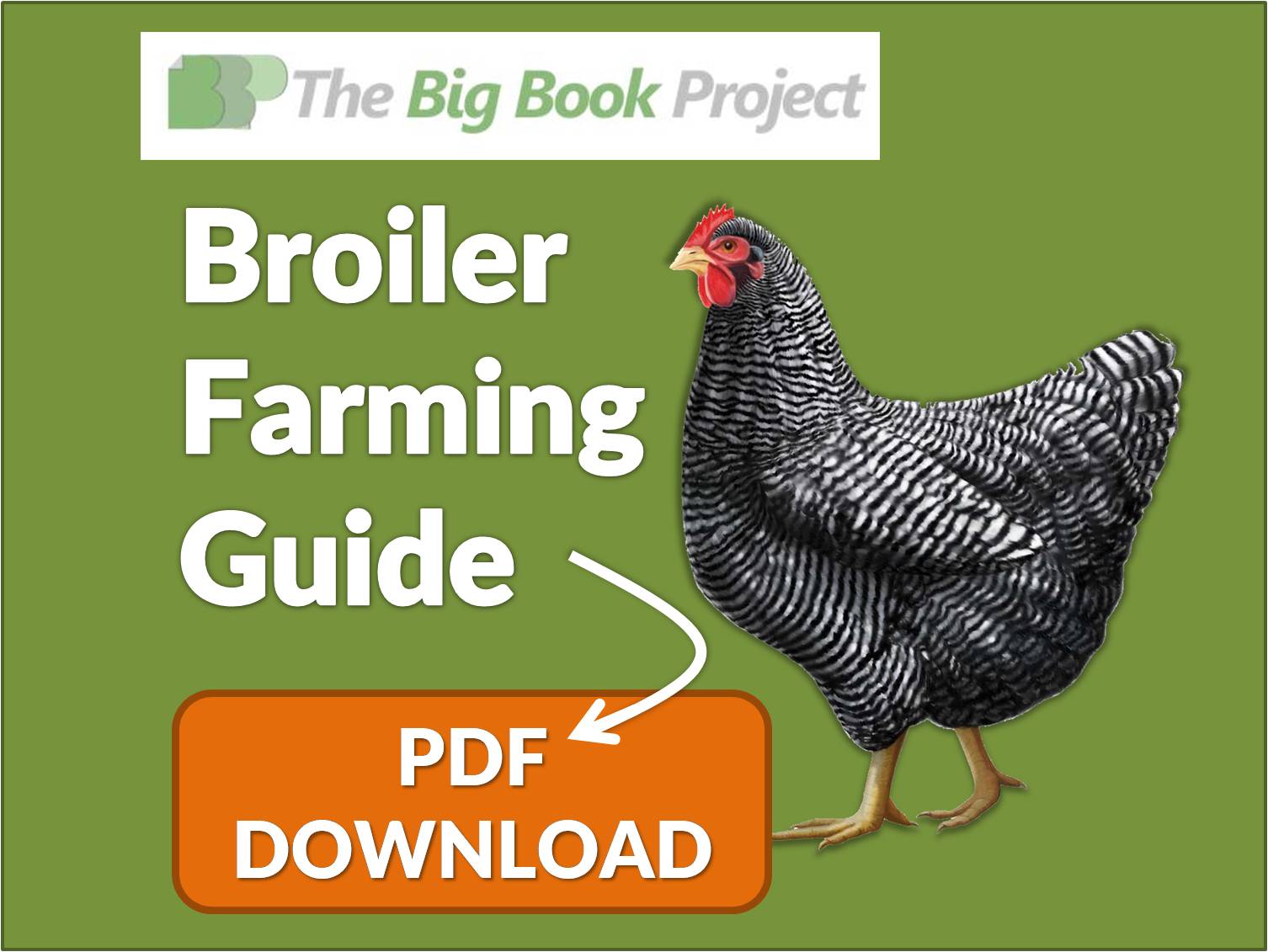
This is a complete guide to broiler farming.
Any country, any breed, any model…written just for you.
So if you want to:
- start a broiler farm
- get optimal growth
- pin down your costs
- make sustainable profits
…then you will really enjoy reading this guide.
Let me show you EXACTLY how to launch a profitable broiler farm.
Broiler Farming Basics
Receiving your new batch, week 2 – 5, raising your broilers for maximum growth & survival, week 6 (target week), getting your broiler flock to the market, now, i’d like to hear from you….
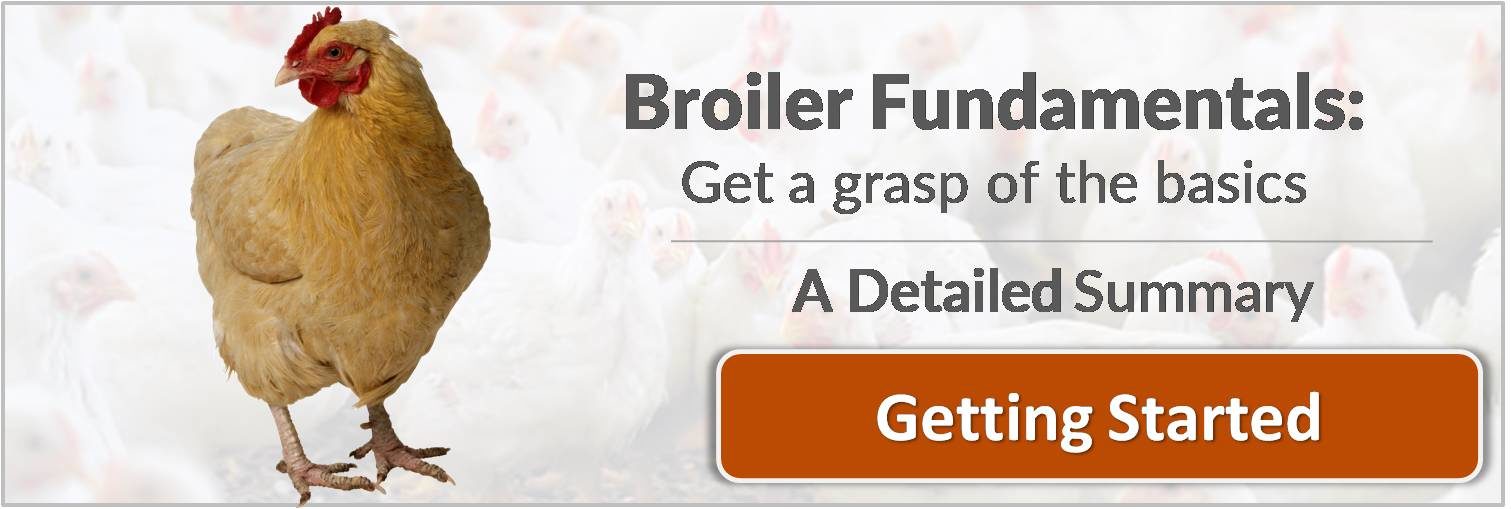
Within this chapter, I am going to walk you through the basics of broiler farming.
(Including the business , measuring your performance and winning management practices )
I’ll show you how you can make a profitable venture with your broiler farm plans.
Understand the business
What is a broiler chicken.
Broiler chickens ( Latin: Gallus gallus domesticus – translated to mean a ‘house rooster’) are farm-reared chicken kept for meat.
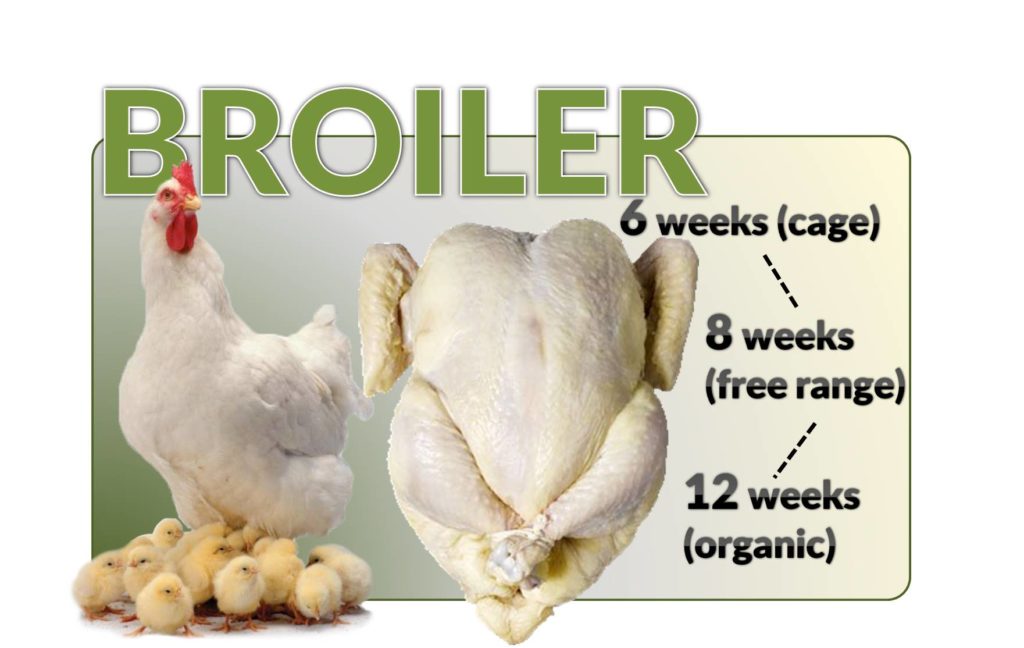
Depending on the model of farming, you would expect broilers to be slaughtered at:
- 6 weeks if raised in cages ( intensive )
- 8 weeks free-range
- 12 weeks organic (pastured)
As a product, broilers are processed, marketed and sold the moment they reach an optimal size and weight.
Getting meat in front of customers as quickly as possible, at the best quality with minimal input (feed)…
This is the aim.
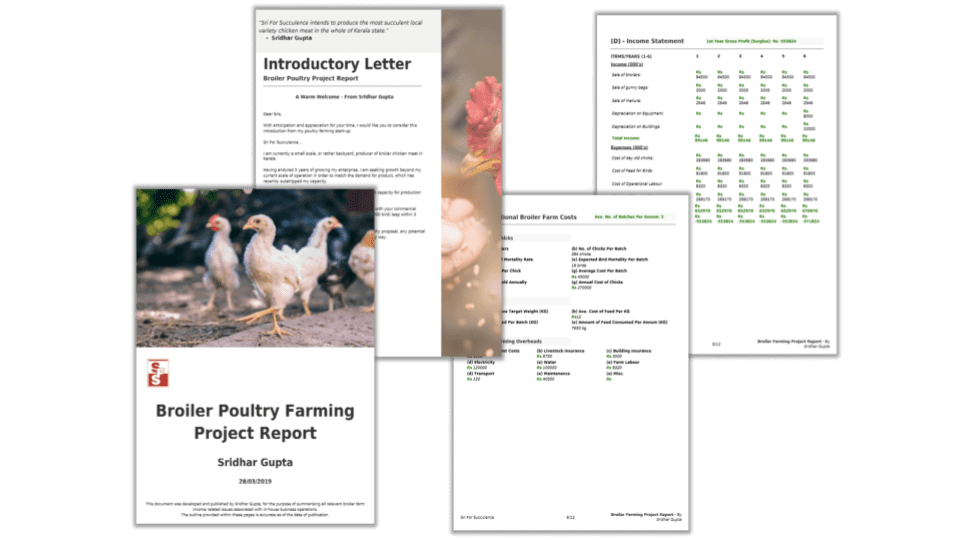
Write Your Poultry Business Plan - in Just 90 Mins!
Poultry Project Reporter 2.0 - fastest way to write your project report online.
Choosing broiler breed
Picking the best broiler breed for your farm is really important.
Here’s why…
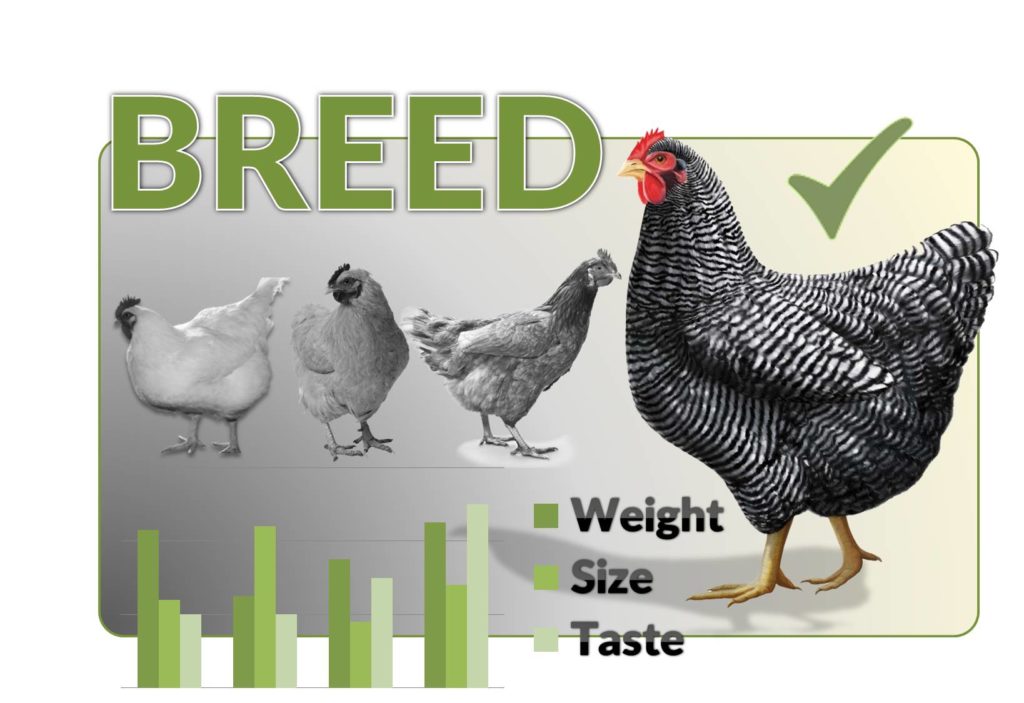
The broiler trade is all about physical attributes . Meat quality and quantity, as a combination, score lots of points.
The biggest headstart you can achieve – naturally – will help you get to your end goal of profit, more efficiently.
Whilst it’s not all about choosing an advantageous breed, it certainly helps.
These are traits that will give your success ratings a generous boost:
- fast growth
- quality meat
- docile/behaviour
- weight/size
- foraging ability
- weather resistance
What do bad traits look like?
- competitive
- slow growth
- poor quality meat
- easily affected by weather
The broiler value chain – industry in a snapshot
Your broiler farm is part of a much bigger chain of events that that is estimated to feed billions worldwide with over 105.26 million metric tons of chicken meat by 2023 ( Globe News Wire ).
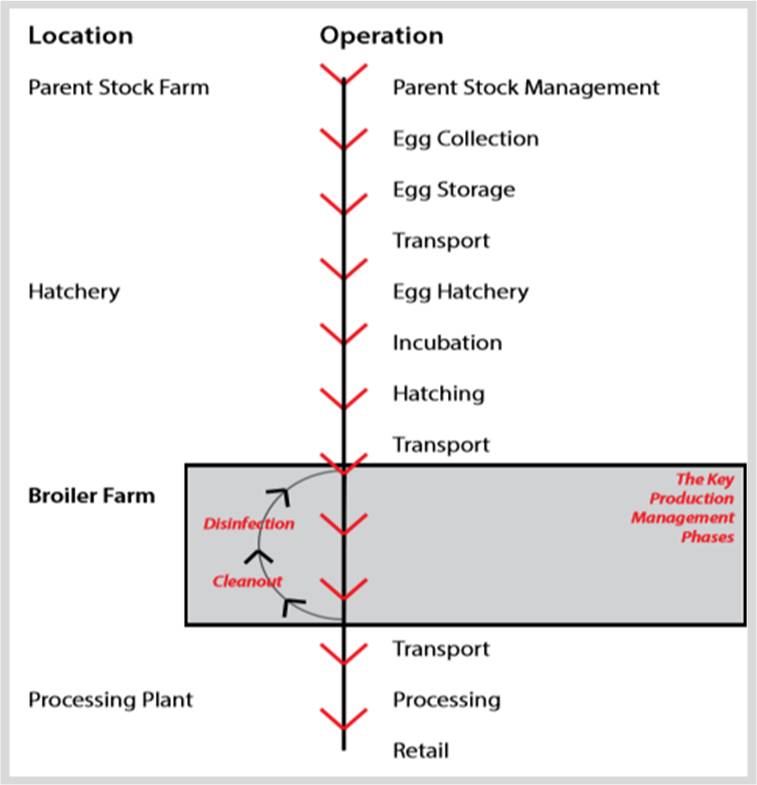
The grey box in the figure above, highlights where your broiler farm comes into play.
[This definitively answers the question: “Which came first, the chicken or the egg?…”]
Parent stock is where the journey of broiler farming begins.
They give rise to a generation of chicks which are after the likeness of the original stock.
The eggs are then collected and prepared for hatching by some specialised intermediate operations.
Once incubated and hatched,
…the chicks are then transported on the day of hatching to the farm that bought them, by batch.
Batch after batch is raised on the farm.
The farm observes very strict rules for handling safely in order to produce top-quality birds.

Quality of broiler being rated primarily by weight and size, achieved by a given number of weeks…
…6-7 weeks to be exact for cage farming (which is the industry norm for marketable, cage reared bird).
Beyond the farm, the birds are processed into carcasses and exchange hands until sold, cooked and consumed.
Hatchery – input
The input of your business is your baseline.
It defines where you start.
Get it wrong and you start at a disadvantage and have a much steeper climb ahead.
A good start, though, gets you in front by at least a head…perhaps neck and shoulders (wings) too if you choose well.
The key input for your broiler farm will be your batches of day-old chicks.
Cycle after cycle.
In the poultry industry flock uniformity is a useful summary of performance.
Uniformity is a percentage of birds that are within 10% of the target weight, for that age.
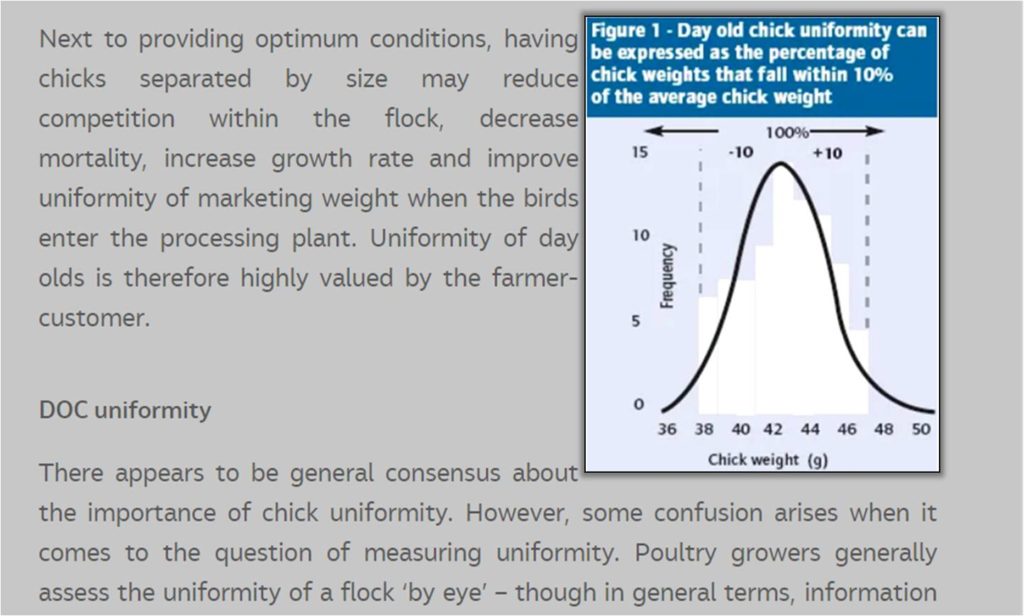
It’s important to remember that the overall profitability of your broiler business is influenced by every single chick (bird).
Getting birds sold depends on them meeting a marketable standard, on time.
Under-quality, birds are losses to your broiler business.
The condition that the chicks reach you in will largely dictate the quality of market-ready broiler you get at the end.
Set your batch on the right trajectory and it’s then all down to you from there.
- Feed & water them well
- Keep them disease-free
- Minimise stress
…you should be in for an acceptable output.
Broiler meat – output
Only good broiler meat that hits the quality mark gets sold.
In between investing in day-old chicks and selling carcasses typically after 6 weeks of rearing –
…there is a whole chain of events on the farm that impact quality.
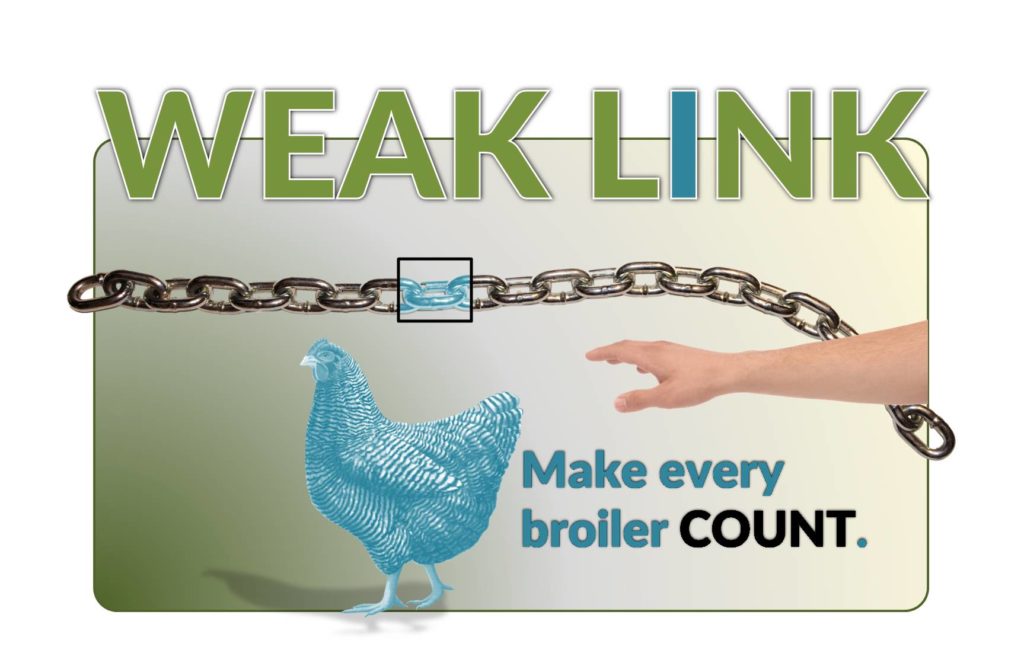
This chain of events is where you add value to your industry.
Your single goal?
To produce an environment coupled with an array of processes that are delivered with such control that you can almost predict success – with every single broiler .
In a word (…or three),
ROI – Return on Investment.
Translated: Getting paid .
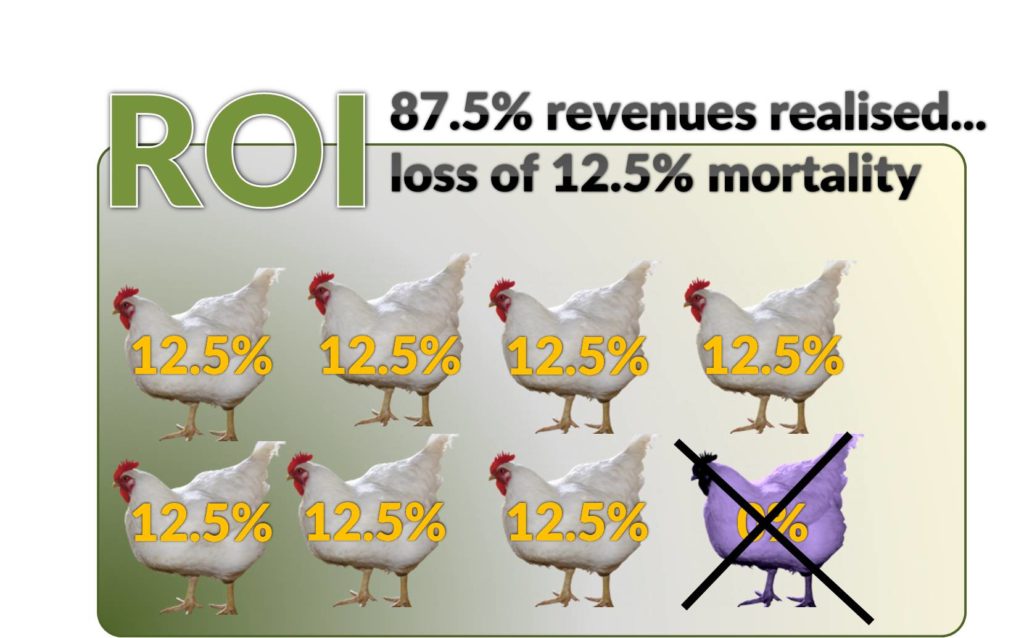
The more controlled and predictable your output from the broiler farm, the more you can count on your profit.
Broiler metrics & size
Broiler meat is sold on weight and accepted on overall quality.
As sales revenue is directly linked to every lb or kg of chicken mass, there are no surprises here then that the primary measure from day one is – weight .
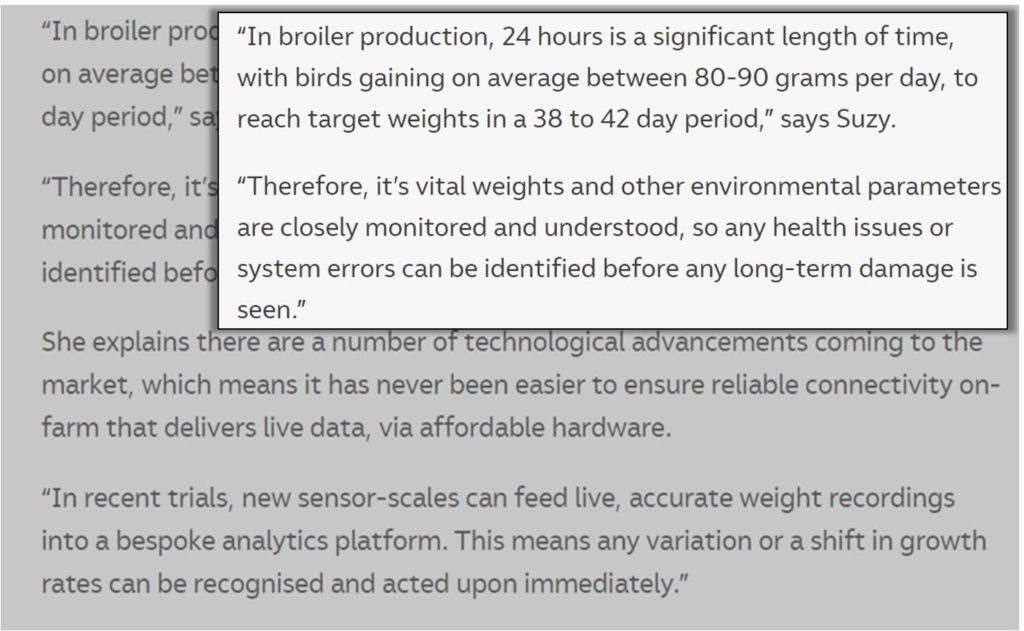
Because of the rapid rate of growth during a broiler rearing cycle, farmers cannot afford to take their eye off the prize.
The major contributor to the overall cost of broiler rearing is feed.
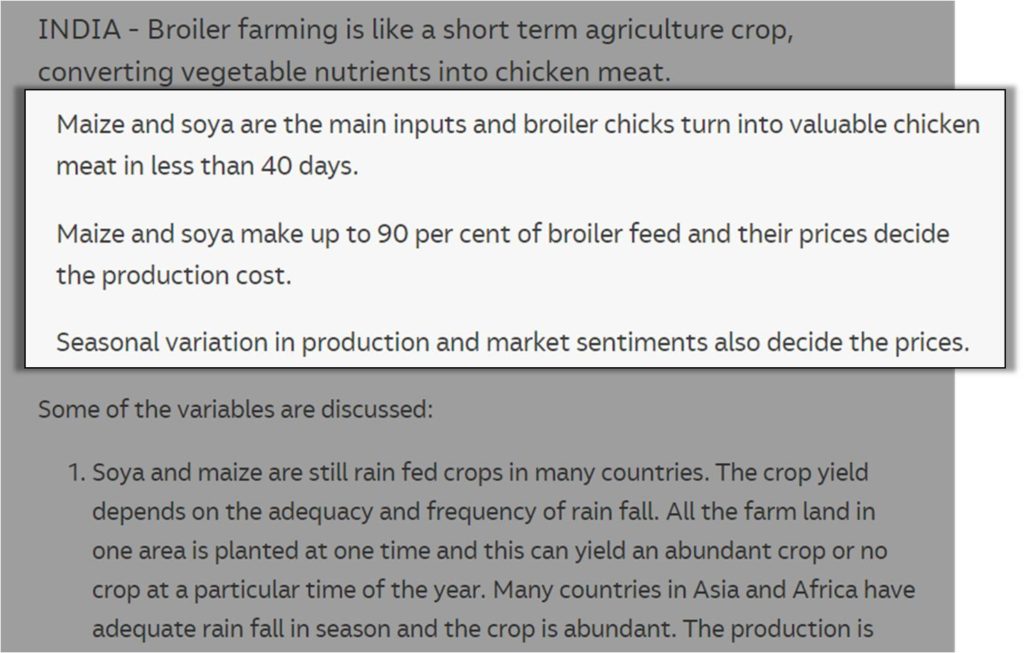
Influencing the cost profile of your broiler farm will therefore largely be down to your feed efficiency.
The more feed required to produce each kg of meat, the more expensive and less profitable your product.
Less feed for the same results = more profit.
Your broiler farming profit is a collective sum of the yield contribution given by every bird.
I always see profit as a tug of war between cost and price.
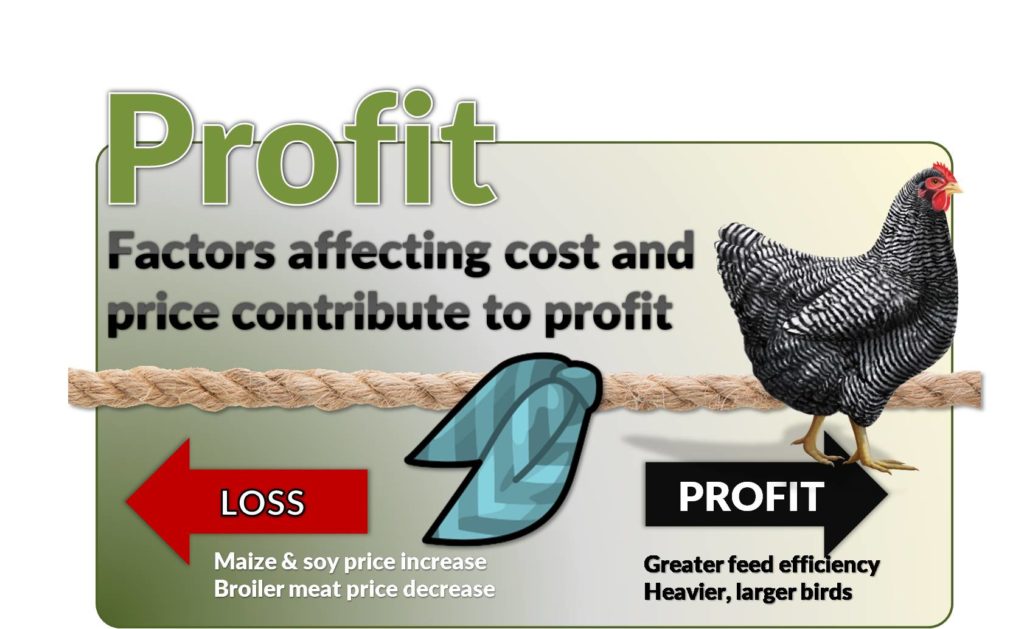
Wherever the flag lands, that is where your profit (or loss) is.
The factors affecting profit (and loss) include:
- feed cost (influenced by availability, shortage, previous season yield etc.)
- broiler meat price (influenced by the general quality of meat at the market at that time)
- uniformity of flock
- flock mortality
An important step in the process of running a successful broiler farm is accurate budgeting.
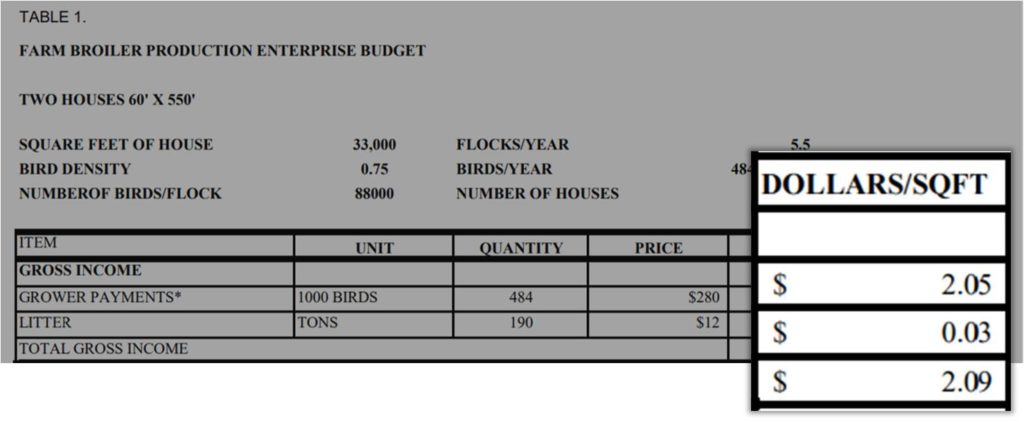
Being able to pin down income and costs to the cent on every dollar of money invested will give you pinpoint accuracy on projected earnings.
Get a razor-sharp budget together and carry an instant snapshot of what earnings you should expect.
As only the meat of the bird is marketable product, an important metric for your broiler farm is yield .
This is the measure of the weight of meat as a proportion of the overall carcass weight.
In other words, yield answers the question:
“How much of the broiler carcass weight is made up of valuable chicken meat (vs. bone, fat inwards)?”
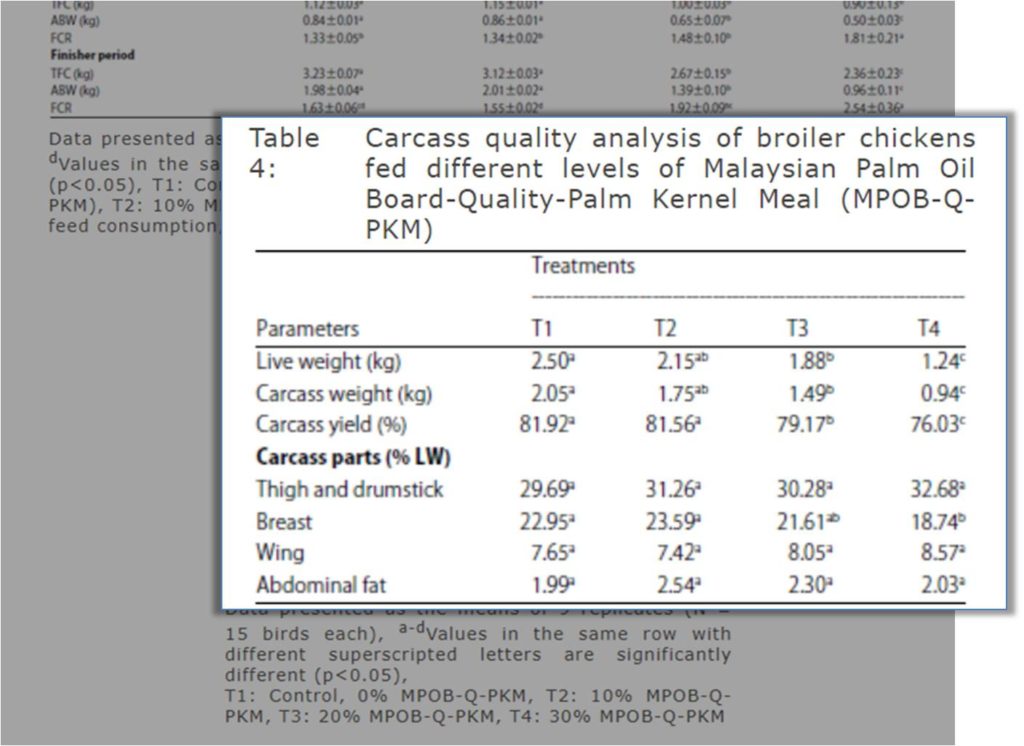
This adds a further dimension to the issue of broiler price per weight.
A breakdown of the composition of the carcass gives buyers a more accurate estimation of value.
More meat, more value.
Advantages vs. Disadvantages
The thought may have crossed your mind –
“…how does broiler farming as a business compare with layer farming for profit?”
There are many ways to measure the two related codes of poultry farming one against another.
But one of the most meaningful would have to be FCR (feed conversion ratio) .
As we said before, feed cost in poultry farming contributes the majority to overall costs…
So, the more efficiently feed is converted into a product of equivalent value, the more profitable your farm.
In other words, if feeding a broiler pays more per lb or kg of meat than feeding a layer for eggs…
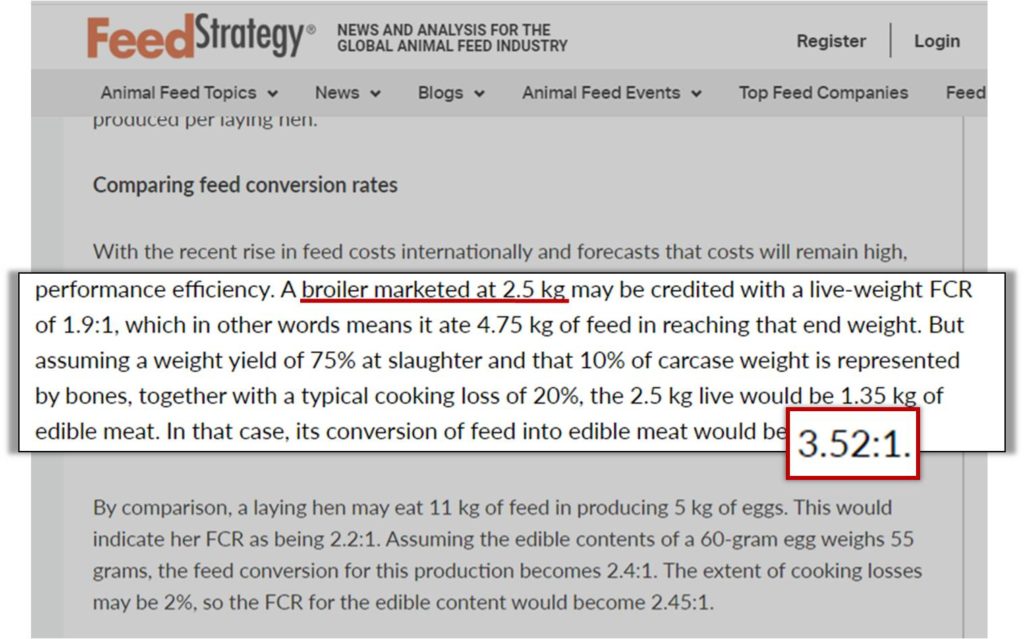
…or vice versa –
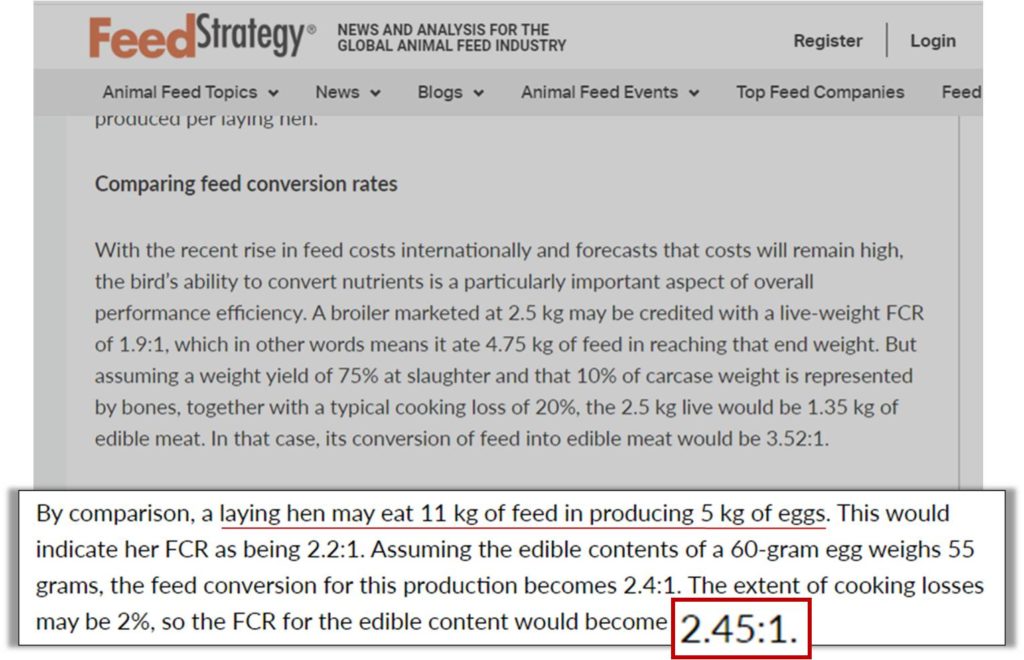
…whichever has a better conversion ratio, that would be the better investment on paper .
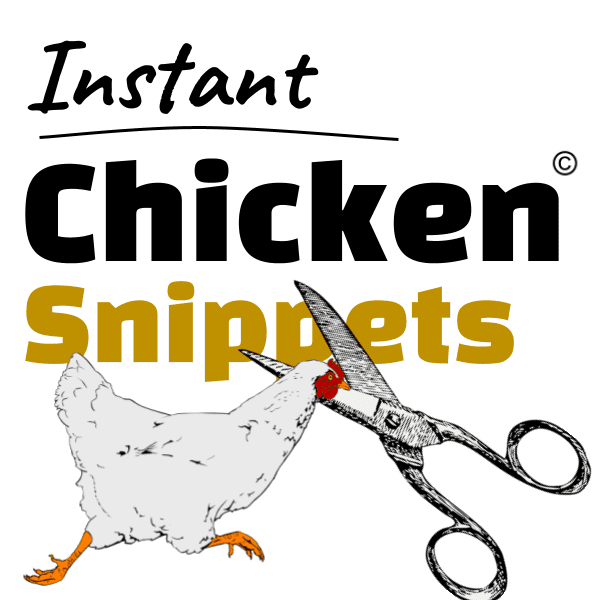
Read The Poultry Business - Like Never Before!
Chicken Snippets Newsletter - deep poultry analysis to sharpen your acumen, by email.
Commercial performance
Getting the balance right.
Broiler birds are highly sensitive systems.
So many internal and external factors all contribute to the end product – the amount of premium chicken meat on the bone.
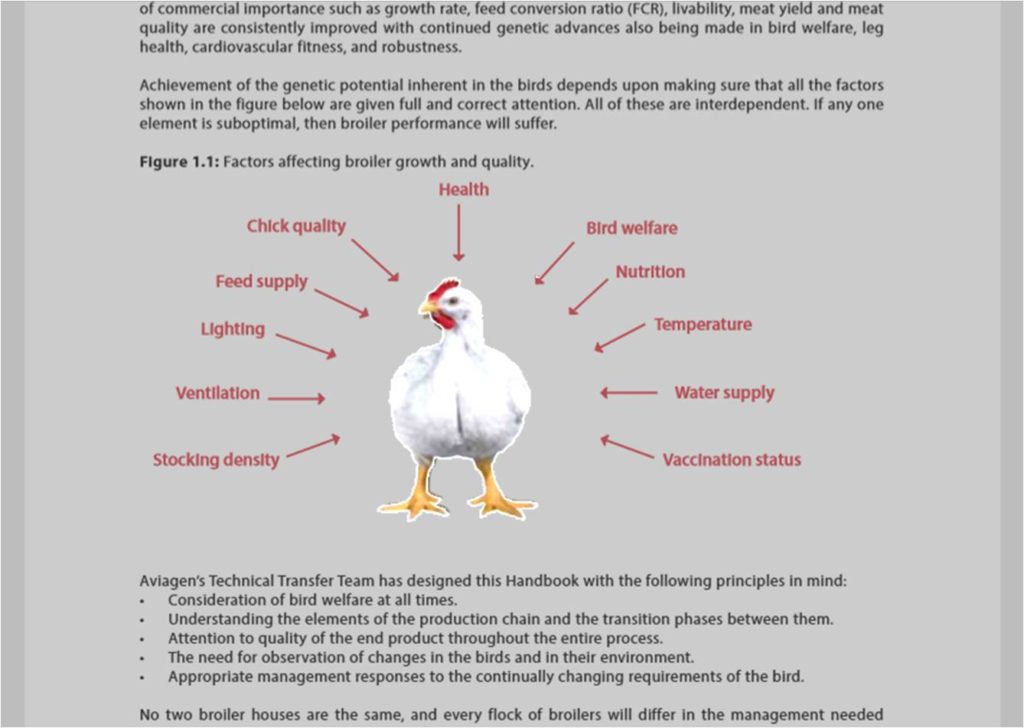
These factors either add or take away from the eventual weight of a marketable broiler.
Affecting the bird’s ability to convert feed potential into valued meat…
…each factor presents an opportunity to fine-tune your farming profits.
Picking up your points
The way to think about your broiler business is to think about a competitive sports league table.

Let’s say there are 20 teams.
Each team starts with 0 points, and must play one another twice – once at home and once away.
This makes 38 league matches played per team, per season (19 home matches + 19 away).
Points are awarded to teams per performance according to the result of the match.
- 3 points to for a win.
- 1 point to for a draw.
- 0 points to a loss.
The team with the most points accumulated by the end of the season is the champion.
There is a maximum potential points that a team can pick up, being 3 x 38 = 114 points (… should they win every match in a season, beating all their opponents. )
So depending on if you think along the lines of a glass half full or empty ,

you could say either…
…every team starts the season with a potential 114 points and loses them along the way, should they draw or lose…
…or rather, every team starts with no points and picks them up along the way.
Each team’s ability to perform optimally depends on many internal and external factors including:
- player condition and availability
- training consistency
- weather and pitch condition
- match official decisions etc.
Broiler farming is very similar.
You start with a batch of broiler chicks at your farm on day one.
Each bird with the potential to become a marketable broiler of optimal size and weight.
Multiply the number of birds by your target weight and this is your maximum potential production for that batch.
Every internal and external factor affecting the ability to reach or fall below target.
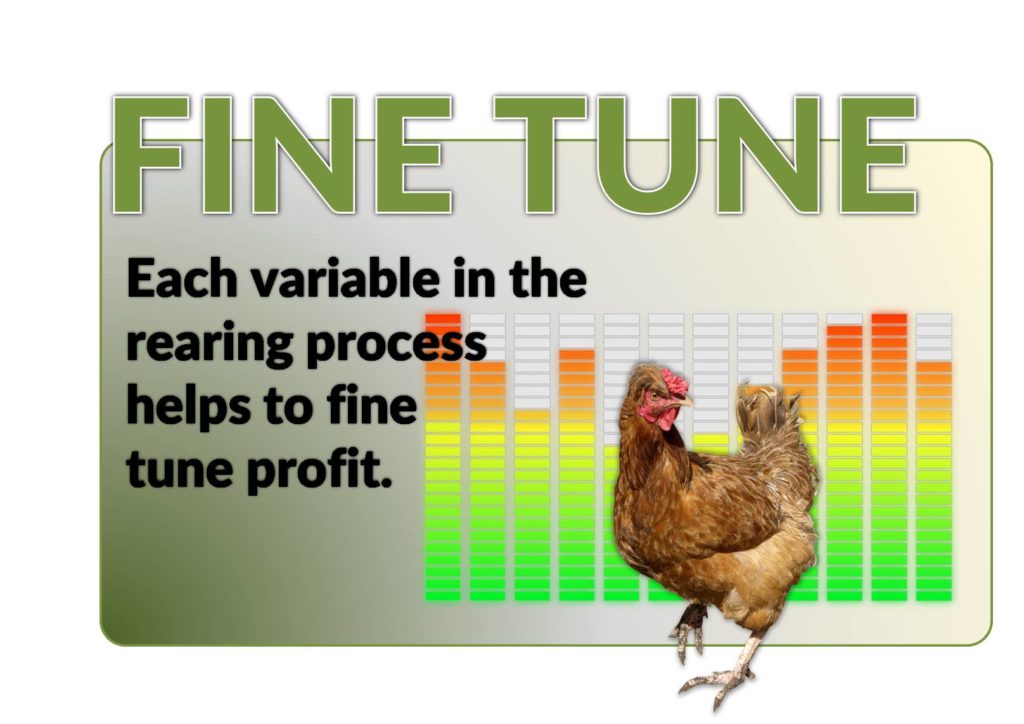
Points picked up or points dropped.
Tracking performance of your broiler birds is your way of keeping your finger on the pulse of profit.
Significant developments within your flock happen daily.
Age is the primary indicator. All expected developmental targets are intrinsically linked to age – often noted in days .
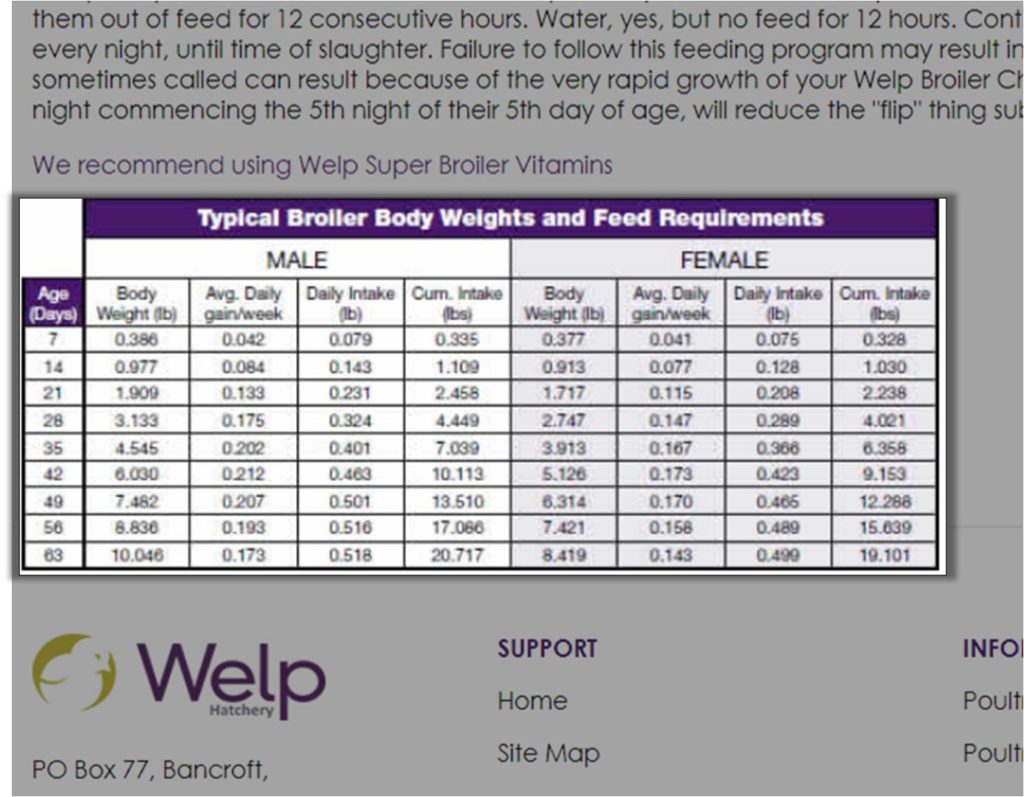
According to charts like the one above you can precisely pinpoint the target weights of your flock.
This is a growth budget . A way of tracking by major milestone whether your performance is on target, above or below.
As well as internal indicators of your flock’s development, you’ll want to keep an eye on market prices.
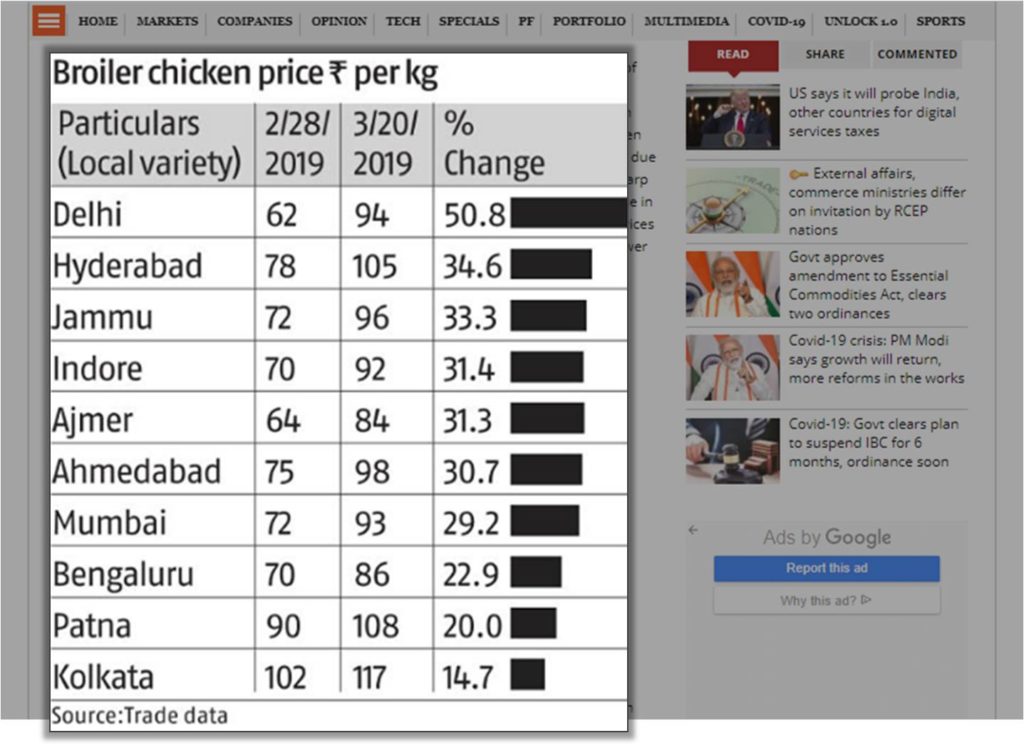
They continually fluctuate.
Timing is everything. Your margin might be entirely wiped out by just a little contrary movement.
And whilst you are restrained by nature to when your flock hits the market (at the end of their cycle)…
…you have free licence to broker deals anytime leading up to delivery. Skill in this area can get you bottom line perks.
Market timing
Getting your broilers to market on time is critical.
If you are late, not only will you disappoint your buyers, but more importantly you will lose profit for every day lapsed.
Your deal with buyers will depend on target weight being achieved, by a given date.
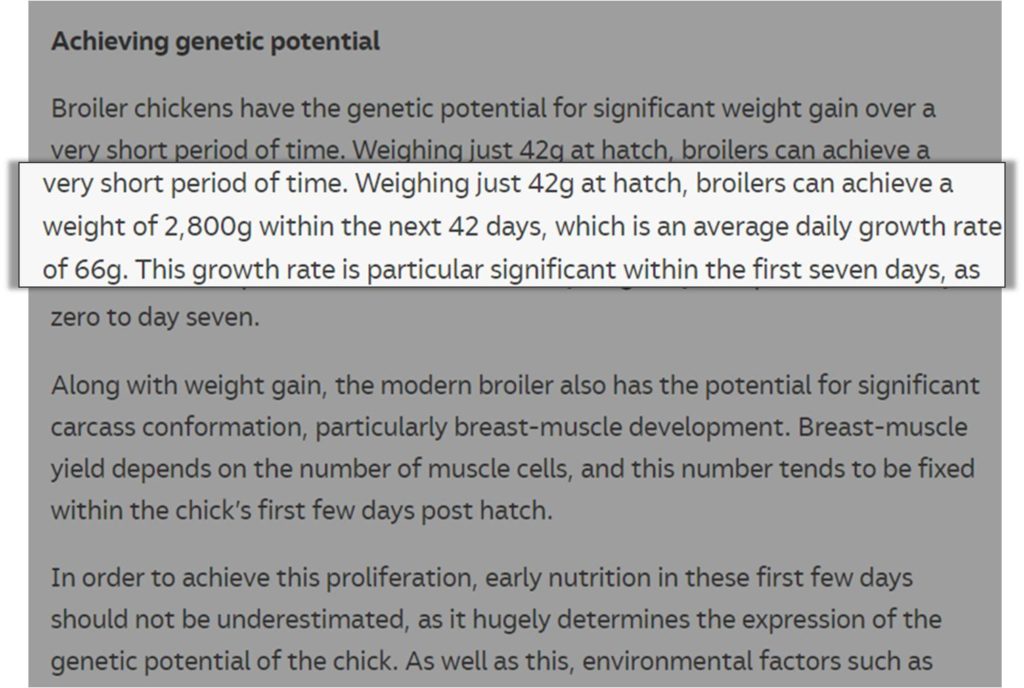
“…what happens if your flock is significantly underweight on the target date?”
For every day of delay in getting broilers to market, profits are eroded by feed cost to the tune of 3lbs per day, per bird.
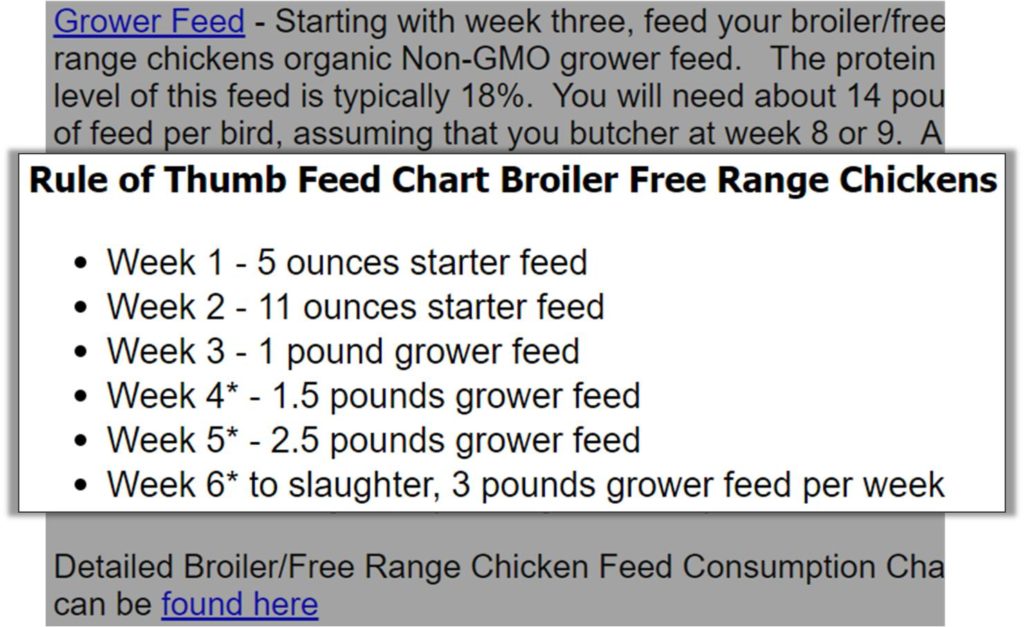
Getting the product to the market on time is your way of avoiding disappointment.
Maintaining projected profit, protecting your earnings.
Parent stock and weight gain
The broiler business is a sprint .
Layer farming, on the contrary, is a marathon .
Broiler farming is all about reaching the finish line of target weight, in record timing – and with good quality.
Over the decades of industrialised broiler production…
…the market has devised more and more methods of breaking world records.
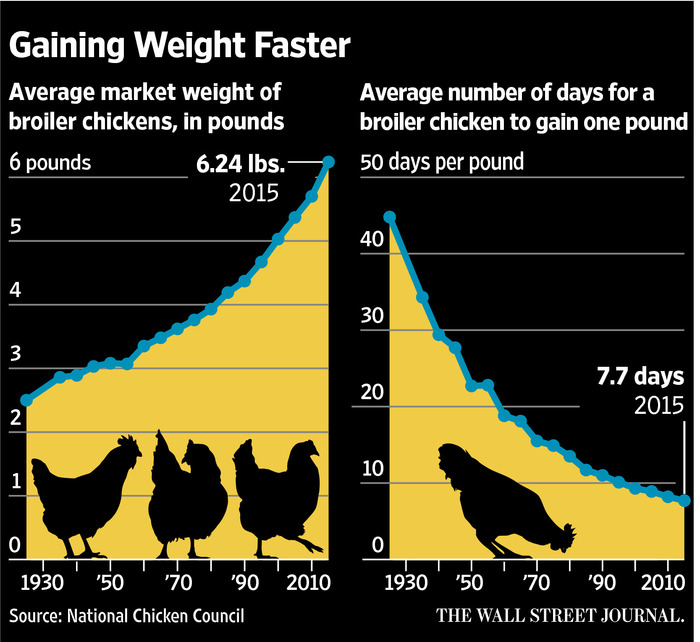
Over the last 80 years according to the graph above…
…the average number of days for a broiler chicken to gain 1 lb has dropped from over 40 days to only 7.7 days.
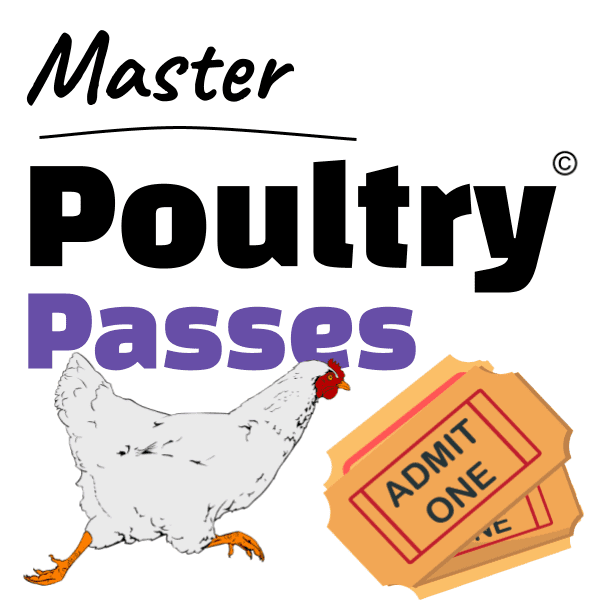
Master The Poultry Business - Like a Pro!
Poultry Courses Online - most actionable and interactive online poultry course.
How was this achieved?
Largely by selective breeding of parent stock.
Choosing the stock with the quickest growth traits and inbreeding them until the timing is shaved down.
With broiler farming, there is a trade-off between quality and quantity – like with any business.
Know where you stand. Set your stall out according to the values of your customers –
And serve them.
Cage (intensive)
The cage broiler set-up is built for large scale and quick results.
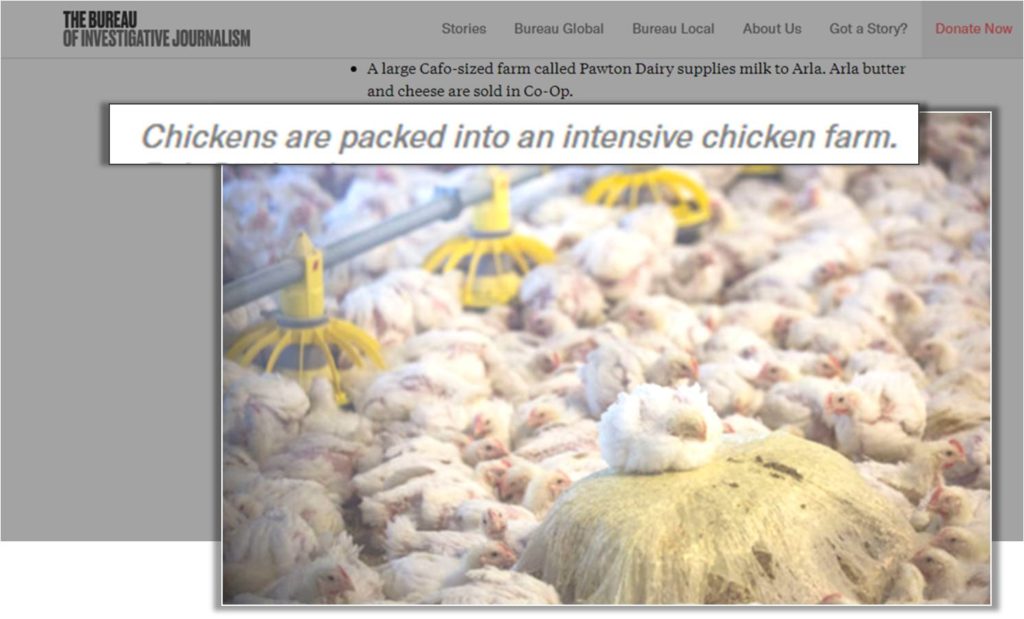
Birds are stacked and piled high for optimal density and volume combined.
Capital investment is spent on equipment and environmental control systems.
Free-range (organic)
Organic or pastured broiler rearing is non-intensive.
A more liberal rearing experience for the birds (e.g. grazing on pasture), giving rise to richer nutritional content.
Take this chicken caravan, pulled by tractor:
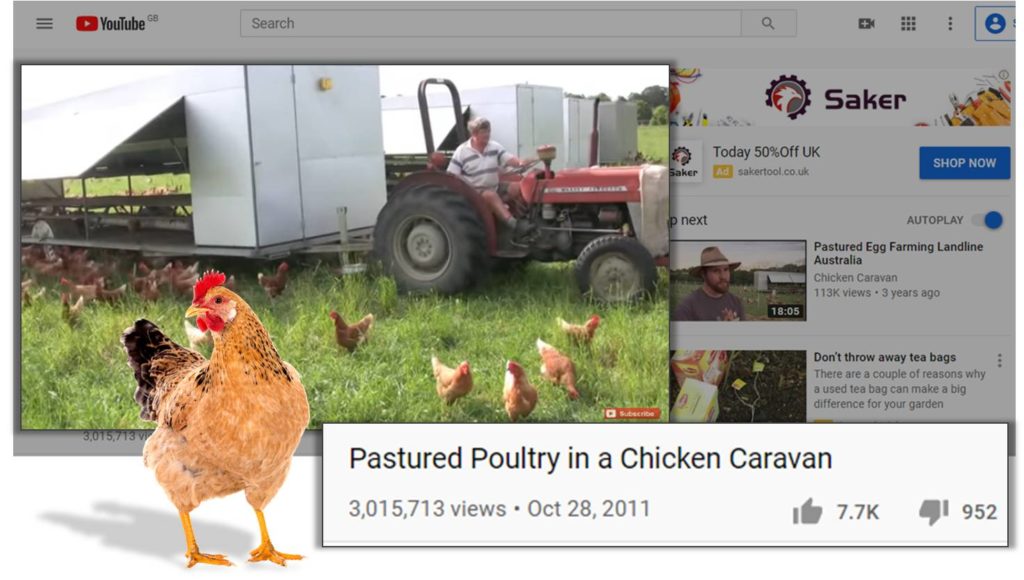
…a great solution for allowing your flock the freedom to roam, yet controlling their containment.
Birds are given a more liberal rearing routine with the end quality of meat in mind, more than sheer scale.
The end meat-product appeals to a more discerning buyer who is willing to pay more for the benefit.
Essentially, a premium product.
The secret to broiler farming success is meticulous management .
Farm success is built largely upon operational procedures and processes.
The handling of each individual variable directly impacts your bottom line.
The more consistent your handling, the more reliable your future profits.
All in all out
The golden rule with broiler farming management is “all-in-all-out”.
What does this mean?
AIAO (all-in-all-out) is when a broiler farm manager accepts only one batch of broiler birds to rear at any one time on-site.
In such a rearing system you will NEVER have more than one batch of birds occupy the farm at any one time.
Take a look at this expert viewpoint from Dr Ahmed Atef , Poultry Nutrition Specialist ( at The Centre for Concentrates & Feed in Cairo, Egypt ):
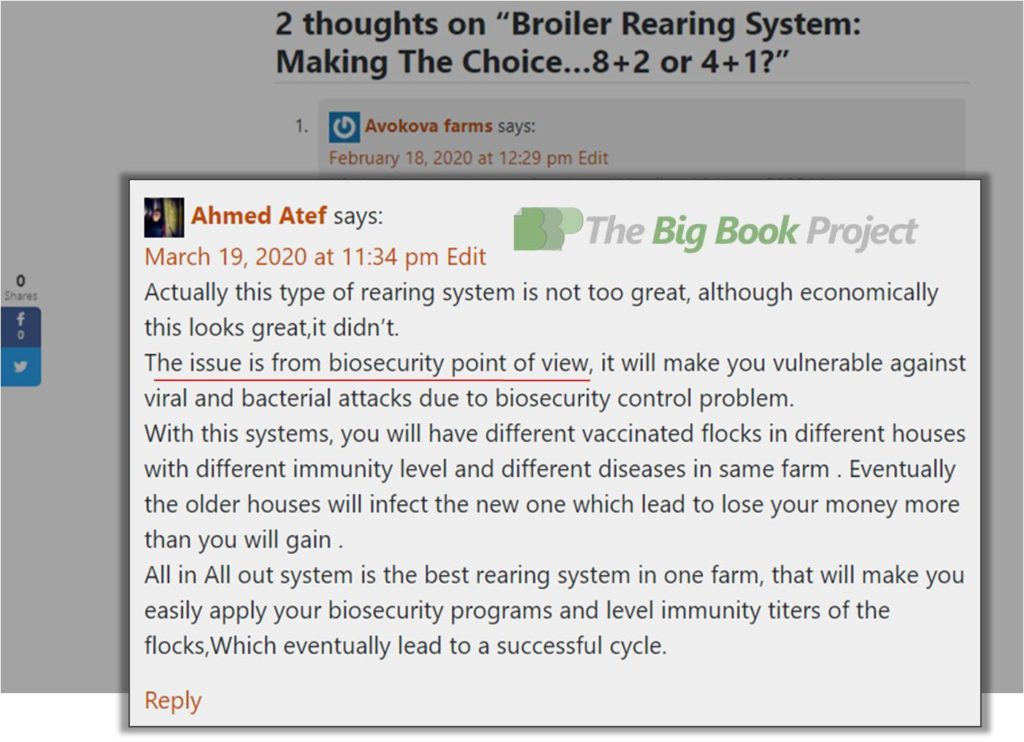
In our post on “ Broiler Rearing System “, Ahmed Atef a participating poultry expert in The Big Book Project member’s program says,
“All in All out system is the best rearing system in one farm…eventually lead to a successful cycle.” – Ahmed Atef
According to Ahmed, cohabiting flocks on your farm will increase cross-infection from viral or bacterial pathogens.
Managing one flock at a time per farm means that each farm naturally faces a 6 week – or above (full cycle) lag in between flocks. This also slows down cash flow.
However, the set-up is less vulnerable to the outbreak of disease and your profits are potentially safer.
If you want to achieve a more frequent arrival to market, like in this example of 8+2 broiler rearing (but still maintain All-in-All-Out)…
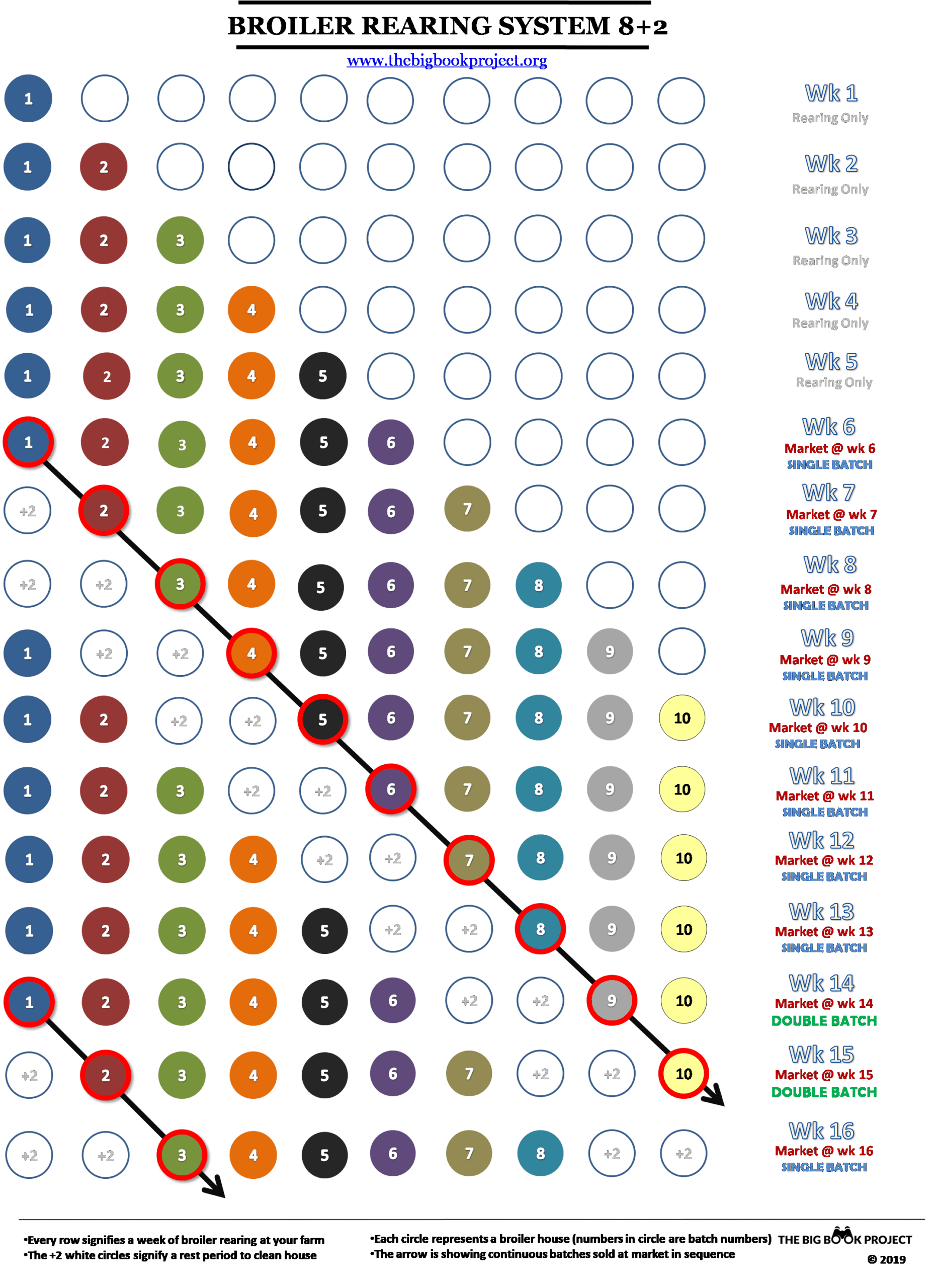
..the answer (although a costly one) is to set-up other broiler farms to operate simultaneously.
This way you could arrive at the market more frequently than a full cycle’s interval of any one batch.
Even delivering broiler meat to market every week, if you liked.
Location & orientation
Make the most of your natural surrounding on-site the broiler farm and you can save cost and improve yield.
Carefully considered positioning of your site can make all the difference to future business success.

Poultry house conditions such as ventilation and temperature can also be supported by where you site your farm.
Also, water availability is critical.
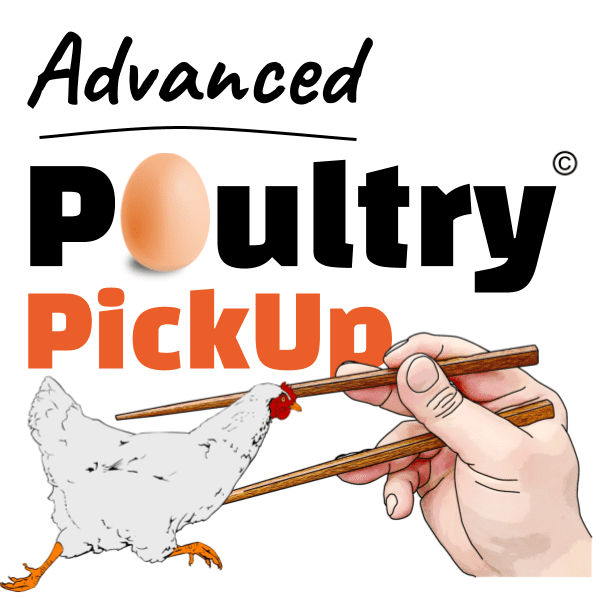
Advance Your Poultry Project - Into Maximum Profits!
Advanced Poultry Pickup - hands-on, 1-to-1 poultry business consultancy - anywhere.
The further your farm is away from a clean water source, the greater your cost of transport.
The scale or size of your broiler farm comes with its own challenges.
The larger , the more:
- land, buildings & equipment
But with larger inputs, come potentially larger outputs and cost advantages.
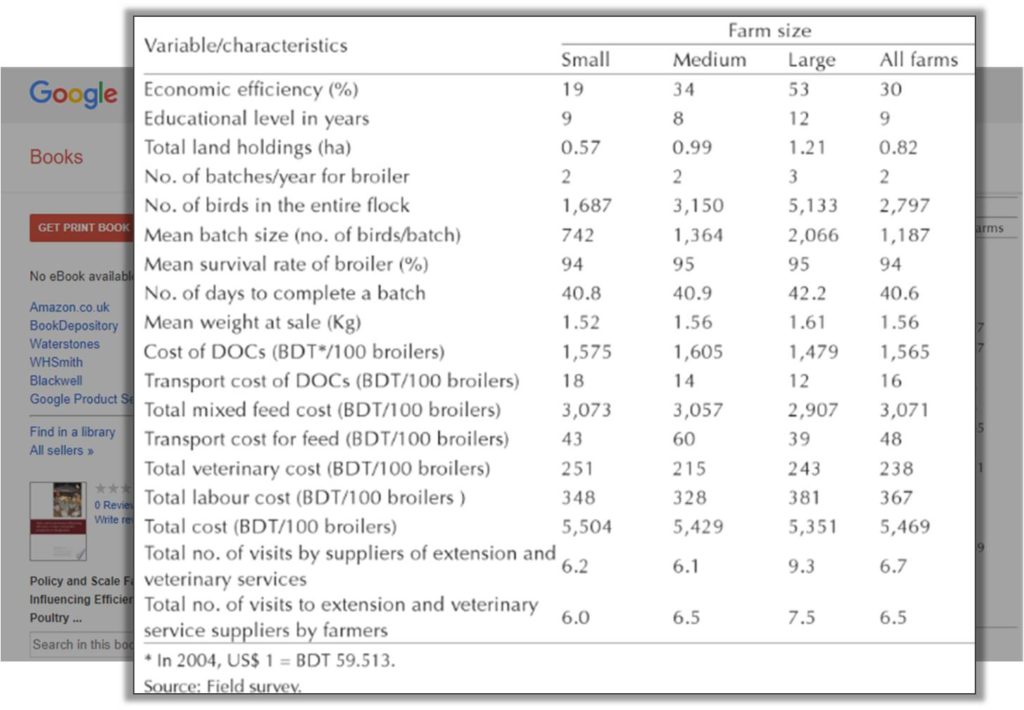
The table above was a comparison field survey carried out in 2004.
It compares the size of broiler farms and their economic profiles.
What was the bottom line?
Larger farms (farms with more broilers per batch) required more:
- landholdings
- visits by extension and vet services
..but because of greater financial efficiency from:
- cheaper cost per day old chick
- cheaper cost for transport from the hatchery
…the net profit margins of larger farms exceeded the profit of smaller farms.
this is not always the case in business.
And scale is an individual choice.
There is such a thing as biting off more than you can chew.
Site planning & layout
Operational success and efficiency have a lot to do with proximity .
If things which you need are nearer to your hand, they are more readily available for use.
This means you work harder, quicker and finish sooner.
Also, you have fewer accidents, spillage (waste) and clock up less error.
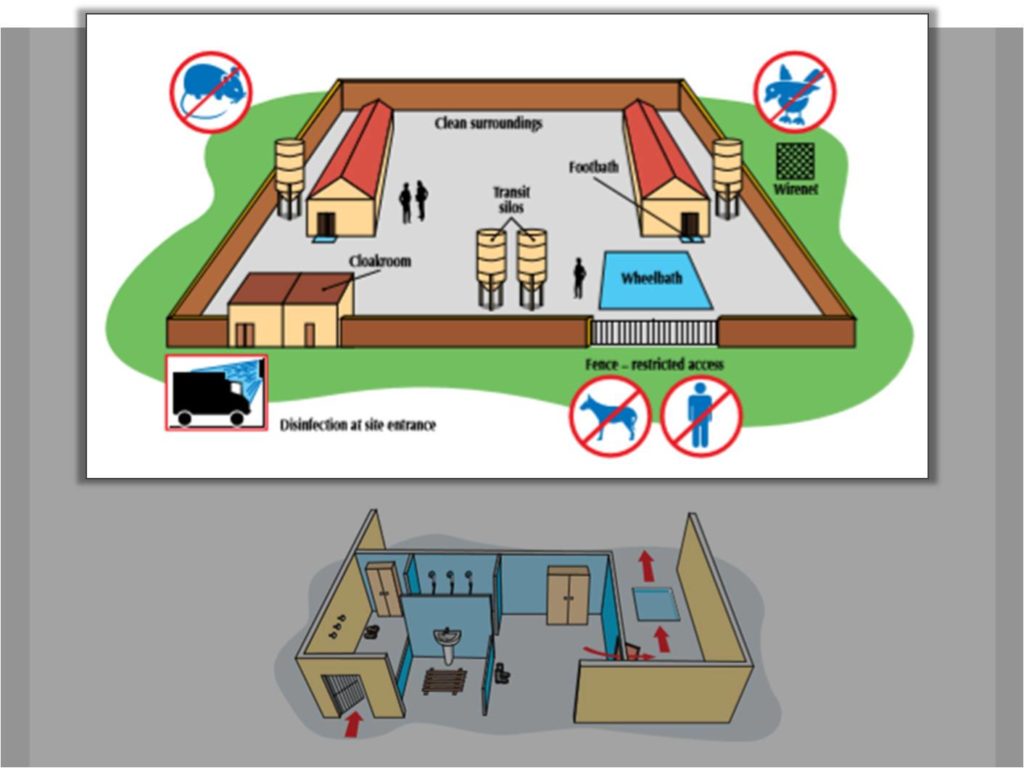
A key focus for planning your broiler farm layout should be hygiene.
Cross-contamination often occurs because of lazy thinking or critical flaws in planning.
Consider every pathway or workflow of movement around the farm and minimise infection risk .
Processes & Procedures
The single most important aspect of broiler farm management is workflow .
Controlling every functional task within the farm processes from beginning to end…
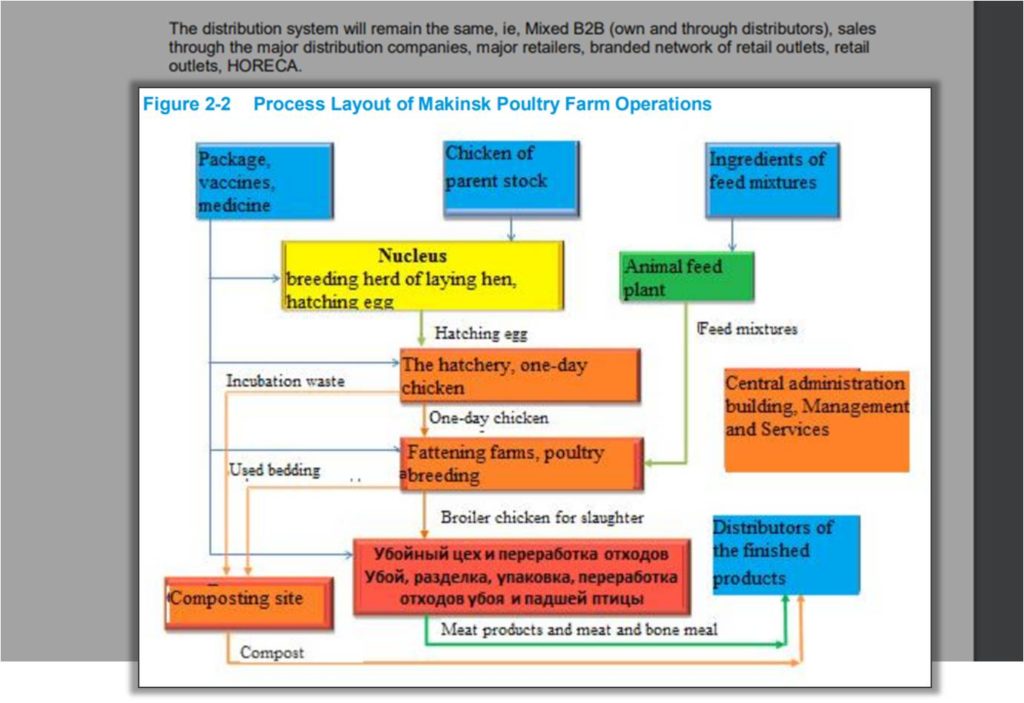
…gives you maximum chance to pick up and retain those points.
And in the poultry business, points equal profits.
Environment
Environmental control affords comfort for your flock.
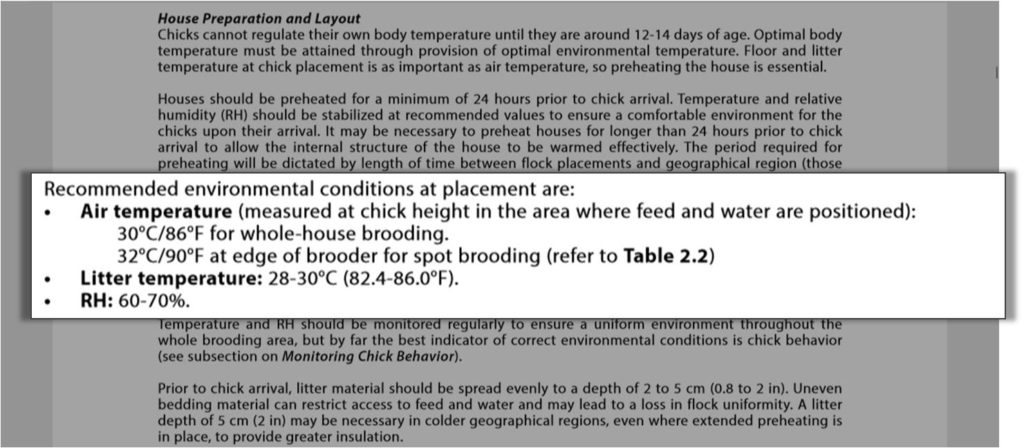
Temperature, humidity, lighting, ventilation, noise, density…
…all have an impact on their well being and ability to grow.
Hospitality goes a long way to keeping your broiler flock in peak condition .
A well-kept flock make for good profits.
With broiler farming building integrity seems to be a frequently overlooked piece in the long term profit puzzle.
Buildings that have vulnerabilities are long term business liabilities –
Not assets.
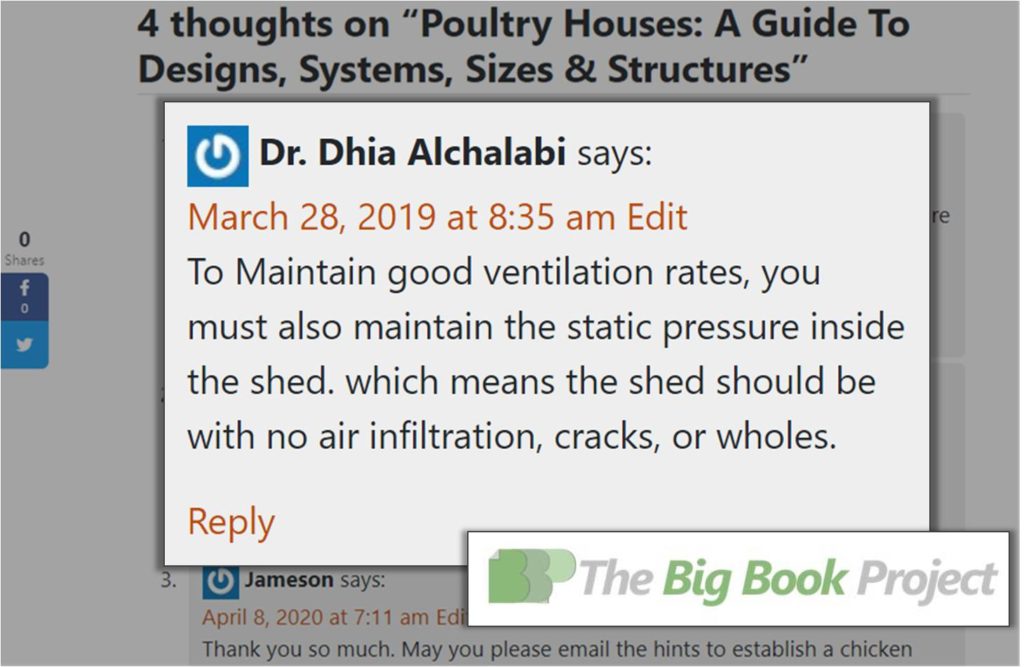
In the ‘ Poultry Houses ‘ blog comment above from Dr. Dhia Alchalabi ( Doctor of Philosophy Ph.D. focused in Agricultural Engineering Technology from Michigan State University) :
“…you must also maintain the static pressure inside the shed.” – Dr. Dhia Alchalabi
Temperature leaks, uneven distribution of heat, water leaks etc.
General discomfort for your flock leading to underweight results .
So, ridding your broiler houses of any deficiencies will lock in your profits for the long term.
Stockmanship
The more time you spend with your flock, the more attentive you will be to their needs.
Sure it will cost you in time spent on-site, but the costs of missed signs of trouble could be much worse.
Count the cost of your project commitment against the real demands of keen husbandry.
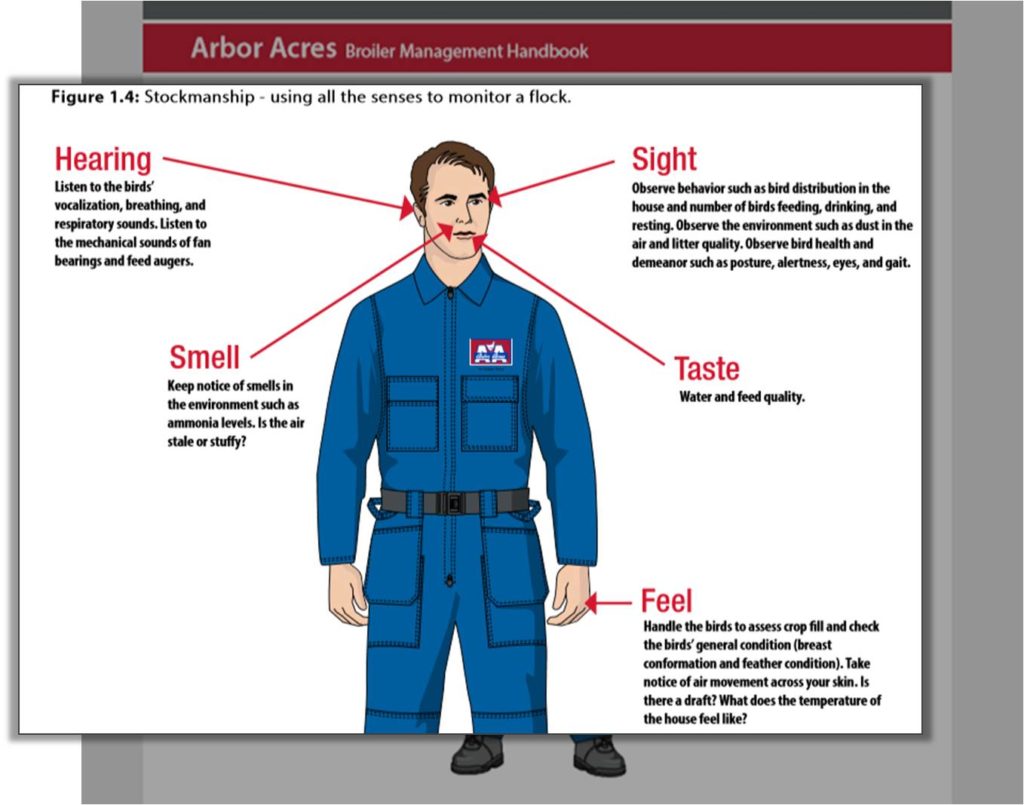
To know your flock ( KYF ) you’ve got to get immersed.
Your birds could be telling you of problems ahead by something as slight as their breathing rate…
…are you keen enough on hearing and sight to know there could be something wrong?
The only way to develop this is practice …spend more time on-site.
The full 5 senses need to be engaged.
Only then will you have that feeling that something needs correcting which saves your bottom line.
Problem-solving
Having a list of possible’s and probable’s when things go wrong will give you some responsiveness …
…and timing can make all the difference when putting out potential fires.
An issue like, not eating could find its root in all types of causes:
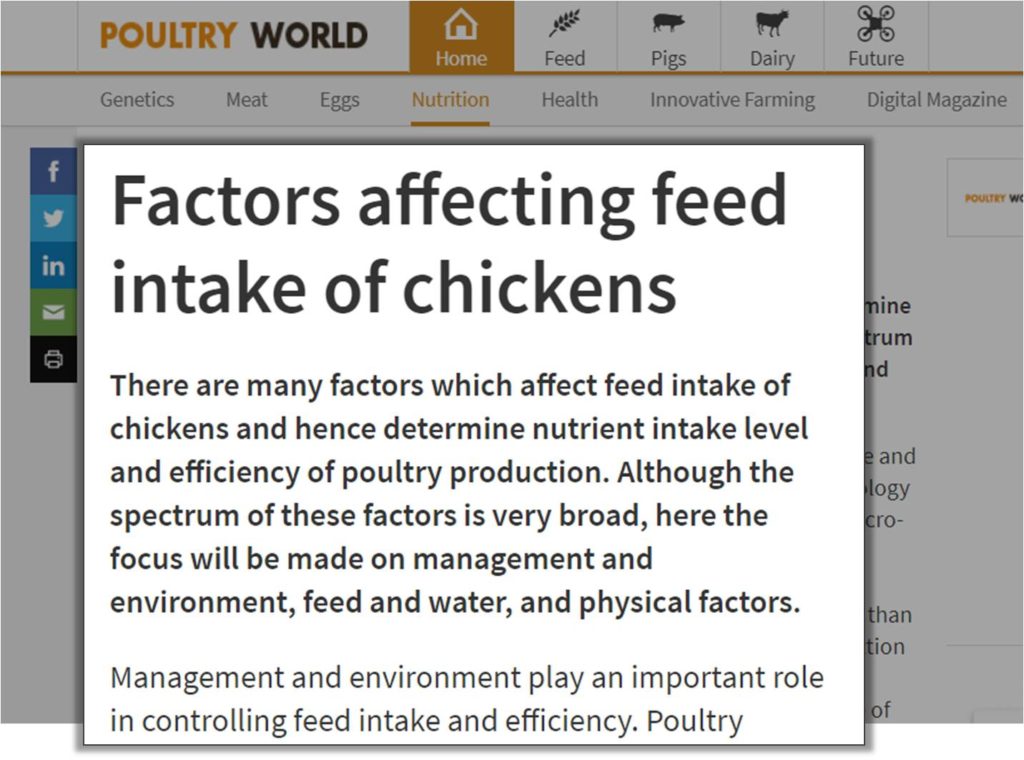
Clearly, feed directly impacts weight…which directly impacts sales and so on…
The compact nature of the broiler cycle means a day or two of inadequate feeding can cause a slide off which you might not recover from within the 6 weeks, for example.
Daily gains all add up.
House Design
Broiler housing is dependent on so many factors:
…your chosen model, the scale of the farm, locally available building materials etc.
The house design spectrum is broad .
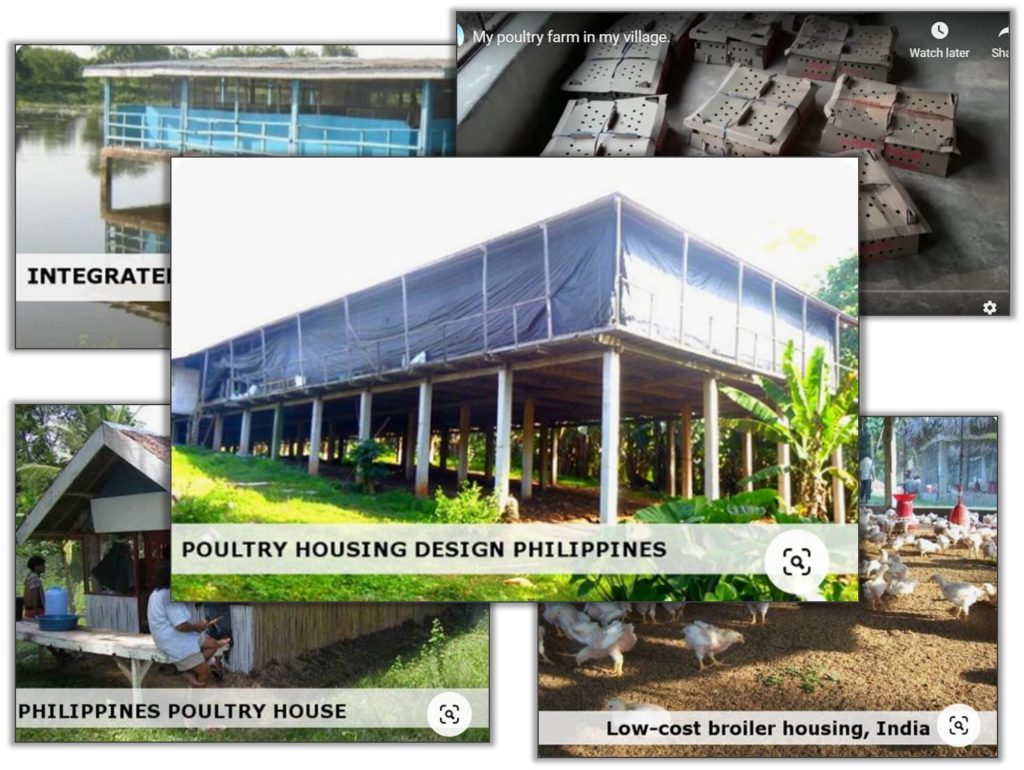
There is plenty of room for leading in new ways of thinking about broiler farm housing.
Climate, location, orientation, topography – the factors affecting your choice are too many to be exhaustive.
Research broadly.
Look locally at model broiler farms, as well as at other countries with similar climatic profile to yours.
Develop a scrapbook of feasible ideas and shortlist a potential line-up of materials and features.
Space requirements
One practicality with broiler farming is planning space .
How tightly packed your flock is (density) influences their ability to grow as chicks into full-sized broilers.

As broiler chicks grow, their need for space also increases in line.
Planning ahead, including factoring in your expectation for farm growth, will help you provide enough to accommodate your vision.
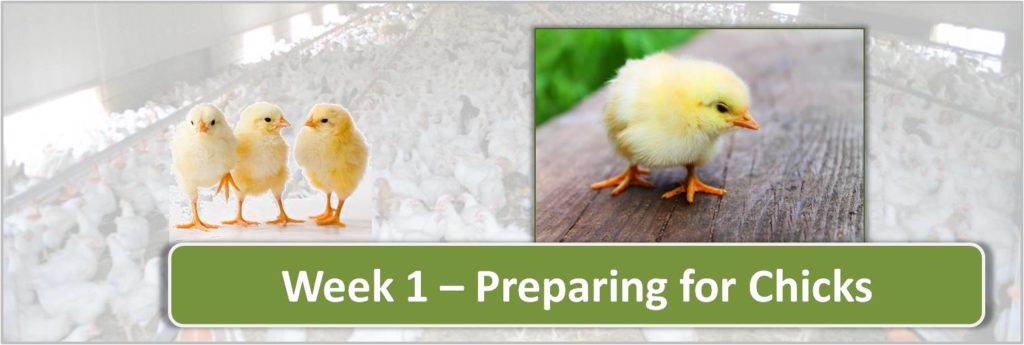
Now, we are going to take a look into the critical 1st-week management of your new broiler flock.
This start very much sets the tone for the remaining weeks of the rearing period.
Preparing to receive
The very first steps in accepting a new batch of broilers are influential for the success of the cycle.
Chicks are highly sensitive , such is the nature of the young of any animal.
In between hatching and your broiler farm, each batch changes hands a number of times and become exposed to sudden environmental changes .
Cobb , industrial broiler breeders, advise the following farm preparation :
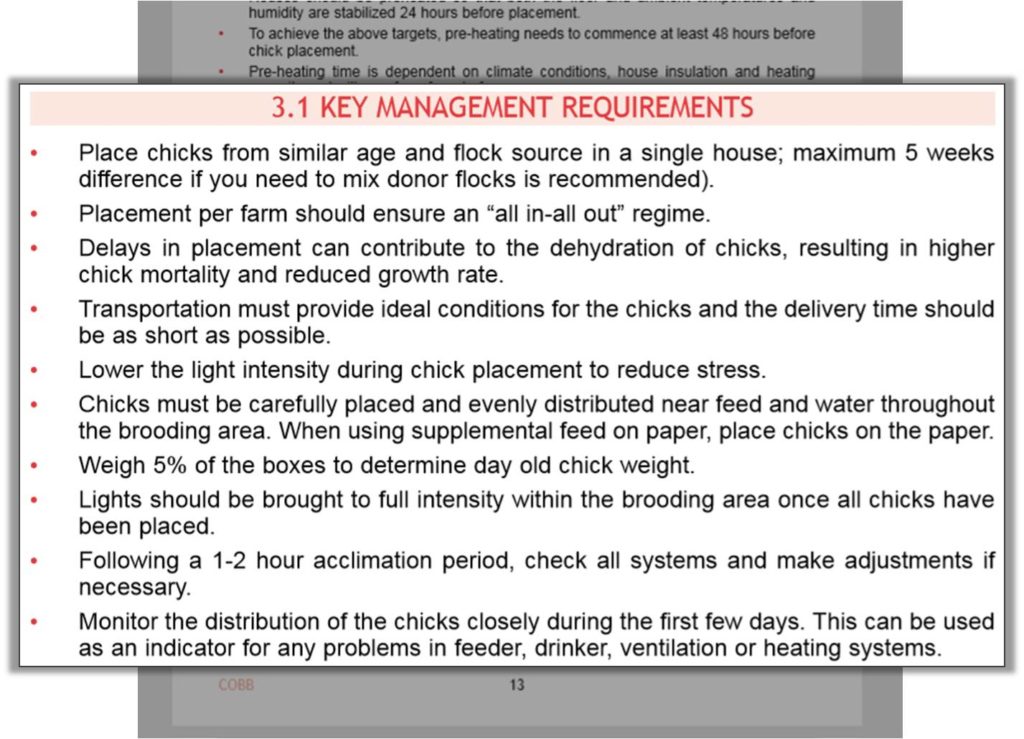
Again, the golden rule for survival’s sake is all-in-all-out hosting of batches.
Avoid delays in chick handling – as they can become dehydrated if not offered regular watering.
Transportation is a key link in the chain of batch handling. Vehicles must be custom fitted to maintain comfort levels of birds.
Your lighting levels, distribution of food and water, the humidity of broiler houses all contribute to the batch’s chances of surviving and growing on target.
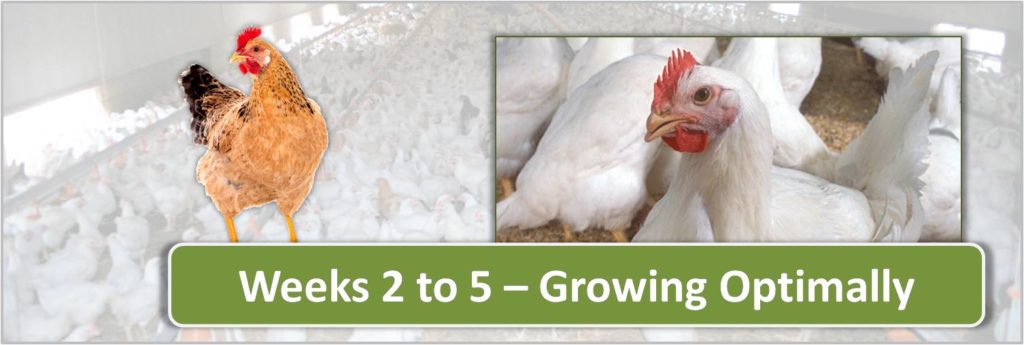
It’s all about your handling here.
Once the flock is in your hands, it’s up to you what you make of it.
Fight off threats and nurture yield for maximum profit .
Keen behavioural observation and an experienced eye are key skills of husbandry .
Monitoring, measuring, adjusting, clipping, recording…
…broiler farm managers will issue a meticulously laid out daily schedule for farm labourers.
Your rearing schedule …
…highly detailed and precise to the last grain…
– each task adding value to the overall reward of hitting the market (on time) with a top product.
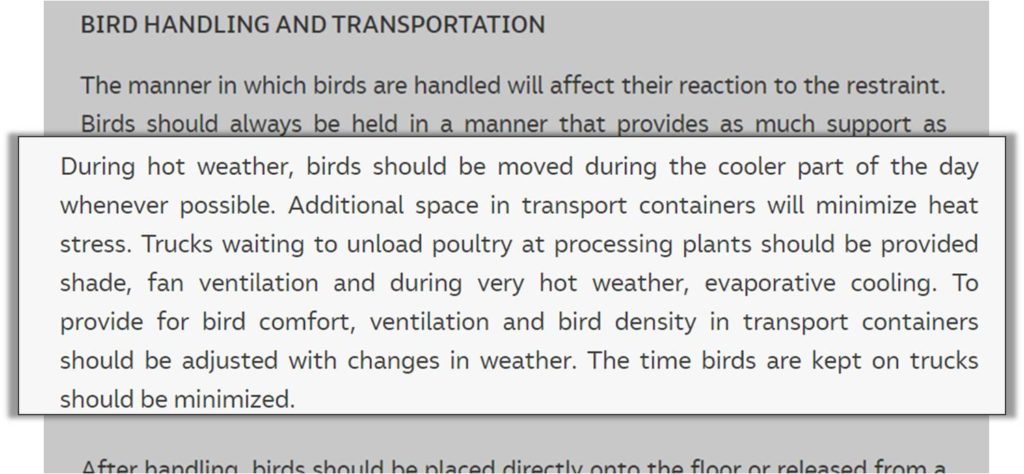
Adjusting to meet the needs of birds during changes in weather conditions, for example …
…with vigilance and agility, are key handling qualities for keeping on top of broiler farming.
Growth is complex , in the truest sense…

…broilers reaching their targeted size and weight depends, in part, on the availability of the right building blocks .
You need the appropriate materials in order to build properly. And enough of them.
Nutrition is exactly that.
Put another way,
…to write a script you need mastery of the entire alphabet.
Otherwise, key messages will have omissions and the purpose is overthrown.
The comparisons go on – but the message, I’m sure is clear to you.
What are the essentials for broiler growth?
Well…
You get these:
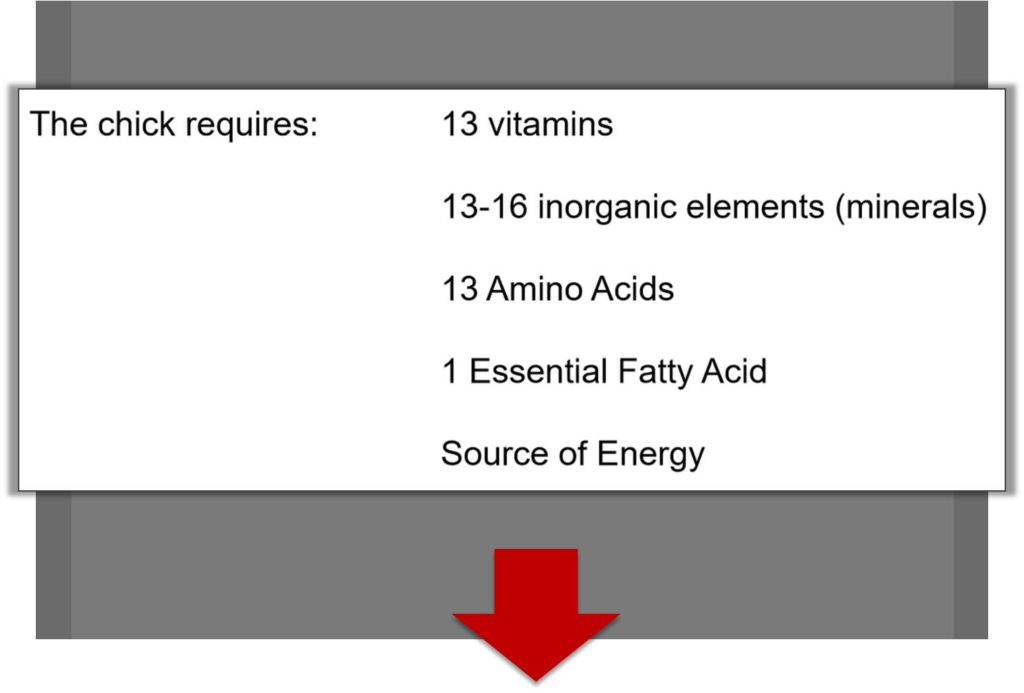
…from these…
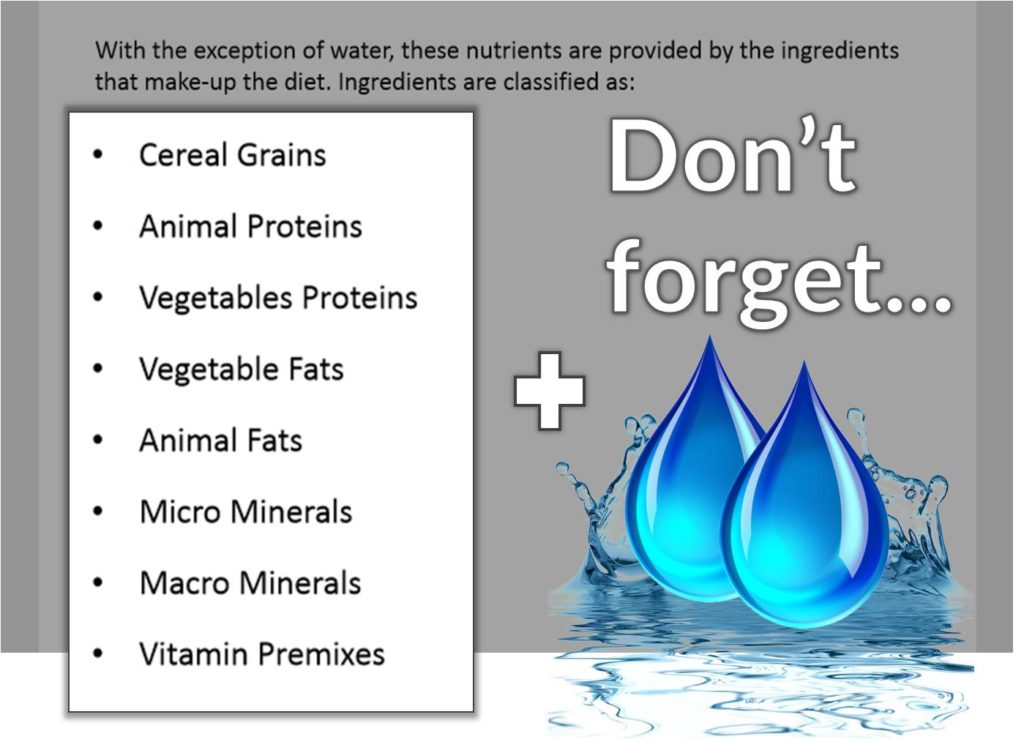
And speaking of building blocks, with muscle as our focus in broiler growth…
…we look to protein (the substance of muscle tissue).
One thing to note is you cannot force the body.
The body is naturally calibrated to use what it needs .
In other words,
You can’t keep pushing protein to add mass beyond what the body’s wiring has programmed within as limits.
That said, protein is essential to broiler growth.
The root of which are amino acids…protein building blocks.
What advice should we take on amino acid intake for broilers?
Animal or plant protein is the ideal source.
For example…
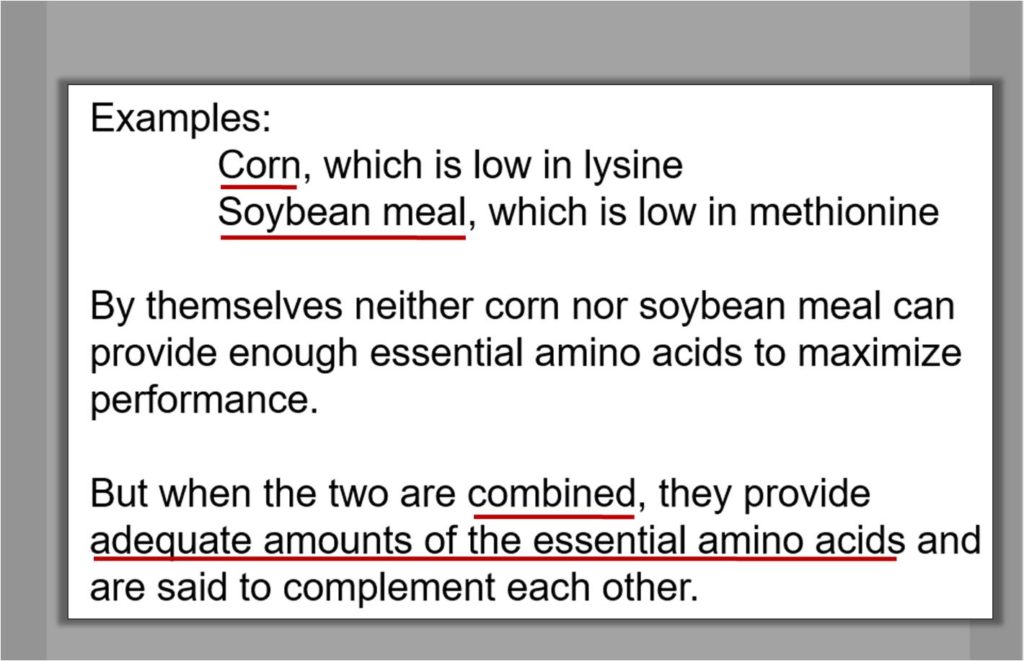
When eaten by the bird,
…the vegetable protein complexes are broken down to amino acids and are made available for the re-building program of broiler growth.
Growth is a demanding process.
It requires a lot of fuelling to power.
And all that fuel has got to come from somewhere…
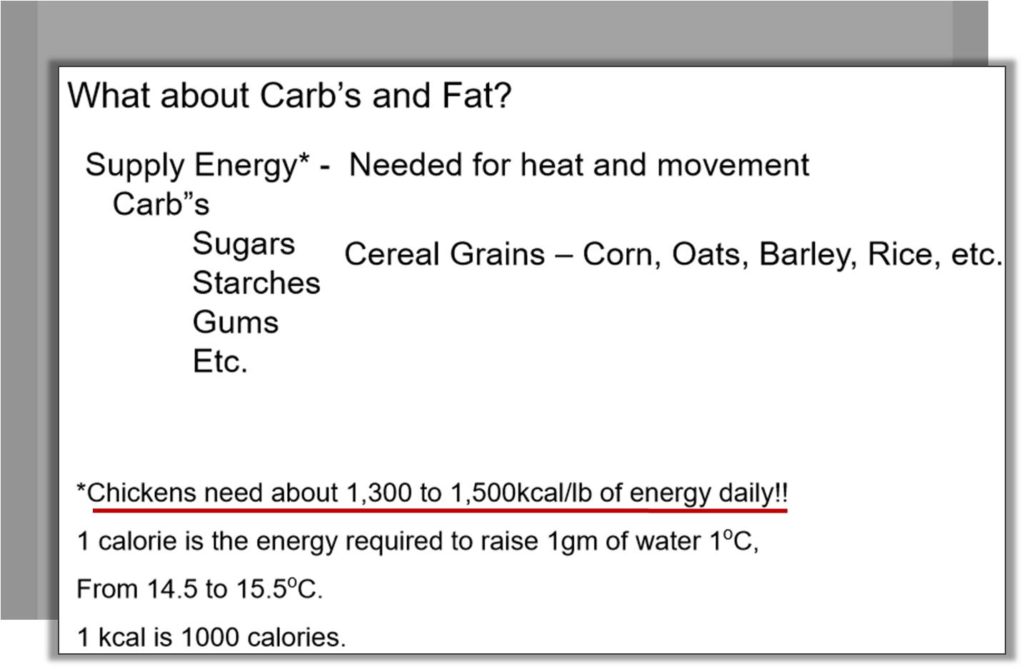
It is a fine balance though, as even we as people know.
Too much energy-packed food and body fat with nutritional diseases can set in very quickly.
Also, it’s critical to note with broilers that energy consumption is a feedback loop .
To say it plain,
…give broilers too much energy-rich food and they will stop eating as much.
Reduce this and they will eat more.
A quick associated note on waste.
If the balance on the broiler diet is too much in protein, fats etc. then the concentration of their urea and consistency of their faeces accelerates litter rot.
This can have devastating effects on the health of their feet – producing chemical burns and bacterial infection.
Also, breathing problems, swollen eyes and overproduction of mucus in the nose and throat – even blindness.
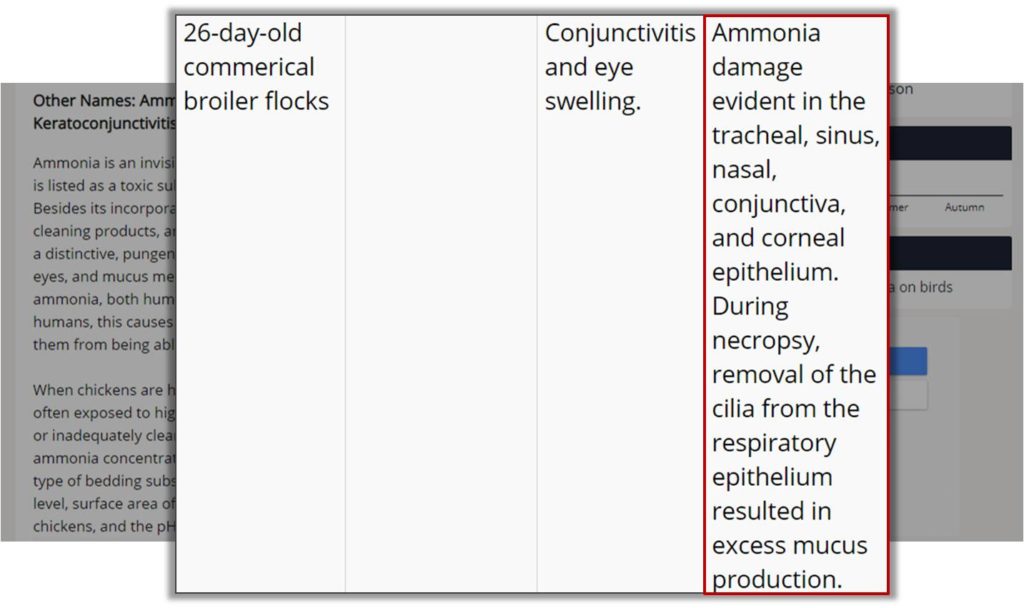
Be vigilant for litter hygiene.
Treat immediately.
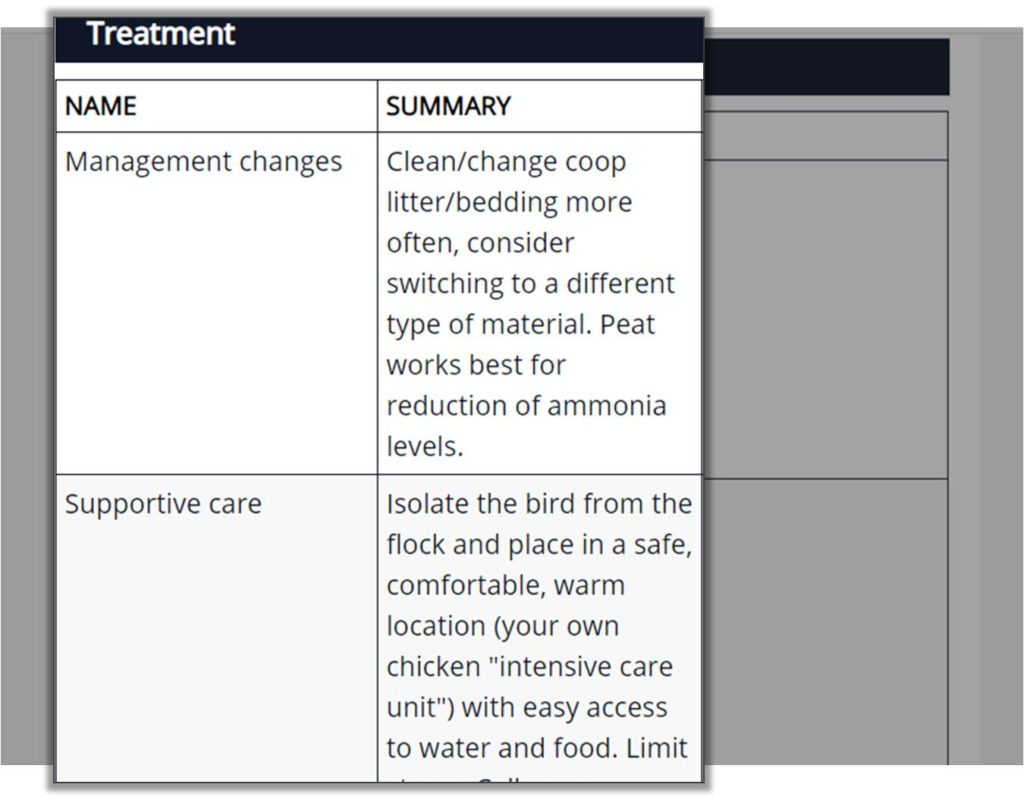
Feed ingredients
Want a look at an example broiler diet ?
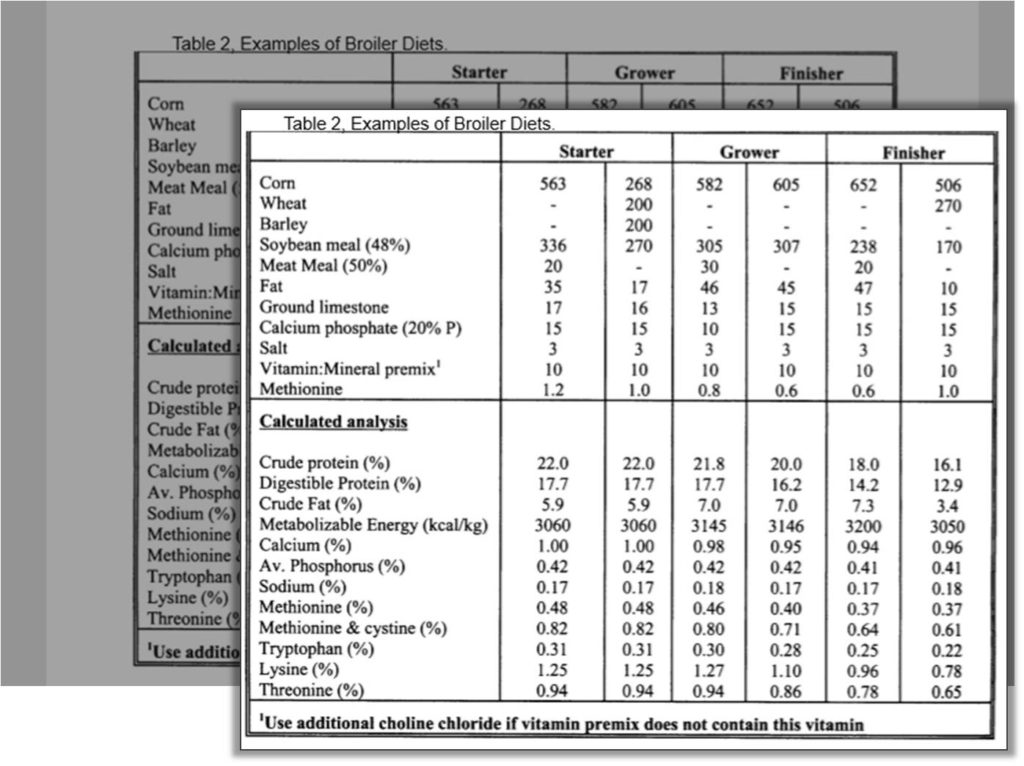
There’s no right or wrong way to do this.
It’s a balance .
Preference and palate have a lot to do with it too.
But so long as you are sure the contents of the diets match the profile of the nutritional need of the birds,
…you should experience good intake and conversion .
Swapping in one food source for another in a like-for-like fashion should (in theory) produce the same, if not similar results.
But ‘practice’ is the only real way of making sure.
Feed at different phases
Size of food particle is a key feature in getting your broilers to their target weight destination.
Volumes of feed intake will vary at each stage of growth throughout the rearing period.
But also, ability to take in different sizes of feed changes with age.
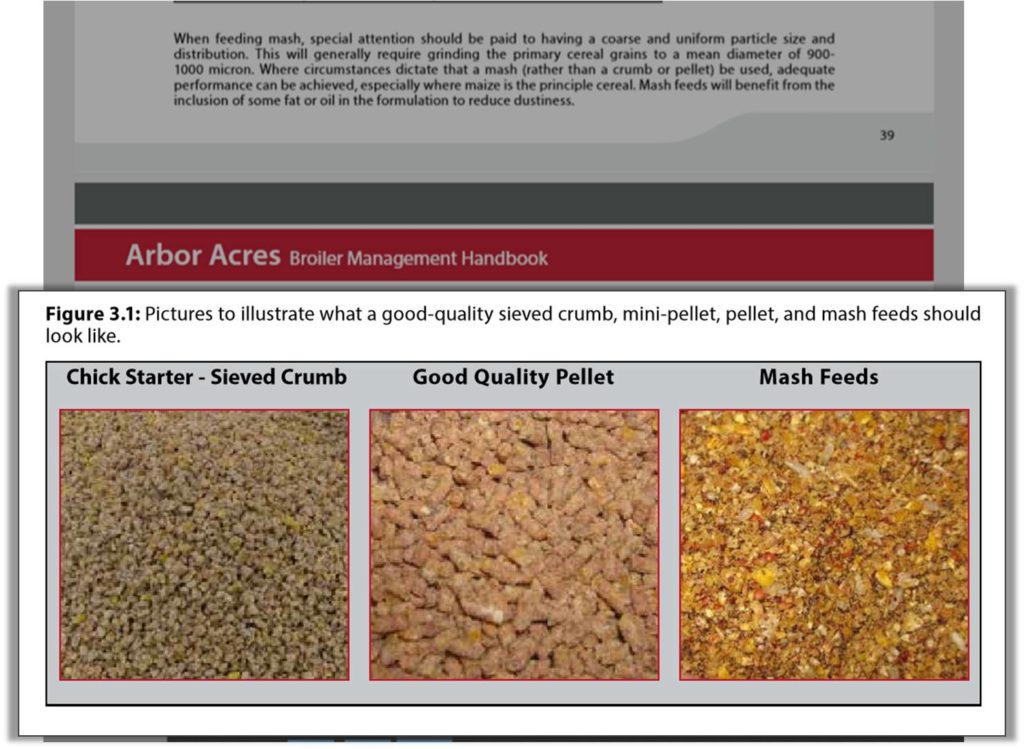
Physically, particles too big will neither be practicable nor appealling to young chicks.
And mash powder might simply be wasted by larger broilers leading to lost profit.
Cost and alternatives
Remembering the heavily weighted contribution of poultry feed to the overall cost of a broiler farm…
…finding alternative food source ingredients in your locality that are either cheap…
…or better – entirely free …
…is a great way of widening your margin of profit.
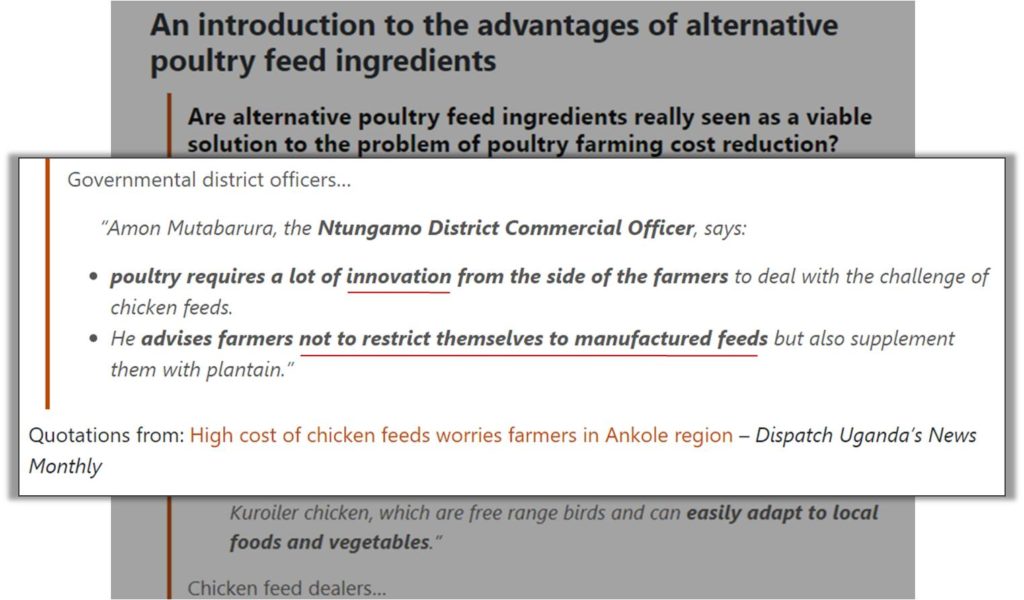
Governmental officials are mounting their support behind alternative ingredients for poultry feed.
In this way, they hope to stimulate start-ups and bolster their local economies.
Farmers who earn more, grow .
And so will their communities.
Feeding & Watering
Feeding and watering are critical to your broiler farm for three reasons.
- They are the key drivers for growth .
- They are the key drivers for cost .
- Nowhere to hide – you feed and water them every day until slaughter.
Get it wrong and your profits will ebb away.
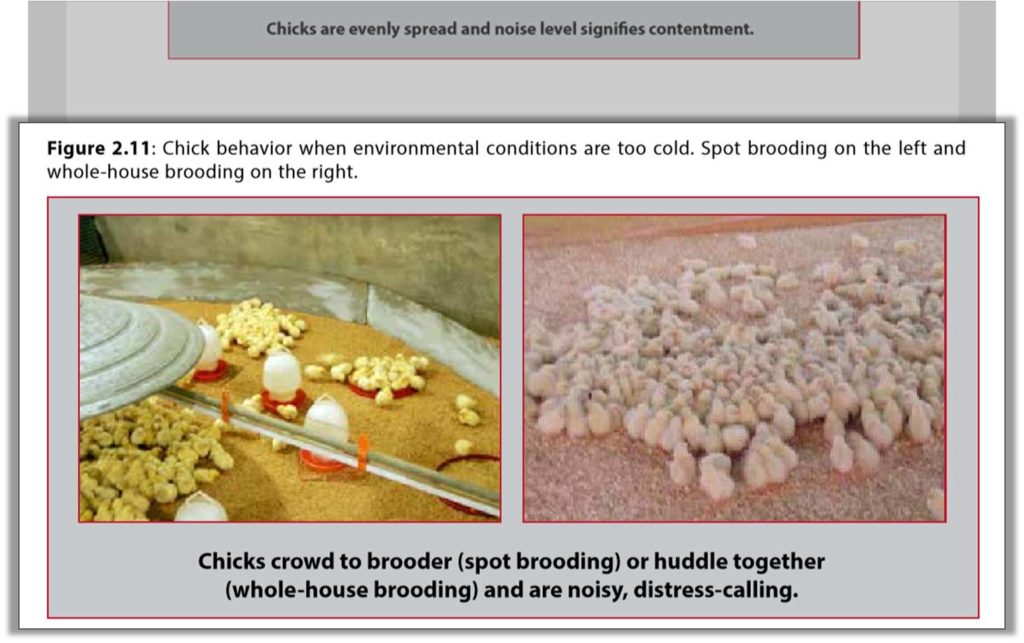
It’s an issue of training .
Training your birds from day one on to the feeding and watering apparatus will set them on the right track.
As they grow, you’ll need to be careful to adjust the:
- distribution
- set-up of your…
…feeders…
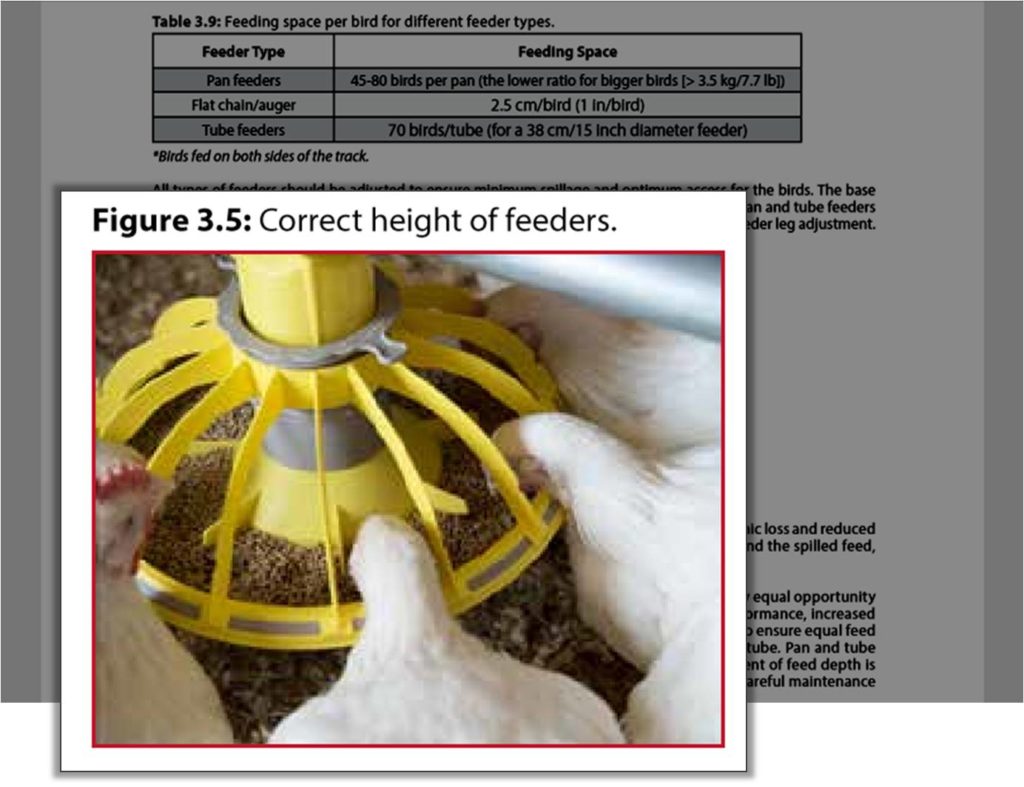
…& drinkers…
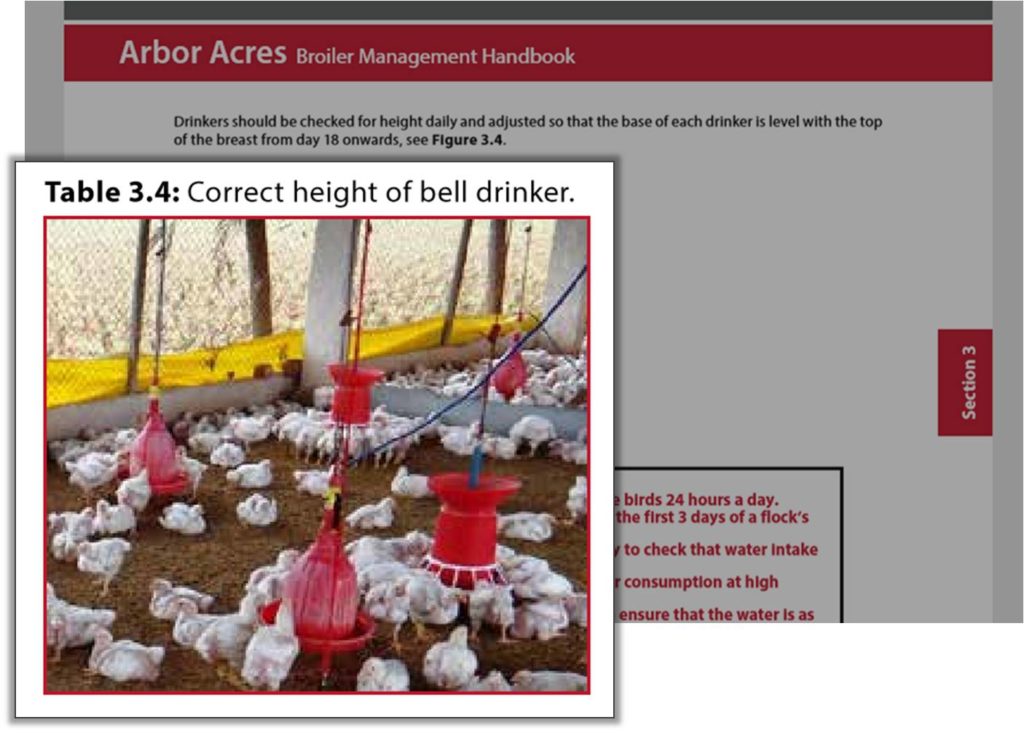
…to match the physical range of your growing birds.
Health & Hygiene
Contamination is the buzz word here.
Prevention is better than cure as they say.
If corruption breaks out among your birds, it can threaten the entire yield of your farm.
Take stringent measures to keep sanitary conditions.
Combating infection with workflow planning
Generally, there are two approaches to stamping out disease on your broiler farm :
- operational care
- site cleanliness
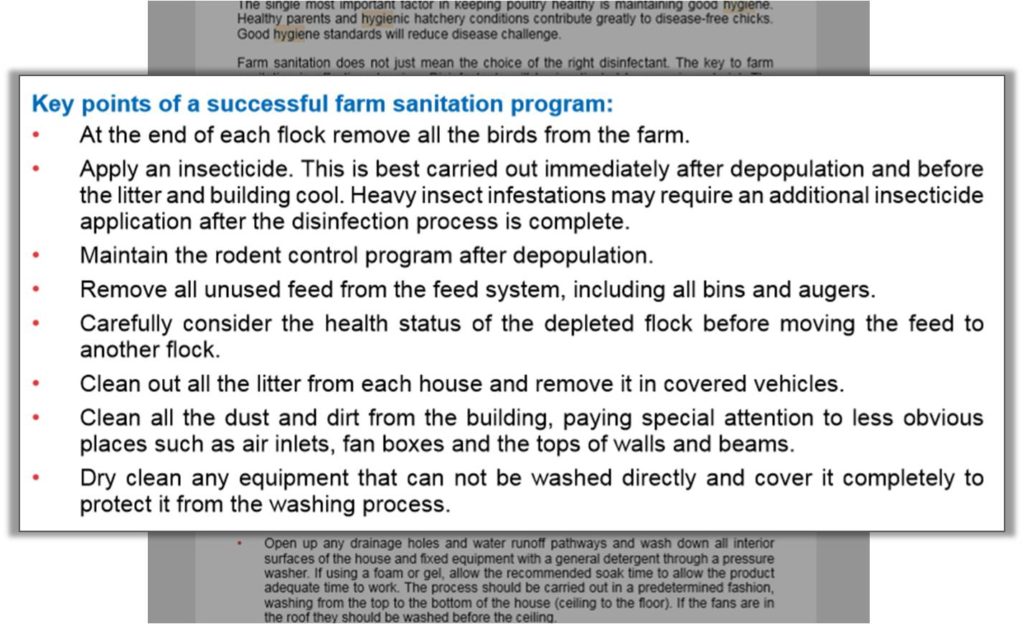
From the list above, taken from the Cobb Broiler Management Guide , you could group the sanitation measures into the following categories:
- things to remember
- things to administer
- things to keep out
- things to clear out & empty
- things to examine
…just some of the fundamentals of keeping a healthy environment for your broilers.
Regular cleaning, spraying down and washing of vehicles and personnel prevent occasion for breakout, should an infection arise.
Disease and health
Parasites, respiratory tract bacterial infections, viral attacks are all common threats to a poultry flock.
Once contracted,
…they can spread like wildfire and bring the whole operation down with little else you can do but fold.
Vaccines are the answer for many.
…the long term immune burden on people from the many vaccine programs they are indirectly exposed to, due to the meat they eat presents a significant global immune danger.
A cocktail of interference at an immune level over many years, from many sources can trigger serious problems.
In light of this problem,
…some studies in recent years have been commissioned to look into the effects of natural or herbal based medicines in broiler farming .
Like this one:
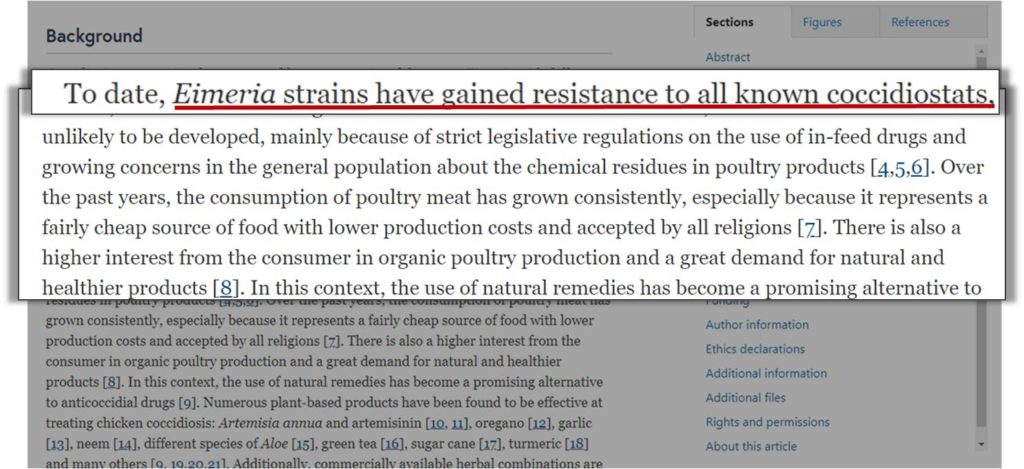
This quote above unveils the growing resistance poultry parasites are developing to man-made drugs.
Whilst the drugs are the best inventions we can throw at the intruders, created within nature is a far more effective front line.

The likes of oregano, garlic, neem, aloe, green tea, tumeric and other herbal combinations present a far more complicated and therefore…
…complete array of protection for your broiler birds.
The key here is that the bird’s body is already equipped with an immune system. A highly specified military-like response mechanism to deal with external invasive threats.
Feed the birds with a naturally occurring range of herbal food sources.
Like the ones mentioned.
And your broilers bodies will assimilate the substances provided into the necessary ammunition and force to overcome many major threats.
Growth & Fattening
Each breeder will advise their own estimation of broiler growth .
Often, broiler growth charts like this one give you all the metrics necessary:
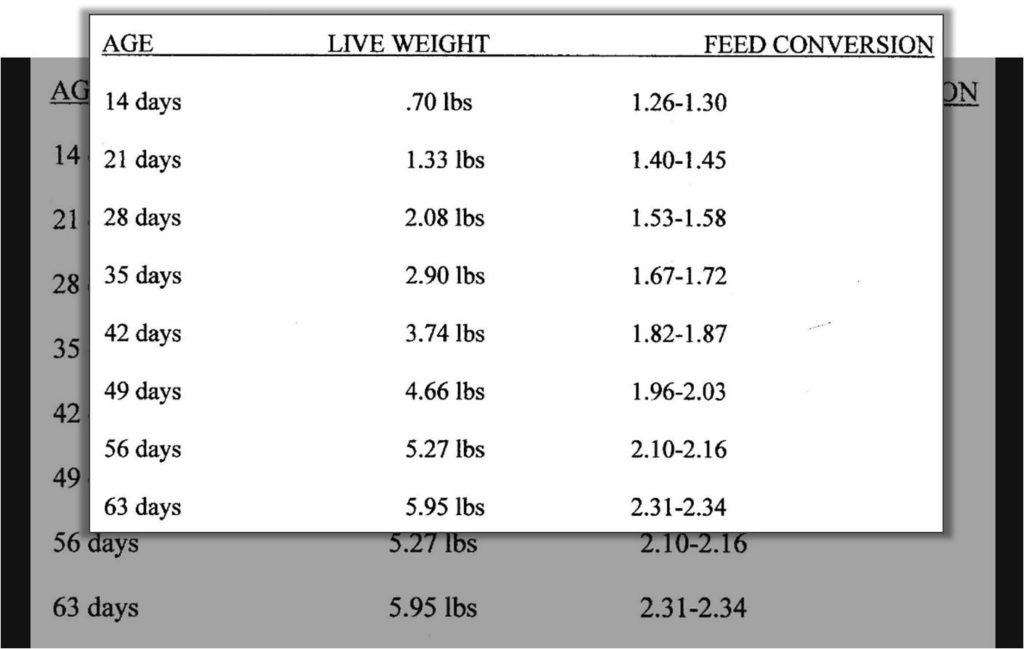
From the information above you will be able to work out the potential market price fetched for each bird…
Also, the feed necessary for achieving the projected growth.
Take the cost of the latter away from the former and you have your broiler profit.
Growth rate
What is the typical growth rate of a broiler bird?
Taking a look at a table like this one:
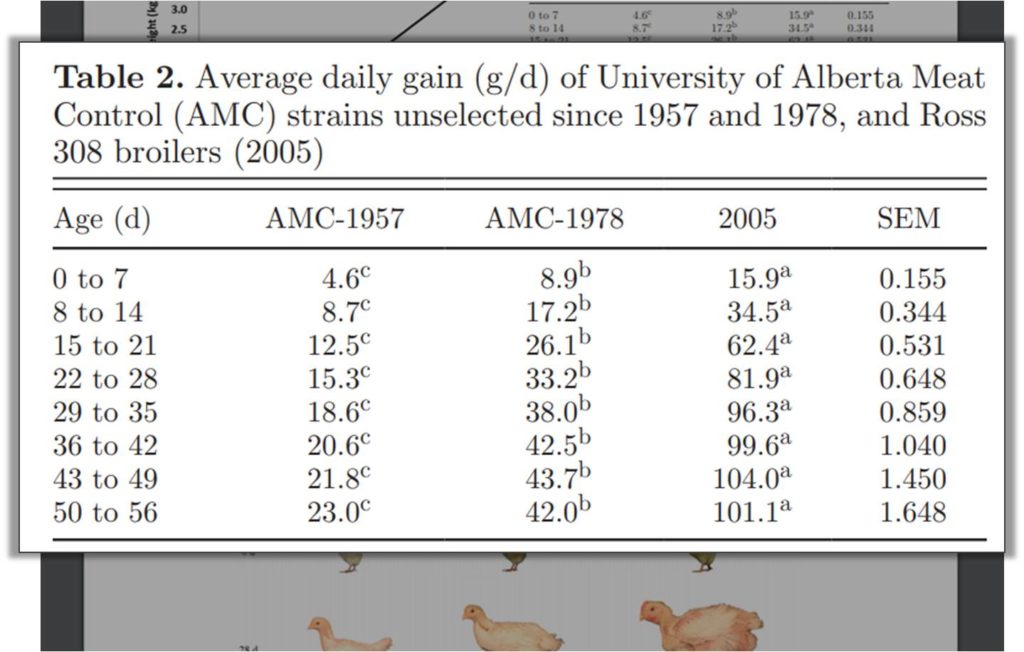
You can see from the figures above that the modern strains double size and weight between weeks 1 -2 .
Thereafter, weight gain is about 33% from weeks 3-4.
Then, a reduction in growth rate to about 20% increase for weeks 4-5.
Lastly in the following two weeks, the growth rate drops to about 4-8% per week.
There simply comes a point where holding on to the birds is no more profitable.
They begin eating more than they gain in weight.
The cost is loss-making.
There is a sweet spot with going to market.
Record keeping
Record keeping within your poultry farm provides a benchmark for you.
For the batch you are handling at any one time, you should always have a written reference for their condition or environmental factors.
Viewing such records keeps your progress in sight.
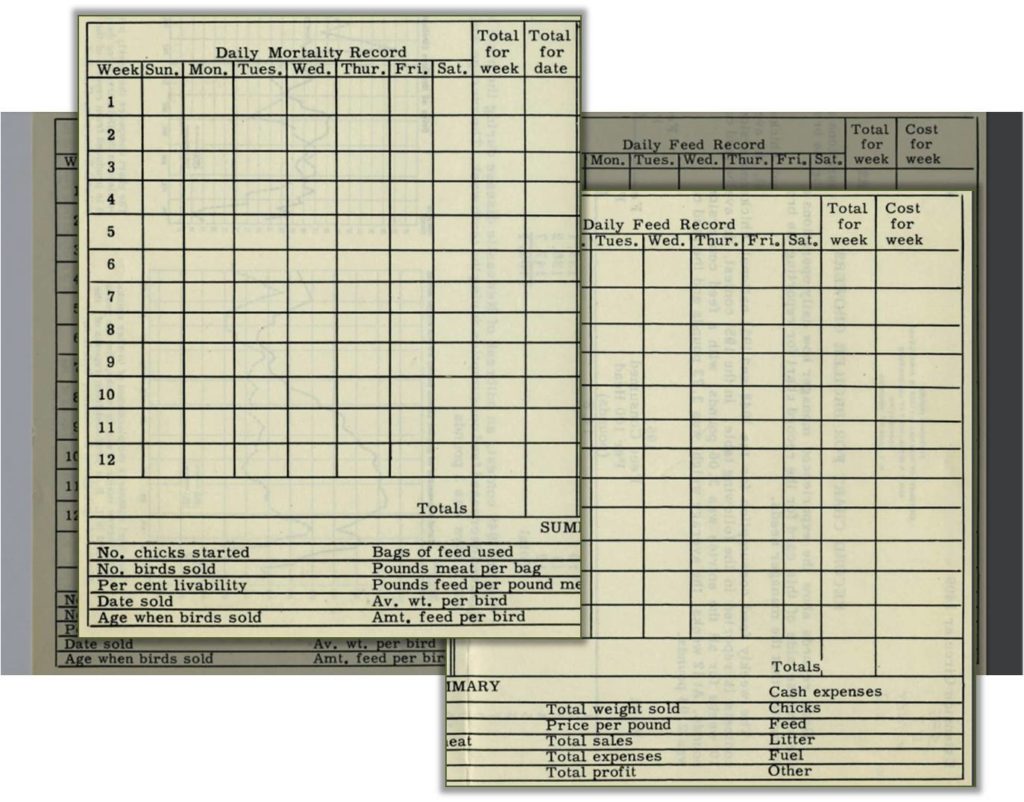
Take this paper logbook from the University of Nebraska-Lincoln.
Look at the detail!
Looking closely, we gain real insight into the main measures used by broiler farm for monitoring performance progress :
- feed consumed
- No. of chicks started
- Pen or house no.
- Dates started
- No. chicks started
- No. birds sold
- Per cent livability
- Age when sold
- Bags of feed used
- Pounds of meet per bag
- Pounds of feed per pounds of meat
- Average weight per bird
- Amount of feed per bird
- Total weight sold
- Price per pound
- Total sales
- Total expenses
- Total profit
Key metrics for analyzing the performance of ANY broiler farm .
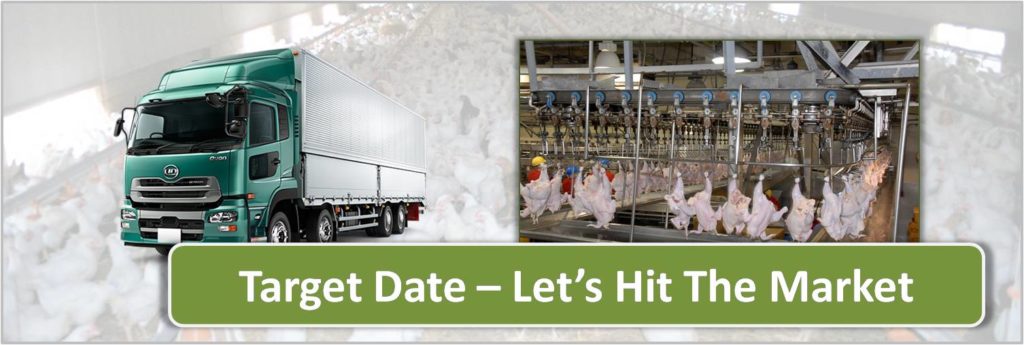
This is the final straight of the entire race to broiler profits.
The last hurdle. Hit this one and all your efforts will be thrown away.
Get clued up on what matters during this critical time.
Pre-processing
Now we get to the point of fruit and we are ready to gather in the flock for slaughter .
Getting your broiler flock to the slaughterhouse is a combined effort.
The entire process is a collaboration between your farm and the transport company.
Here’s a checklist typical of what a broiler farm would have to do prior to transporting a mature flock:
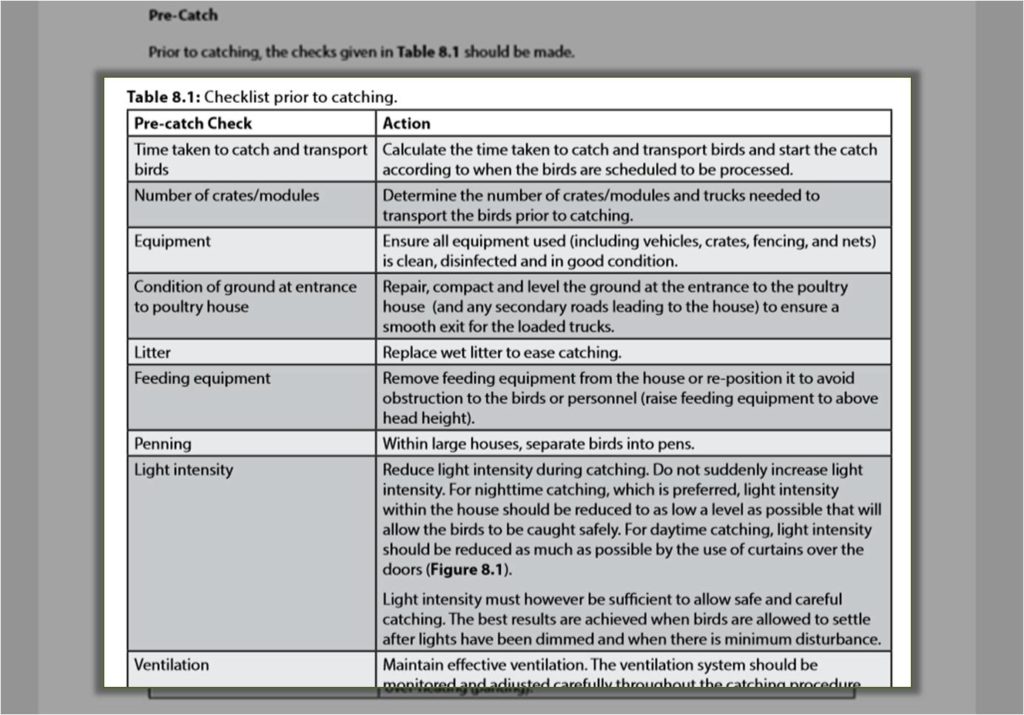
As you can see, a lot of attention goes into the preparation of catching a flock on-site.
A point to consider when preparing a flock for processing is feed withdrawal in the run-up to the catch.
8-12 hours before transportation, flocks must be denied food.
This helps prevent faecal contamination during transport and throughout the slaughter process.
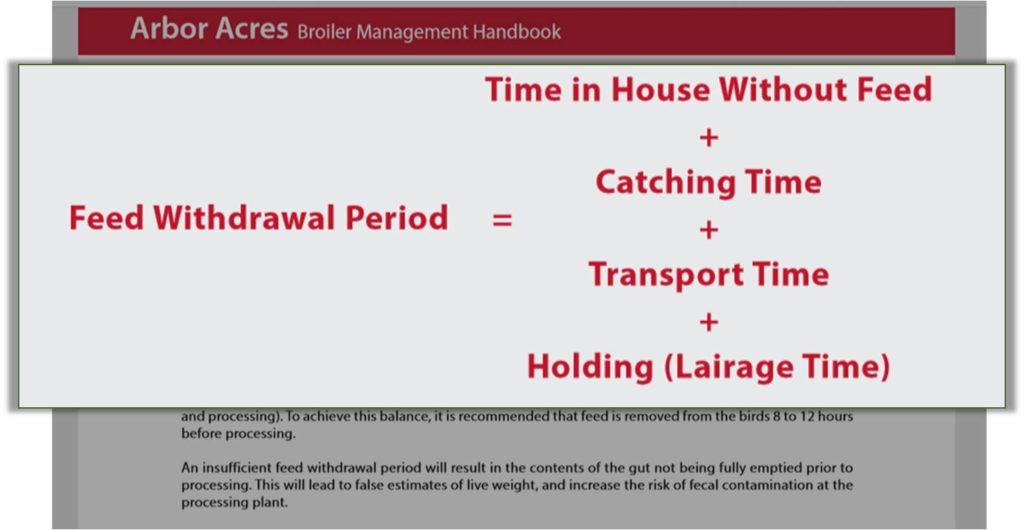
With all this time where your flock is ‘fasting’, the thought may have crossed your mind…
How will this affect my bird’s final market weight?
Here’s the answer:
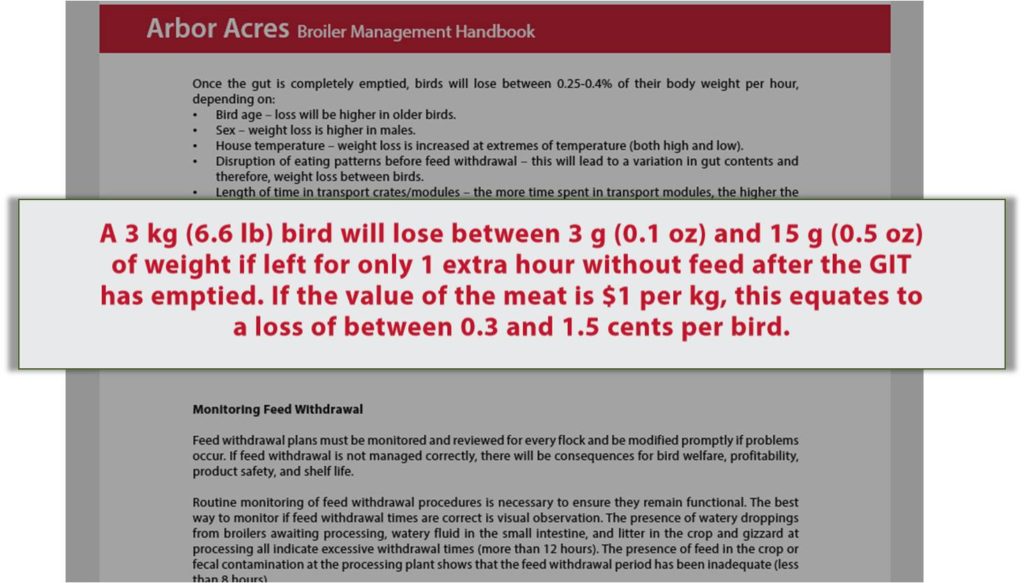
On average, you can expect to lose 3g – 15g per bird before carcasses are prepared for market .
Factor this into your profit calculations.
It is unavoidable.
Getting your broiler to market in order to make a profit takes strategy .
If ever you thought that all the hard work was over once your broilers were grown…
…think again.
This graph of broiler price fluctuation should give you a feel for how difficult predicting the market can be:
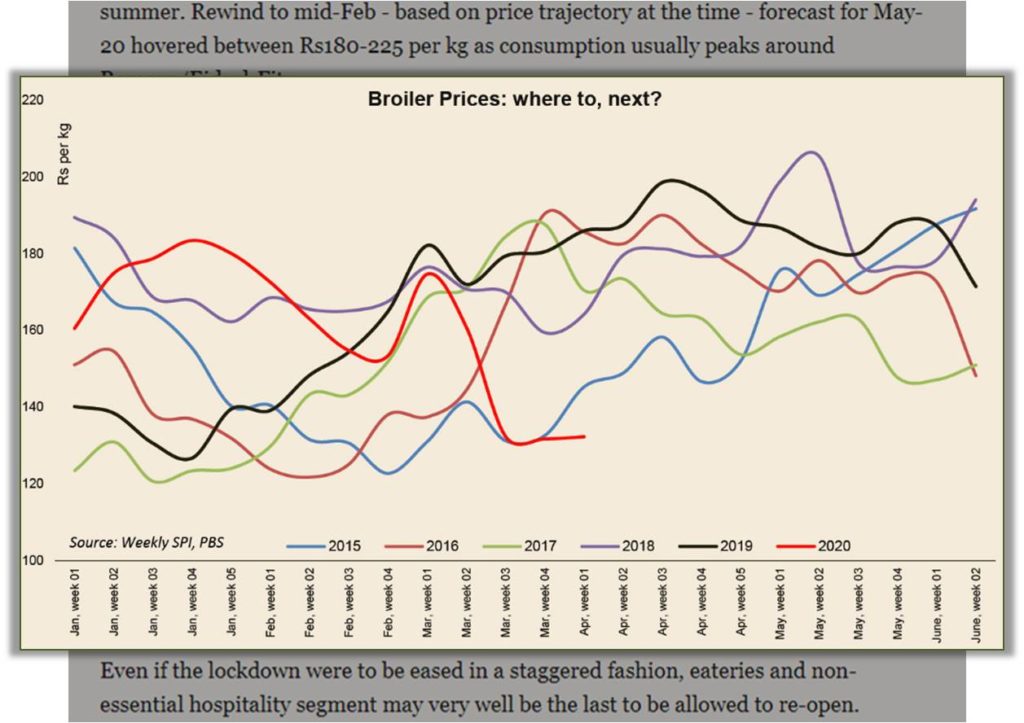
(Were you able to make any sense of it?)
The takeaway?…
Markets move and pricing varies accordingly.
It’s difficult to call it.
No matter how in-tune with the latest news you are.
The variables within your control , however, are…
- farm type (intensive, organic)
- broiler weight,
- the volume of carcasses,
…these will have bearing on your revenue and the price you can fetch.
Keeping on top of your costs, in particular, the feed expenses will save you much profit potential.
Preserving the flock and not dropping points, or worse…
…losing key players…
…will keep your broiler farm on course for a successful and worthwhile finish.
I hope you picked up some good value from reading this broiler farming guide.
What are your thoughts?
Do you have experience of running a broiler farm already?
Or, are you still ‘thinking’ about is and need a little more guidance?
Either way, take the time now to leave a comment.
Reader Interactions
Write your poultry project proposal in just 90 mins.
July 4, 2020 at 10:21 am
i have learned a lot
November 15, 2020 at 11:32 am
This was informative and very useful. Lots of insight gained. Thanks so much.
November 15, 2020 at 1:02 pm
Glad to be of service, Emmanuel.
I plan to update this (and other pieces) from time to time.
I’ll email you when I do.
Let me know how you get on.
Speak soon.
July 4, 2020 at 10:22 am
the other thing i need now is to be assisted with the business plan for financial assistance
July 22, 2020 at 12:11 pm
I want a business plan for financial assistance
December 18, 2020 at 1:39 pm
This is very informative. It’s an eye opener.
January 15, 2021 at 5:41 pm
Exce;llent and thorough. However, needed is further elaboration on use of water and feed use ……, height adjustment of water and feeders as well. Thanks
February 7, 2021 at 9:07 am
Very interesting article, I’m about start investing in this business segment and was very helpfully, I highly recommend.
March 7, 2021 at 11:07 pm
good day i need your formular for poultry feed
March 13, 2021 at 2:49 am
I started with this new field just almost 2 months ago. Your article is very informative and interesting. It gave a feeling of security to be able to hopefully manage this successfully. Thank you!!!
March 18, 2021 at 10:58 am
Your article is very informing.
The other thing i need now is to be assisted with the business plan for financial assistance. thanks
February 26, 2024 at 3:39 pm
I am an aspiring broiler farmer and I’m currently making preparations to start. Your information on this site is priceless and I applaud your expertise and kindness.
Leave a Reply Cancel reply
Your email address will not be published. Required fields are marked *
Join 15,000 Subscribers…

Get The #1 Poultry Farming Newsletter
The most in-depth guide to poultry farming anywhere , right now.
– Kwasi Jones
Receive all the ‘insider tips’ they never speak about to help you:
- ✔️ Write a plan that actually gets investment
- ✔️ Decide if poultry will be profitable for you
- ✔️ Avoid pitfalls like mortality with key procedures
- ✔️ Understand the hidden benefits of production models
Type in your email below…

Poultry Farm Business Plan Template
Written by Dave Lavinsky

Poultry Farm Business Plan
Over the past 20+ years, we have helped over 1,000 entrepreneurs and business owners create business plans to start and grow their poultry farms. On this page, we will first give you some background information with regards to the importance of business planning. We will then go through a poultry farm business plan template step-by-step so you can create your plan today.
Download our Ultimate Business Plan Template here >
What is a Poultry Farm Business Plan?
A business plan provides a snapshot of your poultry farm as it stands today, and lays out your growth plan for the next five years. It explains your business goals and your strategy for reaching them. It also includes market research to support your plans.
Why You Need a Business Plan for a Poultry Farm
If you’re looking to start a poultry farm, or grow your existing poultry farm, you need a business plan. A business plan will help you raise funding, if needed, and plan out the growth of your poultry farm in order to improve your chances of success. Your poultry farming business plan is a living document that should be updated annually as your company grows and changes.
Sources of Funding for Poultry Farms
With regards to funding, the main sources of funding for a poultry farm are personal savings, credit cards, USDA Farm Service Agency (FSA) loans, bank loans, and angel investors. With regards to bank loans, banks will want to review your business plan and gain confidence that you will be able to repay your loan and interest. To acquire this confidence, the loan officer will not only want to confirm that your financials are reasonable, but they will also want to see a professional plan. Such a plan will give them the confidence that you can successfully and professionally operate a business. Personal savings and USDA FSA loans are the most common funding paths for poultry farm.
Finish Your Business Plan Today!
How to write a business plan for a chicken farm.
If you want to start a poultry farm or expand your current one, you need a business plan. We detail each section of a traditional business plan for a poultry farming business.
Executive Summary
Your executive summary provides an introduction to your business plan, but it is normally the last section you write because it provides a summary of each key section of your plan.
The goal of your Executive Summary is to quickly engage the reader. Explain to them the type of poultry farm you are operating and its status. For example, are you a startup, do you have a poultry farm business that you would like to grow, or are you operating poultry farm businesses in multiple locations?
Next, provide an overview of each of the subsequent sections of your plan. For example, give a brief overview of the poultry farm industry. Discuss the type of poultry farm you are operating. Detail your direct competitors. Give an overview of your target customers. Provide a snapshot of your marketing plan. Identify the key members of your team. And offer an overview of your financial plan.
Company Analysis
In your company analysis, you will detail the type of poultry farm you are operating.
For example, you might operate one of the following types of poultry farms:
- Breeder Farms : this type of poultry farm produces hatching eggs for delivery to the hatchery. After the 21 day incubation period, the hatchery then delivers the baby chicks to the broiler houses.
- Broiler Farms: this type of farm produces a 2.5 lb. to 8 lb. bird in 4 to 8 weeks which is processed for various types of retail sale to consumers, grocery stores or fast food chains as whole birds, cut-up breast, wings, thigh, drumsticks, deboned breast meat, or further processed pieces.
- Pullet Farms: this type of poultry farm produces pullets and roosters to be delivered to a breeder hen house at 20-22 weeks old when they are sexually mature to breed and lay eggs.
In addition to explaining the type of poultry farming business you will operate, the Company Analysis section of your business plan needs to provide background on the business.
Include answers to question such as:
- When and why did you start the business?
- What milestones have you achieved to date? Milestones could include the number of chickens and/or turkeys produced, number of production contracts, etc.
- Your legal structure. Are you incorporated as an S-Corp? An LLC? A sole proprietorship? Explain your legal structure here.
Industry Analysis
In your industry analysis, you need to provide an overview of the poultry farm industry.
While this may seem unnecessary, it serves multiple purposes.
First, researching the poultry farm industry educates you. It helps you understand the market in which you are operating.
Secondly, market research can improve your strategy, particularly if your research identifies market trends.
The third reason for market research is to prove to readers that you are an expert in your industry. By conducting the research and presenting it in your plan, you achieve just that.
The following questions should be answered in the industry analysis section of your poultry farming business plan:
- How big is the poultry farm industry (in dollars)?
- Is the market declining or increasing?
- Who are the key competitors in the market?
- Who are the key suppliers in the market?
- What trends are affecting the industry?
- What is the industry’s growth forecast over the next 5 – 10 years?
- What is the relevant market size? That is, how big is the potential market for your poultry farm business? You can extrapolate such a figure by assessing the size of the market in the entire country and then applying that figure to your target market.
Customer Analysis
The customer analysis section of your poultry farming business plan must detail the customers you serve and/or expect to serve.
The following are examples of customer segments: processors, grocery stores, and restaurants.
As you can imagine, the customer segment(s) you choose will have a great impact on the type of poultry farm business you operate. Clearly, processors would respond to different marketing promotions than restaurants, for example.
Try to break out your target customers in terms of their demographic and psychographic profiles. With regards to demographics, include a discussion of the ages, genders, locations and income levels of the customers you seek to serve. Because most poultry farm businesses primarily serve customers living in their same region, such demographic information is easy to find on government websites.
Psychographic profiles explain the wants and needs of your target customers. The more you can understand and define these needs, the better you will do in attracting and retaining your customers.
Finish Your Poultry Farm Business Plan in 1 Day!
Don’t you wish there was a faster, easier way to finish your business plan?
With Growthink’s Ultimate Business Plan Template you can finish your plan in just 8 hours or less!
Competitive Analysis
Your competitive analysis should identify the indirect and direct competitors your business faces and then focus on the latter.
Direct competitors are other poultry farm businesses.
Indirect competitors are other options that customers have to purchase from that aren’t direct competitors. This includes producers of other meat such as beef, pork, or fish, as well as producers of meat alternatives. You need to mention such competition as well.
With regards to direct competition, you want to describe the other poultry farms with which you compete. Most likely, your direct competitors will be poultry farms located very close to your location.
For each such competitor, provide an overview of their businesses and document their strengths and weaknesses. Unless you once worked at your competitors’ businesses, it will be impossible to know everything about them. But you should be able to find out key things about them such as:
- What types of customers do they serve?
- What kinds of poultry do they produce (breeders, broilers, pullets)?
- What is their pricing (premium, low, etc.)?
- What are they good at?
- What are their weaknesses?
With regards to the last two questions, think about your answers from the customers’ perspective. And don’t be afraid to ask your competitors’ customers what they like most and least about them.
The final part of your competitive analysis section is to document your areas of competitive advantage. For example:
- Will you use superior production methods?
- Will you provide services that your competitors don’t offer?
- Will you provide better customer service?
- Will you offer better pricing?
Think about ways you will outperform your competition and document them in this section of your plan.
Marketing Plan
Traditionally, a marketing plan includes the four P’s: Product, Price, Place, and Promotion. For a poultry farm business plan, your marketing plan should include the following:
Product : In the product section, you should reiterate the type of poultry farm company that you documented in your Company Analysis. Then, detail the specific products you will be offering. For example, in addition to traditional poultry, will you provide organic or cage-free poultry?
Price : Document the prices you will offer and how they compare to your competitors. Essentially in the product and price sub-sections of your marketing plan, you are presenting the products and services you offer and their prices.
Place : Place refers to the location of your poultry farm company. Document your location and mention how the location will impact your success. For example, is your poultry farm located near a processing facility, near a transportation hub, etc. Discuss how your location might be the ideal location for your customers.
Promotions : The final part of your poultry farm marketing plan is the promotions section. Here you will document how you will drive customers to your location(s). The following are some promotional methods you might consider:
- Advertising in trade papers and magazines
- Reaching out to local agriculture extension offices
- Social media marketing
- Local radio advertising
Operations Plan
While the earlier sections of your business plan explained your goals, your operations plan describes how you will meet them. Your operations plan should have two distinct sections as follows.
Everyday short-term processes include all of the tasks involved in running your poultry farm, including animal care / feeding, flock supervision, animal transportation, sourcing feed, etc.
Long-term goals are the milestones you hope to achieve. These could include the dates when you expect to sign your 20th production contract, or when you hope to reach $X in revenue. It could also be when you expect to expand your poultry farm to a new location.
Management Team
To demonstrate your poultry farm’s ability to succeed, a strong management team is essential. Highlight your key players’ backgrounds, emphasizing those skills and experiences that prove their ability to grow a company.
Ideally you and/or your team members have direct experience in managing poultry farms. If so, highlight this experience and expertise. But also highlight any experience that you think will help your business succeed.
If your team is lacking, consider assembling an advisory board. An advisory board would include 2 to 8 individuals who would act like mentors to your business. They would help answer questions and provide strategic guidance. If needed, look for advisory board members with experience in managing farms or successfully running small businesses.
Financial Plan
Your financial plan should include your 5-year financial statement broken out both monthly or quarterly for the first year and then annually. Your financial statements include your income statement, balance sheet and cash flow statements.
Income Statement
An income statement is more commonly called a Profit and Loss statement or P&L. It shows your revenues and then subtracts your costs to show whether you turned a profit or not.
In developing your income statement, you need to devise assumptions. For example, will you supply 50 restaurants, or produce 2,000 birds for processing each month? And will sales grow by 2% or 10% per year? As you can imagine, your choice of assumptions will greatly impact the financial forecasts for your business. As much as possible, conduct research to try to root your assumptions in reality.
Balance Sheets
Balance sheets show your assets and liabilities. While balance sheets can include much information, try to simplify them to the key items you need to know about. For instance, if you spend $50,000 on building out your poultry farming business, this will not give you immediate profits. Rather it is an asset that will hopefully help you generate profits for years to come. Likewise, if a bank writes you a check for $50,000, you don’t need to pay it back immediately. Rather, that is a liability you will pay back over time.
Cash Flow Statement
Your cash flow statement will help determine how much money you need to start or grow your business, and make sure you never run out of money. What most entrepreneurs and business owners don’t realize is that you can turn a profit but run out of money and go bankrupt.
In developing your Income Statement and Balance Sheets be sure to include several of the key costs needed in starting or growing a poultry farm business:
- Location build-out including design fees, construction, etc.
- Cost of equipment and supplies
- Payroll or salaries paid to staff
- Business insurance
- Taxes and permits
- Legal expenses
Attach your full financial projections in the appendix of your plan along with any supporting documents that make your plan more compelling. For example, you might include your farm title or lease, or blueprints of the production facility.
Putting together a business plan for your poultry farm is a worthwhile endeavor. If you follow the template above, by the time you are done, you will truly be an expert. You will really understand the poultry farm industry, your competition, and your customers. You will have developed a marketing plan and will really understand what it takes to launch and grow a successful poultry farming business.
Poultry Farm Business Plan FAQs
What is the easiest way to complete my poultry farm business plan.
Growthink's Ultimate Business Plan Template allows you to quickly and easily complete your Poultry Farm Business Plan.
What is the Goal of a Business Plan's Executive Summary?
The goal of your Executive Summary is to quickly engage the reader. Explain to them the type of poultry farm business you are operating and the status; for example, are you a startup, do you have a poultry farm business that you would like to grow, or are you operating a chain of poultry farm businesses?
Don’t you wish there was a faster, easier way to finish your Poultry Farm business plan?
OR, Let Us Develop Your Plan For You
Since 1999, Growthink has developed business plans for thousands of companies who have gone on to achieve tremendous success. Click here to see how Growthink’s professional business plan consulting services can create your business plan for you.
Other Helpful Business Plan Articles & Templates


Your One-Stop Shop
For poultry farming business, how to start broiler chicken farming – business plan for broiler production.
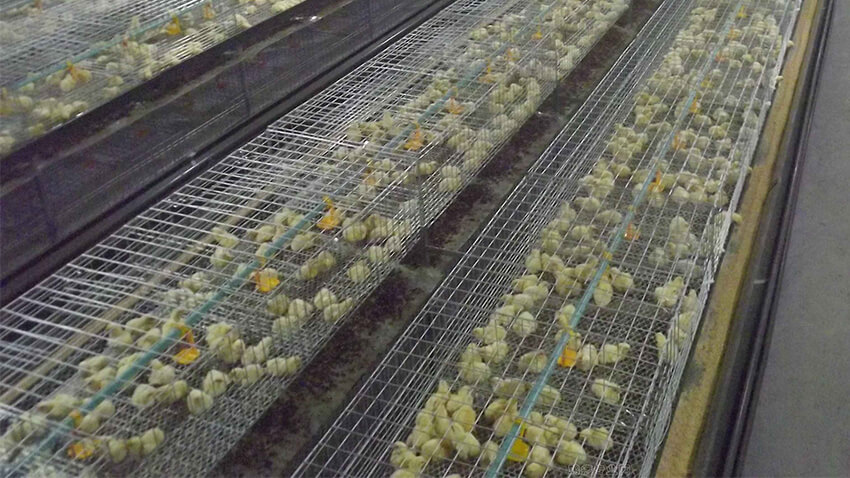
If you are interested in broiler production, you may want to know how to start a broiler chicken farming business plan, this article tell you the broiler farming business plan which could be helpful for you.
Broiler rearing for meat is very amazing, interesting and a profitable experience. Whether you’re doing this on large scale or small scale, it is a rewarding process. The term broiler production refers to rearing of poultry breeds or birds that have a high productivity of meat. Under good management and in the long run, broiler farming is a lucrative business.
The broiler chicken is a special species of poultry as it is scientifically made to produce more meat in a very short period of time say 6-9 weeks when they weigh around 6 pounds. One of the most dominant Broiler chickens being reared for meat is the Cornish. But before venturing into this kind of business, you have to learn and comprehend some requirements. What are the key factors to keep broiler chickens? Let’s check out some of the significant factors that you should look out for.
Preparation of the House for Broiler Chicken Farming
One of the essential factors of broiler keeping is their house. Whatever design or structure that you build for your broiler chicken business, it will somehow have an impact on the overall outcome of your business. Therefore, ensure that you follow all the regulations and processes recommended by experts in building a house for broiler production. Discussed below are some of the guidelines to follow.
- The regular distance from one house to another should be around 12 meters.
- Install new or maintain the available equipment in the house with heaters, feeders, drinkers and fans all functioning appropriately.
- The house should be thoroughly cleaned before the chicks are brought in. wash the ceiling, sidewalks, walls, and equipment. After cleaning, disinfect the building and ensure the ventilation is working correctly.
- The insects should be run off with a blow lamp
- The heating system should be checked and monitored to ensure it is working rightly.
- Moderate temperatures should be maintained in the house.
Avoid challenges by performing good sanitation, rodent & fly control during the rearing period.
Equipment for Broiler Production
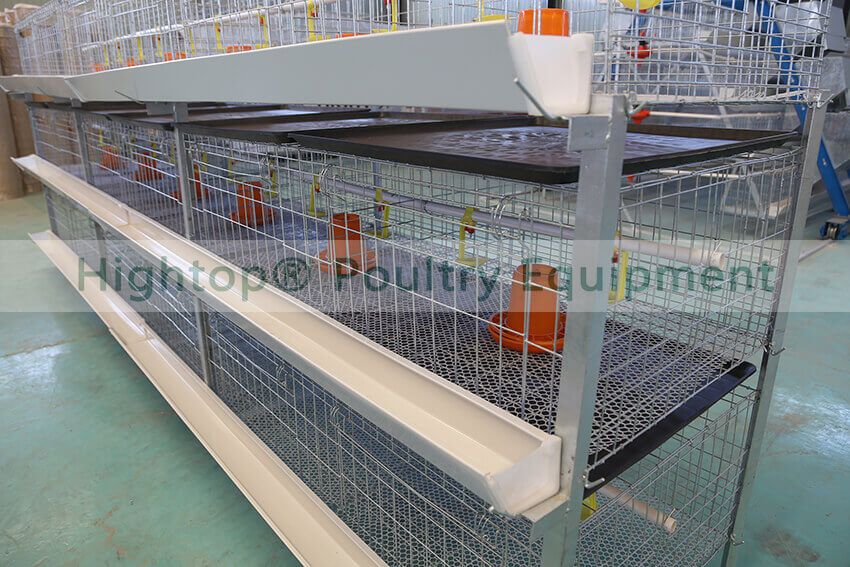
The right equipment in the house will ensure that you have a smooth operation and easy management of your broilers. Hightop poultry farm equipment offers one of the best equipment for broiler production. From broiler cage to layer chicken cage and poultry farm equipment, this company has specialized in this field to offer the best putting in mind what their customer needs. Their chicken farm equipment are very efficient and effective at a very good cost.
Below are some of the broiler farm equipment that you should consider having.
- To have a heat source, you will need an electric or gas brooder . It is recommended to use a 250 watt heat lamp for 50 chicks.
- Use small chicken feeders for younger chicks and larger ones as they grow older.
- Use small glass jar waterers when chicks are small and adjust to a larger one as they grow old.
- The litter or bedding for the chicks in this case can be dry and clean sawdust, wood shaving, straw or shredded paper.
Environmental Conditions for Broiler Production
The temperature condition around the broilers is very important for broiler farming and should be treated with high discipline. Failure to-do-so, this might lead to some problems for the broilers. Two days before bringing the chicks to the firm, you should check the temperature of the broiler house. For the first week, the temperature should read around 350°C and it will reduce slowly at a rate of 2.80°C per week. This mostly relies on the temperature outside. The litter or bedding of the chicken has to be around 5 to 6 inch in depth. If there is a chance, you can keep some straw in the chicken bed. The bed should be cleaned every two weeks and if it becomes very wet, you can use lime as it absorbs ammonia gas.
In addition, the temperature at bird height should be 86° t0 90° F. In winter or during very cold periods, run the heat for longer periods to ensure that the floor is okay. When chicks get cold, they don’t feed and might starve to deaf. When the right conditions are observed, the Broilers will grow fast with little problems. This further reduces the overall costs incurred in treatment and other challenges experienced.
Feed and Water for Broiler Keeping
The most important factor in broiler rearing is the chicken feed. When you provide proper and quality feeds to your broilers, you will obtain great results. The broilers consume the feed and convert it to meat. For the farmer to be successful, they should give their broilers the right feed. Broiler poultry requires a high ratio of proteins in their feed for them to grow well. Vitamins are also needed such as A, B2 and B12 among others. To keep the broilers from diseases, they should be disinfected too.
The broiler consumes on the feed and water all day and night thus, ensure that these two are available 24/7 in the chicken house. Ensure that the water and feed are present in their cages. Good Broiler chicken cage such as those provide by Hightop broiler cage is ideal and easier to feed your broilers. Ensure you have one of them for efficient operation. During winter, the farmer should provide warm water to the broilers. When feeding your chickens, here are few things to know:
- Give the feed four different times in a day
- Give clean and fresh water every time
- The water and feed provided should be equivalent to the chicks available
- During summers, the Broilers take more water
- In the first weeks, give the chicks a lot of feed before their restricted feeding begins.
- The feeding time after restricted should be consistent day-in day-out.
Vaccinations for Broiler Rearing
The broilers require optimal conditions for them to be safe and secure from any diseases. But in most cases, this is difficult to attain. Vaccinating the broilers is a sure way of preventing them from the common diseases that might affect them. Hence, vaccinating them protects them from such threats in the long run. The vaccination process should be done correctly to ensure that all birds receive the vaccine and are protected.
When the birds are being vaccinated, it is required that within two hours of vaccine dilution all the birds should have taken a drink. Water vaccination is the best as all you need to do is to get every bird to drink the vaccinated water. The older the birds are, the more the volume of the vaccine should be.
Marketing of the broiler chickens shouldn’t pose any challenge to the farmer as there is a ready market worldwide. As long as your meat weighs correctly, you will get good rewards in return. All the effort should be put in rearing of Broiler chickens. That’s where the big challenge lies. With the right house, chicken feeds, equipment and management of the broiler chicken farm, you can be assured to make great profits out of this Business.
Things to know when starting broiler chicken farming
For great results and profitable broiler poultry farming business, here are some few facts that you should be enlightened about.
- Before the chicks arrive, ensure the chicken broiler houses are clean, tidy and fit for the broiler chicken. Install all the required equipment like the broiler cages .
- In the broiler production, the total cost spent on their food is very high. It accounts to about 65% of the total cost.
- Less food should be provided in broiler food. This should also be offered in warm water.
- The broiler poultry usually consumes 64% of protein from its food.
- The broiler chickens consume more food during winter than summer seasons.
- Proper vaccination and treatment should be provided to broilers as they affected by diseases easily.
After reviewing the key factors that should be looked out for when rearing broilers, you can now invest in this business with full knowledge of what to do and the precautions to take at every step until they are ready to be processed. Rearing broiler chicken at home has become popular as it is said that high quality and nutritious meat is produced. Also, the broiler chicken raised at home is much older and weighs heavier than those in supermarkets. But considering the cost incurred, rearing them at home is much more expensive than on a large scale basis.
The best way to rear broilers is by large scale production. Large scale broiler production lowers the cost of equipment, feeds, vaccination and overall management. The broiler should have a clean environment in which they are reared and be well caged in the best broiler cage like those from Hightop poultry farm equipment. The company offers one of the best cages and other equipment in the market.
Broiler chicken farming and broiler production can be a challenge, but with the right process, equipment and management, be ready to make huge returns in a short period of time.
Share This With Your Friends
Related posts.
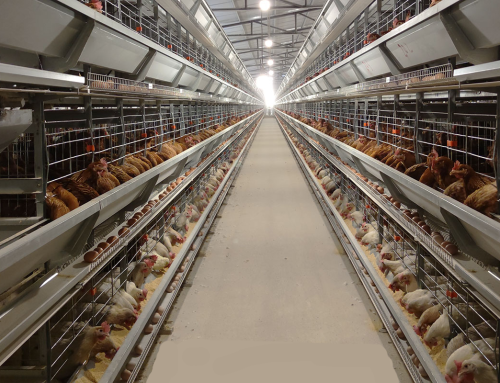
Contract Poultry Farming Companies Near Me – Transform Your Poultry Business with HIGHTOP
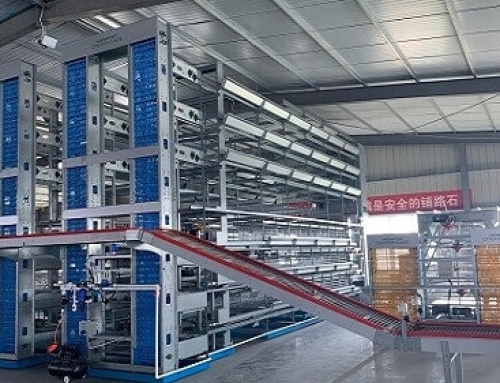
Use HIGHTOP Battery Cage to Revolutionize Your Poultry Farm
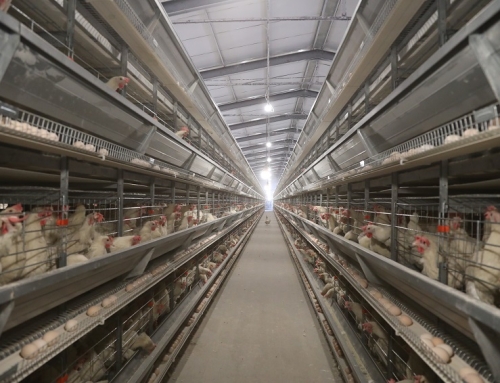
Use HIGHTOP Battery Cage to Improve Breeding Efficiency
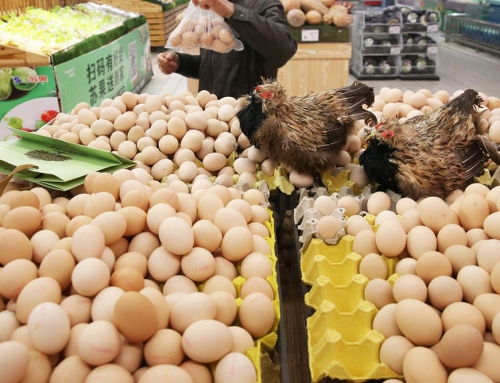
Successful Poultry Business Tips – Marketing Strategy for Poultry
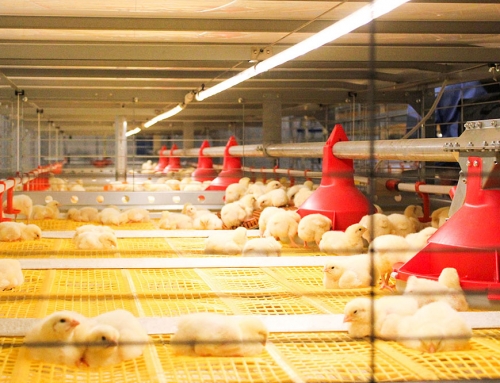
Poultry Light Control of the Layer Chicken House
Leave a comment 取消回复.
Save my name, email, and website in this browser for the next time I comment.
404 Not found
Poultry Farm Business Plan Template
Written by Dave Lavinsky
Poultry Farm Business Plan
You’ve come to the right place to create your Poultry Farm business plan.
We have helped over 1,000 entrepreneurs and business owners create business plans and many have used them to start or grow their Poultry Farms.
Below is a template to help you create each section of your Poultry Farming business plan.
Executive Summary
Business overview.
Smith Poultry Farm is a new farm business located in Mason City, Iowa. The business is a newly established farm founded by John and Sue Smith. As native Iowans, the couple has spent their life in the farming industry as their families have established farms throughout Iowa. Currently, there is a poultry shortage throughout the midwestern United States as some farms have been forced to shut down their business due to rising costs, labor shortage, and higher technology standards. John and Sue have decided to take this opportunity to alleviate the poultry shortage as well as finally establish the farm they have been planning to do for the past six years.
As native Iowans, John and Sue have already recruited a team of farmhands that have extensive experience working in poultry farms. Most of them have been recently laid off from other poultry farms that have shut down their operations.
John and Sue plan on starting with 5,000 chickens, 500 turkeys, and 100 ducks on 10 acres of land. Their business operations will be centered around daily processes and procedures to tend to the chickens and prepare them for packaging for resale and distribution.
Product Offering
The following are the products that Smith Poultry Farm will provide:
- Chicken for consumption
- Turkey for consumption
- Ducks for consumption
Customer Focus
Smith Poultry Farm will target all residents residing in northern Iowa and throughout the state. They will target families, individuals, supermarkets, large retail chains, and restaurants.
Management Team
Smith Poultry Farm will be owned and operated by John and Sue Smith. They will recruit a very experienced and knowledgeable operator to manage the day-to-day operations of the poultry farm.
John Smith was born and raised on a local farm and has been working in farms most of his life. He left to pursue his agriculture degree from Iowa State and returned to work full-time at his father’s large farm. That farm produces beef, poultry, pork, and vegetables. Once he married Sue, the couple decided that they would begin to save up to pursue a farm of their own.
Sue Smith was raised on a farm as well. Once she graduated from high school, she attended Iowa State to pursue a degree in Business Administration. It was there where she met John and planned for their future farm where he would manage the farm operations and she would be in charge of the financial management and administration of the poultry farm operations.
Success Factors
Smith Poultry Farm will be able to achieve success by offering the following competitive advantages:
- Ownership has extensive experience and knowledge in the poultry farming industry.
- Owners will invest in the latest technology and equipment to make their poultry farm the most superior in the Midwest.
- Smith Poultry Farm will breed high quality chickens, turkeys, and ducks in order to produce the freshest and quality poultry.
Financial Highlights
Smith Poultry Farm is seeking $500,000 in debt financing to launch its property management business. The funding will be dedicated towards securing the farm land and purchasing the necessary equipment and supplies. Funding will also be dedicated towards three months of overhead costs to include payroll of the staff, mortgage, and marketing costs for the poultry farm. The breakout of the funding is below:
- Purchase 10 acres of farmland: $100,000
- Farm equipment, supplies, and materials: $100,000
- Three months of overhead expenses (payroll, rent, utilities): $150,000
- Marketing costs: $50,000
- Working capital: $100,000
The following graph below outlines the pro forma financial projections for Smith Poultry Farm.
Company Overview
Who is Smith Poultry Farm?
Smith Poultry Farm is a new poultry farm business located in Mason City, Iowa. The business is a newly established poultry farm founded by John and Sue Smith. As native Iowans, the couple has spent their life in the farming industry as their families have established farms throughout Iowa. Currently, there is a poultry shortage throughout the midwestern United States as some farms have been forced to shut down their business due to rising costs, labor shortage, and higher technology standards. Growing up in the farming industry, John and Sue have decided to take this opportunity to alleviate the poultry shortage as well as finally establish the farm they have been planning to do for the past six years. The couple plans to raise chickens, turkeys, and ducks to produce poultry for food consumption as well as eggs. Once the business is established, the couple will add more birds to the farm and purchase additional land.
As native Iowans, John and Sue have already recruited a team of farmhands that have extensive experience working in poultry farms. Most of them have been recently laid off from other poultry farms that have shut down their operations. John and Sue have already identified the lead farmhand who will assist John in the day to day farm operations oversight.
Smith Poultry Farm History Smith Poultry Farm is owned and operated by John and Sue Smith, Iowa natives who have extensive experience in farm operations and business administration. John has worked for his father’s large farm for most of his life and wants to finally pursue his own poultry farm since a number of poultry farms have ceased operations due to increased labor and distribution costs. John has already pursued a number of local grocery stores, large retail stores, and restaurants to have contracts to be their sole poultry distributor.
Since incorporation, Smith Poultry Farm has achieved the following milestones:
- Registered Smith Poultry Farm, LLC to transact business in the state of Iowa.
- Has 6 contracts in place to provide poultry for local restaurants, grocery stores, and large retail chains.
- Reached out to numerous individuals and households to purchase their household’s poultry directly from Smith Poultry Farm.
- Began recruiting a staff of farmhands to assist in the day to day operations of the poultry farm.
Smith Poultry Farm Products
The following will be the products Smith Poultry Farm will provide:
Industry Analysis
Customer analysis, demographic profile of target market.
Smith Poultry Farm will target all residents of Mason City and the surrounding states. The target market will consist of households, grocery stores, restaurants, and large retail chains.
The precise demographics for Mason City, Iowa are:
- 503,642 residents
- 310,000 households
- 1,000 restaurants
- 500 grocery stores
- 6 large retail grocery stores
Customer Segmentation
Smith Poultry Farm will primarily target the following customer profiles:
- Individuals and households
- Grocery Stores
- Restaurants
- Large Grocery Chains
Competitive Analysis
Direct and indirect competitors.
Smith Poultry Farm will face competition from other companies with similar business profiles. A description of each competitor company is below.
Myson Poultry Farm
Myson Poultry Farm is a modern, multi-national, protein-focused food company that produces approximately 20% of the beef, pork, and chicken in the United States. Along with its subsidiaries, the company operates a food company worldwide. The company began during the Great Depression when the eldest Myson began selling chickens. A few decades later, Myson’s son grew it into the large company it is today and is one of the largest poultry producers and distributors in the world.
By investing in technology, Myson was able to grow the brand. Through the development of better feeds and better disease control methods, chickens were maturing more quickly. These improvements, combined with increased competition, meant lower prices for consumers and households were able to purchase their poultry products in larger quantities.
Iowa Poultry Farm
Iowa Poultry Farms started in the 1920s when Liam Nelson sold and traded eggs by the dozen as a means to put food on the table for his family. Four generations later, the Nelson family has grown the business year-over-year to continue to meet the changing needs of the egg and pullet industry. More than 90 years of experience has established Iowa Poultry Farm as a well-respected pullet and hatching business as well as a reliant commercial egg producer under the current leadership.
The strength of Iowa Poultry Farm began when master plans for growth from the late 1980s to present day have produced new and improved pullet production facilities that have the capacity to accommodate the growth of the majority of the pullets in NPF’s proprietary facilities. Recent capital development has been invested in hatchery and breeder facilities that have the capacity to produce up to 9 million female chicks per year as well as supplementary aviary growing facilities for both cage-free and floor-grown conventional pullets.
Iowa Poultry Farm continues to innovate as a pullet and hatching business under the leadership of Frank and his son, Brett.
Good Cluck Poultry Farm
Good Cluck Poultry Farm maintains more than 50,000 breeders on its company owned farms. The company currently hatches and sells 79 standard chicken breeds/varieties, 58 breeds/varieties of bantams, 9 breeds of ducks, 3 breeds of geese, and 4 breeds/varieties of guineas. In addition, Good Cluck has available, as a service to its customers, 9 heritage breeds of turkeys, pheasants, and chukar.
Good Cluck certainly has good luck. While many hatcheries have been forced to close, Good Cluck Poultry Farm has become a leader in producing non-commercial poultry annually, selling more than six million items of baby poultry.
Good Cluck’s full list of products are white egg layers, brown egg layers, colored egg layers, standard assortments, broilers, crested chickens, feather legged bantams, bantam assortments, clean leg bantams, ducks, geese, guineas, turkeys, pheasants, chukar, and supplies.
Competitive Advantage
Smith Poultry Farm will be able to offer the following advantages over their competition:
- Ownership has extensive experience and knowledge in the poultry farming industry and has over 20 years of experience managing poultry farm operations
- Smith Poultry Farm will breed high quality chickens, ducks, and turkeys in order to produce the freshest and quality poultry.
Marketing Plan
Brand & value proposition.
Smith Poultry Farm will offer the unique value proposition to its clientele:
- All farming practices will utilize the latest technology and equipment for safe breeding practices, production, and distribution of all farm animals.
- The farm will only breed the highest quality poultry.
- Unbeatable pricing to its clients and customers – Smith Poultry Farm does not mark up its poultry products at a large percentage. All poultry will be on par with competition.
Promotions Strategy
The promotions strategy for Smith Poultry Farm is as follows:
Word of Mouth/Referrals
John Smith has built up an extensive list of contacts over the years by living and working in the midwestern farming industry. Since a number of local poultry farms have ceased operations, they have committed to John that Smith Poultry Farm will be their poultry supplier. They trust his work ethic and commitment to the local community.
Professional Associations and Networking
Smith Poultry Farm will become a member of American Farmland Trust, Farming NGO, National Farmers Union, and the Iowa Chamber of Commerce. They will focus their networking efforts on expanding their client network and marketing their new brand.
Print Advertising
Smith Poultry Farm will invest in professionally designed print ads to display in programs or flyers at industry networking events.
Website/SEO Marketing
Smith Poultry Farm will hire a third-party marketing company to design their print ads and design their website. The website will be well organized, informative, and list all the poultry products they plan to offer. The website will also list their contact information and directions to the poultry farm. The marketing company will also include SEO tactics so that anytime someone types in the Google or Bing search engine “Iowa poultry farm” or “poultry farm near me”, Smith Poultry Farm will be listed at the top of the search results.
Zero po, hindi rin po kami mahilig malabas ng mga panood.
The pricing of Smith Poultry Farm will be moderate and on par with competitors so customers feel they receive value when purchasing their poultry products.
Operations Plan
The following will be the operations plan for Smith Poultry Farm.
Operation Functions:
- John Smith will be the Owner and President of the company. He will oversee all staff and manage client relations. John, along with Sue, has spent the past year recruiting the following staff:
- Sue Smith – will oversee all administrative aspects of running the poultry farm. This will include bookkeeping, tax payments, and payroll of the staff.
- George Hargrove – Head Farmhand who will oversee the farming staff and day to day operations.
- Ben Loya – Assistant Farmhand who will assist George.
- Frank Johnson – Distribution Manager who will oversee the packaging and distribution of all poultry products.
Milestones:
Smith Poultry Farm will have the following milestones complete in the next six months.
1/1/202X – Finalize purchase of farm land
2/15/202X – Purchase farm equipment, supplies and materials
3/1/202X – Finalize contracts for grocery store, chain, and restaurant clients
4/15/202X – Begin networking at industry events
5/1/202X – Purchase initial set of poultry animals
5/15/202X – Hire and train farm staff
6/1/202X – Smith Poultry Farm begins farm operations
Smith Poultry Farm will be owned and operated by John and Sue Smith. John will manage the oversight of all farm operations with the help of his lead farmhand. Sue will manage all administrative and financial aspects of the farm business.
Financial Plan
Key revenue & costs.
The revenue drivers for Smith Poultry Farm are the revenues it will receive from poultry products, eggs, and the breeding fees they will charge to individuals who have high-quality chicken, turkeys, or ducks they want to breed.
The cost drivers will be the overhead costs required in order to staff and maintain successful farm operations. The expenses will be the payroll cost, mortgage payment, utilities, farming supplies, equipment maintenance, and marketing materials.
Funding Requirements and Use of Funds
Smith Poultry Farm is $500,000 in debt financing to launch its property management business. The funding will be dedicated towards securing the farm land and purchasing the necessary equipment and supplies. Funding will also be dedicated towards three months of overhead costs to include payroll of the staff, mortgage, and marketing costs for the poultry farm. The breakout of the funding is below:
Key Assumptions
The following outlines the key assumptions required in order to achieve the revenue and cost numbers in the financials and in order to pay off the startup business loan.
- Number of Poultry Animals: 5,600
- Average Revenue per Animal: $20
- Number of Poultry Products Sold Per Year: 1,000,000
Financial Projections
Income statement, balance sheet, cash flow statement, poultry farm business plan faqs, what is a poultry farm business plan.
A poultry farm business plan is a plan to start and/or grow your poultry farm business. Among other things, it outlines your business concept, identifies your target customers, presents your marketing plan and details your financial projections.
You can easily complete your poultry farm business plan using our Poultry Farm Business Plan Template here .
What are the Main Types of Poultry Farms?
There are a number of different kinds of poultry farms , some examples include: Breeder Farms, Broiler Farms, and Pullet Farms.
How Do You Get Funding for Your Poultry Business Plan?
Poultry farms are often funded through small business loans. Personal savings, credit card financing and angel investors are also popular forms of funding. Having a chicken farming business plan will help show investors you are well-prepared to start your own business.
What are the Steps To Start a Poultry Farm Business?
Starting a poultry farm business can be an exciting endeavor. Having a clear roadmap of the steps to start a business will help you stay focused on your goals and get started faster.
1. Develop A Poultry Farm Business Plan - The first step in starting a business is to create a detailed poultry business plan that outlines all aspects of the venture. This should include potential market size and target customers, the services or products you will offer, pricing strategies and a detailed financial forecast.
2. Choose Your Legal Structure - It's important to select an appropriate legal entity for your poultry farm business. This could be a limited liability company (LLC), corporation, partnership, or sole proprietorship. Each type has its own benefits and drawbacks so it’s important to do research and choose wisely so that your poultry farm business is in compliance with local laws.
3. Register Your Poultry Farm Business - Once you have chosen a legal structure, the next step is to register your poultry farm business with the government or state where you’re operating from. This includes obtaining licenses and permits as required by federal, state, and local laws.
4. Identify Financing Options - It’s likely that you’ll need some capital to start your poultry farm business, so take some time to identify what financing options are available such as bank loans, investor funding, grants, or crowdfunding platforms.
5. Choose a Location - Whether you plan on operating out of a physical location or not, you should always have an idea of where you’ll be based should it become necessary in the future as well as what kind of space would be suitable for your operations.
6. Hire Employees - There are several ways to find qualified employees including job boards like LinkedIn or Indeed as well as hiring agencies if needed – depending on what type of employees you need it might also be more effective to reach out directly through networking events.
7. Acquire Necessary Poultry Farm Equipment & Supplies - In order to start your poultry farm business, you'll need to purchase all of the necessary equipment and supplies to run a successful operation.
8. Market & Promote Your Business - Once you have all the necessary pieces in place, it’s time to start promoting and marketing your poultry farm business. This includes creating a website, utilizing social media platforms like Facebook or Twitter, and having an effective Search Engine Optimization (SEO) strategy. You should also consider traditional marketing techniques such as radio or print advertising.
Learn more about how to start a successful poultry farm business:
- How to Start a Farm Business

Additional Helpful Template
Farm Business Plan
- PRO Courses Guides New Tech Help Pro Expert Videos About wikiHow Pro Upgrade Sign In
- EDIT Edit this Article
- EXPLORE Tech Help Pro About Us Random Article Quizzes Request a New Article Community Dashboard This Or That Game Popular Categories Arts and Entertainment Artwork Books Movies Computers and Electronics Computers Phone Skills Technology Hacks Health Men's Health Mental Health Women's Health Relationships Dating Love Relationship Issues Hobbies and Crafts Crafts Drawing Games Education & Communication Communication Skills Personal Development Studying Personal Care and Style Fashion Hair Care Personal Hygiene Youth Personal Care School Stuff Dating All Categories Arts and Entertainment Finance and Business Home and Garden Relationship Quizzes Cars & Other Vehicles Food and Entertaining Personal Care and Style Sports and Fitness Computers and Electronics Health Pets and Animals Travel Education & Communication Hobbies and Crafts Philosophy and Religion Work World Family Life Holidays and Traditions Relationships Youth
- Browse Articles
- Learn Something New
- Quizzes Hot
- This Or That Game
- Train Your Brain
- Explore More
- Support wikiHow
- About wikiHow
- Log in / Sign up
- Pets and Animals
- Bird Breeds
Everything You Need to Know to Create a Profitable Poultry Farm
Last Updated: March 20, 2024 Fact Checked
- Choosing a Farm Type
- Establishing the Farm
- Caring for Chickens
- Growing Your Farm
Expert Interview
This article was co-authored by Alexandra Doss and by wikiHow staff writer, Raven Minyard, BA . Alexandra Doss is a Poultry & Livestock Expert expert based in Ruskin, Florida. She owns and manages Stellar Game Birds, Poultry, Waterfowl LLC, a selective breeding operation with game birds, poultry, and waterfowl. With over 14 years of experience, she produces strong genetics and health in her hatching eggs, eating eggs, and live birds. The farm is FWC game farm licensed, FDAC licensed for quail, chicken, and duck eating eggs and meat, and NPIP certified. She is known as the Quail Lady and has published several books on raising Coturnix. Her work has been featured in Mother Earth News, Backyard Poultry, Grit, The Chicken Whisperer Magazine, and Community Chickens. She also has a career as a Workforce Management Supervisor and has a certificate in project management. She received a BS from Oregon State in Animal Sciences. There are 20 references cited in this article, which can be found at the bottom of the page. This article has been fact-checked, ensuring the accuracy of any cited facts and confirming the authority of its sources. This article has been viewed 1,747,640 times.
Running a chicken farm requires more than just agricultural know-how. If you want to be a chicken farmer, you must also think like a business person while growing your brand. Choosing a focus, establishing a brand, raising your chickens, and building your business are all part of chicken farming. Then, as your farm grows, you'll be able to market, finance, and network to grow your business. In this article, we’ll teach you everything you need to know to start a successful chicken farm business.
Quick Steps to Start a Chicken Farm
- Decide if you want an egg- or meat-production farm and choose the best chicken breeds for your focus.
- Buy the land for your farm and purchase supplies like coops, brooders, and feeders. Apply for a loan if necessary.
- Market your farm by creating a website, making ads, and attending agriculture conferences to network.
Choosing a Focus, Breed, and Location

- Although less common, some chicken farms handle both meat production and egg-laying. If you choose this option, it may require twice as much equipment and physical labor.
- Studies show that eggs from chickens raised in good environments have double or triple the omega-3 fatty acid content and a third of the cholesterol as other eggs. By creating an egg-laying farm, you can assure your customers that they weren’t fed or exposed to unhealthy chemicals. [2] X Research source

- Broiler farms typically grow between 4 and 8 flocks a year, depending on the size of the chickens.
- Large chickens are typically processed into value-added products like chicken patties and chicken fingers. Medium-sized chickens are often packaged as boneless breasts or whole rotisserie chickens. Small chickens are often sold as fast food products. [4] X Research source

- Egg or meat processing: Processing poultry products for taste, quality, and safety
- Marketing poultry products: Promoting poultry products through advertisements to increase revenue
- Chicken breeding: Raising, breeding , and selling chickens for pet owners or other farmers

- If you want to start an egg-laying farm, for example, you may want to choose a layer breed like Rhode Island Red, Hamburg, or Sussex chickens. [7] X Research source
- Some good broiler breeds include the Cornish Cross, Bréese, Buckeye, and Delaware chickens. [8] X Research source
- You can find a list of popular chicken breeds and their specialties at https://chickenbreedslist.com/ .

- The further you move from your city or town, the cheaper the land will be.
- If you can't find land near the city limits, look for land in the countryside where you'll have plenty of space to farm.
- Poultry expert Alexandra Doss recommends that you “have at least an acre or so” of land for a chicken farm, but “a quarter of an acre is fine for a few chickens, too.”
Establishing Your Chicken Farm

- If you choose agriculture or poultry science, add a business minor (or vice-versa) to take classes on marketing, leadership, and other relevant topics.
- Get your degree online if you don't have time for a traditional four-year degree.
- Other ways to learn about poultry farming include taking a training course or consulting an established farmer for advice and mentorship.

- If you’re starting a farm in the United States, consider applying for an LLC, which has many benefits for startups.

- If you're running a meat productions farm, for example, you could include your plans for raising and butchering chickens, revenue goals or the first year, and plans for marketing your poultry products in stores.
- Business plans are useful for attracting investors or business partners down the road.

- Bring a business outline, evidence of your credit history, pay stubs, and anything else requested by the bank to your meeting.
- Start with a loan for the minimum amount of equipment and chickens for your farm. You can always get a larger loan as your business grows.

- Lighting instruments
- Waterers or heaters
- Waste disposal system

- Start with a small farm so you don't have to pay workers until your chicken farm business is successful.
- If you need to hire more workers, try to hire those with years of experience in poultry farming for better stability. You’ll also likely need an administrative manager to keep an eye on daily business.
Raising and Caring for Chickens

- Extensive: A cost-effective system in which your chickens roam freely on the ground and just have a shelter.
- Semi-intensive: In this system, you’ll breed half your chickens in cages and the other half will roam freely on the ground. This system protects the chickens from predators and bad weather.
- Deep-litter: This system is best for broilers. The chickens can move freely on the ground made of straw, sawdust, and leaves. This system allows you to easily feed them and reach their eggs without unnecessary hurdles.
- Slatted or wired: This system includes creating small houses with wooden slats or wired mesh flooring. The slats are 4 feet above the ground and you can easily feed the chickens and collect eggs . This is ideal for adult birds as the houses have a low temperature.
- Battery-caged: In this system, you’ll place the birds in metal cages and separate them into groups. Each cage has its own food and water containers and provides nests for the chickens to lay eggs in. This is the most effective system for egg production, but it may be too expensive for a new business.
- Build the chicken coop or cage at about 4 sq ft (0.37 m 2 ) per chicken. [17] X Research source
- Clean the chicken coop or cage regularly to prevent the chickens from spreading diseases.

- When buying chicks, always do some research beforehand to make sure the breeder is dependable. You don’t want to invest a ton of money on chicks just to discover they’re sick or malnourished.
- Make sure you have the brooder ready before buying and stocking the chicks.

- You can also give chickens corn, halved grapes, or cabbage as a treat, but avoid feeding them these treats more than several times a week as it's less healthy than chicken feed. [19] X Trustworthy Source The Humane Society of the United States National organization devoted to the promotion of animal welfare Go to source
- Nearly 70% of your production cost comes from supplying poultry feed.
- As you become more experienced, consider learning how to prepare your own feed . Until then, buying it from the market is fine.
- If your chickens aren’t fed properly, they’ll produce fewer eggs and become susceptible to various diseases.
- If you use ingredients like maize, ensure the moisture content is never above 10-11%, as this may lead to fungus. To prevent this, purchase your feed from a reliable company.

- As there is currently no effective treatment for poultry diseases, vaccinate your chickens to keep the diseases from spreading. Some common vaccines include RDV, Fowl Pox, Cholera, and Mycoplasma. Consult with your vet to get your chickens vaccinated.
- Not all vets have experience working with chickens, so locate a poultry vet ahead of time. [22] X Trustworthy Source The Humane Society of the United States National organization devoted to the promotion of animal welfare Go to source
Growing Your Poultry Farm

- If you notice that you're spending too much on chicken feed, for example, shop around with different suppliers to find cheaper feed.
- You can also hire an accountant or financial advisor to keep your records organized for you.

- Creating a logo for your business can also provide visibility for your brand. Make sure it aligns with your business (for example, you could never go wrong with incorporating a chicken into your logo) and put it on your website and business cards.
- If you don’t have a large budget, however, don’t splurge on a logo when you can invest your money into your actual business.
- Make use of social media, as well. Consider making a Facebook, Instagram, and even a TikTok account to spread the word about your business. Be sure to post regularly!

- Connect with your friends and neighbors, too. Even if they’re not farmers themselves, they may know people who are interested in buying from you or investing in your business.

- If you're running a chicken breeding farm, for example, you may want a loan to buy better egg incubators.

Community Q&A
- If you're not up for starting a chicken farm from scratch, you can also invest in or buy an existing franchise instead. [26] X Research source Thanks Helpful 0 Not Helpful 0
- Research methods that successful chicken farms use as a guide for your business. Popular poultry farms include Cargill Meat Solutions, Hormel Foods Corp, Tyson Foods, JBS USA, and Smithfield Foods. Thanks Helpful 0 Not Helpful 0

- Always wash your hands thoroughly after handling chickens. Live poultry often carry salmonella. [27] X Research source Thanks Helpful 0 Not Helpful 1
You Might Also Like

Thanks for reading our article! If you’d like to learn more about poultry, check out our in-depth interview with Alexandra Doss .
- ↑ https://survivallife.com/what-advantages-chicken-farming/
- ↑ https://www.greenamerica.org/green-living/many-benefits-backyard-chickens
- ↑ https://www.aces.edu/blog/topics/farming/new-farmers-guide-to-the-commercial-broiler-industry-poultry-husbandry-biosecurity-basics/
- ↑ https://www.poultry.care/blog/how-to-start-a-successful-poultry-care-farming-business
- ↑ https://www.fao.org/poultry-production-products/production/poultry-species/chickens/en/
- ↑ https://www.canr.msu.edu/uploads/234/69325/Chicken_Breed_Chart_to_Help_Choose_Your_Chicken.pdf
- ↑ https://animal-world.com/best-meat-chicken-breeds/
- ↑ https://withmydegree.org/can-degree-agriculture/
- ↑ https://www.sba.gov/business-guide/plan-your-business/write-your-business-plan
- ↑ https://chickenscage.com/news/how-much-does-the-poultry-farm-equipment-cost.html
- ↑ https://www.fao.org/poultry-production-products/production/management-and-housing/en/
- ↑ https://grubblyfarms.com/blogs/the-flyer/how-big-of-a-coop-do-i-need
- ↑ https://www.humanesociety.org/resources/adopting-and-caring-backyard-chickens
- ↑ https://www.canr.msu.edu/news/decreasing-daylight-and-its-effect-on-laying-hens
- ↑ https://extension.missouri.edu/publications/g8903
- ↑ https://www.irs.gov/businesses/small-businesses-self-employed/what-kind-of-records-should-i-keep
- ↑ https://www.nerdwallet.com/article/small-business/how-to-apply-small-business-loan
- ↑ https://www.fao.org/poultry-production-products/production/poultry-species/en/
- ↑ https://www.investors.com/promoted-content/franshares/how-to-generate-passive-income-through-franchise-investing/
- ↑ https://www.health.state.mn.us/diseases/animal/backyard.html
About This Article

To start a chicken farm business, decide if you want to focus on eggs, meat production, or another specialty niche, then obtain the necessary equipment. Next, choose a chicken breed that matches your farming goals and set up coops or cages to keep them in. Feed and care for your chickens daily and be sure to separate any chickens that seem ill from the rest of the population. Don't forget to market your business by creating a website and advertisements! For more tips on choosing the best breed for your goals, read on! Did this summary help you? Yes No
- Send fan mail to authors
Reader Success Stories
S. Simelane
Aug 24, 2017
Did this article help you?
Usman Kehinde
Aug 25, 2017
Robert Leggett
Feb 6, 2018
Pamela Spalani
Jun 23, 2016
Nikky Adetokun
Mar 9, 2017

Featured Articles

Trending Articles

Watch Articles

- Terms of Use
- Privacy Policy
- Do Not Sell or Share My Info
- Not Selling Info
Don’t miss out! Sign up for
wikiHow’s newsletter
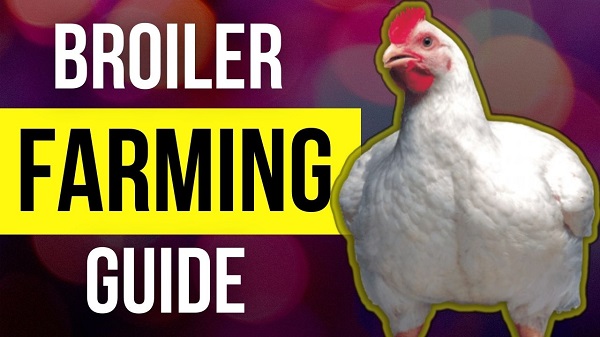
Beginner’s Guide to Raising Broilers from Start to Finish
Broiler chickens, also known as meat chickens, are a type of poultry that are raised for their meat. They are often reared commercially in large numbers.
Broiler farming is a very intensive process, and it is important to ensure that the birds are well cared for in order to produce healthy meat. Raising broilers can be a fun and rewarding experience, especially if you have the right information to get started.
In this beginner’s guide to broiler farming, we will cover everything from selecting the right breed of bird to setting up your brooder and raising healthy broiler chicks. We’ll also discuss important topics like feed and feeding, vaccination schedules, and common diseases of broiler chickens. By following these simple steps, you can ensure a successful journey from start to finish with your broiler flock. There is also a link to a Raising Broilers from Start to Finish PDF ebook.
Also Read: A Beginner’s Guide to Layer Farming
Some Facts about Broiler Chickens
Some of the facts about broilers include:
- Broiler is another name given to a poultry species that provide meat that is suitable for broiling.
- Broilers have a rapid growth rate and they attain marketable or consumable size within 5 weeks.
- Broiler chickens are easy to raise and manage both on a small, medium and large scale.
- Broilers convert feed better and faster than any other type of chickens or poultry.
- Broilers are not rugged or hardy birds; hence they need an optimal form of care and management which includes prompt vaccination and medication, adequate ventilation and high-quality feed.
- Broilers go through a three-phase feeding program or regime which are broiler starter, broiler grower and broiler finisher.
- Their meat is juicier and tastier than other poultry meat.
- They can be raised organically and synthetically but the former is costlier but healthier.
- They don’t do well on free-range but under an intensive system of management. They can be raised either in cages or deep litter floors.
- They live longer when raised on free range than when they are completely kept in a pen.
- Broilers can lay eggs just like every other bird and they can also mate with roosters of other chicken breeds.
- We have different strains of broiler (some call it breeds). We have the Ross, Cobb, Arbor Acres, Hubbard and Marshall broiler strains.
Broiler Production Programs
There are two broiler production programs that can be used for raising broilers or broiler chicken farming. These are:
- Occasional broiler production program ; for special events such as Christmas, Easter, and Salah festivals or some other demands like weddings, anniversary celebrations, birthdays, thanksgiving, etc.
- Regular broiler production programs ; which are; All-in, All-out systems; and multiple production systems.
What you need to get started in raising broilers
When it comes to broiler chicken farming, there are a few things you need to know in order to get started. You will need the following:
- Brooding house or brooding cage
- Rearing pen or cage
- Electric, gas or charcoal brooder (source of heat)
- Feeders (tray and cone feeders)
- Drinkers (nipple, fountain or bell drinkers)
- Brooder guard
- Wood shavings
- Water tanks or drums
- Buckets and bowls
- Brooms, knives and scissors
- Vaccines and medicines
- Weighing scales (digital or analog)
- Knapsack sprayer
- Ropes and binding wires
- Pliers or pinches
- Good source of water
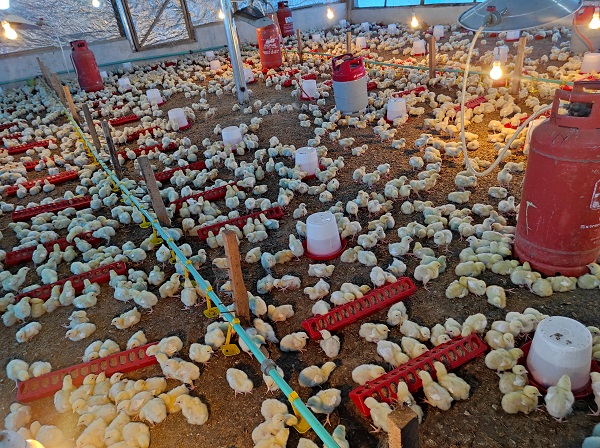
How to Find and Select the Right Broiler Chicks
Chicks are younglings of chickens. The quality of broiler chicks you purchase directly affects their growth and feed conversion rates. Therefore, if you start your broiler farming journey with low-quality chicks, you shouldn’t expect anything positive in the end.
Chick quality is a crucial factor for the success of your broiler farm. Chick quality can be determined by factors that include the origin and location of parent stocks and hatcheries, the farming environment, etc. Parent stocks are important because high-quality parent stocks produce high-quality chicks. The production environment is also an important factor in chick quality because it affects performance.
When it comes to getting chicks, you need to choose wisely. Hatcheries are easy to deal with; they offer a wide range of choices and they have good customer service. But there is no guarantee that the chicks you buy will be of good quality.
You can source high-quality day-old chicks (DOC) from reputable hatcheries and marketers and vendors, but you need to be careful if you go the latter route. There are a lot of shady dealers out there who will try to pass off unhealthy or low-performance broiler chicks as high-quality ones in an attempt to make more money.
If you buy chicks from reputable hatcheries, your stock will perform well—and the better it performs, the more money you make. But if you buy chicks from dodgy hatcheries, your chicks will perform badly and your profit will suffer.
Before booking for broiler chicks, it’s important to know what you’re looking for and do your research ahead of time. Make sure to ask the right questions before you buy — and don’t get roped in by limited offers, as they’re likely to turn out to be a scam.
If you’re buying from a DOC vendor or marketer, ask for the following:
- Name of hatchery or source of parent stock
- Performance metrics
- Strain or breed
- Vaccination and medication schedule/program?
- When will the chicks be ready for collection?
- Will the chicks be vaccinated by the hatchery when they are hatched?
What is the best hatchery to buy from?
There is no best hatchery when it comes to sourcing chicks. Some farmers have this misconception that one hatchery is the best. Well, No! We only have reputable hatcheries and none of them can be classified as the best.
Issues may occur in the parent stock and the problem is passed on to the chicks and then to the farmer. If a poultry farmer starts having problems with the chicks, then such a farmer might say the hatchery is bad. However, if the hatchery discovers that there is an issue with a particular batch of chicks, they are ready to compensate affected customers. But the deed has been done which is something they cannot control initially.
Hence, it is best to buy from hatcheries that have excellent track records as well as have their customers at heart. Apart from the physical characteristics of high-quality chicks, you should always consider the public reputation of the hatchery whenever you want to procure or place an order for chicks.
Setting Up or Building a Broiler Pen
Broiler housing systems.
Broiler chickens can be raised in cages (battery cage system) as well as on the floor (deep-litter system). When raised in cages, more birds are raised per unit space.
Deep Litter System
Under this system, the floor of a deep-litter pen is covered with bedding material such as wood shavings, which absorb moisture from the broiler droppings. The litter materials must be able to absorb a lot of moisture. Wood shavings, chopped hay or straw, groundnut hull or rice husks are examples of good litter materials.
Feed and water are served to the birds inside the pen while the litter is packed and replaced when they get wet, smelly or caky.
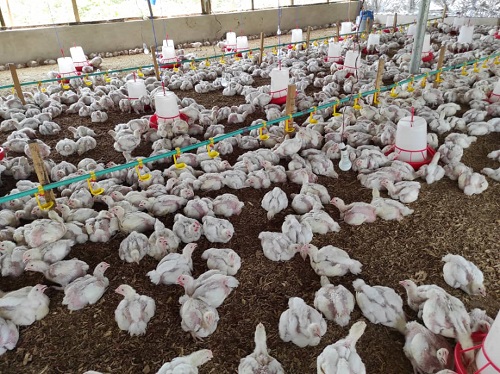
Cage System
The raising of broilers in cages is not common on a commercial level. Under this system, the broilers are raised in a wooden or metal cage. The feeders and drinkers are also placed inside the cage. Although, wood shavings or sawdust are spread under the cage to absorb the moisture from the droppings and it makes cleaning easy.
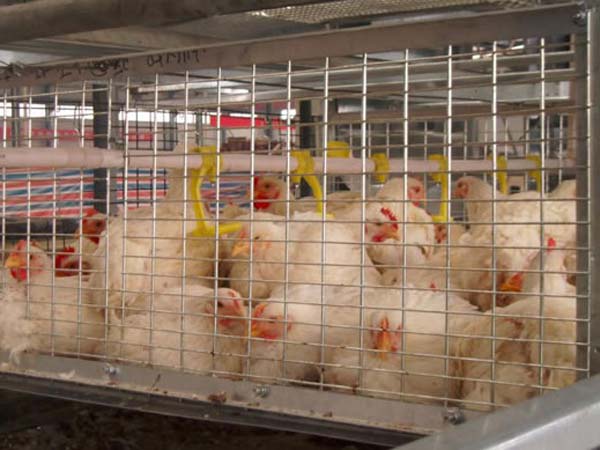
Getting Started
As mentioned earlier, broilers do well under an intensive management system. That is when they are housed in a pen or cage with restricted movement. The reason for this is not farfetched. They convert the energy meant to be used for scavenging or roaming around to flesh and fat.
A broiler house should be constructed properly. Irrespective of the size and building materials used (wood or brick), the following features must be available.
- Must be constructed in the correct location
- The roof must be watertight and non-leaky
- The floor and walls should be easy to clean and disinfect
- It should allow adequate ventilation
- Wild bird and rodent proof roof, walls and floor
Where to locate a broiler house
Before constructing a broiler chicken rearing pen, ensure the following conditions are met.
- The land must be well-drained and not water-lodged. This is vital especially if you plan to raise broilers on the deep-litter floor system.
- If possible, the house or pen should be sited far from other poultry houses or farms to minimize the spread or transmission of diseases.
- The building should be in the east-west direction to avoid direct sunshine into the rearing pen.
- The house should be well lighted and allow natural sunlight during the day.
- There should be shades around the house such as tall trees if it is in a hot area. The tall trees however should not hinder natural airflow.
- Fence the broiler farm or unit to reduce human traffic which will reduce the incidence of disease outbreaks and bird theft.
How to build a broiler chicken pen
- When building a broiler pen or cage, ensure that the materials used are of good quality, durable and easy to repair when damaged. This is because the house is meant to last for a long time.
- The width (wideness) of the pen house should not be more than 10 meters (33 feet) for sufficient natural ventilation. The number of broilers to be kept in the pen would determine the length (longness) of the pen. The height of the pen shouldn’t be less than 2 meters.
- The floor of the pen must be concreted as it makes the floor easy to clean.
- If you are in the hot and temperate region, ensure that at least 3 sides of the pen side walls are opened but covered with wire nets so as to allow adequate air to flow easily into the pen. These opened sides can be temporarily and partially covered with tarpaulin during brooding or when you have chicks inside the pen.
- The roof should extend the walls of the pen by 0.5-1 meters. You can slope or ridge the roof. For a ridged roof, the ridge should be open to allow the natural escape of heat due to the chimney or stack effect.
- You should include a cloakroom or changing room, feed store and there should be a foot dip at the entrance to the area where the chickens are kept.
Broiler Chicken Management
Brooding broiler chicks as a beginner, what is brooding.
Brooding is the act of caring for broiler chicks from one day old to 2 weeks of age. This includes the provision of heat, feed, water, vaccination, medication and other necessary care during their early growing period.
Chicks are just like babies that need maximum care from the mother. However, in the case of chicks, there is no mother and it is the responsibility of their raiser to provide all the support and needs the chicks required.
Broiler chicks can’t regulate their body temperature themselves, they don’t have feathers to protect them from cold and their mother is not there to keep them warm. This is why it is important to provide artificial heaters for them. The artificial heaters can be charcoal stoves, kerosene stoves, gas brooders, electric brooders and incandescent light bulbs.
Apart from providing heat to the chicks during brooding, feed and water must be provided too. These are very important for the survival and quick growth of the chicks. Hence, you will need adequate numbers of feeding trays or flip-top feeders as well as baby drinkers.
The recommended temperatures for broiler chicks are:
- Day 1 – 34 o C or 93 o F
- Day 2 – 32 o C or 90 o F
- Day 7 – 31 o C or 88 o F
- Day 14 – 27 o C or 81 o F
When it’s one week to the arrival of the chicks, the following should be done or put in place.
- Clean and disinfect the pen thoroughly with good disinfectants like Morigard, Polidine or V-OX. The floor and walls should not the focus. The production equipment which includes the brooder or heater, feeders and drinkers should not be left out.
- Re-install the equipment after they must have been disinfected.
- After the inside of the pen has been properly cleaned and disinfected, prepare a foot dip at the entrance of the pen with the disinfectant solution inside in it. Anyone going in and out of the pen must dip their feet inside the foot dip.
- Cover up the netted walls with translucent polythene material or white tarpaulin if available. Just ensure the openings are covered to trap heat and stop draught when brooding.
- Lock the pen until the time the chicks will arrive.
When it is 24 hours to the arrival of the chicks, do the following.
- Spread the wood shavings to a minimum depth of 5cm above the floor. If you are brooding inside a cage, place newspapers or plywood on the floor of the cage.
- Light up the heaters (electric bulbs, charcoal stoves, gas brooders, etc.) and if you want to use brooder guards, set them up around the heaters. Place a digital or analog thermometer to monitor the temperature of the whole pen. The required temperature is 34 o C or 93 o F.
- Check that the pen is well illuminated by the bulbs and that the floor is easily seen. If there is a need to add more bulbs, do so immediately.
- Arrange the round tray feeder and drinkers based on the number of broiler chicks.
- Adjust the feeders and drinkers well so that the chicks can reach the feed and water easily.
When the chicks arrive, do the following.
- Mix mild broad-spectrum antibiotics, multivitamins and glucose in water and fill all drinkers with the solution 3 hours before the chicks arrive. Put the broiler starter mash or crumbles in all the feed trays.
- Immediately the chicks arrive, unload the boxes from the van and move the boxes into the brooding pen. Start unboxing the chicks gently but quickly unto the floor. Take a record of the number of chicks inside each box including dead and malformed chicks.
- Make sure the chicks are even spread or distributed within the brooding area. Also, ensure that they are eating the feed inside the feed trays and drinking water.
In the first 3 days of brooding broiler chicks, you must check them regularly (every 30 minutes) and also check the thermometer reading. However, the most important thing is to check the behavior and arrangement of the chicks to know if the ambient temperature is correct.
Please note:
- If the chicks are evenly distributed in the pen, it shows the temperature is correct.
- If the chicks huddle together under the heat source, it means the temperature is too low. In this case, add more heaters.
- If the chicks move far away from the heat source, it means the temperature is too high. In this case, reduce the heaters or open up a side of the wall to allow heat dissipation.
- If the chicks are arranged on one side of the pen, it means the heat is not evenly distributed. In this case, check for open walls allowing air movement from outside into the pen.
It is important to also check the water tanks and drinkers. If you are using nipple drinkers, check if the water is coming out. If you are using a fount drinker, ensure that the openings are not blocked by wood shavings.
What you should do for the first 7 days of brooding
- Administer antibiotics and multivitamins via water for 3-5 days right from day 1.
- Provide broiler starter feed and water round the clock for the chicks. However, the drinkers and feeders should be washed every day.
- Check the vitality of the chicks. If you find chicks with vent or cloaca soiled with feces, clean the area with a clean cloth soaked in warm water.
- If you use newspaper instead of flip-top feedings or feed tray, remove the newspapers after 2 days and replace them with flip-top feeders or trays.
- Remove dead chicks and bury them immediately.
- Replace the litter after 5 days.
- As the chicks grow in size and weight, gradually expand the brooder area if it is partitioned.
- Reduce the temperature gradually every day. In the hot afternoon, put off some of the heaters to avoid mortalities due to heat stress.
- Lighting must be provided round the clock to allow the chicks to eat in the evenings and nights.
- Take the average weight of the chicks every day using a digital weighing scale and kept the records.
- Keep the records of stock, mortalities, quantity of feed consumed and medication. Do this until the chickens are sold and slaughtered.
You can read this complete guide on the brooding of chicks here
Feeds and Feeding in Broiler Farming
To ensure that the broilers grow healthily, it is essential to feed them with high-quality feed. Low-quality feeds may result in not only low production but also poor health. The nutritional requirements of broilers vary with age; hence three different diets are commonly given to broilers. They are:
- Broiler starter diet
- Broiler grower diet
- Broiler finisher diet
- Broiler starter diet . This diet usually contains 21-22% crude protein and 3000 Kcal/kg energy. This is fed for the first 10 days of life. Thereafter, the broiler chicks have a commensurate additional growth response.
- Broiler grower diet . This diet usually contains 19-20% crude protein and 3050 Kcal/kg energy. This is fed after 10 days until 25 days of age.
- Broiler finisher diet . This diet usually contains 18-19% crude protein and 3100-3200 Kcal/kg energy. This is fed after 25 days of age weeks until the birds reach the market weight between 6-8 weeks.
Some broiler farmers feed the pre-starter diet, which contains more protein and antibiotics for a better start for the first 7 days.
Broilers are commonly given mash but crumbles and pellets are acceptable to them. They should be fed and given water ad libitum. The feeders should be constantly raised to the level of the back of the broilers also to prevent feed wastage.
Many producers market their broilers at 6 weeks. It has been shown that after 8 weeks, the rate of body weight gain of a broiler starts declining while feed conversion continues to increase.
I wrote a complete broiler feeding guide. Click here to read it .
Water Consumption in Broiler Farming
Water is very important to broiler chickens. When deprived of water, they die. A simple way of estimating the volume of water required by broilers is to multiply the age of the broiler in weeks by 2. The answer gives the estimated liters of water needed by 100 broilers daily that week. For instance, at 7 weeks of age, 100 broilers will drink 7 X 2 = 14 liters of water daily. Water consumption increases during hot weather.
Feeder and Drinker Requirements for Broiler Chickens
Broiler health and disease management, how to keep broiler chickens healthy.
Remember the saying, “Prevention is better than cure.” To keep your broilers healthy, there are certain important things that you must do routinely and occasionally. It is not only administering drugs now and then. Doing that will only increase your production costs. This is why it is better to do the things that will prevent your broilers from falling sick and help them grow very well.
- Ensure you observe a high level of biosecurity. This includes disallowing visitors to enter the pens anyhow and without disinfecting their footwear in the foot dip. Wild birds and rodents should be restricted from the pen area as they are potential disease carriers. Block all holes and crevices.
- Proper hygiene and sanitation should also be observed. This includes disinfection of all production pens and equipment, regular washing of the feeders and drinkers and proper disposal of poultry wastes and litter. Have an incinerator where dead birds are properly burnt and buried.
- Avoid giving contaminated or moldy feed to the birds. Ensure the feedstore is adequately ventilated and dry as wet environments accelerate feed spoilage.
- Give your birds clean and healthy water and not water from questionable sources. If you can’t drink or cook with the water, then it is not safe for your chickens to drink.
- Ensure adequate ventilation and avoid overcrowding or overstocking the pen more than the ideal capacity.
- Replace smelly, caked or wet litters with new and clean litters. If you notice the pen is starting to give an ammonic smell or it is past 5 days, it must be packed immediately.
- Physical stress weakens the immune system of chickens. Therefore, ensure you reduce the relocation, transportation and handling stresses to the minimum. Administer an anti-stress (multivitamins) after to minimize the effects of stress on the chickens.
- Vaccinate at the right time and give the necessary medications such as coccidiostat and antibiotics before diseases resurface. Ensure to adhere to the dosage and administration instructions by the manufacturers.
- If you observe a bird is sick, isolate such bird from the main flock until it recovers.
- Raise birds of the same kind, batch and age together. Don’t raise broilers, turkeys and cockerels together in the same pen.
- Always make sure there is enough water and feed for the birds and make sure water is available all the time.
Vaccination and Medication
A common challenge that poultry producers face is the prevention and treatment of diseases in their broiler flocks. Vaccination and the use of medications are two common methods used to protect bird health.
Broiler vaccinations are an important part of ensuring good health in broiler flocks. Vaccinations can protect birds from some diseases, including Marek’s disease, Newcastle disease, and infectious bursal disease. In addition to vaccines, administering medication to broilers can also help to keep them healthy. Some common medications used in broilers include antibiotics and coccidiostats.
What is Vaccination?
Vaccination is the process of protecting chickens from disease by giving them a vaccine. A vaccine is a type of medicine that contains a tiny amount of the germ that causes the disease. When the chickens get vaccinated, their body’s immune system learns how to fight the germ. If those chickens are ever exposed to the disease, their body may be able to fight it off better because of the vaccine.
Some poultry diseases are incurable and the only solution is to prevent them by vaccinating the chickens from such dreadful diseases. Each class of birds has its own unique vaccination program or schedule. For broilers, the suggested vaccination schedule is:
- Day 7: 1st Lasota or Newcastle disease vaccine
- Day 12 : 1st Gumboro or Infectious Bursal disease (IBD) vaccine
- Day 18 : 2nd Gumboro or Infectious Bursal disease (IBD) vaccine
- Day 28 : 2nd Lasota vaccine
Click here to read how to vaccinate broilers
Read: Vaccination Schedule for Broilers and Turkeys
What is Medication?
Medication in poultry is a broad term that can refer to a variety of different treatments or interventions. It can include antibiotics, vaccines, and other medications used to prevent or treat diseases in poultry. The medication schedule of broilers is as follows.
- Day 1-3: Antibiotics (Ciprofloxacin) + Multivitamins
- Day 5-6: Coccidiostats (Aprolium or sulphonamides)
- Day 7: Multivitamins
- Day 42-43: Dewormer
- Give multivitamins after each vaccination and drug administration.
Diseases of Broilers
Among the diseases of broilers are:
Bacterial Diseases
- Chronic Respiratory Disease (CRD)
- Colibacillosis
- Fowl cholera
- Fowl typhoid
- Infectious coryza
- Mycoplasmosis
- Necrotic and ulcerative enteritis
- Salmonellosis
Virus Diseases
- Avian Influenza (Bird flu)
- Infectious bronchitis
- Infectious Bursal Disease (Gumboro disease)
- Lymphoid leucosis
- Marek’s disease
- Newcastle disease
Fungal Diseases
- Aspergillosis
- Mycotoxicosis
Parasitic Diseases
- Ascaridiosis
- Coccidiosis
- Heterakidosis
- Histomonosis
- Knemidokoptosis
- Raillietiniasis
- Trichomoniasis
Marketing of Broiler Chickens
Broiler chickens are chickens that are bred and raised for meat production. They are usually sold to consumers in grocery stores or restaurants. There are a few ways to market broiler chickens. One way is to sell them to restaurants or grocery stores. Another way is to slaughter and process them and then sell the meat to consumers.
The advantage of selling broiler chickens to restaurants or grocery stores is that you can get a higher price for them. The disadvantage is that it can be more difficult to find buyers, and you may have to wait until the end of the season to sell all of your chickens.
FAQs about Broilers and Broiler Chicken Farming
These are some of the Frequently Asked Questions (FAQs) about broilers and broiler farming/production.
1. How many bags of feed for 100 broilers? How many bags of feed for 100 broilers for 6 weeks?
A broiler would consume an average of 4.25 kg from day old to the end of the 6th week. So, 100 broilers would consume (4.25 X 100) = 425 kg or 17 bags of feed for 6 weeks. A bag is assumed to contain 25kg of feed.
2. How many bags of feed for 50 broilers in a month?
You should expect 50 broiler chickens to eat 130kg of feed in one month. 130kg is 25kg if one bag is assumed to contain 25k of feed.
3. How many feeders for 50, 100 and 200 broilers?
50 broiler chicks need 2 chick tray feeders while 100 adult broilers need 2 tube feeders. 100 broiler chicks need 3 chick tray feeders while 100 adult broilers need 3 tube feeders. For 200 broilers, 6 tray feeders and 6 tube feeders.
4. How many drinkers for 100 broilers?
100 broiler chicks need 2 fount drinkers while 100 adult broilers need 2 bell drinkers.
5. How long does it take a broiler to reach market weight?
A broiler can reach maturity as early as 6 weeks. Though, this is a factor of feeding, management, and pedigree.
6. What is the average weight of a mature broiler?
A mature broiler should have an average weight of 2.2 kg at the 6th week of age
7. How many days should day-old broiler chicks be brooded?
This depends on the current season or weather. However, brooding broilers should not exceed two weeks. After 2 weeks, withdraw any source of heat or warmth and you may remove the polyethylene material used in covering the openings. The principle is whenever the young chicks have developed enough feathers to cover their body, it is unnecessary to supply additional heat again. Read more about brooding broiler chicks.
8. How much would it cost to feed 100 broilers to maturity?
As of the time this post was written, it costs ₦126,000 to feed 100 broilers in Nigeria.
If you have questions on broiler farming that have not been answered, please ask them as comments and I would update this post.
Get the Ebook on Broiler Farming Here
Signup today and receive free updates straight in your inbox.
We don’t spam! Read our privacy policy for more info.
Check your inbox or spam folder to confirm your subscription. Thank you!
Akinbobola A.
Related Posts
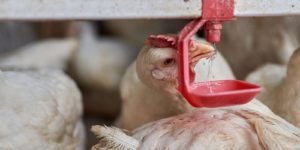
Electrolytes for Chickens: Benefits and How to Prepare
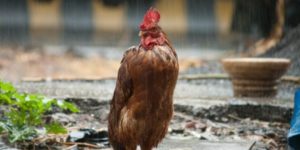
Poultry Diseases that are Rampant in the Cold or Wet Season
![broiler rearing business plan [Ebook] How to Start Broiler Farming Business Successfully](https://www.livestocking.net/wp-content/uploads/2016/08/broiler-farming-ebook-Guide-e1664186263243-300x150.png)
[Ebook] How to Start Broiler Farming Business Successfully

10 Factors That Affect Egg Size
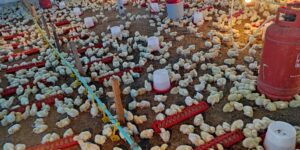
Brooding in Poultry – Definition, Types & How to Brood
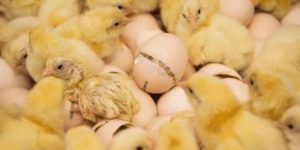
List of Popular & Unpopular Hatcheries in Nigeria

70 thoughts on “Beginner’s Guide to Raising Broilers from Start to Finish”
Thanks for this platform can you kindly discuss on formulation of broiler feeds
Hi. Check this post http://www.livestocking.net/diy-easily-formulate-feeds-poultry-birds
Which aspect of formulation?
Pls just kindly add me up on ur WhatsApp 08101420963
My broiler are aways sleeping what can i do
Maybe they are not feeling fine. What other signs are you seeing?
Good! We can also advertise your poultry cage business on our site at an affordable rate. You can send us an email.
Comment:please I Am An Undergratuate From Animal Science P/s Help Me With Feed Formulars(poultry)
Which of the formula?
Dear Akim, pls, i need a step by step broilers feed formula to enable me start my poultry productions
Comment:Is it advisable to rear broiler for 20 weeks before sale
It’s uneconomical to do so.
Pls how many bag of food can 100 broiler eat for 4month?
What is the ideal spacing for broiler chickens raised under deep litter system? and also when raising chickens with 24 replicates, is it advisable to put an infrared lamp in each pen during winter period to carter for warmth?
pls add me your watsapp group
Good a.m, pls add me on the WhatsApp group
Dear Mr Akin, where can I buy day old broiler in Lagos , Ibadan and Ogun State.
You can visit any chicks vendor around these places or place order for them online on Afrimash Nigeria
Pls add me to ur WhatsApp group 0906 546 0183
Thanks, good work
You’re welcome And thanks for reading!
Hello, I am a farmer in Kenya. I am requesting information regarding proper vaccination methods and how to prevent vaccine failure. Thank you.
Kindly check this link to read the article http://www.livestocking.net/how-to-vaccinate-poultry-birds
How can I buy boiler in Ilorin.
Kindly send an email to info[at]livestocking[dot]net
Pls sir should be d average weight of birds per day
Am impress by all d instruction giving Mr. Akin well done thank u for all word knowledge that u have share with us God bless u sir, I am beginner and I am highly encouraged for people like u in the biz we will get there by God grace once again thanks.
Thanks for the kind words. I will continue to give my best. Keep visiting Livestocking!
Pls am about 2 start rearing broilers. But i want 2 start by selling dem in 2wks. Is it profltable & how how many feed will i gv dem 4 dat 2wks
Profitability here is subjective and there is no harm in trying. Each bird should consume about 500 grammes of feed at the end of week 2.
Good evening, please what average kg of feed from 7 weeks to 17 weeks of Noiler Bird would consumed.
I dont know oo
Thank you very very much Akin. God will bless you with more knowledge so serve humanity. Few questions please; 1. At what week will broiler start laying egg. 2. How many days should I deworm broiler in every 4weeks 3. How should I breed broiler for brood stock
Please how much is a carton of broiler.where can I buy from. Can you please give me address or phone number of a Miller in Lagos.
Pls sir what is the best time to feed the birds to gain more weight. My birds are now 6days and d weight is 100.15g per birds
Pls how much will it cost me to raise 35 broilers started from 3 weeks to maturity
I need a day old broiler
How many cartons?
My hen is not feelings fine
I’m sorry about this. What have you done so far?
Can I rear my broiler for 12 – 14 weeks and what are the possible effects especially in terms of size and meat quality compared to 8 – 10 weeks?
Yes, you can rear for 12 – 14 weeks. They will be heavier and have less tender meat. So it all depends on what your customers want.
Well done sir…. kindly add me to your WhatsApp group 09033411488. Thanks
is it possible to feed broiler with starter feed till the slaughter/market stage
Yes, but doing so will simply increase your cost of feeding.
How can I get a feed for ilorin kwara state
Good Day Sir, Pls add me to your whatsapp group. 08143291047
Hello Admin. Thanks for the good work you’re doing. Kindly add me up on your WhatsApp page 07033911056
Hi Adesola. We appreciate your feedback.
Am impressed with what you are doing. Please add me in your WhatsApp group: 08035860007
I learnt so much from the write up. Please, I will like to be added to your WhatsApp group. Thanks
Sorry, we are not on WhatsApp anymore. We are now on Telegram.
Hello, I am about to take the challenge of rearing 1000 broiler birds… please what are the common mistakes most farmers make with such quantity.
Please add me to your whatsapp group. +260973318411…. From zambia
Thanks Akin for your wonderful teachings. I also deal on feed production. I base in Nnewi.
09135307349 (sms only). 07015619297 (for calls).
I need your assistance I want to start rearing of 12broiler , I have no experience before, how many week / or days age do I need, thanks
Since you have no experience, this guide will give you a headstart even if you want to start with day old chicks.
Thank you for your good work. I’m a beginner in the Biz for 2weeks n your write up has help me a long way. Please add me to you telegram group : 08142978013
Click https://t.me/+muoqbz–q_8zNzZk to join
Thanks for the insight given, it’s really help. I learned new things from the write-up. More progress. Please add me on your platform thanks.
I will like to be added to your whatsapp group. 09054836235 I really gained from this right up. Thank you sir
I am new in this and don’t really know much about rearing a broiler. Reading this has really enlightened me to an extent. I am really happy I came across this. What would I have done if I did not come across your write up. I will like to know more and if possible join your group. More grace to you elbow for sharing this knowledge with us. I would say your are doing great and thanks once again. And God bless you
thanks for the post . pls what is the current cost of rearing 200broilers from the scartch asuming you have nothing except the pen. thanks
Please add me to the WhatsApp group 08023277234
Sir, my question goes like this, is true that detergent cannot be used in washing drinker? I was that hypo and salt is advisable instead
Detergents can be used to wash drinkers but if you want to vaccinate via drinking water, do not use any soap or detergents to wash the drinkers.
Leave a Comment Cancel reply

BUSINESSPLANFOR
How to start a broiler raising business plan.
We often talk about the poultry business, which involves raising broilers, ducks, turkeys and geese to sell the meat or eggs. It is a business idea that requires a lot of work, time and commitment to make a good profit. The most common bird to raise and sell its meat or eggs is the chicken. So today we will focus on talking about that.
Starting a poultry business can be very lucrative, as long as it is done right. Chicken meat and eggs are very popular foods around the world, so it will always be profitable. The idea is to turn the small business into a big chicken breeding company, but that is what you have to concentrate on. So take your time to learn all about chicken farming and about your market. Remember that you have to enter a good and reliable market so that your business can grow evenly.
Starting broiler breeding business
As with any chicken breeding business, you need to have plenty of space to start up. You can quietly start the business in your backyard, until you get a field or other larger establishment. However, if you decide to rent or buy a piece of land, you should look for one that has easy access to the urban area or the market. If you set up your poultry business near a major city, your business has a much better chance of growing and being successful.
Chicken Breed
Before starting your poultry business, you should decide what breed of chicken you will raise, as there are many breeds, which are classified into light, heavy and medium. Each breed is cared for and fed differently. So ideally, you should seek information in your city about which breed is consumed by the shops. Likewise, I will now name and focus on the heavy breeds, because they are the ones used for breeding chickens.
The heavy broilers are of English and Asian origin, where the main breeds are
- – Orpington: There are three varieties; Chamois, Black and White.
- – White Cornish: Its main characteristic is its wide breast.
- – White American / Wyandottes: Originally from the USA. One is white and the other black and white.
It is also best to find out which breed is marketed in your city, especially if you live in Latin America or Spain. Because in many countries they have made new crosses with the breeds mentioned above.
Broiler Housing
For excellent chicken farming, housing must be optimal. In order to build an ideal home, the chickens must be protected from the weather, whether it be intense cold, rain, strong winds, the sun or predators that can kill them.
Remember that a chicken house must have a normal temperature and have adequate ventilation. You will also need to prevent other people from entering your poultry house, because chickens can get stinky. And as for cleanliness and hygiene, you will need to cement the floor, as many poultry farmers do, so it will be much quicker to keep the house clean. And since cement is usually cold, you should ideally add sawdust.
Now if you have money to make large investments, you can choose to implement cages, or an air-conditioned shed (which is ideal).
Necessary Equipment
As in any business, in this one you will also need some tools to be able to manage the business completely and profitably. The main equipment you will need is: drinking troughs, cages, egg trays, lighting system. You will also need to find out, because depending on the breed, the elements may vary.
Feeding of broilers
For your chicken breeding business to function properly, you will have to concentrate on finding quality feed. Because the success of the fattening, is thanks to the balanced food you give. Keep in mind that the balanced food will be the biggest cat you’ll ever have, sometimes exceeding 70%.
Although if you don’t want to spend a lot of money from the beginning, you can choose to give 50% quality food and 50% average quality. Another thing you should keep in mind is water, which is essential for your animals and try to make it drinkable to prevent the chickens from stinking up.
Disease is very common in poultry, so you should keep your cages or sheds clean and tidy. By keeping everything clean, you can reduce the risk of disease outbreaks. Remember that any pests in your birds can quickly wipe out your poultry business.
Other things that must be strictly followed are vaccinations. Avoiding infections by regularly disinfecting the items that come into the pen will prevent you from getting several headaches. Keep in mind, that you can also transmit any disease, so be sure to wear gloves or disinfect your hands and feet.
Risks and challenges
Disease Outbreaks: This is one of the main problems and risks in this business. As I said before, a disease outbreak can lead to the ruin of your poultry business. So take all the necessary disinfection measures.
Bad Feed: As I said, in the fattening business, you must invest in quality feed. So make sure you buy high quality feed so that your birds can grow and be productive.
Chicken Theft: Although in some countries there is nothing to worry about, in others you have to be very careful. Because your neighbour or your own employees may steal your chickens and eggs. So secure your shed with fences and try to make it as airtight as possible.
To close the issue of chicken farming: make sure you get all the necessary details before you start. As I mentioned before, it is best to go to several companies or associations to get detailed information about the breeders in your city and which breeds are the most sold. As far as investment is concerned, to have a well set up hatchery you need about usd10.000, although you can also start with much less.
We are engaged in manufacturing of optimum performance Poultry Feed Machine . These plants are being used for producing feed for Poultry such as Buffalo`s, Sheep, horses, cows, and Goats etc. These plants are widely appreciated for their sturdy construction and durability.
- ← How to start a fish feed production business plan
- How much is a tire shredder? →

Chicken Farming Business Plan For Beginners
How to start poultry farming business – chicken farming business plan for beginners.
If you are interested in being a poultry farmer, you must want to know how to start a poultry farming business for beginners, this article tell you the chicken farming business plan which could be helpful for you.
Why to Start Poultry Farming Business Plan
A Poultry farming business can be called one of the most lucrative in the world if it is managed properly. The poultry farmers now we have are not enough that’s why chicken farming business has become so much profitable. It has become the finest opportunity of making a good amount of money in a short period of time. This article will focus on the process of poultry farming, the process of poultry from small farm and how to make it a big one.
1. Fast Reproduction and Large in Numbers
A healthy layer chicken almost lays an egg every day or 4 eggs in a week sometimes it lays 7 eggs in a week too, these all depends on the quality of your birds. Some birds can lay 325 eggs in a year. And it takes 21 days to hatch. Technically this means that a layer chicken is able to produce another layer twice in three days. So, if you have 500 healthy California white birds they are capable of giving you 12,000 chicks within 40 days.
2. A Fast Growth Rate
The most interesting thing about the poultry is its high growth rate. It takes about 21 days when the eggs are hatched. After their birth it takes about 27 to 28 weeks when they are fully ready for the market. That means a poultry farmer starts earning his income in just 31 weeks after he has successfully started his poultry farming business. According to the calculation he will be able to double his income in a year. However there are some uncertainties in this business, mortality and diseases are some of them but it can be reduced by taking proper managements and vaccination.
3. Sales at a Very Profitable Price
The market price of a bird is not so low you can a good profit from it. The price of a fully grown healthy chicken is about 10 to 11 dollar in the market. So if you are the one who produce 12,000 chickens in 40 days in his farm, you obviously are making 120,000 dollar when they are sold completely.
4. The Egg Market is Also Large
The poultry egg market is also good and very profitable. With the meat business, the poultry eggs are another source of good profit. You can earn about 2 to 3 dollar for each crate of smaller eggs and 3-4 for bigger one. Every crate has 30 eggs. So if you have 500 layers in your farm and they lays 12,000 eggs in a month and if you want to sell all of them then you are making 1,500 dollar per month.
Before Starting Your Poultry Farming Business Plan
Before you start your chicken farm business, you have to make a poultry farming business plan, it is very important for all types of business. A business plan is like a road map which tells you where you are going with your business. A business plan will tell you at which point you are now in your business. Your poultry farming business plan should include the following points.
1. Select The Type of Poultry Bird
The first step of starting a poultry business is the selection of bird type. Here you will choose the type of birds is that layer chicken or broiler. You can choose any of them it totally up to you. There are some other types of birds that you can bring in your consideration. They are the duck, goose, turkey etc.
2. Select The Cage Type of Your Poultry
Another important factor consider before baking the final plan of your chicken farm is to select the chicken cage type and size. Maybe you are thinking that, this is not that much necessary to think before starting the business, but believe it actually is. Estimating over your cost over the chicken cages will affect both positively and negatively on your entire poultry business plan. So go through the cage type on our website and choose the best type of cages you need.
3. Sort out The Area of Interest
You can’t start poultry business without a goal. You have to choose a path where you want to flow your business. This will concentrate your focus in one point and will ensure higher level of professionalism but if you want to work with two areas then no problem. Here are some niches of poultry farming.
- Layer Chicken Breeding : These are mainly used for egg production.
- Broiler Breeding : It is used for chicken meat production.
- Hatchery : Is for hatching new chicks.
- Poultry feed : It produce feeds for other poultry farms.
You can choose any of them. You can choose breed layer and broiler together if you want to.
4. Specify Poultry Location
Another important sector of poultry farming is choosing the location where you will set up for your business. It has a direct impact with the start up cost. My preferable place for a poultry farm is a rural area with a road nearby. This will reduce your cost of land and labor. When you start your poultry farming business you may not want to spend all of your money for a land in urban area. There are some other difficulties in urban area with poultry farming. Govt. will not allow you to make a farm in a residential area for health issue. So it is better to select a perfect land for your business in a rural area.
5. Investment Capital
After you have specified your location now you know how much capital you are required to start your chicken farming business plan. Write down all of your capital you need and manage the source where to get manage it.
Like every business the bigger your business plan the bigger you have to invest. You have to decide how much capital you can afford for this business.
Poultry Farming Business Plan – How to Get Going?
You have all of your business plans ready but if you don’t apply it then all are useless. We consider you have your capital ready if you have that then start for the next steps.
Step 1: Buy The Land
Like we suggested you earlier you have to choose a land which is a remote place from city. But remember don’t choose any place which is too far from the city and which don’t have any well transportation system.
Step 2: Build The Required Structure
A good housing system is very important for your poultry farming business. A good housing system not only save your chickens from danger but also increase your profit in poultry business. Every poultry housing systems are classified according to the management system, scale and the use. The common types of poultry housing systems used are
- Half litter
- Deep litter
Step 3: Buy Cages
Purchasing chicken cages is a very important part of the business as many of the affecting factors directly depends on the size, orientation, strength and layout of the chicken cage. Make proper measurements and analyze your poultry size and budget before buying the chicken cage. Here are the available chicken cages we offer – layer chicken cage (battery cage) , baby chick cage , broiler cage , commercial quail cages and commercial rabbit cages , etc.Hightop Poultry Equipmentis one of the leading chicken cage and poultry farm equipment manufacturer in China,contact usnow to get the free layout design according to your chicken house and birds quantity.
We have got another article in this blog describing the usage and utility of each of the cage types and surely that will help you to choose the best fit of your poultry.
Step 4: Buy Birds/Chicks
It is perfect decision to choose day old chick to start your poultry business. Before you buy these chicks find a reliable Hatchery where you can get healthy chicks. It will not cost you too much.
Step 5: Other Items and Accessories You Need
There are some otherpoultry cage accessorieslikedrinkers,feeders, Parches, crates, nests,lighting system,egg incubator,waste disposal system, etc.
You have to consider these costs too. And as an eventual part of plan, we also provide you the best poultry farm equipment like –Automatic egg collector,automatic feeding system,automatic manure removal machine,disinfectant fogging machineand cooling system, etc. in a very affordable price and top quality.
Challenges in Poultry Business Startup
Poultry farming is one of the most profitable business in these days. But you have to know the risk of this business. Though there are no businesses which are beyond risk and challenges.
1. Lack of Government Support
From our previous experiences we all may think that govt. will help us at our critical time in this business. But don’t be sure about it. Prepare yourself that govt. will not help when you need them. Think that you have to run your business alone without the help of any one. Take a backup for sudden loss. It may help you to run your business properly and if you get help from the govt. think that it is a bonus.
2. A Very High Starting Capital
It is said money is everything. So without a proper funding you will not be able to run your business. Like other business, poultry farming business also needs proper funding. Without it you may not be able to add extra facilities which will increase your production rate.
You need proper funding to purchase land, poultry farm equipment, food for your chick and you need to pay your labor. In all sector you need a good capital. So you should do a research on your cost and capital you have then you should start your poultry farm business. We can provide you the poultry cage and chicken farm equipment with good price, help you to save money.
3. Disease Out Breaking
A dirty environment in your firm will invite many diseases and infections. Poultry are very sensitive to the environmental changes. If the poultry farm is not taken care of properly the birds will easily be exposed to different kinds of bacteria. You have to keep your poultry farm clean as much as possible. Automatic manure cleaning system,disinfectant fogging machineandventilating systemcan help you.
You must not bring any contaminated equipment, footwear or even vehicles. Also do not allow any visitors in your poultry farm environment.
4. Other Influencing Factors
There are some other factors that can affect your poultry farming business like proper vaccination. You have to be able to afford it may become difficult for you if you are a small scale poultry farmer. So the thing you have to do is gather some other farmers like you and buy the vaccine.
Another challenge in poultry farming is the high cost of poultry food. So it is seen that most of the farmers who have a little capital, economize or ration the food. It affects the profit in a large scale.
Want to buy chicken cage and poultry farm equipment to start your own poultry farming business? Please feel free to contact us.

Related Posts
Ai and robotics: shaping the future of layer farming, innovations in layer farming automation: a glimpse into the future, from famous to feathered: the star-studded world of celebrity layer farmers, achieve celebrity-grade egg production: transforming your layer farm with poultryerp, egg-clusive celebrity henhouses: a glimpse into the glamour of egg farming, smart feeding: enhancing layer farm productivity with ai, join with our whatsapp channel for daily poultry tips click here.


- Agriculture
Livestock Farming
Aquaculture
Poultry Farming

45 Days Chicken Business Plan
There are several considerations to keep in mind when selecting the appropriate housing system for raising broilers. The important consideration is the conventional open-sided house, which provides good ventilation and natural light. This type of housing is cost-effective and allows for easy management of the flock.
Additionally, there are alternative housing systems like deep-litter systems that promote bird comfort and minimize disease transmission risk. Mobile coops or pastured poultry systems are gaining popularity as they allow chickens access to fresh pasture while providing shelter at night. Providing effective broiler housing solutions for 45-day cycles plays a main role in achieving optimal growth and health outcomes for broiler chickens.
Firstly, you will need suitable housing equipment. This includes brooder heaters to maintain optimal temperature during the early stages of chicken rearing. Feeding equipment is also essential for providing a balanced diet to the broilers. Automatic feeders can be used to efficiently distribute feed pellets or grains throughout the day, ensuring that each bird has access to an adequate amount of food. Watering systems are equally important as they provide clean drinking water for the birds.
Broilers are sensitive to extreme temperatures, so it’s important to provide them with a comfortable environment. During the first week, broilers require a temperature of around 35°C. Gradually, this temperature can be reduced by about 2-3°C per week until reaching a range of 24-29°C in the final weeks. This gradual reduction helps prepare them for outside conditions after they leave the farm.
Humidity also plays a vital role in broiler growth. In general, relative humidity should be maintained at around 60% during most of the cycle. However, during the first few days, high humidity levels between 70-80% are beneficial as it helps prevent dehydration.
You want to ensure that the baby chickens come from a reputable hatchery or supplier. Look for suppliers who have a track record of providing healthy and genetically superior baby chickens. Next, consider the breed of broiler chicken that best suits your business goals. The best breeds for 45-day broiler chicken are the Cornish Cross, White Plymouth Rock, and Red Ranger.
In case you missed it: Unlocking the Potential of Sasso Chicken Farming in India
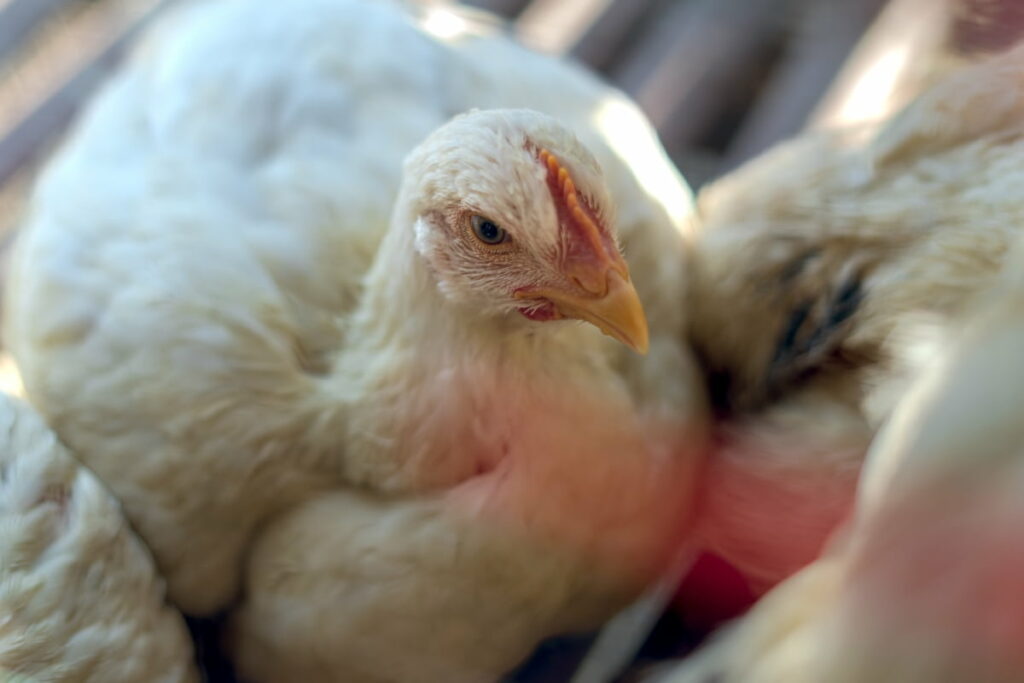
Selecting the best breed depends on your specific goals and production system. Verification from regulatory bodies ensures compliance with industry standards and good management practices. Moreover, sourcing high-quality broiler chickens through proper channels is essential for maximizing profitability.
To set up a successful 45-day chicken business plan for Broiler, you would need to allocate approximately Rs. 4,00,000 towards various expenses. The investment will go towards constructing or modifying a suitable housing facility for your broilers. Additionally, you may need to invest in equipment such as feeding troughs, waterers, heaters, or coolers. Other costs involved in setting up your business include obtaining permits and licenses required by local authorities to operate a poultry farm.
You will need to obtain a 45-day broiler chicken business license or permit from your local government authorities. This ensures that you are operating within the laws of your area and have met all necessary standards for running a poultry business. Additionally, you may also require permits for environmental compliance.
Another important aspect is obtaining health certificates for your birds. This involves regular inspections by veterinary officers to ensure that your flock is free from any diseases or infections. Furthermore, zoning restrictions may apply depending on where your farm is located.
Providing the right nutrition to your birds is essential to ensure that they reach weight gain and overall health. During the first week, broiler chickens should be given a starter feed with high protein content (around 22-24%) to support their rapid growth. This helps them develop strong muscles and bones.
From week two onwards, you can transition to a grower feed with slightly lower protein levels (18-20%). As they approach the final weeks, switching to a finisher feed containing around 16% protein will help maximize weight gains while minimizing fat accumulation. An optimal feeding program for 45-day broiler growth focuses on providing balanced nutrition tailored for each stage of development while closely monitoring weight gain patterns.
Restricted Access : Limiting access to the poultry farm is essential to prevent unauthorized entry and potential disease transmission. Visitors should follow strict protocols, such as wearing protective clothing and avoiding contact with birds.
Sanitation Practices : Regular cleaning and disinfection of poultry houses are vital for preventing the buildup of pathogens. Proper waste management, including disposing of litter properly, reduces disease risk.
Quarantine Procedures : Newly acquired birds should undergo quarantine before being introduced into the existing flock. This allows for an observation period to identify any signs of illness or infection.
Vaccination Programs : Following an appropriate vaccination schedule helps protect broilers against common diseases prevalent in their specific geographic region. These growth performance benchmarks for 45-day broilers help farmers measure the growth rate and overall health of their flock, ensuring optimal productivity and profitability.
An important aspect of sustainability is efficient resource use. This includes optimizing feed conversion ratios to minimize waste and reduce the environmental footprint. Feeding high-quality diets that are balanced with essential nutrients will promote healthy growth and minimize feed wastage. Disease management in a 45-day broiler operation is essential to implement proper biosecurity measures and follow good farming practices to minimize the risk of diseases spreading among the flock.
In case you missed it: Everything You Want to Know About Aseel Chicken Breed: From Egg Laying to Cockfighting
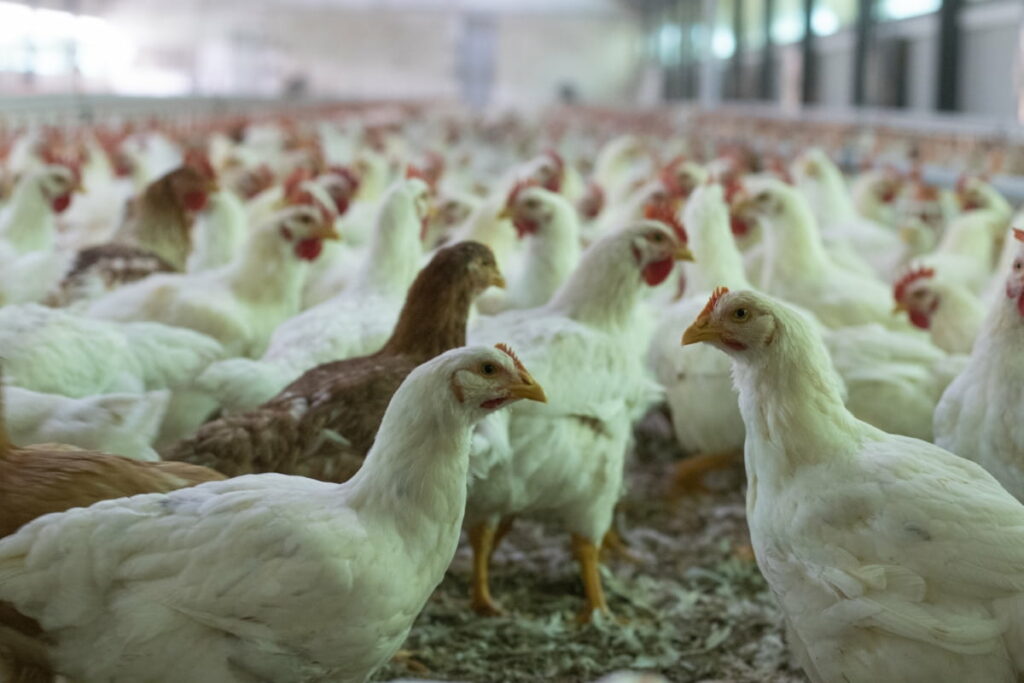
Another sustainable practice is proper waste management. Effective disposal methods for manure and other byproducts are necessary to prevent pollution and maintain clean surroundings for the birds. Implementing biosecurity measures is another key aspect of sustainable broiler farming.
During this period, it is important to closely monitor the health and growth of your broilers to ensure optimal results. Carefully watching their overall well-being is crucial. Regularly inspecting the birds for any signs of illness or distress can help identify potential issues early on.
Feeding plays a significant role in the growth of broilers during this 45-day cycle. Regular vaccination protocols should be followed to protect against diseases such as Newcastle disease and infectious bronchitis. It’s important to consult with a veterinarian who specializes in poultry health to develop an appropriate vaccination schedule.
Government support is crucial for the success of new businesses, including those in the broiler chicken industry. One common form of support is financial assistance, such as grants or loans with low-interest rates. These funds can be used for purchasing equipment, constructing housing facilities, or covering operational costs. Additionally, some governments offer tax incentives or exemptions to reduce the financial burden on these businesses.
Furthermore, government agencies may offer training programs and workshops to educate entrepreneurs about best practices in broiler farming. In certain regions, governments also collaborate with research institutions to develop improved technologies and breeding techniques that enhance broiler productivity. By implementing strict regulations, governments aim to protect both consumers’ health and animal welfare.
When it comes to the profit margin in a 45-day chicken business, various factors need to be taken into consideration. One such factor is the size of your operation. For instance, if you have a space of 1000 square meters and raise around 5000 chickens in this period, you have the potential to earn an impressive profit margin of Rs. 5,00,000.
It would help if you considered costs such as initial investment for infrastructure and equipment, permits and licenses required for operation, sourcing high-quality chickens, feed expenses, labor costs, and biosecurity measures for flock health maintenance and disease management.
In case you missed it: Dong Tao Chicken Breed: Origin, History, Appearance, Size, Characteristics, Eggs, Price, and Lifespan
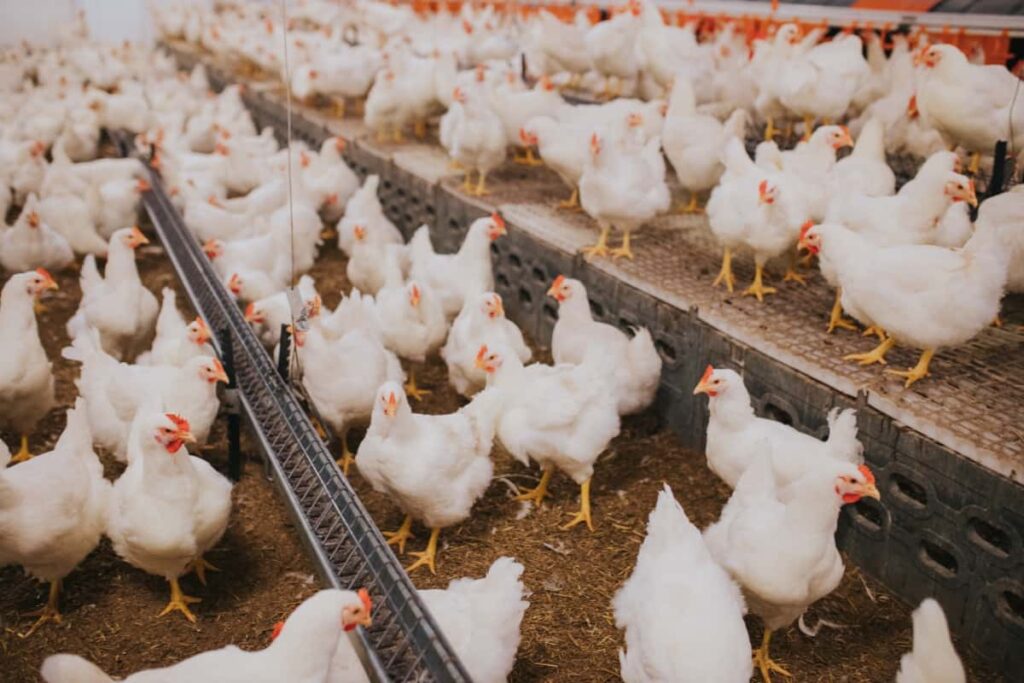
A 45-day chicken business plan helps you set clear goals and objectives. It outlines your target market, production targets, and financial projections. The aim of this business plan is not only to ensure healthy growth but also to streamline operations for increased productivity. The benefits of having a well-planned 45-day chicken business plan for Broiler are numerous and can greatly contribute to its success.
Crops Grown in Summer Season: Best Choices for Summer Gardening
Organic pest control for tomato farming, how to maximize sheep farming profit, broccoli varieties: choosing the right cultivars for your farm.
- How to Raise Pigs in Your Own Backyard: A Comprehensive Guide
Budget Friendly Sheep Shed Ideas: Cheap and Low-Cost Tips
- How Much Do Cattle Farmers Make: Revenue Streams in Cattle Farming
Management Pests and Diseases in Your Cotton Field
Sheep farming business plan for beginners, leave a reply cancel reply.
Save my name and email in this browser for the next time I comment.
How to Raise Pigs in Your Own Backyard: A Comprehensive...
How much do cattle farmers make: revenue streams in cattle..., aquaponic farming at home: a step-by-step guide, profitable village farming business ideas in 2024, high-yield aquaculture: fast-growing fish for farming, effective fish pond construction techniques for beginners, irrigation and water management in pineapple farming, blossom to harvest: mastering flowering and pollination in papaya farming, pig fattening essentials: from selection to sale for beginners, raising wagyu cattle: a complete guide for premium beef production, soil types and their water holding capacity, optimizing irrigation schedules for coconut groves for enhanced yield, espresso your garden: coffee grounds for healthier acid-loving plants, rice production in myanmar; paddy farming in myanmar, banana farming information guide, growing oats information for beginners, contract goat farming in india: how to earn an extra income from this long-term investment, chilli cultivation information guide, how to start and succeed with microgreens business plan.
Need a business plan? Call now:
Talk to our experts:
- Business Plan for Investors
- Bank/SBA Business Plan
- Operational/Strategic Planning
- L1 Visa Business Plan
- E1 Treaty Trader Visa Business Plan
- E2 Treaty Investor Visa Business Plan
- EB1 Business Plan
- EB2 Visa Business Plan
- EB5 Business Plan
- Innovator Founder Visa Business Plan
- UK Start-Up Visa Business Plan
- UK Expansion Worker Visa Business Plan
- Manitoba MPNP Visa Business Plan
- Start-Up Visa Business Plan
- Nova Scotia NSNP Visa Business Plan
- British Columbia BC PNP Visa Business Plan
- Self-Employed Visa Business Plan
- OINP Entrepreneur Stream Business Plan
- LMIA Owner Operator Business Plan
- ICT Work Permit Business Plan
- LMIA Mobility Program – C11 Entrepreneur Business Plan
- USMCA (ex-NAFTA) Business Plan
- Franchise Business Planning
- Landlord Business Plan
- Nonprofit Start-Up Business Plan
- USDA Business Plan
- Cannabis business plan
- eCommerce business plan
- Online Boutique Business Plan
- Mobile Application Business Plan
- Daycare business plan
- Restaurant business plan
- Food Delivery Business Plan
- Real Estate Business Plan
- Business Continuity Plan
- Buy Side Due Diligence Services
- ICO whitepaper
- ICO consulting services
- Confidential Information Memorandum
- Private Placement Memorandum
- Feasibility study
- Fractional CFO
- How it works
- Business Plan Examples
Poultry Farming Business Plan Sample
Published Oct.12, 2016
Updated Apr.23, 2024
By: Cynthia Turner
Average rating 4.2 / 5. Vote count: 6
No votes so far! Be the first to rate this post.
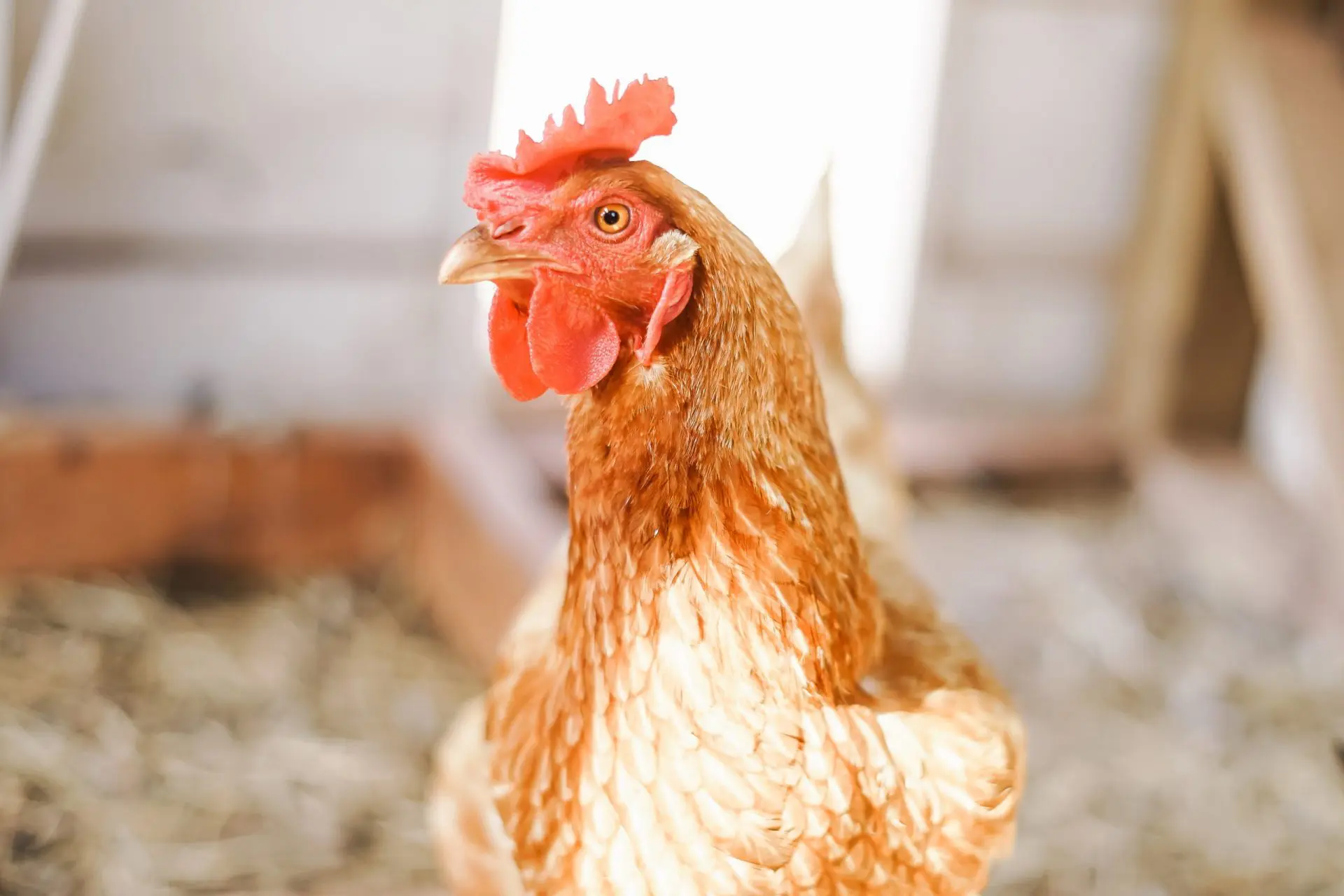
Table of Content
Do you want to start a Poultry Farming business plan?
Starting a business in the food sector requires an ambitious plan. For a poultry farm business, a good business plan for poultry farming will be needed to make it successful.
The primary step to starting this business is to learn how to write a business plan for poultry farming. You can go for food delivery service business plans if the major focus of your startup will be to deliver poultry products.
However, if you are looking to open a farming business in the poultry sector, reading an organic farm business plan or reading this example is a great start. Just like any other business, you will need to develop a solid business plan for a poultry farm. It can help you get required permits as well as investors in situations of need. Here, we will be presenting the business plan for Chuck’s Produce Farm.
Executive Summary
2.1 about the farm.
Chuck’s Produce Farm will be a poultry farm started by Henry Chuck. The primary objective of the business will be to provide poultry products such as chicken meat and eggs to supermarkets as well as nearby restaurants.
2.2 How will the Farm be Managed?
According to its Chicken Farming business plan , Chuck’s produce farm will be managed through a detailed plan. The business plan of the poultry farm will include management guides for all aspects of the business, from finances to operations. Henry read through many business plan poultry farming samples to ensure that his chicken poultry farm business plan address all the possible tricky aspects of the business.
In this business plan online template, we will show you how to make a poultry farm business plan for your business.
2.3 Customers of Poultry Farming Company
Our customers will primarily be other businesses to whom we will provide our products and services to be transferred to the general public. Thus, our main customer groups will include:
- Supermarket Chains
- Small Produce Businesses
- Food Factories
- Restaurants
2.4 Business Target
The target of Chuck’s Produce Farm will be to become the major supplier of poultry products to businesses in and around Dallas. The business will aim to gain at least a 60% share in the local market by the end of the second year.
The financial targets that the business is aiming to achieve are demonstrated below:
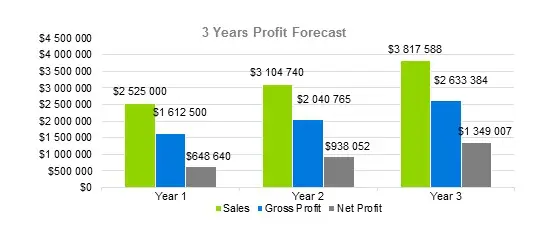
Company Summary
3.1 farm ownership & management.
Henry Chuck will be the owner and primary manager of Chuck’s Produce Farm. He studied biology and biochemistry as a student and then worked with many organizations to manage product dissemination operations. His father had a farm, and it was always his dream to make use of the farm to create an organic business.
3.2 Why is the Farm Being Started?
Henry noticed that with an increase in the consumption of food, especially poultry products, industries had started to resort to harmful chemicals just to meet demands. He wanted to change the narrative by providing organic and healthy poultry substitutes so that local people could consume poultry products without the added harm of chemicals.
3.3 Basic Steps to Start Poultry Farm Business
Step1: Refine Your Idea
The first step to the start of anything new is an idea. So, before Henry even thought about how to set up a poultry farm , he needed a basic business idea. Refining the idea before he developed a business plan on poultry farming was a great advantage as it helped him limit the scope of his planning.
Step2: Develop the Uniqueness
The next step before writing a poultry farming business plan is to develop the unique areas of your business. Henry used this step as a build-up of the idea. He knew the importance of marketable businesses and products, so he created a brand around the unique propositions of his farm.
Step3: Location Selection and Permits
Henry already had a location for starting Chuck’s Produce Farm. However, since one cannot start a commercial farm on a whim, he worked to get the required permissions from local authorities. This will allow him to run his business smoothly without any legal complications.
Step4: Online Presence
Since Henry’s business idea is focused on commercial customers instead of the public, so most of the orders will be in bulk. In order to manage such orders and keep up to date with customers and their demands, Henry decided to invest in the development of an online portal with which his customers could put in orders. Henry also decided to develop social media profiles for his business for a greater audience reach about organic products.
Step5: Follow the Plan
One cannot learn how to run a poultry business or any other business without dedicating research to a developed plan. After developing the business plan for poultry farm pdf, Henry will follow the guidelines to establish a sustainable farming business.
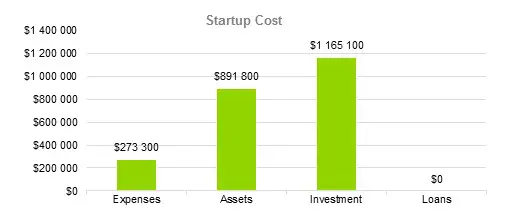
Services
When thinking about how start a poultry farming business , Henry zoned in on the services he would be providing to his customers. This helped him filter out what operations needed planning and which ones didn’t. To start a poultry farm business or any other business for that matter, a refined list of marketable products and services is needed. In his small scale poultry farming business plan, Henry decided to add all the services that his produce farm aimed to provide. To learn how to open a poultry farm, you can look at the list of services we are providing in this poultry farm business plan. You can also refer to a cattle farming business plan to understand what scale of services is best to start a business.
- Chicken and Turkey Products
The first set of products offered by Chuck’s Produce Farm will be chicken and turkey. We will offer clean meat that is processed in different ways. Our customers will be able to buy full chickens or turkeys ready for roast, boneless meat, and so on.
Chuck’s Produce Farm will also rear chickens for laying eggs. This will be an added facet to Henry’s pdf on poultry farming business plan. The farm will provide these eggs to our customers regularly at a wholesale price.
- Poultry Rearing Services
The farm will also aid other smaller poultry farms with proper rearing of poultry and chickens for both eggs and meat. In this regard, our farmers will give training sessions and tips to the locals.
- Chick Shipments
Our last service will be to provide chicks to poultry farms in other parts of the country. This is to promote the development and rearing of own meat and poultry in all parts of the country. This service will help in the sustainable consumption and rearing of poultry in the industry.
Marketing Analysis of Poultry Farming Company
Excellent work.
excellent work, competent advice. Alex is very friendly, great communication. 100% I recommend CGS capital. Thank you so much for your hard work!
Starting a poultry farm business requires the collection and use of a lot of information. No business can be started without knowing about your target market. Whether you are developing a dairy farm business plan or a business plan for a poultry farm pdf, you need to learn about the target market.
Therefore, Henry decided to do some research into the poultry farm industry when learning how to set up a poultry farm business. He learned that the business plan of poultry farming should include its products and services along with its unique propositions over the market. It should inquire into the previous trends and predicted future trends to invest in operations that are useful in figuring how to establish a poultry farm.
After looking into the industry, Henry knew the major trends which he decided to utilize in developing his business plan for poultry farm . Through these trends, Henry identified the target customers for his business as presented in the poultry farming business plan template below.
5.1 Market Trends
According to IBISWorld, chicken and turkey meat production has a market share of around $30 Billion in the United States alone. And according to Reportlinker’s “Poultry Global Market Report 2021: COVID-19 Impact and Recovery to 2030” report, the industry has a growth rate of 3.8%. This means there is significant room in the industry for another player like Chuck’s Produce Farms.
5.2 Marketing Segmentation
The target customers of Chuck’s Produce Farm are as follows:
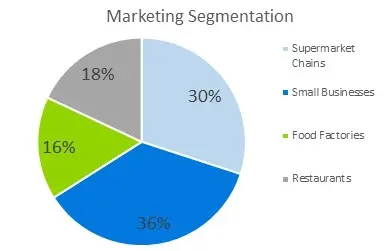
Business plan for investors
5.2.1 supermarket chains.
Our primary customers will be the supermarket chains in Dallas. We will provide the products for their meat and produce sections. We will also provide eggs and other meat options for these chains. Thus, they will be our indirect link to the public.
5.2.2 Small Produce Businesses
The second set of customers we expect to serve will be small produce businesses. Smaller businesses have a harder time setting up their operations and properly rearing poultry. Thus, Chuck’s Produce Farm will offer training and shadowing services to these new businesses to promote the production of poultry on a local scale.
5.2.3 Food Factories
Our third target group of customers will be food factories in the nearby areas that need poultry like chicken and turkey along with eggs to create their products. We expect to have contracts with quite a few of these factories.
5.2.4 Restaurants
Our final target group will be restaurants in Dallas. Usually, restaurants look for the wholesale rate of poultry products to save expenses. Therefore, Chuck’s Produce Farm will reach out to many restaurants for an exclusive contract to supply organic poultry products.
5.3 Business Target
- To achieve the status as the best organic poultry farm in Dallas.
- Promote the production of clean poultry products across the country.
- To provide chemical-free meat and poultry products to our customers.
- To increase the preference for organic, chemical-free poultry over regular one.
5.4 Product Pricing
Since our products have to compete with industrial products at a commercial level, our prices will be similar to the market competitors. However, at the same price, we will be providing chemical-free products that can be checked for health benefits against competing products.
Marketing Strategy
To write a business plan on poultry farming, Henry ventured to search for his target market. This allowed him to develop a business plan sample for poultry farm that could focus on marketing for these particular customers.
A marketing plan is an essential element of a farming poultry business plan. In fact, it is a very important part of every business plan, whether it is a pig farm business plan or a broiler poultry farming business plan.
Therefore, in this business plan, we are presenting the marketing plan and strategies for Chuck’s Produce Farm.
6.1 Competitive Analysis
- We will provide meat that is free of chemicals usually used to increase the growth rate or size.
- We will offer organic products that stem from proper poultry grooming.
- We will aid local poultry farms and focus on a helping business model.
- We will use organic and eco-friendly feed and products that harm neither the poultry nor its consumers.
6.2 Sales Strategy
- We will offer organic products as compared to the chemically treated ones in the market.
- We will reach contracts with local restaurants and businesses.
- We will advertise through word of mouth and local training and guide sessions held throughout Dallas.
[get_in_touch_small text=”Any questions?” bold=’Get in Touch’]
6.3 sales monthly.
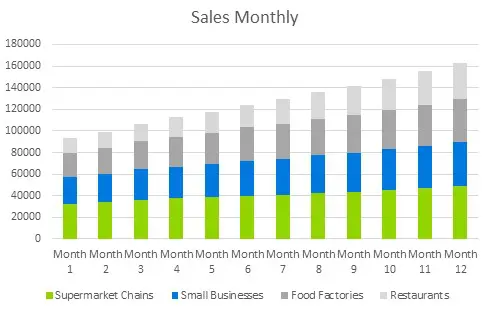
6.4 Sales Yearly
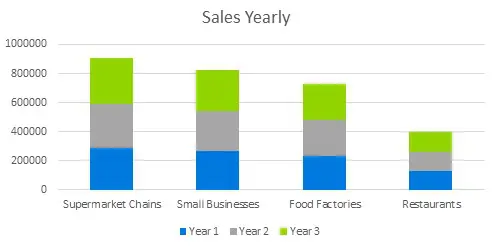
6.5 Sales Forecast
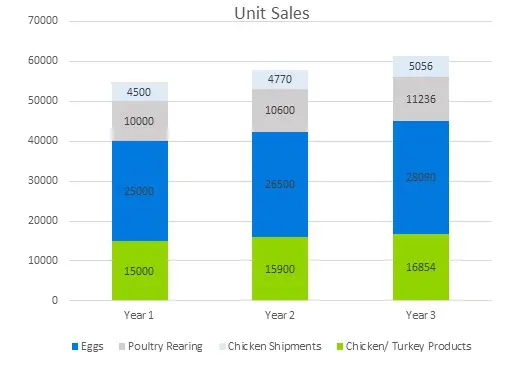
Personnel plan
If you have hen business ideas or something of the like, you may be trying to learn how to start a small poultry farm. Henry had the idea of an organic farm business plan which is how he developed the idea of Chuck’s Produce Farm. To ensure the success of his business, Henry added an employee section in his business plan for a poultry farm . The workforce needed to start Chuck’s Produce Farm can be found below for reference.
7.1 Company Staff
- 1 Co-Manager to help in overall operations
- 10 Trained Poultry Farmers
- 2 Vets
- 8 General Cleaners
- 1 Technician to maintain machines
- 3 Sales and Marketing Executives
- 1 Accountant
7.2 Average Salary of Employees
Financial plan.
Starting a poultry farm requires much more than a food idea. It requires consistent effort and planning to maintain the business. In order to develop a successful business plan for poultry farming, Henry put in a significant amount of effort in the financial analysis section.
To start and run a sustainable business, Henry planned out the costs for different operations of the farm along with expected sales and product prices. This kind of financial analysis is necessary for every business plan, may it be a goat farming business plan . For making a financial plan for your startup, you can follow the example below for guidance.
8.1 Important Assumptions
8.2 break-even analysis.
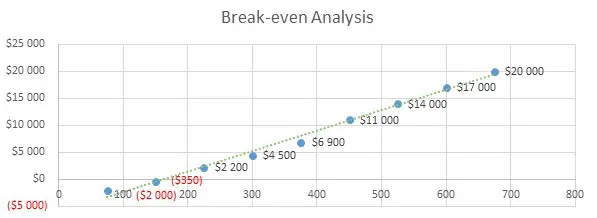
8.3 Projected Profit and Loss
8.3.1 profit monthly.
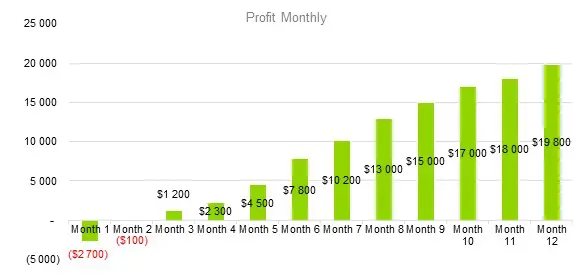
8.3.2 Profit Yearly
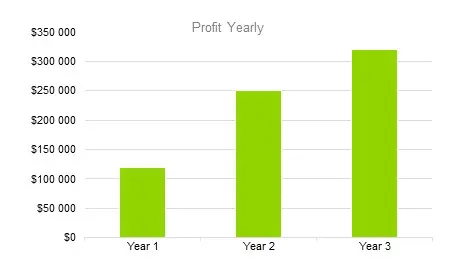
8.3.3 Gross Margin Monthly
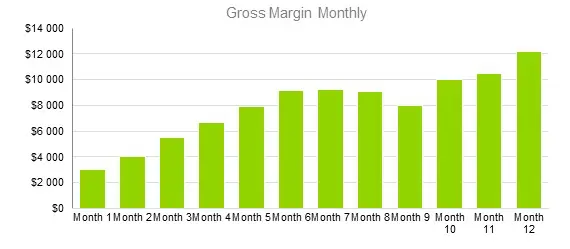
8.3.4 Gross Margin Yearly
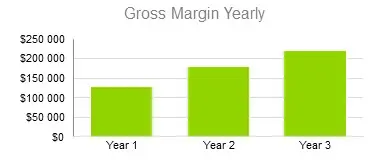
8.4 Projected Cash Flow
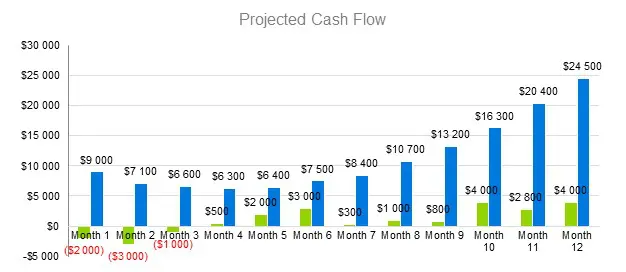
8.5 Projected Balance Sheet
8.6 business ratios.
- How do I start a poultry farm business plan?
You can start chicken farm by looking at poultry farming business ideas and developing a good business plan like the one above.
- How much profit does a poultry farm make?
According to ChickenFeedMachinery, a poultry farmer can make up to $2000/month for 300 egg-laying chickens, but it varies from one type of business to the next.
- Is poultry farming a profitable business?
A poultry farming business can be highly profitable if you have a commercial poultry farm business plan like the one shown above.
- Which poultry is most profitable?
The success of a poultry business depends more on its management than its type. So, you can download a poultry farm business plan like the one above to sharpen those skills.
Download Poultry Farm Business Plan Sample in pdf
OGSCapital’s team has assisted thousands of entrepreneurs with top-rate business plan development, consultancy and analysis. They’ve helped thousands of SME owners secure more than $1.5 billion in funding, and they can do the same for you.

How to Start a Plumbing Business in 2024: A Detailed Guide

Vegetable Farming Business Plan

Trading Business Plan

How To Write A Textile Manufacturing Business Plan

Start a Vending Machine Business in 2024: A Detailed Guide

Oil and Gas Business Plan

Any questions? Get in Touch!
We have been mentioned in the press:
Leave a Reply Cancel reply
Your email address will not be published. Required fields are marked *
Save my name, email, and website in this browser for the next time I comment.
Search the site:

No products in the cart.
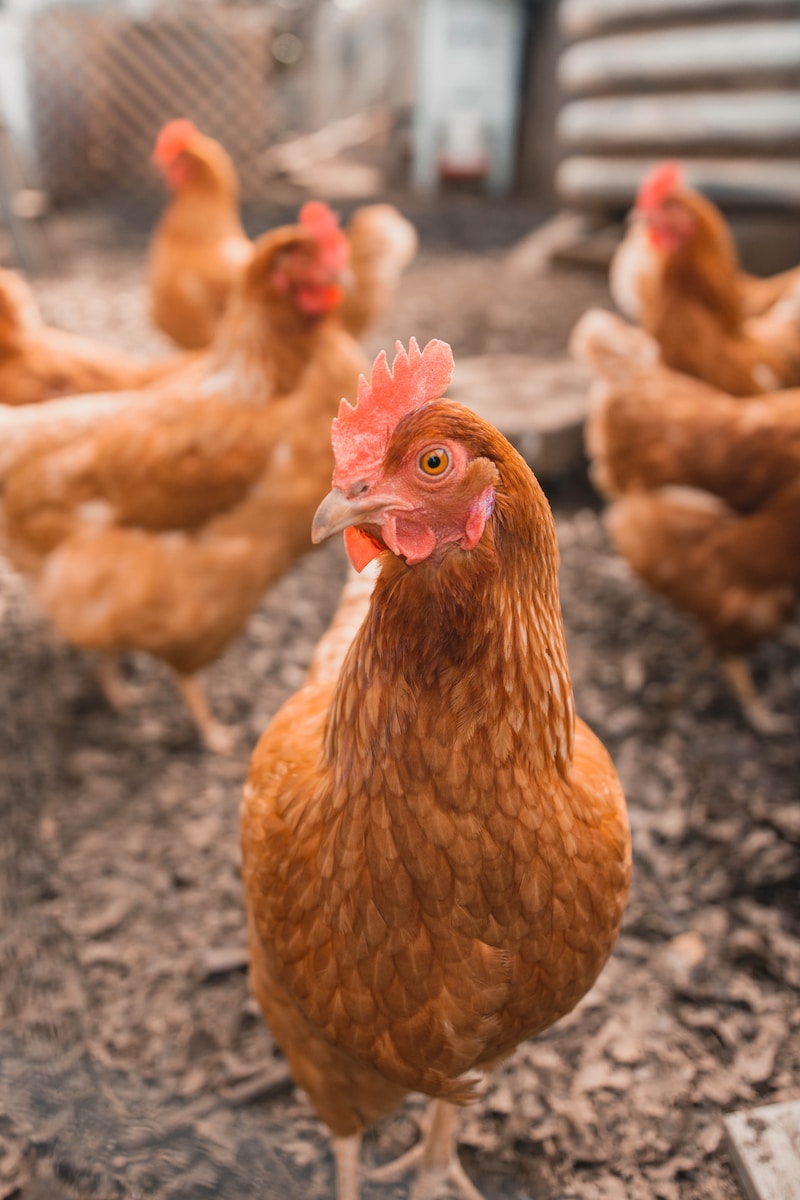
Chicken Farming Business Plan: How to Start a Profitable Poultry Farm in Kenya
Are you looking for a lucrative business opportunity in Kenya? Do you love raising chickens and want to turn your passion into a profitable venture? If yes, then you need a chicken farming business plan.
A chicken farming business plan is a document that outlines the goals, strategies, and financial projections of your poultry farm. It helps you to plan ahead, secure funding, and avoid common pitfalls. A chicken farming business plan also serves as a guide for your day-to-day operations, marketing, and management.
In this article, we will show you how to write a chicken farming business plan that covers all the essential aspects of starting and running a successful poultry farm in Kenya. We will also provide you with a sample chicken farming business plan template that you can download and customize for your own use.
By the end of this article, you will have a clear idea of how to start a profitable poultry farm in Kenya, and what steps you need to take to achieve your goals. Let’s get started!
Benefits of Poultry Farming Business
Poultry farming offers numerous benefits, making it a profitable and rewarding business venture for those who manage it effectively. One of the key advantages of poultry farming is the high demand for poultry products. Whether it’s chicken meat or eggs, there’s always a profitable market for these products.
Chickens also have a fast reproduction and growth rate, resulting in high productivity. A healthy layer chicken, for example, can lay up to 325 eggs in a year. Moreover, selling fully grown healthy chickens can earn you a profit of $10 to $11 per bird, while poultry eggs can be sold for $2 to $3 per crate, with each crate containing 30 eggs.
With 500 layers producing 12,000 eggs per month, a poultry farmer can make a profit of $1,500 per month. These numbers demonstrate the financial potential of a well-managed poultry farming business.
Profitability of Poultry Farming
Starting a poultry farming business can be highly profitable if managed effectively and with careful consideration of market demand and cost-efficiency. The demand for poultry products, such as chicken meat and eggs, is consistently high, making it a lucrative industry to venture into. Chickens have a fast reproduction and growth rate, resulting in high productivity.
A healthy layer chicken can lay up to 325 eggs in a year. Selling fully grown healthy chickens can earn a profit of $10 to $11 per bird. Poultry eggs can be sold for $2 to $3 per crate, with each crate containing 30 eggs. With 500 layers producing 12,000 eggs per month, a poultry farmer can make $1,500 per month.
However, it’s important to consider various factors such as selecting the right type of poultry bird, cage type, area of interest, location, and investment capital. With careful planning and proper management, poultry farming can indeed be a profitable business venture.
Demand for Poultry Products
The high demand for poultry products, such as chicken meat and eggs, creates a profitable market opportunity for poultry farmers. Poultry products are widely consumed and sought after by consumers globally due to their versatility and nutritional benefits. Chicken meat is a popular source of lean protein, while eggs are a staple in many households for their high protein content and versatility in cooking. This high demand ensures a consistent market for poultry farmers, allowing them to generate steady income and maximize their profitability.
The demand for poultry products is driven by various factors, including population growth, changing dietary preferences, and increasing health consciousness among consumers. As the global population continues to rise, the demand for protein-rich foods, such as chicken meat and eggs, is expected to increase. Additionally, as consumers become more health-conscious, they’re choosing poultry products as a healthier alternative to red meat.
The profitability of the poultry farming business is further enhanced by the relatively low production costs and fast growth rate of chickens. Chickens have a short reproduction cycle, allowing farmers to quickly replenish their flocks and meet the growing demand. Moreover, the market prices for chicken meat and eggs are generally favorable, providing poultry farmers with the opportunity to generate significant profits.
Reproduction and Growth Rate of Chickens
With the high demand for poultry products and the profitability of the poultry farming business, it’s important to understand the reproduction and growth rate of chickens. Chickens have a relatively fast reproduction and growth rate, which contributes to their high productivity.
A healthy layer chicken is capable of laying up to 325 eggs in a year. This means that with a flock of 500 layers, a poultry farmer can expect to produce around 12,000 eggs per month. Selling these eggs at a market price of $2 to $3 per crate, which typically contains 30 eggs, can generate a monthly income of approximately $1,500.
Additionally, fully-grown healthy chickens can be sold for a profit of $10 to $11 per bird. Understanding the reproductive cycle and growth rate of chickens is crucial for proper management and planning in the poultry farming business.
It allows farmers to optimize their production and ensure a steady supply of poultry products to meet the market demand.
Profitability of Chicken Meat and Eggs
Chicken meat and eggs are highly profitable products in the poultry farming business, with a steady market demand and attractive market prices. The poultry industry offers great opportunities for financial success. Selling fully grown healthy chickens can earn you a profit of $10 to $11 per bird.
Additionally, poultry eggs can be sold for $2 to $3 per crate, with each crate containing 30 eggs. A healthy layer chicken can lay up to 325 eggs in a year. By having 500 layers producing 12,000 eggs per month, you can make $1,500 per month. This demonstrates the potential profitability of poultry farming.
The high demand for chicken meat and eggs ensures a consistent market, allowing you to easily sell your products and generate a steady income. The market prices for these poultry products are favorable, which further contributes to the profitability of the business. With proper management practices, such as vaccination and disease prevention, you can maximize your profits and maintain a healthy flock.
Productivity of Layer Chickens
Layer chickens, known for their high egg production capacity, are an essential component of a successful poultry farming business. These chickens are specifically bred and raised for their ability to lay a large number of eggs consistently. The productivity of layer chickens is measured by the number of eggs they can produce in a given period of time. On average, a healthy layer chicken can lay up to 325 eggs in a year. This high level of productivity makes layer chickens a valuable asset for poultry farmers.
The profitability of a poultry farming business heavily relies on the productivity of the layer chickens. With 500 layers producing 12,000 eggs per month, a poultry farmer can make around $1,500 per month by selling the eggs alone. Additionally, selling fully grown healthy layer chickens can earn a profit of $10 to $11 per bird. Therefore, it’s crucial for poultry farmers to focus on maximizing the productivity of their layer chickens through proper management practices.
To ensure high productivity, poultry farmers should provide their layer chickens with a clean and comfortable living environment, a balanced diet, and regular vaccinations. They should also monitor the health of the chickens and protect them from predators. By implementing these measures, poultry farmers can enhance the productivity of their layer chickens and ultimately increase the profitability of their business.
Profit From Selling Fully Grown Chickens
To maximize your profits in the poultry farming business, it’s essential to understand the potential income from selling fully grown chickens. Selling fully grown chickens can be a lucrative venture, as the demand for chicken meat is high in the market. On average, a healthy fully grown chicken can be sold for a profit of $10 to $11 per bird. This means that if you have a large number of fully grown chickens ready for sale, you can earn a significant amount of money.
Additionally, selling eggs from your fully grown layer chickens can also contribute to your profits. Poultry eggs can be sold for a price of $2 to $3 per crate, with each crate containing 30 eggs. With 500 layers producing 12,000 eggs per month, you can make approximately $1,500 per month from selling eggs alone.
Profit From Selling Poultry Eggs
Maximizing profits in the poultry farming business involves understanding the potential income from selling poultry eggs. Poultry eggs are a valuable commodity, with a strong market demand and a favorable market price. By selling poultry eggs, you can generate a steady stream of income for your poultry farm.
A healthy layer chicken can lay up to 325 eggs in a year. These eggs can be sold for $2 to $3 per crate, with each crate containing 30 eggs. With 500 layers producing 12,000 eggs per month, you can make $1,500 per month just from selling poultry eggs.
To ensure maximum profitability, it’s important to focus on the quality of your eggs. Customers are willing to pay a premium for fresh, clean, and well-packaged eggs. Implementing proper egg handling and storage practices will help maintain the quality of your eggs and attract more customers.
Additionally, diversifying your product offerings can further increase your profits. You can consider selling specialty eggs, such as organic or free-range eggs, which often command a higher price in the market.
Monthly Income From 500 Layers
By focusing on the potential income from selling poultry eggs, you can generate a steady stream of monthly income from 500 layers on your poultry farm.
With each layer chicken capable of laying up to 325 eggs in a year, your 500 layers can produce a total of 162,500 eggs annually.
Considering that poultry eggs can be sold for $2 to $3 per crate, and each crate contains 30 eggs, you can earn a substantial monthly income.
With 500 layers producing 12,000 eggs per month, you can potentially make $1,500 per month from egg sales alone.
This income can provide you with a stable financial foundation and help you cover your operational costs, such as feed, vaccinations, and maintenance expenses.
It’s important to note that the profitability of your poultry farm will also depend on factors such as market demand, competition, and the overall health and productivity of your layers.
Key Considerations Before Starting
Before you start your poultry farming business, there are several key considerations that you should take into account.
First, you need to select the type of poultry bird and cage type based on your preference and cost-efficiency. Consider whether you want to focus on breeding, hatchery, or feed production in the poultry farming industry.
Additionally, choose a suitable location for your poultry farm with easy access to transportation. The location should also be affordable and have a good population for consumption.
Another important consideration is planning and managing your investment capital based on the scale of your poultry farming business. Determine the amount of capital you’re willing to invest and create a budget accordingly.
Selecting Poultry Bird and Cage Type
When starting a poultry farming business, one of the important decisions you need to make is selecting the type of poultry bird and cage type that best suits your preferences and cost-efficiency.
The type of bird you choose will depend on your area of interest in poultry farming, whether it’s meat production or egg production. For meat production, broilers are a suitable choice as they grow quickly and have high meat yields. If you’re interested in egg production, layers are the preferred option as they’ve a high egg-laying capacity.
In addition to selecting the type of bird, you also need to consider the cage type. There are different housing systems available, such as extensive, semi-intensive, deep-litter, slatted, and battery-caged systems. Each system has its own advantages and considerations. For example, extensive and semi-intensive systems allow birds to roam freely, while deep-litter systems provide easy access to feed and eggs. Slatted or wired housing systems are smaller and can be easier to manage, while battery-caged systems are efficient for egg production but can be more expensive.
Ultimately, your choice of poultry bird and cage type should be based on your specific goals, budget, and the resources available to you. By carefully considering these factors, you can ensure that your poultry farming business is set up for success.
Area of Interest in Poultry Farming
To determine your area of interest in poultry farming, consider the specific aspect of the industry that aligns with your skills, resources, and goals. Poultry farming offers a range of opportunities, including breeding, hatchery, or feed production.
Breeding involves selecting and raising birds for specific traits, such as egg production or meat quality. This area requires a good understanding of genetics and breeding techniques.
Hatchery operations focus on the incubation and hatching of eggs, ensuring the healthy development of chicks. If you have experience in managing incubators and providing optimal conditions for egg development, this may be the right area for you.
Another area of interest is feed production, where you can formulate and produce nutritious feed for your poultry. This requires knowledge of animal nutrition and access to quality feed ingredients.
Choosing a Suitable Location
Finding the perfect location is crucial for the success of your poultry farm, as it will determine factors such as accessibility, market proximity, and affordability of land.
When choosing a suitable location for your chicken farm, consider the accessibility of the area. You want to ensure that transportation is convenient, allowing for easy movement of supplies and products.
Proximity to the market area is also important, as it reduces transportation costs and ensures a steady demand for your poultry products.
Additionally, take into account the affordability of the land. Look for areas where the cost of land is reasonable and fits within your budget.
Conduct thorough research and consider consulting with experts or local poultry farmers to gather valuable insights about potential locations.
Planning Investment Capital
Now that you have chosen a suitable location for your poultry farm, it’s important to focus on planning your investment capital to ensure the success and profitability of your business.
Determining the amount of capital required will depend on the scale of your poultry farming operation. Whether you’re starting a small-scale, medium-scale, or large-scale farm, it’s crucial to have a well-thought-out financial plan in place.
To begin, you need to estimate the costs involved in setting up your poultry farm. This includes purchasing land, constructing housing systems, buying chicken cages, acquiring day-old chicks, and investing in necessary equipment. Additionally, you should consider the expenses related to feed, vaccinations, labor, and other operational costs.
Once you have determined your capital requirements, you can explore various sources of financing. This may include personal savings, loans from financial institutions, or partnerships with investors. It’s important to carefully evaluate your options and choose the most suitable financing method for your business.
Furthermore, having a detailed budget and regularly reviewing your financial performance will help you track your expenses and revenues. This will enable you to make informed decisions and adjust your operations accordingly.
Steps to Start Poultry Farming
Once you have planned your investment capital, you can take the next steps to start your poultry farming business.
The first step is to buy a suitable land in a remote area with good transportation. This ensures that your poultry farm is easily accessible for both supplies and distribution.
After acquiring the land, you need to build the necessary structures, such as housing systems, to ensure the safety and profitability of your chickens. It’s important to invest in appropriate chicken cages to provide a comfortable living environment for your birds.
Once the infrastructure is in place, you can purchase day-old chicks from a reliable hatchery. Proper management practices, including vaccination and disease prevention, are crucial for the health and well-being of your chickens.
Following these steps will set you on the path to starting a successful poultry farming business.
Buying Suitable Land
To begin your poultry farming business, the first step is to acquire a suitable plot of land in a remote area with good transportation access.
Finding the right land is crucial for the success of your chicken farm. Look for a location that’s away from residential areas to minimize the impact of noise and odor on nearby communities. The land should have ample space to accommodate the necessary structures, such as housing systems and storage facilities.
Additionally, ensure that the land has access to reliable transportation routes, as this will facilitate the movement of supplies and products. Consider the proximity to markets as well, as it can reduce transportation costs and improve the efficiency of your operations.
Take into account the cost of the land and evaluate its affordability in relation to your budget. Conduct thorough research and visit potential sites to assess the soil quality, availability of utilities, and overall suitability for poultry farming.
Building Required Structures
You will need to construct the necessary structures for your poultry farm to ensure the safety and profitability of your chickens.
The primary structure you’ll need is a housing system for your chickens. There are different types of housing systems to choose from, such as extensive, semi-intensive, deep-litter, slatted, and battery-caged systems. Each system has its advantages and disadvantages, so it’s important to choose the one that best suits your needs and budget.
Additionally, you’ll need to invest in equipment such as feeders, nests, incubators, heaters, and egg trays to ensure the proper care and management of your chickens.
These structures and equipment will provide a clean and comfortable environment for your chickens, promote their health and well-being, and facilitate efficient feeding and egg collection.
Purchasing Chicken Cages
When purchasing chicken cages for your poultry farm, it’s important to consider the size, quality, and design of the cages to ensure the comfort and productivity of your chickens.
The size of the cages should provide enough space for the chickens to move around and stretch their wings, as overcrowding can lead to stress and decreased egg production.
The quality of the cages is crucial for their durability and longevity. Look for cages made of sturdy materials that can withstand the wear and tear of daily use.
Additionally, consider the design of the cages. Opt for cages with easy access to feeders and waterers, as well as removable trays for convenient cleaning. Good ventilation is also important to maintain a healthy environment for the chickens.
Take into account the specific needs of your flock, such as the number of chickens and their breed, to determine the appropriate size and design of the cages.
Buying Day-Old Chicks
When purchasing day-old chicks for your poultry farm, it’s important to consider the breed and health of the chicks to ensure a successful start to your flock.
The breed of the chicks will determine their growth rate, egg-laying potential, and overall suitability for your farming goals. It’s crucial to research and select a breed that aligns with your specific needs and market demand.
Additionally, the health of the chicks is of utmost importance. Look for a reputable hatchery that follows strict biosecurity measures and provides vaccinations to prevent the spread of diseases. Inspect the chicks carefully for any signs of illness or deformities before making a purchase. Healthy chicks will have bright eyes, active behavior, and clean feathers.
Proper Management Practices
Implementing proper management practices is essential for the success and profitability of your poultry farming business. Managing your chicken farm efficiently will help ensure the health and productivity of your birds, as well as maximize your profits.
One important aspect of proper management is maintaining a clean and comfortable environment for your chickens. This includes providing adequate ventilation and temperature control, as well as regular cleaning and disinfection of the coop.
It’s also crucial to monitor the health of your chickens and implement a vaccination program to prevent disease outbreaks. Additionally, practicing good hygiene, providing a balanced diet, and protecting your chickens from predators are all important management practices.
As your poultry farm grows, it’s important to continuously evaluate and improve your farming practices. This includes expanding your flock based on market demand, exploring new market opportunities, and diversifying your product offerings.
Implementing sustainable and environmentally friendly practices, investing in technology and automation, and developing a strong brand identity and marketing strategy are also key management practices.
Importance of a Poultry Farming Business Plan
To ensure the success and profitability of your poultry farming business, it’s crucial to have a well-structured and thought-out poultry farming business plan in place.
A business plan serves as a roadmap for your business, helping you understand your current position and set goals. It includes important considerations such as selecting the type of poultry bird, cage type, area of interest, location, and investment capital.
By having a well-planned business strategy in place, you increase the chances of success and profitability in your poultry farming venture. Implementing your poultry farming business plan is crucial for achieving the desired results and overcoming challenges such as lack of government support, high starting capital, disease outbreaks, and market competition.
A poultry farming business plan also acts as a tool to attract investors and secure financing for your business. Therefore, investing time and effort into creating a comprehensive business plan is essential for the long-term success of your poultry farming business.
Understanding Current Position and Goals
Understanding your current position and goals is essential for the success of your poultry farming business. By evaluating your current position, you can identify strengths and weaknesses, allowing you to make informed decisions and develop strategies for improvement. Assessing your goals helps you determine the direction you want to take your business in and sets a clear path for achieving success.
To understand your current position, you need to examine various aspects of your poultry farming business. This includes evaluating your financial standing, market position, production capacity, and operational efficiency. By analyzing these factors, you can identify areas that need improvement and areas where you excel.
Setting goals is equally important as it provides a roadmap for your business. Your goals should be specific, measurable, attainable, relevant, and time-bound (SMART). They should align with your long-term vision and help you stay focused and motivated. Whether your goals include increasing production, expanding market reach, improving profitability, or implementing sustainable practices, they should be realistic and achievable.
Business Strategy for Success
Developing a strong and effective business strategy is essential for ensuring the success and profitability of your poultry farming business. A well-planned strategy will guide you in making informed decisions, staying competitive in the market, and achieving your business goals.
To create a successful strategy, you need to consider various factors such as market demand, competition, operational efficiency, and financial management. Firstly, you should conduct extensive market research to understand the demand for poultry products, identify your target customers, and analyze the competition. This will help you determine your unique selling proposition and develop marketing strategies to attract and retain customers.
Additionally, you should focus on optimizing your operational efficiency by implementing effective farming practices, utilizing technology and automation, and ensuring proper management of resources. Financial management is also crucial, including budgeting, monitoring expenses, and seeking financial assistance if needed.
Implementing the Business Plan
Now that you have developed a comprehensive business plan for your poultry farming business, it’s time to put it into action.
Implementing your business plan is crucial for achieving the desired results and ensuring the success and profitability of your venture.
Start by buying a suitable land in a remote area with good transportation. Build the necessary structures, such as housing systems, to ensure the safety and profitability of your chickens.
Purchase appropriate chicken cages and buy day-old chicks from a reliable hatchery. Follow proper management practices, including vaccination and disease prevention, to ensure the health and well-being of your poultry.
Continuously evaluate and improve your farming practices, expanding your flock based on market demand and exploring new market opportunities.
Develop a strong brand identity and marketing strategy, engaging with customers through social media and other channels.
Monitor your financial performance, create a budget, and seek financial assistance or grants if needed. Stay informed about tax regulations and evaluate and optimize your financial performance.
Challenges in Poultry Farming Business
Running a poultry farming business comes with its fair share of challenges that need to be addressed in order to ensure success and profitability. One of the challenges is the lack of government support, which often requires you to run the business independently.
Additionally, starting a poultry farm requires a high initial capital investment, which can be a barrier for some individuals. Disease outbreaks can also pose a significant challenge, as maintaining a clean and disease-free environment is crucial for the health and productivity of the chickens. This includes implementing proper vaccination protocols and regularly monitoring the flock for any signs of illness.
Furthermore, the cost of vaccinations and poultry feed can be quite high, affecting the overall profitability of the business. Market competition, maintaining product quality, managing labor, and staying updated with industry regulations are additional challenges that poultry farmers may face.
Overcoming these challenges requires careful planning, effective management strategies, and continuous adaptation to market conditions.
In conclusion, starting a chicken farming business can be a lucrative venture with high demand for poultry products. By understanding the reproduction and growth rate of chickens and implementing a well-planned business strategy, you can achieve profitability in this industry.
However, it’s important to be aware of the challenges you may face and how to overcome them. With the knowledge and insights gained from this article, you’re now equipped to make informed decisions and succeed in the world of chicken farming.
Similar Posts

Which Farming Is Most Profitable In Kenya
When it comes to farming in Kenya, there are a variety of options available. But which one is the most…

Sheep Farming in Kenya
Sheep farming in Kenya has transformed the lives of many individuals, providing them with a profitable and fulfilling business opportunity…
Leave a Reply Cancel reply
Your email address will not be published. Required fields are marked *
Save my name, email, and website in this browser for the next time I comment.

- Business Ideas
- Business Plans
- Business Tips
- Business News
- Entrepreneur Profiles
- Entrepreneur Interviews
- Terms and Conditions
- Refund Policy
- Whatsapp Subscription
Select Page
How to start a Broiler Chicken production business in Zimbabwe and the business plan
Posted by StartupBiz Zimbabwe | Jan 31, 2015 | Agriculture Industry , Business Ideas , Business Plans , Starting a Business | 59
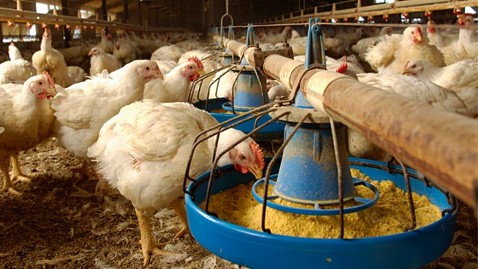
Raising broiler chickens is becoming more popular in Zimbabwe, as people try to find extra income amid the growing economic challenges and high unemployment levels in the country. Many have lost hopes of ever getting jobs in the formal sector, and have started different types of income generating projects.
Broiler chicken farming business in Zimbabwe can be very profitable if it is properly run under acceptable methods and conditions conducive for the chicken production, good management and a good business plan.
Before you start a broiler production business, you have to decide how many chickens you want to keep, where you are going keep them, and your target market. The number of birds you keep will depend on the amount of land and capital you have, and also the size of your target market. You should always carry out a feasibility study, market research and write a business plan before you venture into any business. Do not make the mistake of starting a broiler business or any other business just because someone is doing it and he/she says it’s profitable.
What you need
Land, Housing and Equipment
This is a very important factor to consider. It will determine whether you succeed or not in the poultry business. The kind of housing you need and the size of the land will depend on the size of your poultry project. An ideal poultry farm should be sited where there’s a large availability of cheap land and at the same time should be close to your market. Broilers cannot adjust well to temperature extremes, so it is very important that chickens be housed, cared and provided with an environment that will enable them to maintain their thermal balance. The right housing should have proper ventilation and the right lighting. The length of the broiler house should run from east to west to prevent direct sunlight. Birds need a certain minimum space and convenient place to grow well, otherwise if the space is not enough they may suffocate to death, which will be a great loss to your business. You should allow 0.1 square metres per bird. Your housing can be barns, chicken runs or hutches. The cost of construction depends on the size. You should have equipment including feeders, drinkers, lighting system and waste disposal system.
Day old chicks
The mortality rate of the broilers, their growth and weight will depend on the brand of day old chicks which you buy. Some brands grow slower, and have a high mortality rate. You should make your own research on which brand to buy, not to just buy the cheapest ones, as that will cost you. Enquire from those who are already in the broiler business. Ask the companies if they offer any guarantee on their day old chicks. Some companies will replace your chicks if they die and if you have any problems with the chicks, you can return them and you will given new chicks. The popular day old chicks’ providers in Zimbabwe include Irvines, Hubbard,Chinyika and Novatek.
Stock feeds
The profitability of the broiler chicken farming business depends on minimizing the mortality rates and optimizing the target weight of the birds. Broiler diets are formulated to provide the protein, energy, vitamins and other nutrients essential for health and efficient broiler production. So the type of feeds you choose will determine the success of your business. On average, by the time a bird reaches 6 weeks, it should have consumed a total of 4kg of broiler feeds. Six weeks is the age at which most broilers are sold, and they will be having an average live weight of between 2.2kg to 2.4kg, depending on management, breed, age and uniformity. About 70% of your expenses will go towards poultry feeding. You will also need proper vaccines and medications to prevent diseases and promote growth of your broilers.
For large scale broiler production, you can produce the feeds by yourself. You will have to learn how to make broiler feeds, and purchase the necessary equipment, and this will cut your feeding costs. For small scale broiler production, it is better to buy already-made broiler feeds. You can buy stock feeds which are complete such that you give them to your birds without adding anything. For those with access to cheap home grown maize, you can buy broiler concentrate feeds. You will then mix the broiler concentrate with maize meal, according to the ratio specified on the concentrate feed packet. This will lead to lower feeding costs, while providing all the necessary nutrients required by the birds.
You have to carry out a research concerning which brand to buy, as there are many broiler feeds brands in the market. The type of feeds you choose will determine the growth rate, health, and weight of your birds. You will have to feed the birds according to the specific instructions on the packet of the feed, otherwise your birds may die. The popular brands of broiler feeds in Zimbabwe include Pro feeds, AgriFoods, Feedmix and National foods.
Management and Labour
The number of staff you will need depends on the size of your poultry farming project. If you are keeping 50 birds at the back of your house you may not need an employee as you and your family will take care of the birds. On the other hand, if you have a poultry farm you will need dedicated staff to look after the birds, and to manage the business. You need good management skills and technical knowledge of broiler rearing techniques if you want to be profitable. Do your research, and train those who are working for you.
The amount of capital you need will depend on the scale of your project, location of your farm, and the type of management technology you are using.
With so many people eating chicken, and the country importing hundreds of millions dollars worth of chicken every year, you do not have to be a graduate to figure out that there is a huge demand for chickens in Zimbabwe. Before you start the broiler chicken business, you should define the market you are targeting. For small scale broiler production, you can sell to those in your neighborhood, by simply putting a ‘Chicken for sale’ sign at your gate. For medium to large scale broiler chicken production, you can target households, butchers, schools, restaurants, companies, events, abattoirs etc. You can also advertise your chickens business in the media or online. If you have good networking skills it will be very easy for you to market your chicken. If you are producing more than 1000 birds, you can always sell your birds to abattoirs and companies which sell the packed chicken meat you buy from supermarkets eg Surrey etc.
Pre-Written Broiler Poultry Production Business Plan (PDF, Word And Excel) : Comprehensive Version, Short Bank Loan Version, Automated Excel Financial Statements
For an in-depth analysis of the broiler poultry production business in Zimbabwe, purchase our business plan. We decided to introduce the business plans after noting that many Zimbabweans were venturing into the broiler business without a full understanding of the industry, market, how to run the business, the risks involved, profitability of the business and the costs involved, leading to a high failure rate of their businesses.
Our business plan will make it easier for you to launch and run a broiler business successfully, fully knowing what you are going into, and what’s needed to succeed in the business. It will be easier to plan and budget as the broiler chicken production business plan will lay out all the costs involved in setting up and running the broiler business. The business plan is designed uniquely for the Zimbabwean market.
Good job and extensive research on your business plan thank you.
You have been such a wonderful help.God bless you,I have somewhere to start now….it’s been a dream come true to embark on this
You have been really helpful. Its a rare commodity in Zimbabwe. Keep it up!
It is a great opportunity having you around. Your business plans are well planned after a thorough research. They have actually opened up my approach to business. Thanx
Thanks for the business plan, it’s good, it gives me a good direction of my journey, with this I hope I will prosper, it’s helpful i learnt a lot.
I recently used their service am delighted to say I am a happy customer thank you keep it up and God bless with the business
Very insightful and relevant homegrown solutions. Empowerment begins in the mind and this is it…
I found the business plans very informative, helpful to make appropriate decisions.
The business plan I purchased was well written and you did an extensive research, I am satisfied keep up the good work guys and I am planning to come back for more other orders.
I have been impressed with the level of depth and completeness of your business plans. All product, operational, financial and marketing guidelines are there. Fantastic! Please do add more plans.
Uses of the Broiler Production Business Plan (PDF, Word And Excel)
The broiler production business plan can be used for many purposes including:
- Raising capital from investors/friends/relatives
- Applying for a bank loan
- Start-up guide to launch your poultry business
- As a project proposal
- Assessing profitability of the poultry business
- Finding a business partner
- Assessing the initial start-up costs so that you know how much to save
- Manual for current business owners to help in business and strategy formulation
Contents of the Broiler Poultry Production Business Plan (PDF, Word And Excel)
The business plan include, but not limited to:
- Market Analysis
- Industry Analysis
- Automated Financial Statements (monthly cash flow projections, income statements, cash flow statements, balance sheets, break even analysis, loan repayment calculations, start-up costs)
- Marketing Strategy
- Risk Analysis
- SWOT & PEST Analysis
- Operational Requirements (e.g. type of housing required, feed required e.t.c.)
- Operational Strategy
- Why some Zimbabweans in broiler poultry business fail, so that you can avoid their mistakes
- Ways to raise capital to start your broiler poultry business in Zimbabwe
- Government regulations
The broiler production business plan includes technical aspects of how to keep and rear the broilers. It also includes a mini-directory with contacts which will prove to be helpful in launching and running the broiler poultry business. E.g. We will provide the contact details of the companies that produce feeds, construct broiler houses e.t.c.
The Broilers Business plan package consist of 4 files
- Broiler Production Business Plan – PDF file (Comprehensive – 73 pages)
- Broiler Poultry Business Plan – Editable Word File (Comprehensive – 73 pages)
- Broilers Poultry Production Business Plan Bank Version – Editable Word File (Short version for applying for a loan – 34 pages)
- Broilers Business Plan Automated Financial Statements – (Editable Excel file)
The business plan financials are in USD currency.
The financial statements are automated. This implies that you can change eg the number of birds, price per bird etc, and all the other financial statements will automatically adjust to reflect the change.
Get the Broiler Poultry Production Business Plan (PDF, Word And Excel)
We decided to make them affordable for anyone who would want a business plan, and the price for pre-written business plans is only ZWL$350 000 for soft copies. When you pay via PayPal, Mastercard or Visa Card, the soft copy costs US$25 .
You can purchase via Paynow using Ecocash, One Money or Telecash. You just click Pay Now (scroll down) and you will then be taken to Pay now website where you make the payment. Just follow the instructions; you will be done with the payment process in 2 minutes. We will email the business plan (PDF format, Microsoft word format, and a Microsoft Excel file with the financial statements) to you within 24 hours, using the email address you provided when you were paying.
If you have a PayPal account, MasterCard or Visa Card , you can purchase the business plan via PayPal. You just click Buy now (scroll down) and you will then be taken to PayPal website where you make the payment. Just follow the instructions; you will be done with the payment process in 2 minutes. We will email the business plan (PDF format, Microsoft word format, and a Microsoft Excel file with the financial statements) to you within 24 hours, using the email address you provided when you were paying.
You can also purchase hard copies and/or soft copies at our offices in Harare. Visit StartupBiz Zimbabwe, Suite 201, 2nd Floor, Morgan House, George Silundika Avenue (between 1st Street & 2nd Street), Harare . The cost of the business plan is ZWL$350 000 (soft copies).
For any questions, other payment options, email us on [email protected] , call/whatsapp us on +263778798072 (Whatsapp us by clicking the link https://wa.me/263778798072 ) .
Broiler Production Business Plan
Click Buy now to purchase using Paypal, MasterCard or VisaCard (US$25)

Check out more business ideas and our collection of business plans . Like us on Facebook , follow us on Twitter , and subscribe to receive notifications of new posts in your email.
A note from StartupBiz Zimbabwe: Everyday we send business updates via Whatsapp. Click the link to join: https://chat.whatsapp.com/DPa61WKvMHN5PGVJERxd9T or send the word join via Whatsapp to +263778798072 (Whatsapp us by clicking the link https://wa.me/263778798072 ).

About The Author

StartupBiz Zimbabwe
StartupBiz Zimbabwe is a business research firm based in Zimbabwe. We sell prewritten business plans for various industries including agriculture, transport, manufacturing, retail and education. StartupBiz Zimbabwe also publishes articles on business ideas, business news, business tips, personal finance, entrepreneur interviews and profiles.
Related Posts

Cosmetics business ideas that target men in Zimbabwe
August 24, 2021

Starting An ICT Gadgets Online Shop In Zimbabwe
January 19, 2021

Want To Make Extra Money In Zimbabwe? Here Are 5 Ideas
August 10, 2022

Tips When Starting A Small Business In Zimbabwe In The Current Economic Environment
December 30, 2018
59 Comments
Please I would really appreciate if you can write about layer production, thats what I think I would want to try. Where can I get the project proposal done and the costs?

I will do the research and write the article about layer production.
How much is it for 100 birds and feeds?
Hi tatenda kaondera ,I would like to start this chicken project I have a structure already which accomodates Up to 1000 chickens My phone no is 0715061861 I live in avondale
I try all the way to come up chicken production farming I wrote the proposal and I’m lack people who can equips me and my focus its to look forward I will never give up!!!!!!!!!!!
Please can you contact me for more info and a business plan for a chicken hut which tooks 500 birds
Hello please contact me on Whatsapp so we can talk it out
±263772979599
This is what I wanted can you email it to me if you have one for beef fattening and for goats milking and meat please send them to me please
Ko how are u
this layers idea is cool can you also reseach on road runners
Hi guys,how much feeds required for 100birds and how much does it cost for the whole six weeks
Interesting staff
very interesting, also enlighten us about layer birds
educating..would like to start a broiler project in Mt Darwin
hie contact me for more info
how to calculate a gross margin for 100 broilers production
thinking of pernetrating the rearing of parent stock as well as hatching chicks.wld greatly appreciate information about these two areas.
Very good staff….can yu pliz post on more scientific facts about broiler …so that we can study their behaviour…thanks
Good article,Its quite helpful.May l please have some poultry housing plans or design that are cheap.l intend to do batches of 300.Thanks.
Enter your comment here…very good article,already in the business but failing to get market.
Am also interested in starting a broiler project in Mt Darwin
Acxacly that is in my mind bt acutualy l need safe place and some advice thnk l can walk around to get advise or else if there is someone with any advice l can accept it and take it as loyality my number is0733904781
Good article. I’m looking forward to buying the business plan and give my siblings back home something to do.
that’s some great stuuuuufff ther.>>>>>
how much capital does one need to start chicken/broiler production for 5,000 chickens, particularly to build the structures
I also want to start the project a.s.a.p
Informative post wl be in touch to you very soon
need to buy by ecocash
I would like to know if we still have the Harco breed here in Zimbabwe. If we have, where can I find it?
That’s fantastic and marvellous to here,you actually empowered a number of people,im glad about the way u strength my thinking capacity
please tell me how you can you decrease mortality rate of chickens at their early stage
is possible to fight poverty only if you share with others what you know and believe. used to keep traditionally on the way to change.
hie does anybody know who can set up housing for a 100 birds
wow this is amazing
i am at mine I would like to start this project
wow this is brilliant
This is very informative. Thank you fellow Zimbabweans.
Thank you want to start my poultry business soon this helped me a lot
Pliz help if you know any distributors of egg incubators and Hatchers in harare
Very Imfomative Thanks,
Very informative and educating at the same time.Thanks.
mmmm excellent
Thank you. Tht was very informative.
would you have some know how on do it yourself broiler stockfeed
Thats excellent article
Very informative!
exactly what i m lookin fo thank u
brilliant staff .
I would like to start this project 0027629293479 I need 500 birds
good business plan, already ventured into supplying poultry equipment at affordable prices
Good day i would love to start this business sometime in June this year.
I will therefore love to buy your business plan.
Can you give me a breakdown on 500 chickens – all costs feeds, structure etc and how long they take to grow for consumption.
This is brilliant!!! I love it. I want to venture into poultry project. I will be in touch for further guidance.

That’s great to hear Edna.
Leave a reply Cancel reply
Your email address will not be published. Required fields are marked *
Notify me of follow-up comments by email.
Notify me of new posts by email.
- JOIN BIZNA CLUB
- AGRIBUSINESS
- SAVINGS & INVESTMENT
- REAL ESTATE
- IMMIGRATION
- PAID CONTENT

The best chicken farming business plan (Updated Plan)

Chicken farming business plan: before you start a business, you must have a business plan that will help you execute your idea properly. When it comes to chicken farming, things are not any different. Here is the business plan you need to as written by Dr. Watson Messo, a Vet at Kenchic :
The best chicken farming business plan:
The Executive summary
It is extremely important to visualise what you want to do in business. If you want to do broiler production, ask yourself how many broilers do I want to keep per cycle? what is the customers’ preference in the market? If you want to sell eggs or meat, how many restaurants, supermarket, bars are you targeting?
Put these down in a summary. Indicate your initial investment capital, or do you intend to borrow for the construction of chicken house/unit.
What about capital to buy poultry equipment and the working capital to keep the process going until the products hit the market. Can you work out your expected profit margin during the peak period of demand and low period.

Business idea
Clarify your business idea with certainty and without any ambiguity. Write something like, I want to rear 500 broilers per cycle, 7 cycles per year. I will locally produce, process pack and sell the meat at slaughter weight of 1.75kg live weight at the restaurants and hotels within Siaya and Bondo district. Clarify that you will produce meat or eggs of high quality as preferred by the customers.
Project description
Describe how you will put your ideas into reality by designing and constructing the units, the labour source, your financial sources, where to buy chicks, feed etc. Describe sources of funding, where to get water, who will be in-charge of what, where are you going to construct poultry unit, is it full time engagement or part-time.
Do your market research and analysis diligently, know who your competitors are, your target markets, list the hotels and restaurants and bars in your locality. Seek to know the owners or managers by name and mobile numbers. Print some leaflets and introduce to your friends and relatives first before you seek other target groups.
Execute operation plan
Draw a calendar of events as you plan to operationalise every activity. Seek assistance from experts and experienced farmers on construction of sheds, where to buy quality chicks, feed availability etc. Seek knowledge on chicken growing, egg production or meat processing and grading, transport, pricing and labelling and marketing. Take time to learn poultry brooding, rearing, production and marketing.
Peris Mbuthia: How I saved Sh. 25 million to start my business
Financial planning
Draw up cost of construction, buying equipment and working capital for buying chicks, feed, packaging costs, vet cost etc. Project your profit and loss account, projected balance sheet. This is especially important if you intend to get bank loan or funding from financial institutions. After putting everything in writing then you will be able to see clarity in what you want to venture into without uncertainties.
Connect With Us
Latest stories, catherine macharia: poultry farmer buying day-old chicks at sh95, selling them for sh400, how to increase your poultry production for more profits, sanaipei tande: lessons i’ve learnt from venturing into chicken farming, meet farmer minting profits from rearing over 2,000 kienyeji chickens, how i make sh. 50,000 net profit every month from selling eggs, ahmed jabri: how i moved from 1,500 chicks to producing 20,000 chickens monthly, i turned my chicken farm from losses to making up to sh. 126,000 monthly, making money from the most expensive birds: these birds fetch up to sh320,000, what you need to know before starting a chicken hatchery business, related stories.
Bizna Digital Services is a Business Enterprise Development portal that supports access to better goods and services by marketing and promoting businesses.
- Our Profile
- Privacy Policy
Latest from Bizna
Visa welcomes over 20 fintech startups from across africa to the second accelerator program cohort, japhet mwenda: do this before investing in ornamental birds farming, rabbit urine: how farmers are making millions from this magic fluid.
© 2023 Bizna Digital Services. All Rights Reserved.

- Industry News
- Agriculture
- Banking & Finance
- Business Services
- Construction
- Government & Politics
- Health Care
- Investments
- Manufacturing
- Media & Marketing
- Northeast Arkansas
- Northwest Arkansas
- Public Companies
- Real Estate
- Restaurants & Food
- Small Business
- Transportation
News & Analysis
- Today’s News
- This Week’s Print Edition
- Trends & Analysis
- Digital Editions
- 40 Years of Arkansas Business
- Employer Dashboard
- Arkansas Business of the Year
- 40 Under 40
- 20 In Their 20s
- Arkansas CFOs
- Movers & Shakers
- Business Lists
- Commercial Real Estate
Events & Nominations
- 20 In Their Twenties
- Arkansas Bar’s Legal Hall of Fame
- Best Places to Work
- Arkansas Executive of the Year
- Best of Biz
- Trendsetter Cities
- Women’s Leadership Symposiums & Summits
Arkansas Poultry Farmers Navigate Canceled Contracts & Bankruptcy Fallout
by Marty Cook - May 20, 2024, 12:00am
- &url=https%3A%2F%2Fwww.arkansasbusiness.com%2Farticle%2Farkansas-poultry-farmers-navigate-canceled-contracts-bankruptcy-fallout%2F&counturl=https%3A%2F%2Fwww.arkansasbusiness.com%2Farticle%2Farkansas-poultry-farmers-navigate-canceled-contracts-bankruptcy-fallout%2F','twitter','538949714'); return false;" target="_blank" rel="noreferrer noopener nofollow" class="nolightbox essb-s-c-twitter essb-s-c-network essb-s-ch-dark" >

Scrambling to Get Loans

‘A Dark Cloud’

Sign up for Daily E-news
This week’s edition.

EDITORS’ PICKS

Mobile Menu Overlay
The White House 1600 Pennsylvania Ave NW Washington, DC 20500
FACT SHEET: President Biden Takes Action to Protect American Workers and Businesses from China’s Unfair Trade Practices
President Biden’s economic plan is supporting investments and creating good jobs in key sectors that are vital for America’s economic future and national security. China’s unfair trade practices concerning technology transfer, intellectual property, and innovation are threatening American businesses and workers. China is also flooding global markets with artificially low-priced exports. In response to China’s unfair trade practices and to counteract the resulting harms, today, President Biden is directing his Trade Representative to increase tariffs under Section 301 of the Trade Act of 1974 on $18 billion of imports from China to protect American workers and businesses. The Biden-Harris Administration’s Investing in America agenda has already catalyzed more than $860 billion in business investments through smart, public incentives in industries of the future like electric vehicles (EVs), clean energy, and semiconductors. With support from the Bipartisan Infrastructure Law, CHIPS and Science Act, and Inflation Reduction Act, these investments are creating new American jobs in manufacturing and clean energy and helping communities that have been left behind make a comeback. As President Biden says, American workers and businesses can outcompete anyone—as long as they have fair competition. But for too long, China’s government has used unfair, non-market practices. China’s forced technology transfers and intellectual property theft have contributed to its control of 70, 80, and even 90 percent of global production for the critical inputs necessary for our technologies, infrastructure, energy, and health care—creating unacceptable risks to America’s supply chains and economic security. Furthermore, these same non-market policies and practices contribute to China’s growing overcapacity and export surges that threaten to significantly harm American workers, businesses, and communities. Today’s actions to counter China’s unfair trade practices are carefully targeted at strategic sectors—the same sectors where the United States is making historic investments under President Biden to create and sustain good-paying jobs—unlike recent proposals by Congressional Republicans that would threaten jobs and raise costs across the board. The previous administration’s trade deal with China failed to increase American exports or boost American manufacturing as it had promised. Under President Biden’s Investing in America agenda, nearly 800,000 manufacturing jobs have been created and new factory construction has doubled after both fell under the previous administration, and the trade deficit with China is the lowest in a decade—lower than any year under the last administration. We will continue to work with our partners around the world to strengthen cooperation to address shared concerns about China’s unfair practices—rather than undermining our alliances or applying indiscriminate 10 percent tariffs that raise prices on all imports from all countries, regardless whether they are engaged in unfair trade. The Biden-Harris Administration recognizes the benefits for our workers and businesses from strong alliances and a rules-based international trade system based on fair competition. Following an in-depth review by the United States Trade Representative, President Biden is taking action to protect American workers and American companies from China’s unfair trade practices. To encourage China to eliminate its unfair trade practices regarding technology transfer, intellectual property, and innovation, the President is directing increases in tariffs across strategic sectors such as steel and aluminum, semiconductors, electric vehicles, batteries, critical minerals, solar cells, ship-to-shore cranes, and medical products. Steel and Aluminum The tariff rate on certain steel and aluminum products under Section 301 will increase from 0–7.5% to 25% in 2024. Steel is a vital sector for the American economy, and American companies are leading the future of clean steel. Recently, the Biden-Harris Administration announced $6 billion for 33 clean manufacturing projects including for steel and aluminum, including the first new primary aluminum smelter in four decades, made possible by the Bipartisan Infrastructure Law and the Inflation Reduction Act. These investments will make the United States one of the first nations in the world to convert clean hydrogen into clean steel, bolstering the U.S. steel industry’s competitiveness as the world’s cleanest major steel producer. American workers continue to face unfair competition from China’s non-market overcapacity in steel and aluminum, which are among the world’s most carbon intensive. China’s policies and subsidies for their domestic steel and aluminum industries mean high-quality, low-emissions U.S. products are undercut by artificially low-priced Chinese alternatives produced with higher emissions. Today’s actions will shield the U.S. steel and aluminum industries from China’s unfair trade practices. Semiconductors The tariff rate on semiconductors will increase from 25% to 50% by 2025. China’s policies in the legacy semiconductor sector have led to growing market share and rapid capacity expansion that risks driving out investment by market-driven firms. Over the next three to five years, China is expected to account for almost half of all new capacity coming online to manufacture certain legacy semiconductor wafers. During the pandemic, disruptions to the supply chain, including legacy chips, led to price spikes in a wide variety of products, including automobiles, consumer appliances, and medical devices, underscoring the risks of overreliance on a few markets. Through the CHIPS and Science Act, President Biden is making a nearly $53 billion investment in American semiconductor manufacturing capacity, research, innovation, and workforce. This will help counteract decades of disinvestment and offshoring that has reduced the United States’ capacity to manufacture semiconductors domestically. The CHIPS and Science Act includes $39 billion in direct incentives to build, modernize, and expand semiconductor manufacturing fabrication facilities as well as a 25% investment tax credit for semiconductor companies. Raising the tariff rate on semiconductors is an important initial step to promote the sustainability of these investments. Electric Vehicles (EVs) The tariff rate on electric vehicles under Section 301 will increase from 25% to 100% in 2024. With extensive subsidies and non-market practices leading to substantial risks of overcapacity, China’s exports of EVs grew by 70% from 2022 to 2023—jeopardizing productive investments elsewhere. A 100% tariff rate on EVs will protect American manufacturers from China’s unfair trade practices. This action advances President Biden’s vision of ensuring the future of the auto industry will be made in America by American workers. As part of the President’s Investing in America agenda, the Administration is incentivizing the development of a robust EV market through business tax credits for manufacturing of batteries and production of critical minerals, consumer tax credits for EV adoption, smart standards, federal investments in EV charging infrastructure, and grants to supply EV and battery manufacturing. The increase in the tariff rate on electric vehicles will protect these investments and jobs from unfairly priced Chinese imports. Batteries, Battery Components and Parts, and Critical Minerals The tariff rate on lithium-ion EV batteries will increase from 7.5%% to 25% in 2024, while the tariff rate on lithium-ion non-EV batteries will increase from 7.5% to 25% in 2026. The tariff rate on battery parts will increase from 7.5% to 25% in 2024. The tariff rate on natural graphite and permanent magnets will increase from zero to 25% in 2026. The tariff rate for certain other critical minerals will increase from zero to 25% in 2024. Despite rapid and recent progress in U.S. onshoring, China currently controls over 80 percent of certain segments of the EV battery supply chain, particularly upstream nodes such as critical minerals mining, processing, and refining. Concentration of critical minerals mining and refining capacity in China leaves our supply chains vulnerable and our national security and clean energy goals at risk. In order to improve U.S. and global resiliency in these supply chains, President Biden has invested across the U.S. battery supply chain to build a sufficient domestic industrial base. Through the Bipartisan Infrastructure Law, the Defense Production Act, and the Inflation Reduction Act, the Biden-Harris Administration has invested nearly $20 billion in grants and loans to expand domestic production capacity of advanced batteries and battery materials. The Inflation Reduction Act also contains manufacturing tax credits to incentivize investment in battery and battery material production in the United States. The President has also established the American Battery Materials Initiative, which will mobilize an all-of-government approach to secure a dependable, robust supply chain for batteries and their inputs. Solar Cells The tariff rate on solar cells (whether or not assembled into modules) will increase from 25% to 50% in 2024. The tariff increase will protect against China’s policy-driven overcapacity that depresses prices and inhibits the development of solar capacity outside of China. China has used unfair practices to dominate upwards of 80 to 90% of certain parts of the global solar supply chain, and is trying to maintain that status quo. Chinese policies and nonmarket practices are flooding global markets with artificially cheap solar modules and panels, undermining investment in solar manufacturing outside of China. The Biden-Harris Administration has made historic investments in the U.S. solar supply chain, building on early U.S. government-enabled research and development that helped create solar cell technologies. The Inflation Reduction Act provides supply-side tax incentives for solar components, including polysilicon, wafers, cells, modules, and backsheet material, as well as tax credits and grant and loan programs supporting deployment of utility-scale and residential solar energy projects. As a result of President Biden’s Investing in America agenda, solar manufacturers have already announced nearly $17 billion in planned investment under his Administration—an 8-fold increase in U.S. manufacturing capacity, enough to supply panels for millions of homes each year by 2030. Ship-to-Shore Cranes The tariff rate on ship-to-shore cranes will increase from 0% to 25% in 2024. The Administration continues to deliver for the American people by rebuilding the United States’ industrial capacity to produce port cranes with trusted partners. A 25% tariff rate on ship-to-shore cranes will help protect U.S. manufacturers from China’s unfair trade practices that have led to excessive concentration in the market. Port cranes are essential pieces of infrastructure that enable the continuous movement and flow of critical goods to, from, and within the United States, and the Administration is taking action to mitigate risks that could disrupt American supply chains. This action also builds off of ongoing work to invest in U.S. port infrastructure through the President’s Investing in America Agenda. This port security initiative includes bringing port crane manufacturing capabilities back to the United States to support U.S. supply chain security and encourages ports across the country and around the world to use trusted vendors when sourcing cranes or other heavy equipment. Medical Products The tariff rates on syringes and needles will increase from 0% to 50% in 2024. For certain personal protective equipment (PPE), including certain respirators and face masks, the tariff rates will increase from 0–7.5% to 25% in 2024. Tariffs on rubber medical and surgical gloves will increase from 7.5% to 25% in 2026. These tariff rate increases will help support and sustain a strong domestic industrial base for medical supplies that were essential to the COVID-19 pandemic response, and continue to be used daily in every hospital across the country to deliver essential care. The federal government and the private sector have made substantial investments to build domestic manufacturing for these and other medical products to ensure American health care workers and patients have access to critical medical products when they need them. American businesses are now struggling to compete with underpriced Chinese-made supplies dumped on the market, sometimes of such poor quality that they may raise safety concerns for health care workers and patients. Today’s announcement reflects President Biden’s commitment to always have the back of American workers. When faced with anticompetitive, unfair practices from abroad, the President will deploy any and all tools necessary to protect American workers and industry.
Stay Connected
We'll be in touch with the latest information on how President Biden and his administration are working for the American people, as well as ways you can get involved and help our country build back better.
Opt in to send and receive text messages from President Biden.
The $5 McDonald's meal is making a grand comeback in June — but only for a month
- McDonald's plans to launch a limited-time $5 meal.
- In first-quarter earnings, the company's leadership highlighted how inflation has affected customers.
- Other fast food chains are also worried about affordability.

McDonald's is looking to launch a $5 meal in the US in a move to bring back price-sensitive customers .
The meal includes four items, people familiar with the matter told Bloomberg and Restaurant Business . Customers would choose between two of the chain's signature burgers — a McChicken or a McDouble — and get four-piece McNuggets, fries , and a drink. The $5 promotion would last for a month, Bloomberg reported.
The deal will start on June 25, The Wall Street Journal and other outlets reported.
The discussions about the new deal come three weeks after the fast food giant's first-quarter earnings call, where leadership highlighted how customers are increasingly price-sensitive.
"I think affordability is clearly an area where consumer expectations are heightened," McDonald's chief financial officer Ian Borden said on the call. "Obviously, they're getting hit ," by inflation, he added.
The company previewed a value meal on the earnings call without any specifics. CEO Chris Kempczinski said McDonald's has local value meals around the US, but no standard national offering like competitors do.
Related stories
A $5 meal would be a stark drop from current prices, especially in higher-cost cities, according to a Business Insider analysis.
A meal consisting of the same four items — a McChicken, fries, a drink, and four-piece chicken nuggets — costs $18.26 in downtown New York City. In downtown San Francisco, the McChicken version costs $16.15, and the burger variant costs $17.75.
The new bundle would be priced lower than a Happy Meal, which starts at $6.39 in downtown Manhattan.
The company's stock has fallen about 7% year-to-date as investors worry about rising costs and intensifying fast-food competition.
Fast-food chains across the US are grappling with fewer orders from customers who no longer find their meals affordable. Wendy's, Shake Shack , Starbucks and Burger King parent Restaurant Brands International have all said in their latest earnings call that they will exercise caution on prices.
"We're going to stay careful on pricing," Gunther Plosch, Wendy's CFO, said in its earnings call earlier this month. "I don't think we're going to get too greedy."
Fast-food giants have also been hit by California's new minimum $20 hourly wage for limited-service restaurants. Franchisees that have raised prices are worried they may lose customers to sit-in dining chains like Chili's and Applebee's , which are not subject to the wage hike.
McDonald's did not respond to an immediate request for comment sent outside standard business hours.
Watch: US vs India McDonald's | Food Wars
- Main content
Advertisement
Supported by
Biden Looks to Raise Tax Revenue When Trump Cuts Expire Next Year
Lael Brainard, the director of the National Economic Council, said lawmakers should raise taxes on companies and the wealthiest while extending the 2017 cuts for those making less than $400,000.
- Share full article

By Jim Tankersley
Jim Tankersley covers economic policy in Washington.
President Biden’s top economic adviser said on Friday that lawmakers should take advantage of a looming tax debate next year to try to reduce budget deficits by sharply raising taxes on corporations and the rich.
Under that plan, Mr. Biden would more than offset the cost of maintaining tax cuts for people earning $400,000 a year or less.
In a speech to the Hamilton Project at the Brookings Institution in Washington, Lael Brainard, who directs the White House National Economic Council, gave the most detailed explanation yet of how Mr. Biden would seek to shape what promises to be a multitrillion-dollar tax debate.
A batch of tax cuts signed into law in 2017 by President Donald J. Trump, who is facing Mr. Biden in a rematch this fall, is set to expire at the end of next year. It includes cuts for individuals at all income levels. Republicans built that expiration into the tax bill to reduce its projected cost to deficits and comply with congressional rules.
Ms. Brainard’s speech renewed Mr. Biden’s commitment to reducing taxes for middle-class Americans and for raising them on high earners. But her remarks expressed more concern about growing debt and deficits than the president and his aides had previously demonstrated when discussing the looming tax debate.
“At minimum, we should avoid making the fiscal hole created by Republican tax cuts deeper, by fully paying for any tax cuts that are extended,” Ms. Brainard said, in remarks released by the White House. “And we should use the 2025 tax debate as an opportunity to meet our national needs by raising revenue overall by asking the wealthy and large corporations to pay their fair share.”
The comments reflect a growing effort by Democrats and Republicans to set the terms of what promises to be a major tax debate next year.
Mr. Trump and his congressional allies have sought to extend all of the expiring cuts, a move that the nonpartisan Congressional Budget Office said this week could add as much as $4.6 trillion to the federal debt over a decade.
Mr. Biden has said repeatedly that he wants to extend only the individual cuts for households earning less than $400,000 a year. He would allow other cuts to expire. The Committee for a Responsible Federal Budget in Washington, a group dedicated to reducing deficits and the nation’s growing debt load, calculates that Mr. Biden’s extension of those provisions would most likely cost $1.5 trillion to $2.5 trillion over a decade, but possibly as much as $4 trillion, depending on which provisions the president chooses to extend.
Mr. Biden’s latest budget proposes nearly $5 trillion in tax increases on high earners and corporations. It also includes about $2 trillion in new spending programs.
In her speech, Ms. Brainard reiterated Mr. Biden’s calls for higher taxes on the wealthy and large corporations, including an increase in the corporate tax rate to 28 percent. That would be higher than the 21 percent that Mr. Trump’s law, the Tax Cuts and Jobs Act, ushered in but lower than the 35 percent rate that existed before the 2017 tax package passed.
She also appeared to suggest that Mr. Biden would seek to maintain some limits on tax deductions for households earning more than $400,000 a year, including those that were set to expire at the end of next year. Most notably, that could include maintaining a $10,000-a-year limit on the amount of state and local taxes that higher earners could deduct from their federal income taxes, which has been a hot-button issue in higher-tax and predominantly blue states like New York and California.
“Achieving a fairer tax system also means we cannot extend expiring T.C.J.A. tax cuts for those with incomes above $400,000 or bring back deductions and other tax breaks for these households,” she said, referring to the 2017 law. “As the president has said, tax cuts for the wealthy will stay expired on his watch.”
Ms. Brainard also called for additional tax assistance for some lower- and middle-income Americans, by restoring an enhanced child tax credit that Mr. Biden signed into law on a temporary basis in 2021. That credit increased assistance for parents and helped cut child poverty sharply in the year it was enacted, but Democrats did not extend it for 2022 or beyond. She also called for making permanent an enhanced tax credit to help people buy health insurance through the Affordable Care Act.
Jim Tankersley writes about economic policy at the White House and how it affects the country and the world. He has covered the topic for more than a dozen years in Washington, with a focus on the middle class. More about Jim Tankersley
Our Coverage of the 2024 Election
Presidential Race: News and Analysis
President Biden railed against “extremist forces” and drew contrasts with Donald Trump in a commencement address to hundreds of young Black men at Morehouse College.
Biden’s narrow win in Georgia in 2020 was seen as a sign of the state’s emergence as a battleground. But in 2024, he faces a changed landscape there .
Senator Marco Rubio of Florida, who has been floated as a possible running mate for Donald Trump, refused to commit to accepting the results of the 2024 election .
Political Violence: Public officials from Congress to City Hall are now regularly subjected to threats of violence. It’s changing how they do their jobs .
Trump’s Running Mate: Trump’s V.P. search is still in its early stages, but he is said to be leaning toward more experienced options who can help the ticket without seizing his precious spotlight.
Biden-Trump Debates: How might the candidates try to win their two planned debates? Veteran Republican and Democratic strategists offered their advice .
Burning Cash: It is a time-honored tradition in U.S. politics: wealthy people burning through their fortunes to ultimately lose an election. Here are some of the biggest money-pit campaigns .

COMMENTS
This article and business plan is about broilers poultry farming (meat production). We also have articles and business plans for ... Drinking equipment are also required when raising broiler chickens. Broilers should always have access to water as water is an important component which supports the growth of broiler chickens. Drinking equipment ...
The total cost for hiring a business consultant - $2,500. The total cost for payment of insurance policy covers (general liability, workers' compensation and property casualty) coverage at a total premium - $9,400. The amount required for the purchase of the first set of chickens - $10,000.
The term broiler production refers to the rearing of poultry breeds or birds that have a high productivity of meat. Under good management and in the long run, broiler farming is a lucrative business. The broiler chicken is a special species of poultry as it is scientifically made to produce more meat in a very short period of time say 6-9 weeks ...
Starting a broiler chicken business can be a profitable venture for individuals interested in the poultry industry. Raising 1000 broiler chickens requires careful planning and execution to ensure success. This article will guide you through the essential steps of creating a business plan for a broiler chicken operation. [Pdf Sample] Business Plan For 1000 Broiler
Let's take a look together…. Step #1: Get 'The Most Complete' Poultry Farming Business Plan Template. Step #2: Download "The Poultry Farm Business Plan Analysis Playbook". Step #3: Download Poultry Plan It (eBook) Step #4: Download Poultry Project Reporter 2.0 - Insider's Guide. Step #5: Download Sample Poultry Plan Data.
Write Your Poultry Business Plan - in Just 90 Mins! Poultry Project Reporter 2.0 - fastest way to write your project report online. ... Organic or pastured broiler rearing is non-intensive. A more liberal rearing experience for the birds (e.g. grazing on pasture), giving rise to richer nutritional content. ...
Your operations plan should have two distinct sections as follows. Everyday short-term processes include all of the tasks involved in running your poultry farm, including animal care / feeding, flock supervision, animal transportation, sourcing feed, etc. Long-term goals are the milestones you hope to achieve.
Before the chicks arrive, ensure the chicken broiler houses are clean, tidy and fit for the broiler chicken. Install all the required equipment like the broiler cages. In the broiler production, the total cost spent on their food is very high. It accounts to about 65% of the total cost. Less food should be provided in broiler food.
Download Template. Create a Business Plan. We'll walk you through a sample chicken farming business plan so you can start writing yours right now with Upmetrics. A business plan outlines your five-year growth strategy and a current picture of your poultry farm. It outlines your company's objectives and your plan for achieving them.
Writing a poultry farm business plan is essential if you need to raise capital to start or expand, as investors and banks will use your business plan to determine if an investment in your poultry farm can generate a good return on their investment. They want to see healthy growth, profitability and cash generation outlined in your business plan.
Teddy Bright® Domestic Farms, LLC is a world class and registered commercial poultry farms and chicken meat production company that is committed to raising broiler-chickens and producing chicken meat for both the United States' market and the global market. How up Start Broiler Chicken Farming - Business Plan for Broiler Production
Smith Poultry Farm will have the following milestones complete in the next six months. 1/1/202X - Finalize purchase of farm land. 2/15/202X - Purchase farm equipment, supplies and materials. 3/1/202X - Finalize contracts for grocery store, chain, and restaurant clients. 4/15/202X - Begin networking at industry events.
3. Create a business plan for your chicken farm. Write an outline for how you plan to run your chicken farm, as well as your long-term goals for the next 3-5 years. Include information like your history, structure, objectives, vision, products, target demographic, and marketing strategy in the plan.
Check that the pen is well illuminated by the bulbs and that the floor is easily seen. If there is a need to add more bulbs, do so immediately. Arrange the round tray feeder and drinkers based on the number of broiler chicks. Adjust the feeders and drinkers well so that the chicks can reach the feed and water easily.
Financial Summary. Hencube poultry is a farm focused on both egg and meat production that provides for a large market range. It also produces manure as a by-product. It is based in yola city, wuro Haussa. The founders have noticed the health implication of red meat and are creating a business to meet the increased.
Step1: Planning. The first thing you need for starting a poultry farm business is a plan for the business. In this phase, you need to conduct a survey to find out the demand of poultry products in the area and compare it to the production. This sample chicken farming business plan will cover how you can take advantage of the gap in the demand ...
Keep in mind that the balanced food will be the biggest cat you'll ever have, sometimes exceeding 70%. Although if you don't want to spend a lot of money from the beginning, you can choose to give 50% quality food and 50% average quality. Another thing you should keep in mind is water, which is essential for your animals and try to make it ...
Your poultry farming business plan should include the following points. 1. Select The Type of Poultry Bird. The first step of starting a poultry business is the selection of bird type. Here you will choose the type of birds is that layer chicken or broiler. You can choose any of them it totally up to you.
Here is a startup guide for a 45-day chicken business plan for Broiler to help get more profits. 45 Days Chicken Business Plan Different Housing Options for Raising Broilers for a 45-Day Cycle. There are several considerations to keep in mind when selecting the appropriate housing system for raising broilers.
Step2: Develop the Uniqueness. The next step before writing a poultry farming business plan is to develop the unique areas of your business. Henry used this step as a build-up of the idea. He knew the importance of marketable businesses and products, so he created a brand around the unique propositions of his farm.
The poultry industry offers great opportunities for financial success. Selling fully grown healthy chickens can earn you a profit of $10 to $11 per bird. Additionally, poultry eggs can be sold for $2 to $3 per crate, with each crate containing 30 eggs. A healthy layer chicken can lay up to 325 eggs in a year.
Raising broiler chickens is becoming more popular in Zimbabwe, as people try to find extra income amid the growing economic challenges and high unemployment levels in the country. ... Broiler Poultry Business Plan - Editable Word File (Comprehensive - 73 pages) Broilers Poultry Production Business Plan Bank Version - Editable Word File ...
Peris Mbuthia: How I saved Sh. 25 million to start my business. Financial planning. Draw up cost of construction, buying equipment and working capital for buying chicks, feed, packaging costs, vet cost etc. Project your profit and loss account, projected balance sheet.
[enter AbstractThe poultry farm business plan aims to establish a profitable and sustainable poultry farm that will provide high-quality poultry products to consumers. The farm will focus on raising and selling chickens for meat production, while also exploring opportunities to produce eggs for local consumption.
Paul Wells, a poultry farmer in Green Forest, is starting over raising eggs after his integrator went out of business. ... Meador is also a farmer, raising poultry and cattle, and is the chairman of the poultry division of the Arkansas Farm Bureau. ... Wells is an optimist and his current plan is to acquire a $1.4 million loan and build a brand ...
One proposal under consideration is the introduction of a motor vehicle circulation tax of 2.5 percent of the vehicle value at the time of insurance coverage acquisition. This tax is to be capped ...
Planet Fitness executives did not specify why the chain is raising the basic plan by 50% for the first time since 1998, but the move comes as higher interest rates and construction costs have ...
President Biden's economic plan is supporting investments and creating good jobs in key sectors that are vital for America's economic future and national security. China's unfair trade ...
May 13, 2024, 12:56 AM PDT. McDonald's double cheeseburger with fries and drink. Aleksandr Zubkov/Getty Images. McDonald's plans to launch a limited-time $5 meal. In first-quarter earnings, the ...
Lael Brainard, the director of the National Economic Council, said lawmakers should raise taxes on companies and the wealthiest while extending the 2017 cuts for those making less than $400,000.